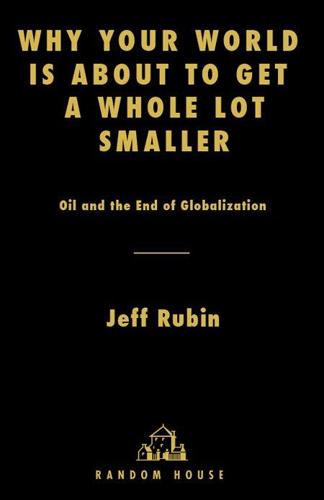
Why Your World Is About to Get a Whole Lot Smaller: Oil and the End of Globalization
by
Jeff Rubin
Published 19 May 2009
There is something bigger going on. OIL SHOCKS HAVE ALWAYS CAUSED RECESSION Here’s a clue. Soaring oil prices caused four of the last five global recessions. The only one that wasn’t caused by oil prices, the Asian meltdown of 1998, never even washed ashore in the major oil-consuming economies of the world like the United States and Western Europe. By contrast, two of the largest recessions in the postwar period came directly after the last two OPEC oil shocks. The second OPEC shock actually reverberated into two back-to-back recessions. A decade later, another oil shock, this time caused by Iraq’s invasion of Kuwait and subsequent torching of many of its oil wells, also produced a fairly deep recession in 1991.
…
Gasoline prices in the United States rose from around $1.80 per gallon in 2004 to over $4 per gallon in mid-2008, an increase that now dwarfs even the price hikes motorists had to contend with during the OPEC oil shocks. The run-up since 2002 is almost four times as great as the increase following the Iranian Revolution. Even in inflation-adjusted terms (or “constant dollars,” as economists call them), the price of gasoline climbed to levels greater than when cursing 1970s American motorists had to line up at gas stations due to fuel shortages. Suddenly, the OPEC oil shocks that had seemed like a worst-case scenario don’t look so bad. In fact, the process of having our world shrink promises to be much more wrenching this time around, if only because it has got so much bigger since the last energy crisis.
…
In Japan, where production lines are slowing and workers being sent home, sales are down 32 percent, to 35-year lows. German car sales are the worst since reunification—down 14 percent in January. Still, the US has been hit particularly hard. Sales in February fell by 41 percent compared to 2008. Oil shocks have always turned the rugged capitalists of Detroit into big-time Keynesians. Following the second OPEC oil shock, Lee Iacocca went begging to Washington to save Chrysler from bankruptcy. Then in 2008, taxpayers again heard Detroit’s all-too-familiar refrain, “Brother, can you spare a dime?” And Congress voted 370–58 to approve a $25 billion bailout package for the auto industry.
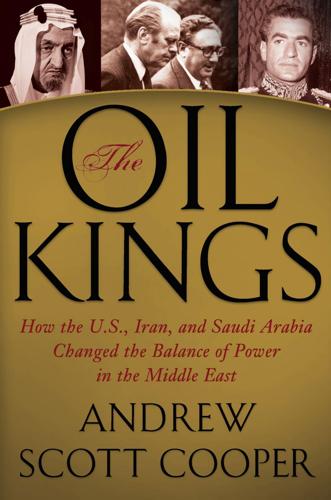
The Oil Kings: How the U.S., Iran, and Saudi Arabia Changed the Balance of Power in the Middle East
by
Andrew Scott Cooper
Published 8 Aug 2011
Kissinger’s remarks to Bhutto suggest that he feared a repeat of the anti-Shah disturbances of 1953 and 1963, that he now accepted that high oil prices posed as much a threat to the stability of Iran as they did to, say, Italy—to oil producers as well as oil consumers—and that friendly authoritarian dictatorships as well as Western democracies were in equal peril from the ructions of the oil shock. To Bhutto, Kissinger complained that the oil shock could have been avoided had the Nixon administration accepted the Shah’s offer in 1969 to buy millions of barrels of Iranian oil at a special discount. The deal promoted by Herbert Brownell had been judged illegal under U.S. law because it violated the quota laws that applied to petroleum imports.
…
E183.8.I55C66 2011 327.73055—dc22 011008319 ISBN 978-1-4391-5517-2 ISBN 978-1-4391-5713-8 (ebook) To My Family CONTENTS Introduction A Note on the Use of Iranian Imperial Titles PART ONE: GLADIATOR 1. A Kind of Super Man 2. Guardian of the Gulf 3. Marital Vows 4. Contingencies 5. Oil Shock 6. Cruel Summer PART TWO: SHOWDOWN 7. Screaming Eagle 8. Potomac Scheherazade 9. Henry’s Wars 10. The Spirit of ’76 11. Royal Flush 12. Oil War Epilogue: The Last Hurrah Acknowledgments Notes Bibliography Index INTRODUCTION “Why should I plant a tree whose bitter root Will only serve to nourish poisoned fruit?”
…
The narrative includes stories told for the first time, that, for example, illustrate the extraordinary degree of Iranian involvement—not to mention outright manipulation—in U.S. politics and foreign policy in the 1970s, and the extent to which the tentacles of the oil states of the Middle East reached right into the Oval Office to influence presidential decision making to an astonishing degree on domestic and foreign policy. We now know that the U.S. response to the 1971 India-Pakistan War, the 1972 U.S. presidential election, the Arab-Israeli War of 1973, the 1973–74 Arab oil embargo, the 1974–75 oil shock, the 1975 Middle East peace shuttle, and the 1976 U.S. presidential election all had an Iranian component. This book provides answers to long-standing questions about U.S.-Iran military contingency planning, the Ibex spy project, Iran’s nascent nuclear program, and the mysterious dealings of Colonel Richard Hallock.

MegaThreats: Ten Dangerous Trends That Imperil Our Future, and How to Survive Them
by
Nouriel Roubini
Published 17 Oct 2022
“To suggest that stagflation is a mystery merely indicates that one has elected to view the world through narrow econometric lenses rather than more widely through social and political as well as economic ones,” he wrote. “There is a problem here, but if there is a mystery, it is in the eye of the beholder, not in the real world.” By early 1979 the Islamic revolution in Iran led to a second oil shock, another oil embargo, another spike in oil prices, even higher inflation, and a return to outright stagflation. While fiscal and monetary policy had remained loose after the first oil shock, feeding the inflation rate, inflation nearly doubled to 13.3 percent in 1979. And then, finally, came the decisive intervention: besieged by critics, Carter chose inflation hawk Paul Volcker to head the Federal Reserve.
…
But ultimately, it was Paul Volcker’s crippling interest rates that brought inflation rates back down from their stratospheric heights. Reagan finally declared victory over stagflation in 1983. What ultimately explains the stagflation that the United States and other advanced economies experienced in the 1970s? The short answer: oil shocks together with a misguided policy response that released restraints on inflation expectations. Oil shocks, like all negative aggregate supply shocks, reduce potential growth and increase production costs. That puts pressure on companies that use oil; they must trim payrolls and/or raise prices. Loose monetary policy lowers the cost of capital, helping companies maintain payrolls until demand resumes.
…
If, however, the job loss is permanent and replacing my income is unlikely, for example, because of a health issue that impairs my productivity, then my lifestyle and spending must be adjusted to match my new circumstances. Otherwise, I’ll go bankrupt. The oil shocks were permanent—OPEC was a new force that would continue to act as a bloc, for the most part. That increased the real price of oil on a permanent basis and reduced the future growth of oil importing economies. That also raised the structural level of unemployment. The right policy response should have accepted those unpleasant facts. Tight monetary and fiscal policies, rather than loose ones, could have prevented runaway inflation. Had tighter monetary and fiscal policies prevailed, the oil shock would not have caused wages and prices to spiral across the board.
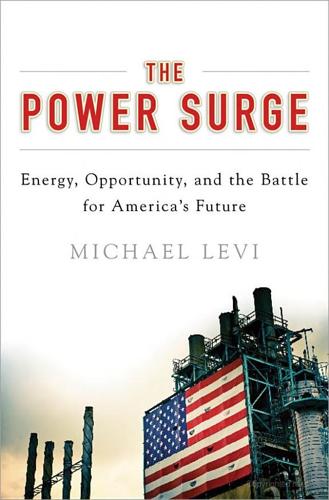
The Power Surge: Energy, Opportunity, and the Battle for America's Future
by
Michael Levi
Published 28 Apr 2013
In particular, as U.S. oil consumption shrinks, the U.S. economy will be a smaller piece of the oilprice puzzle; constraints on economic growth in places such as China and India in the face of expensive oil (and efforts by oil producers to keep prices at levels that those economies find manageable) may help restrain price increases before they really hurt the United States. There THE CAR OF THE FUTURE • 131 is good reason to believe that, this time, better oil efficiency will really pay off. Nevertheless, it’s possible to overstate the value of using less oil. Oil shocks typically precede recessions, but after forty years of careful studies economists still can’t agree on whether oil shocks actually cause big economic downturns. (One economist I know likes to quip that oil price spikes have preceded six of the last three recessions.) Even studies of the biggest oil spike of them all—the result of the 1973 Arab embargo—aren’t conclusive when it comes to how much of the ensuing recession should be pinned on oil.
…
Many of the details are novel, but the roots of the basic conflicts stretch back to the first modern oil crisis, which rocked the world in the autumn of 1973, and its aftermath. It is no exaggeration to claim that most of the battle lines defining today’s clashes were first drawn decades ago. The oil shock that struck on October 16, 1973, came at a time of enormous change and uncertainty for the United States. The Paris Peace Accords, signed in January of that year, had begun to end the Vietnam War, but Americans remained torn by the conflict. The Watergate scandal, which would eventually end Richard Nixon’s presidency, was slowly coming to light.
…
Two lasting changes that would help the United States over the next decade eventually emerged, though neither was without controversy.11 The first was the opening of the Trans-Alaskan Pipeline, a ten-billion-dollar, two-million-barrel-a-day behemoth running from Prudhoe Bay on the North Slope of Alaska to the Pacific port of Valdez. The pipeline had been on the table before the energy crisis but stalled in the face of hostility to its construction from environmental and Native American groups. The oil shock quickly broke down the opposition, and on November 16, 1973, Nixon signed broadly supported legislation moving the pipeline forward. By the end of the 1970s, it would allow previously landlocked oil to flow to the lower forty-eight states, reversing the earlier decline in U.S. crude production. American output bottomed out in 1976, and U.S. production would remain above its 1976 level until 1989.
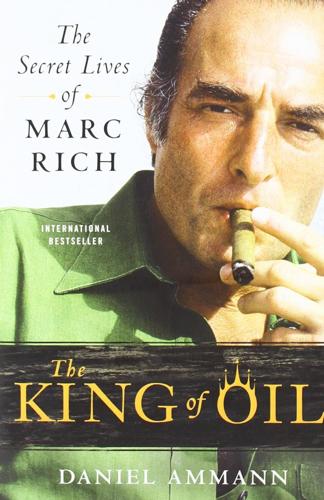
The King of Oil: The Secret Lives of Marc Rich
by
Daniel Ammann
Published 12 Oct 2009
ISRAEL AND THE SHAH Top-Secret Pipeline in Israel • Trading with the Shah of Persia • Crude Middleman • Yom Kippur War • The Breaking Off 7. MARC RICH + COMPANY Swiss Secrecy • Vendetta • Thanks to Iranian Oil • The Oil Shock of 1974 • Faster, Longer, More Aggressive • The Invention of the Spot Market • The Secret of Trust • “Don’t Let Them Eat Your Soul” • Pioneer of Globalization 8. TRADING WITH THE AYATOLLAH KHOMEINI Khomeini’s Return • Iran Hostage Crisis • The Second Oil Shock of 1979 • “We Had Oil Available, and Our Competitors Did Not” • Israel’s Salvation 9. THE CASE Marc Who? • “With Our Shotguns Blazing” • Rich’s Flight to Switzerland • Rudolph W.
…
In these commodity trades, the risk was primarily carried by the bank that had extended the line of credit. Its collateral for the credit deal was the commodity at issue, in this case oil. The Oil Shock of 1974 It was a good time for a commodities trader who wanted to go into business for himself. The world had been changed forever by the Arab oil embargo—imposed in the wake of the Yom Kippur War—and skyrocketing oil prices. These developments led to the world’s first oil shock, a shock that would have serious economic consequences the world over. The price for a gallon of gasoline rose from 38.5 in May 1973 to 55.1 in June 1974.5 It was the first time since the Second World War that the United States had seen gasoline shortages.
…
The United States government offered a high reward for his capture and chased him all over the world. Rich’s is one of the most amazing careers of the twentieth century, a career that is tightly woven with great events in world history: Fidel Castro’s revolution in 1959; the decolonization of Africa in the 1960s; the Yom Kippur War and the oil shock of 1974; the fall of the shah of Persia and the seizure of power by the Ayatollah Khomeini in Iran in 1979; apartheid South Africa in the 1980s; and the crumbling of the Soviet Union in the 1990s. Marc Rich and his business partners were on the scene when these events happened. Thanks to their know-how, their hard work, and their considerable aggression, they were able to react to these events to their benefit more than their competitors ever could.
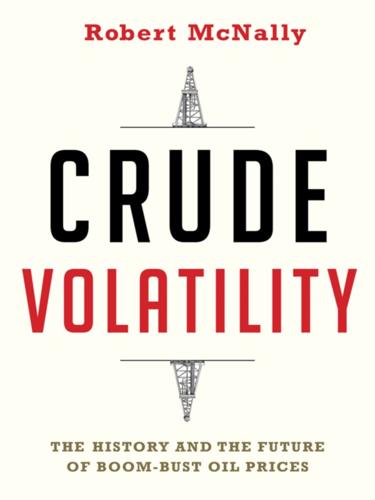
Crude Volatility: The History and the Future of Boom-Bust Oil Prices
by
Robert McNally
Published 17 Jan 2017
“Oil ‘Facts’ Don’t Quite Match the Rhetoric.” New York Times, March 18, 1979, E5. Hamilton, James. “Historical Causes of Postwar Oil Shocks and Recessions.” Energy Journal 6, no. 1 (1985): 97–116. ——. “Historical Oil Shocks.” February 1, 2011. http://econweb.ucsd.edu/~jhamilto/oil_history.pdf. ——. “Understanding Crude Oil Prices.” National Bureau of Economic Research, Working paper 14492, Cambridge, Mass., 2008. Hamilton, James D. Causes and Consequences of the Oil Shock of 2007–2008. San Diego, Calif.: UC San Diego, Department of Economics, 2009. Hammes, David, and Douglas Wills. Black Gold: The End of Bretton Woods and the Oil Price Shocks of the 1970s.
…
DeGolyer and MacNaughton, Twentieth Century Petroleum Statistics, 108. 151. Yergin, The Prize, 543–46. 152. Reserves (Federal Trade Commission. International Petroleum Cartel, Table 1, Table 8, 5–6, 23). 153. Data for 1950 (Federal Trade Commission. International Petroleum Cartel, Table 10, 25). 154. Hamilton, “Historical Causes of Postwar Oil Shocks,” 99; Hamilton, “Historical Oil Shocks,” 9. 155. Maugeri, 2006, 48. 156. “The Commission had the companies’ demand forecasts for the next month, and they also had excellent inventory data, with a lag of only about a week or two. When stocks appeared to be accumulating, production would be cut back. If inventories appeared to be falling below the amount needed to support current production, production quotas [quotas] would be increased.
…
A series of sabotage attacks, strikes, and commercial disputes in Venezuela, Iraq, Nigeria, the North Sea hit the market and contributed to the rapid increase in crude prices.67 For the first time ever, in February 2008, crude prices breached $100. As the summer of 2008 approached, they were hurtling over $140.68 The crude oil price shock between the fourth quarter of 2007 and second quarter of 2008—37 percent in real terms, 41 percent nominal, for U.S. imported crude oil prices—was “by any measure … one of the biggest oil shocks on record.”69 In the United States pump prices tracked those of crude to astounding new highs. In real terms, average national pump prices for regular grade gasoline exceeded their prior high set in March 1981 ($3.80 per gallon) in April of 2008 ($3.84) and then jumped up to peak at $4.43 in June.70 In nominal terms, pump prices peaked in July 2008 at $4.06 per gallon.

An Extraordinary Time: The End of the Postwar Boom and the Return of the Ordinary Economy
by
Marc Levinson
Published 31 Jul 2016
As cold weather arrived, truck drivers blocked highways to protest the soaring price of diesel fuel, and homeowners unplugged their Christmas lights in sympathy—or, perhaps, to avoid the opprobrium of their neighbors. Texas, a state floating on oil, gave birth to a popular bumper sticker urging, “Freeze a Yankee.” Gas lines, clogged with drivers desperate to top off nearly full tanks while the precious liquid was still available, symbolized the collapse of the American dream. The oil shock upset the equilibrium in Canada, setting off a boom in oil-rich Alberta while crippling import-dependent Quebec. The reverberations were even more disquieting in Japan. As petroleum prices rose through 1973, the Japanese did not anticipate serious trouble; their country had little engagement with the Middle East, and many Japanese companies had even complied with the Arab boycott against Israel.
…
After the embargo was announced, the British and French governments both predicted robust economic growth in 1974. As late as November 14, even though oil was now selling for $5.12 a barrel instead of $2.90, the Federal Reserve raised its forecast of US economic growth while lowering its forecast of unemployment.22 Only in late November, six weeks after the oil shock, did the reality sink in. In September, the Japanese economy had been so hot the government took special measures to slow it down; in November, the same officials slashed their forecast of economic growth for the coming months to zero. French economists warned that growth could plummet. At the Fed, the optimistic November 14 forecast was consigned to the dustbin.
…
Governments and central bankers knew, or thought they knew, how to use “traditional methods of economic management”—raising and lowering interest rates, taxes, and government spending—to restore an economy to health. When it came to fixing declining productivity growth, however, the economists’ toolbox was embarrassingly empty. CHAPTER 6 Gold Boys Sentiment at the start of 1973 had been buoyant. A year later, as the oil shock reverberated through the world economy, the atmosphere was vastly different. Inflation continued to rise. West Germany had just banned the importation of immigrant workers, on which its industries had relied since 1955, and Austria was about to follow. As “Help Wanted” signs were taken down across Northern and Central Europe, families in Turkey, Yugoslavia, Portugal, and Greece, which together supplied Germany with workers by the millions, began to feel the pain.
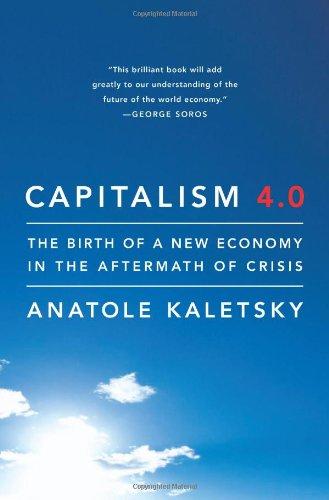
Capitalism 4.0: The Birth of a New Economy in the Aftermath of Crisis
by
Anatole Kaletsky
Published 22 Jun 2010
Second, and more important, the market price can and should be altered if good reasons exist to do this—whether these reasons reflect political objectives, such as the desire to reduce oil revenues available to Middle Eastern terrorists, or economic ones, such as the desire to avoid another recession-inducing oil shock. Between them, these two observations point to some obvious solutions to the long-term challenges of climate change and oil depletion—taxing oil or carbon, subsidizing alternative energy, redirecting public research funding, and offering cheap government insurance against the risks and decommissioning costs of nuclear power. The long-term response of Capitalism 4.0 to these issues is discussed at greater length in Chapter 19. But what could Western governments have done in the short-term to prevent the 2008 oil shock and the subsequent financial disaster—and what might governments do in the near future if another surge in the oil price to $150 a barrel were to threaten the global economy in the next few years?
…
But what could Western governments have done in the short-term to prevent the 2008 oil shock and the subsequent financial disaster—and what might governments do in the near future if another surge in the oil price to $150 a barrel were to threaten the global economy in the next few years? The fundamentalist view that market prices always reflect all possible information and lead to the best possible allocation of resources blinded governments and regulators to a crucial difference between the 2008 oil shock and the ones that occurred in 1974, 1979, and 1990. All earlier oil shocks were caused by geopolitical disruptions or deliberate OPEC actions that reduced the supply of oil. The surge in oil prices in 2008 was different. It was caused not by a shortfall in supply but an increase in demand. However, this demand was not due, as widely reported, to increased Chinese consumption.
…
Paulson CHAPTER ELEVEN - There Is No Can Opener The First Era of Economics The Second Era: Keynes’s Government-Led Economics The Third Era: The Triumph of Rational and Efficient The Next Transition CHAPTER TWELVE - Toward a New Economics Part IV - The Great Transition CHAPTER THIRTEEN - The Adaptive Mixed Economy Energy Policy and the 2008 Oil Shock CHAPTER FOURTEEN - Irresistible Force Meets Immoveable Object CHAPTER FIFTEEN - What—Me Worry? Will Rising Interest Rates Choke Off Economic Recovery? Will Printing Money Unleash Inflation? Will the Dollar Collapse? Part V - Capitalism 4.0 and the Future CHAPTER SIXTEEN - Economic Policy in Capitalism 4.0 Will There Be a Government Debt Crisis?
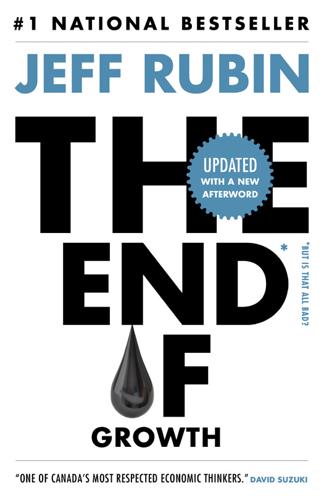
The End of Growth
by
Jeff Rubin
Published 2 Sep 2013
Regardless of what story made the most headlines at the time, oil prices were lurking at the root of the problem. Consider the first oil shock, created by the Organization of Petroleum Exporting Countries (OPEC) following the Yom Kippur War in 1973. Set off by this Arab-Israeli conflict, OPEC’s Arab members turned off the taps on roughly 8 percent of the world’s oil supply by cutting shipments to the United States and other Israeli allies. Crude prices spiked, and by 1974 real GDP in the United States had shrunk by 2.5 percent. The second OPEC oil shock happened during Iran’s revolution and the subsequent war with Iraq. Disruptions to Iranian production during the revolution sent crude prices higher, pushing the North American economy into a recession for the first half of 1980.
…
The stakes are high, and we can’t afford to lose, but we also have much to gain. [ CHAPTER 1 ] CHANGING THE ECONOMIC SPEED LIMIT THOSE WHO WERE AROUND IN THE 1970s will remember when speed limits were lowered in an attempt to stop drivers from burning so much gasoline. In the United States, the first OPEC oil shock spooked the president so much that he established a national speed limit of fifty-five miles per hour through the Emergency Energy Conservation Act. A slower speed limit didn’t win Richard Nixon any fans among car-loving voters, but his hand was forced by oil prices that were punishing the US economy.
…
From trading around $30 a barrel in 2004, oil prices marched steadily higher before hitting a peak of $147 a barrel in the summer of 2008. Unlike past oil price shocks, this time there wasn’t even a supply disruption to blame. The spigot was wide open. The problem was, we could no longer afford to buy what was flowing through it. There are many ways an oil shock can deep-six an economy. When prices spike, most of us have little choice but to open our wallets and shell out more for what we burn. Unless we want to stop driving our cars or burning heating oil, what else can we do? Something has to give. Paying more for oil means we have less cash to spend on food, shelter, furniture, clothes, travel and pretty much anything else you can think of.
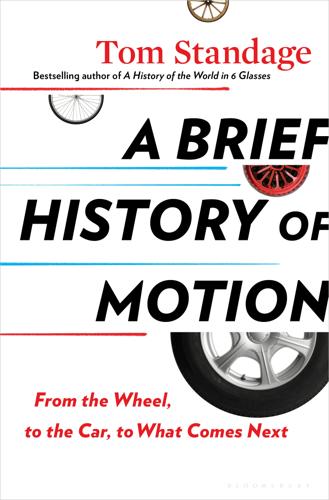
A Brief History of Motion: From the Wheel, to the Car, to What Comes Next
by
Tom Standage
Published 16 Aug 2021
For the first time, American drivers realized they could not take the supply of gasoline for granted. The oil shock led the government to introduce a national speed limit of 55 mph, and fuel-economy standards that required American manufacturers to achieve an average fuel economy, across their entire product lines, of 18 miles per gallon by 1978 and 27.5 by 1985. But American carmakers did little to change their products. By the late 1970s, 80 percent of American-made cars still had V-8 engines. In 1979, in a second oil shock, oil supplies from the Middle East were once again disrupted, this time as a result of the Islamic revolution in Iran and the outbreak the following year of the Iran-Iraq War.
…
Perhaps a breakthrough in cellulosic-alcohol production could have led to a different world; but despite renewed efforts in the twenty-first century, such a breakthrough has yet to occur. And even if it had done so, oil would probably have remained a cheaper option—financially, at least. But relying on oil turned out to have other costs. OIL SHOCKS AND ELECTRIC DISAPPOINTMENTS Overproduction of oil, not scarcity, was the main concern in 1930s as the Depression reduced demand, even as new reserves were discovered. At one point a barrel of oil could be bought in Oklahoma for a mere forty-six cents. With the backing of the government, American oil companies were also expanding overseas, and by the mid-1930s they had won concessions in countries including Bahrain, Iraq, Kuwait, Saudi Arabia, and Venezuela.
…
In 1979, in a second oil shock, oil supplies from the Middle East were once again disrupted, this time as a result of the Islamic revolution in Iran and the outbreak the following year of the Iran-Iraq War. The actual production of oil barely fell, but prices soared and panic buying ensued. This second oil shock stimulated the demand for smaller cars. Sales of small hatchbacks increased in Europe, while in America, more buyers were turning to imported cars, 80 percent of which came from Japan. As well as being more economical to run than much-larger American cars, models from Japanese brands such as Datsun, Toyota, and Honda also proved to be more reliable. By 1980, Japanese cars accounted for 16 percent of the American market, up from 3.5 percent in 1970.
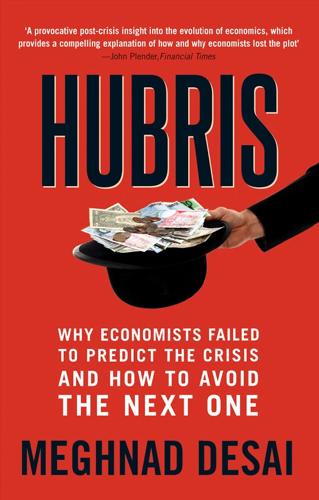
Hubris: Why Economists Failed to Predict the Crisis and How to Avoid the Next One
by
Meghnad Desai
Published 15 Feb 2015
Early on during these developments, James Tobin (1918–2002), a distinguished economist at Yale and a Nobel Prize winner in 1981, proposed a tax on each forex transaction to slow down the hectic pace of the dealings. The world had never before seen so many currencies being required to carry on trade, and in which bonds and equities and other financial assets could be bought and sold. Tobin’s proposal is still being debated after 40-plus years. The Oil Shock Just at this juncture, inflation became a global problem. Decades of persistent full employment had strengthened the trade unions and made the wage demands of workers irresistible. There had been a notion for many years before World War II that the share of wages in total national income was constant.
…
Indeed the debate about the Phillips curve can be understood in this way. Could the workers be fobbed off with just nominal wage rises which could then be clawed back by inflation? The price of oil had not risen for nearly 50 years up until 1973. The Arab-Israeli War was one proximate reason for the oil shock. But the persistence of inflation meant that the purchasing power of the dollar, in which oil was priced, was eroding as far as oil exporters were concerned. The quadrupling of the price of oil in October 1973 was partly a political gesture, but it had a profound economic impact in terms of both theory and practice.
…
The rise in the price of oil increased costs of manufacturing, which were passed on to consumers in the form of higher prices. Dependence on imports for oil supplies meant that the developed economies had to transfer as much as 5 percent of their GDP to oil-exporting countries. Even as their imports became expensive, the rich countries’ exports were being priced out of the market. A side effect of the “oil shock” was felt by the financial system. The oil-exporting economies had limited scope for spending their newfound wealth. To begin with they chose to leave their wealth as bank deposits. Western banks found themselves flush with deposits. But to service them, they needed to loan them out and earn some interest.
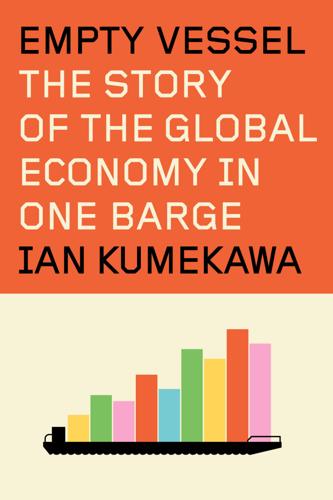
Empty Vessel: The Story of the Global Economy in One Barge
by
Ian Kumekawa
Published 6 May 2025
A political move meant to curb American support for Israel, the embargo had catastrophic impacts on businesses around the world—not least shippers.[9] The world’s freight was carried over the oceans by gas-guzzling behemoths; in a day of steaming at normal speeds, a single container ship might burn through nearly one hundred tons of fuel. As the Yom Kippur War sent the price of marine diesel soaring, global shipping recoiled as if struck by a hammer. The oil shock did far more than just pop the container ship bubble; it was a boulder hurled into the economic sea, and its effects surged outward in mighty waves. In 1975, world manufactured exports fell for the first time since World War II.[10] Suddenly, the shipping industry’s plentiful supply of cargo space became an acute and glaring problem.
…
There is a major difference between trying to drill a hole into the Texas dirt and trying to drill a hole into an ocean floor through hundreds of feet of murky water, all while floating on the high seas, buffeted by gale force winds. Those conditions meant that the cost of offshore extraction is (and was) very high compared to drilling in the California scrub or the deserts of the Middle East. But the oil shocks of the 1970s, all caused by political unrest and violence in the Middle East, made wells in the North Sea significantly more attractive to investors and Western oil companies. Thus, at the same time that the oil crises were wreaking havoc on shipbuilders across northern Europe, they were breathing vitality into the region’s energy sector.
…
There, shipbuilders in once-bustling industrial cities like Liverpool, Newcastle, and Glasgow clamored for state protections akin to those furnished by Sweden.[73] Just as in Sweden, the shipbuilding trade in the United Kingdom had struggled in the 1950s and 1960s but was boosted by a surge of orders for container ships and tankers. Just like their Swedish counterparts, British shipbuilders gradually lost ground to Asian competitors that drew on lower-wage labor forces and more modern shipbuilding technology. As in Sweden, the oil shock of 1973 brought the simmering crisis to a boil. And just as in Sweden, Britain’s left-leaning Labour government intervened, bowing to pressure to save jobs in reliable political strongholds in the industrial north. In 1977, it nationalized thirty-two shipyards—97 percent of the country’s shipbuilding capacity.

Rethinking Islamism: The Ideology of the New Terror
by
Meghnad Desai
Published 25 Apr 2008
. The quadrupling of the oil price was a huge shock for the oil-dependent Western economies and it cost them percentoftheirnationalincome,whichwastransferredtothe OPECcountries,mainlySaudiArabia,theGulfEmiratesandIran. It was the largest such transfer in recent history. It amounted to $ billion at prices, and at today’s prices about ten times thatamount. The quadrupling of the oil price – the oil shock as it came to be known – was perhaps overdue. The price of a barrel of crude hadnotchangedfornearlyyears,whileinflationhadbeenacceleratingintheUSAandelsewheresince.Intheimmediate aftermath,ittriggeredstagflation,acombinationofhighinflation and high unemployment, in many developed countries. In the longer run, though, it helped them adopt better energy-saving technologies.
…
. This was, Bin Laden claimed, not the crisis of a single Muslim countrybutoftheummaitself. WhatenabledBinLadentoleverageanumberoflocalbattlesbetweenthereligiouspartiesandthesecularauthoritiesintoaglobal strugglewasthequiteindependentdevelopmentsthatwenowcall globalisation.Thiswasanotherstrandoftheforcesunleashedby andtheoilshock.ItledtoalossofcompetitivenessforWesternmanufacturingenterprisesandthemovementofmanufacturing awayfromtheWesterneconomies.Italsoledtoaproliferationof financialinnovationsandinstitutionsastheworldtriedtoabsorb the$billionofpetrodollarswhichsatinWesternbanksandhad to be loaned out to Third World governments. Western governmentssoonretrenched,abandonedKeynesianpoliciesandsqueezed inflation out of their economies. In the process the two AngloSaxoneconomies,theUSAandtheUK,begantoderegulatecapital movementssothatitstartedtoflowfreelytoallpartsoftheworld where there were market economies. Technological developments in information processing, telecommunications and transport at thesametimehadmadetravelandcommunicationscheapbeyond imagination.
…
. Technological developments in information processing, telecommunications and transport at thesametimehadmadetravelandcommunicationscheapbeyond imagination.TheWorldWideWebarrivedinthesandgave eventhemostisolatedindividualaccesstoinformationaboutthe meansofterrorandenabledcontactwithfriendsinanypartofthe world. The oil shock also accelerated international migration, which hadsloweddownaftertheFirstWorldWarandresumedafter but was still limited. Full employment in the West had created a need for unskilled labour which the periphery of the British, DutchandFrenchempireswasquitewillingtoprovide.

Road to Nowhere: What Silicon Valley Gets Wrong About the Future of Transportation
by
Paris Marx
Published 4 Jul 2022
Los Angeles was the premier automotive city, but by the 1960s it was beset by heavy smog produced by the exhaust fumes of all the vehicles zipping around the expanding communities of the basin. That prompted the federal government to invest in developing better electric vehicles, especially after the 1973 oil shock. But, once again, concepts by General Motors and the American Motor Company, as well as vehicles that made it into small-scale production such as Enfield Automotive’s two-seater Enfield 8000, failed to catch on. Not until the 1990s did the electric car get serious attention from the major automakers, spurring the slow creation of the modern electric vehicle industry.
…
His parents were engaging in an unconscious process that happens every single day when parents normalize the existing social conditions and downplay the harms that accompany them to their children. But in this case, it was not working, and that may have been a reflection of broader social dynamics playing out in the mid-1970s. Three years earlier, the world had experienced the first of the oil shocks of that decade. In October 1973, the Organization of Arab Petroleum Exporting Countries declared an oil embargo on the countries supporting Israel in the Yom Kippur War, including the United States, the United Kingdom, and Canada, but it also caused the price of oil to soar even for countries that were not embargoed.
…
By 1983, the New York Times was reporting that people had been using their bikes instead of their cars and going on walks to relieve their stress instead of taking long drives. People also wanted to economize on heating costs, which led them to keep their homes cooler in the winter and warmer in the summer, and the size of new homes actually shrank.4 The oil shocks of the 1970s presented a rare opportunity for the United States to rethink how it used energy and planned communities. President Jimmy Carter, who was inaugurated in January 1977, put solar panels on the White House and invested federal funds into developing renewable energy. But the change did not take hold, as anyone can see if they visit US towns and cities today, where most people continue to depend on their cars and trucks, not so much out of choice but necessity.
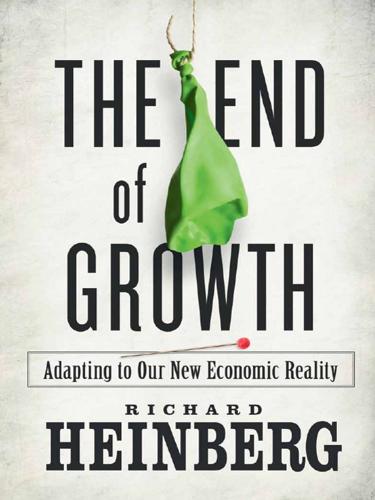
The End of Growth: Adapting to Our New Economic Reality
by
Richard Heinberg
Published 1 Jun 2011
Hamilton again: “At a minimum it is clear that something other than [I would say: “in addition to”] housing deteriorated to turn slow growth into a recession. That something, in my mind, includes the collapse in automobile purchases, slowdown in overall consumption spending, and deteriorating consumer sentiment, in which the oil shock was indisputably a contributing factor.” Moreover, Hamilton notes that there was “an interaction effect between the oil shock and the problems in housing.” That is, in many metropolitan areas, house prices in 2007 were still rising in the zip codes closest to urban centers but already falling fast in zip codes where commutes were long.34 FIGURE 27. Real Oil Prices and Recessions.
…
Charles Maxwell, quoted in Wallace Forbes, “Bracing For Peak Oil Production by Decade’s End,” Forbes.com, posted September 13, 2010; Eoin O’Carroll, “Pickens: Oil Production Has Peaked,” The Christian Science Monitor, posted June 18, 2008. 7. Clint Smith, “New Zealand Parliament Peak Oil Report: The Next Oil Shock?” Energy Bulletin, posted October 1, 2010, energybulletin.net/stories/2010-10-14/next-oil-shock; Stefan Schultz, “Military Study Warns of a Potentially Drastic Oil Crisis,” Spiegel Online, posted September 1, 2010; UK Industry study; US Joint Forces Command, The Joint Operating Environment 2010 (Suffolk, VA: USJFCOM, 2010). 8. See, for example, peakoil.net/headline-news/toyota-we-must-address-the-inevitability-of-peak-oil. 9.
…
In its authoritative 2010 World Energy Outlook, the IEA announced that total annual global crude oil production will probably never surpass its 2006 level.2 However, the agency fudged the question a bit by declaring that the peak was not due to geological constraints, and that total volumes of liquid fuels (including crude oil, biofuels, synthetic oil from tar sands and coal, and natural gas liquids like butane and propane) will continue to grow — just a bit — until 2035. In discussing the IEA report, a few analysts declared that these latter claims were essentially just efforts to avoid panicking the markets.3 BOX 3.1 Oil Shock 2011? In the early months of 2011 street demonstrations erupted in Iraq, Iran, Tunisia, Egypt, Bahrain, Yemen, Libya, and Algeria. Libya became mired in civil war, and its rate of oil exports fell from 1.3 million barrels per day to a small fraction of that amount. In Saudi Arabia, banned opposition groups threatened a “day of rage.”
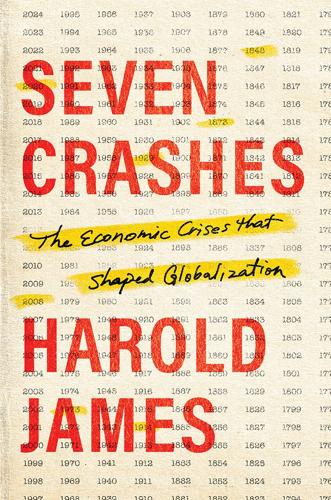
Seven Crashes: The Economic Crises That Shaped Globalization
by
Harold James
Published 15 Jan 2023
But it is not just the interwar slump that led to a rethinking of what globalization is about, whom it hurts, and whom it benefits. Demand and Supply Not every crisis destroys or reverses globalization. On the contrary, some dramatic watershed events led to more rather than less globalization. In the 1970s, the oil shocks altered the policy paradigm. Initially more protectionism appeared as a response to big trade deficits in industrial countries, and as a remedy to exposure to global risk. The Cambridge Department of Applied Economics under Wynne Godley became a base for advocates of a siege economy. But instead of limiting trade, the policy community shifted to deregulation, disinflation, and more openness, with center-left governments leading the way: Jimmy Carter in the United States, James Callaghan in the UK, Helmut Schmidt in Germany.
…
The higher oil price might be regarded as the imposition of a new (wealth- and income-reducing) tax; and thus the industrial countries mostly decided not to adjust immediately. The immediate response in most countries was to accommodate the shock. That monetary and fiscal accommodation pushed inflation, which rose to 11.0 percent in the United States in 1974 (and then, after a second oil shock, to 12.0 percent in 1980), and to higher levels in some other countries: in the UK, consumer price index (CPI) inflation in 1975 was 24.2 percent, and in 1980 18.0 (see Figure 5.2). Countries employed differing strategies to reduce their fuel imports: France pushed nuclear energy as an alternative to carbon, the UK developed oil and gas fields in the North Sea, Germans and Japanese accepted greater fuel economy.
…
In the United Kingdom, where the balance of payments problem appeared earlier than elsewhere, the government tried a “Buy British” campaign, supported by all the major political parties. Leaders encouraged citizens to wear stickers and badges with the Union Jack and the message “I’m backing Britain.” (The press magnate Robert Maxwell distributed T-shirts with the same slogan, but they turned out to be made in Portugal.) In the mid-1970s, after the first oil shock, the government briefly flirted with what the left of the Labour Party called a “siege economy,” with extensive import restrictions. In the United States, there was acute anxiety about Japanese competition, and in 1981 Washington pressured Tokyo to sign an agreement that limited Japanese car exports.
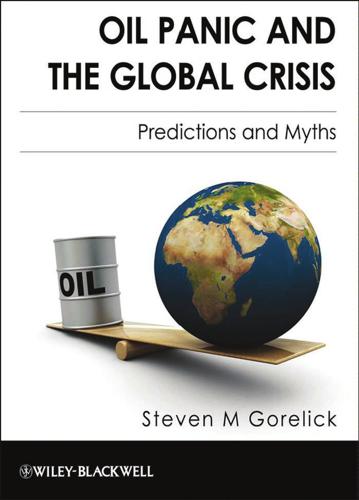
Oil Panic and the Global Crisis: Predictions and Myths
by
Steven M. Gorelick
Published 9 Dec 2009
Recessionary pressures diminished only when the price of oil dropped during the 1980s, falling by nearly half from 1985 to 1986 ($27.56 to $14.43 per barrel). Although the spot price of oil in 2008 exceeded $145 per barrel, the 2008 average oil price took five years to double in inflation-adjusted terms; the price rise was much slower than during the 1970s’ oil shock. In terms of speed and magnitude, the oil price rise of 2008 itself was well tolerated by the economies of the world. It was the global financial crisis that began in 2008 that overwhelmed the world economy. Consequently demand and price dropped precipitously. Historically, the oil price increases of the 1860s, 1910s, and 1970s were each followed by a decade of declining oil prices.130 Before the economic crisis that began in 2008, the US economy stood up well to high oil prices for several reasons.
…
A second reason for the resilience of the US economy in the face of the high oil prices of 2008 was that, although China consumed more and more of the world’s oil, it produced cheap manufactured goods. Obtaining such inexpensive goods counterbalanced the inflationary impact of higher oil prices in the US. Third, a school of economic thought claims that there was a historical break in the effects of oil price shocks on economies such that subsequent oil shocks are not likely to be inflationary or cause a recession. Reasons for this break include decreased energy-use intensity, deregulation of key energy-producing and energy-consuming industries, and governmental monetary policy changes that have encouraged a low-inflation environment. However, as with many 6 Gasoline cost as a percent of 4 disposable income 2 0 1950 1970 1990 Figure 4.54 The cost of US gasoline consumption relative to personal disposable income.
…
However, as with many 6 Gasoline cost as a percent of 4 disposable income 2 0 1950 1970 1990 Figure 4.54 The cost of US gasoline consumption relative to personal disposable income. (Data: gasoline prices, EIA; US income, US Bureau of Economic Affairs) 2010 156 Counter-Arguments to Imminent Global Oil Depletion economic theories, it is not conclusive that any of these links is responsible for the relative insensitivity of the US economy to oil shocks.131,132 Myth VI: There Are No Substitutes for Oil Oil is different because there are no substitutes. This is another claim of those who maintain that the world is running out. But is it true? In terms of substitution, is oil different from other non-renewable commodities, such as copper and iron?
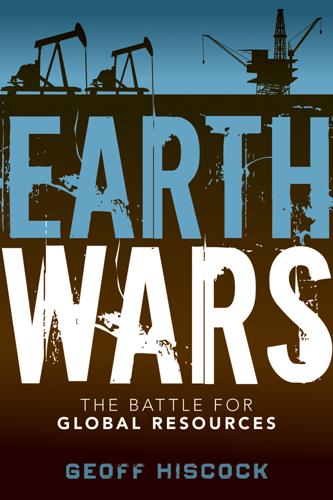
Earth Wars: The Battle for Global Resources
by
Geoff Hiscock
Published 23 Apr 2012
Long History on the Nuclear Road Japan had been travelling the nuclear road for 40 years, having opened the Fukushima plant in March 1971 in response to environmental concerns and the 1967 oil export embargo imposed by some Arab producers following the Six-Day War between Israel and its Arab neighbours. That brief embargo was followed by the much more severe “oil shock” of 1973–1974, when Arab producers within the Organization of Petroleum Exporting Countries (OPEC) declared sharp price rises, production cuts, and an oil embargo targeting the United States and some other Western nations over their support for Israel in its October 1973 Yom Kippur War with Syria and Egypt. This second oil shock encouraged Japan and other advanced economies to further embrace the nuclear option. A third oil shock came in 1979, when the Iranian Revolution disrupted production there, sending global oil prices higher.
…
Although they are able to recycle some from discarded computers, mobile phones, and other electronic detritus, they get most of their supply from China. In fact, between 50 and 60 percent of China’s rare earth exports go to Japanese buyers. But in September 2010, the buyers suffered something akin to a mini “oil shock.” Their supplies from China slowed to a crawl, tied down by the sort of bureaucratic double-shuffling that the Japanese themselves once employed as a nontariff barrier against unwanted imports. There was no export ban, the Chinese declared, but the result was the same: shipments ground to a halt, and the Japanese electronics industry got very nervous.
…
Its 58 reactors, operated by state majority-owned nuclear power utility Electricite de France (EDF), produce 75 percent of its electricity, and the country has so much spare capacity that EDF exports more than 10 percent of its output to neighbours such as Germany, Italy, Spain, Switzerland, Belgium, and the United Kingdom. Energy independence, a policy pursued by France since the oil shocks of the 1970s, is at the heart of nuclear power’s prominence in France, and even with the inroads made by renewable energy sources and cheaper gas, nuclear is unlikely to lose much ground. France actively champions its nuclear capabilities. Areva, another state-owned (90 percent) entity, is the world’s largest nuclear company, and has multiple agreements and joint ventures around the world aimed at securing uranium supplies, processing deals, technology development—such as with Siemens in Germany—and customers for its nuclear reactors.
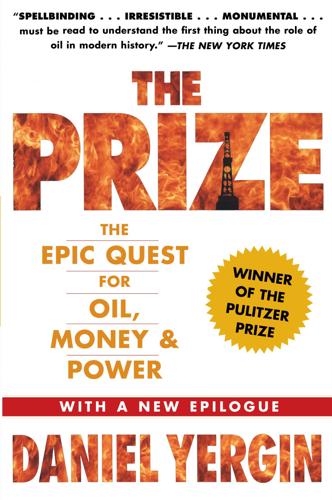
The Prize: The Epic Quest for Oil, Money & Power
by
Daniel Yergin
Published 23 Dec 2008
When the wave finally spent its fury two years later, the survivors would look around and find themselves beached on a totally new terrain. Everything was different; relations among all of them were altered. The wave would generate the Second Oil Shock, carrying prices from thirteen to thirty-four dollars a barrel, and bringing massive changes not only in the international petroleum industry but also, for the second time in less than a decade, in the world economy and global politics. The new oil shock passed through several stages. The first stretched from the end of December 1978, when Iranian oil exports ceased, to the autumn of 1979. The loss of Iranian production was partly offset by increases elsewhere.
…
Not only were those developing nations hit by the same recessionary and inflationary shocks, but the price increases also crippled their balance of payments, constraining their ability to grow, or preventing growth altogether. They suffered further from the restrictions on world trade and investment. The way out for some was to borrow, and therefore, a goodly number of those OPEC surplus dollars were "recycled" through the banking system to these developing countries. Thus, they coped with the oil shock by the expedient of going into debt. But a new category also had to be invented—the "fourth world"—to cover the lower tier of developing countries, which were knocked flat on their backs and whose poverty was reinforced. The new and very difficult problems of the developing countries put the oil exporters into an awkward, even embarrassing situation.
…
For, most forecasters agreed, another oil crisis was highly probable a decade or so hence, in the second half of the 1980s, when demand would once again be at the very edge of available supply. The result, in popular parlance, was likely to be an "energy gap," a shortage. In economic terms, any such imbalance would be resolved by another major price increase, a second oil shock, as had happened in the early 1970s. Though variations were to be found among the forecasts, there was considerable unanimity on the central themes, whether the source was the major oil companies, the CIA, Western governments, international agencies, distinguished independent experts, or OPEC itself.
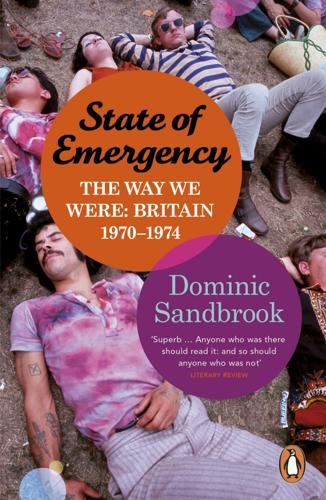
State of Emergency: The Way We Were
by
Dominic Sandbrook
Published 29 Sep 2010
‘I realised very quickly’, said Anthony Barber, ‘that all we’d been trying to achieve was really coming to an end.’46 But it is also a myth that the oil shock was always bound to bring doom and disaster in its wake. In the United States – which was punished even more severely than Britain, because of its support for Israel – the Nixon and Ford administrations managed to weather the economic blizzard without plunging the economy into a devastating bout of inflation, and although there was a prolonged and painful recession, the American economy was in recovery by early 1976. But coming after three draining years of industrial conflict, pay restraint and rhetorical class warfare, the oil shock brought out the very worst in British politics.
…
The NUM was still considering the Coal Board’s offer when, on 16 October, OPEC broke the devastating news of their oil price rise, which changed the game completely. Not only did the oil shock put Heath’s counter-inflation policy under intense pressure, it left the miners in an even stronger position. Britain depended heavily on imported oil to meet its energy requirements; indeed, since 1972 the government had been quietly building up coal stocks by burning more oil instead. Thanks to the oil shock, however, the government could hardly rely on imported oil if negotiations with the miners broke down; indeed, with North Sea oil yet to come on stream, OPEC’s blackmail had left Britain more dependent on coal than ever.
…
After toiling through ‘years of austerity … suddenly here it all was, the world of Penthouse and the Beatles, the world of large steaks and double cream on real gateaux, the world of girls and nightclubs and expense account champagne’.9 And even though millions of people never went to nightclubs or quaffed champagne, they still enjoyed their slice of the ever-expanding cake. By 1973, one in three people told researchers they had gone out for a meal in the previous month, a luxury few of their parents could have imagined. And despite all the economic turmoil of the early 1970s, the strikes and inflation, the oil shock and the power cuts, most of Bexley’s voters remained far more prosperous than they could have expected twenty years before. Three years after Edward Heath had walked into 10 Downing Street, there were more cars on the roads than ever, more products on the supermarket shelves, more colour televisions in suburban homes, more planes taking off for the beaches of Spain.10 As a relatively affluent, Conservative-voting slice of London suburbia, Bexley was not exactly representative of the national experience at the dawn of the 1970s.

The Atlantic and Its Enemies: A History of the Cold War
by
Norman Stone
Published 15 Feb 2010
The oil producers, left to themselves, would have been far too disunited for common action, and their common strategy at OPEC did not in fact last for very long. But the fall of the dollar in 1971 pushed them together: why accept valueless paper dollars? The same was true, though not to the same extent, for producers of other raw materials - coffee, tobacco, copper, rubber, iron ore, meat as well - and prices shot up, even in 1971, two years before the oil shock. The problem was symbolized by the Brazilian city of Manaos, deep in the jungle. There, once upon a time, rubber had appeared, and the place became opulent: famously Dame Adeline Patti, the great opera singer of the 1890s, appeared there. Then rubber was produced elsewhere, and Manaos relapsed back into semi-jungle.
…
For a time, this seemed to work. Unemployment did indeed fall to 500,000, but this was classic fool’s gold. The ‘fringe banks’ for a time did well out of property prices, which had a dangerously more important role in England than elsewhere, and unlovely concrete spread and spread and spread. But then came the oil shock. Even food prices trebled by 1974 as against 1971, and the bubble burst in November 1973, when the minimum lending rate was pushed up to 13 per cent while public spending was cut back by £12bn. One of the new banks could not obtain credit, and the other banks had to set up a ‘lifeboat’. It was not enough.
…
By 1976 the Treasury itself was somewhat converted to the idea of monetarism, a limitation of the quantity of money such that inflation could be contained. But the conversion was not enthusiastic. The Bank (and the City) expressed greater enthusiasm. It was an unhappy time, the country winding down, and a slow crisis started. In 1976-7 the world economy did pick up, as the oil-shock money was recycled back to the industrial and exporting countries (which grew overall at 5 per cent). But the British economy was by now too fragile to gain much more than a respite, and inflation still ran high - 25 per cent in 1975, 16 per cent in 1976 and in 1977 (earnings keeping apace until 1977).
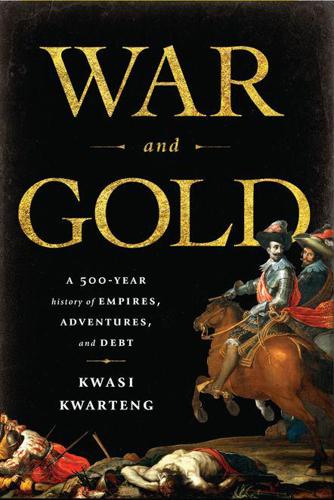
War and Gold: A Five-Hundred-Year History of Empires, Adventures, and Debt
by
Kwasi Kwarteng
Published 12 May 2014
Contemporaries spoke of the ‘Great Recession’. It was recalled that the ‘price of oil had actually been falling through most of the postwar period, both absolutely and in relation to other world prices’.17 The oil shock of 1973 led to ‘visions of financial disaster for the west’. The spike in oil prices had increased all costs in the Western economies, which were heavily dependent on oil. ‘Prices were higher and employment lower’ as a consequence of the oil shock.18 Despite the arguments of a later generation of economists, contemporaries were very clear about the direct causal link between higher oil prices, increased inflation and stagnant economies.
…
The Saudis had bought ‘all over the world and they sent the goods home’, but then they ‘couldn’t get anything off the ships and into use’.26 Increased revenues, which flowed into the treasuries of the oil-exporting countries, altered the international economic environment. David Rockefeller, scion of the wealthy dynasty and Chairman of the Chase Manhattan Bank, recalled that the ‘most immediate effect of the oil shock was the surge in the flow of dollars from oil-importing nations into OPEC’s coffers. Between 1973 and 1977, the earnings of the oil-exporting nations expanded 600 percent, to US$140 billion.’ There lay the problem confronting the world monetary system. The enormous dollar reserves acquired by the oil exporters needed to find some outlet.
…
Loans were also extended to Latin America, Africa, East Asia and other parts of the developing world.30 Other American bankers and senior officials began to express anxiety about the political and economic outlook. Paul Volcker, the future Chairman of the Federal Reserve, remembered that by mid-decade the ‘combination of accelerating inflation and the oil shock late in 1973’ went far in ‘establishing floating currencies as the . . . international monetary system’. The mid-1970s were marked by ‘what was then the most serious of the postwar recessions’ and by ever-higher inflation. Floating currencies, and the end of any link to gold, were a novel feature of the period.

The Quest: Energy, Security, and the Remaking of the Modern World
by
Daniel Yergin
Published 14 May 2011
It was primarily a credit recession, the result of too much debt, too much leverage, too many derivatives, too much cheap money, too much overconfidence—all of which engendered real estate and other asset bubbles in the United States and other parts of the world. But the surge in oil prices was an important contributing factor to the downturn. Between June 2007 and June 2008, oil prices doubled—an increase of $66—in absolute terms, a far bigger increase in oil prices than had ever been seen in any of the previous oil shocks, going back to the 1970s. “The surge in oil prices was an important factor that contributed to the economic recession,” observed Professor James Hamilton, one of the leading students of the relation between energy and the economy. The oil price shock interacted with the housing slowdown to tip the economy into a recession.
…
The embargo, combined with the price increases, shook the structure of international relations and sent shock waves through the global economy, followed by several years of poor economic performance. The 1978–79 Iranian Revolution, which toppled the shah and ushered in the theocratic Islamic Republic, also ignited a worldwide panic in the petroleum market and another oil shock that contributed mightily to the difficult economic years of the early 1980s. Saddam Hussein’s 1990 invasion of Kuwait set off the Gulf crisis, leading to the loss of five million barrels a day of supply from Iraq and Kuwait. Other producers, notably Saudi Arabia, cranked up output and largely replaced the missing barrels over the next several months, even before Operation Desert Storm evicted Saddam’s forces from Kuwait.
…
In Japan, too, nuclear power plants continued to come online—with more than a dozen in the decade following Chernobyl’s meltdown. But Japan’s cultural legacy regarding nuclear power was more complicated. It was the only country to have ever suffered a nuclear attack, and the politics of nuclear power could engender a powerful emotional response from voters and politicians alike. But the oil shocks of the 1970s, which threatened to undermine Japan’s postwar economic miracle, were deeply traumatic. Indeed, so much so that the political will to support the nuclear program remained strong. “Unlike the United States or the United Kingdom, Japan had no choice but to depend on imports for virtually all of its fossil-fuel supply,” said Masahisa Naitoh, a formerly senior energy official in Japan.
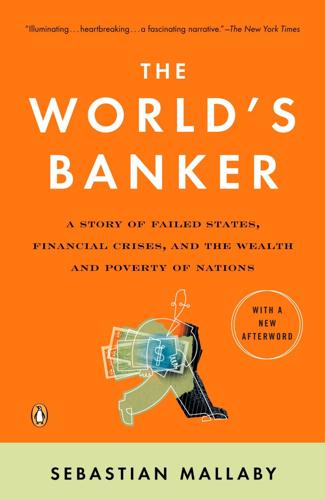
The World's Banker: A Story of Failed States, Financial Crises, and the Wealth and Poverty of Nations
by
Sebastian Mallaby
Published 24 Apr 2006
The institution’s war on poverty, like America’s war on communism in Vietnam, was proving all too much for it. Without pressure from outside, McNamara might have soldiered on, preaching the cause of development at the Bank’s annual meetings each autumn, and driving his staff to come up with new ways of advancing it. But outside pressure did arrive—in the form of two successive oil shocks. McNamara’s speech in Nairobi in 1973 had been followed almost immediately by the Yom Kippur War and the Arab oil embargo; oil prices shot up, and the Bank’s oil-importing clients suddenly found their trade balance deteriorating. For a while, the pain could be postponed. The Arabs parked their windfall in Western banks, so credit became cheap; countries simply borrowed to finance imports.
…
But the Bank was on the one hand a public-sector institution, and on the other hand a promoter of free-market reform. It therefore qualified as a target for both ends of the political spectrum. In this ideological climate the “structural adjustment” lending that McNamara had proposed as a pragmatic response to the oil shock became bitterly contentious. The Bank rightly urged developing countries to devalue their currencies, a policy that they should have embraced much sooner after the 1973 shock; expensive oil was affordable only if countries boosted their exports, and that meant making their goods competitive by having a low exchange rate.
…
Adjustment was controversial from the outset, as we have seen: it was enthusiastically supported by the Bank’s Bretton Woods sister, the International Monetary Fund, but agencies like the United Nations Development Program and UNICEF were less inclined to blame Africa’s problems on policies that needed adjustment, and more apt to point the finger at the oil shock, falling commodity prices, and other misfortunes not of Africa’s own making. African leaders, not surprisingly, sided with the United Nations, and denounced the Bank’s new orthodoxy as anti-African: They wanted aid, not policy lectures.15 The Bank soon found itself prescribing the bitter medicine of economic austerity while others declared that its diagnosis was all wrong; and the sense that its credibility was on the line drove the Bank to redouble its efforts on the continent.

Living in a Material World: The Commodity Connection
by
Kevin Morrison
Published 15 Jul 2008
In the simplest of acts we take raw materials for granted; like switching on a light or turning up the heating. I wanted to show T 2 | LIVING IN A MATERIAL WORLD how commodities are relevant to every body, every day – and how they are more relevant now than they have been at any time since the last oil shock nearly three decades ago (my memories of which include going to bed by candlelight during the energy rationing and three-day weeks of the 1970s). Everything we consume – whether through buying something, eating or even our physical actions – involves, at some level, the use of metals, fossil fuels or agricultural produce, which we take from planet Earth and use to make our lives more comfortable, more productive or more manageable.
…
Economic growth in developing countries has accelerated global growth at a faster pace than at any time since the 1960s. In the 1950s and 1960s, the world economy rose by 5 % due to the reconstruction of Europe and Japan, as well as the economic competition between the US and the Soviet Union. The two oil shocks in the 1970s slowed growth to about 4 %, and then to 3 %, which became the average economic growth rate of the 1980s and 1990s. Higher oil and food prices together with the credit crisis in the US have prompted economists to cut global economic growth rates to around 3 % for 2008. Some experts cite this as the start of a prolonged downturn in the global economy.
…
The credit crisis of 2007 followed a prolonged period of loose money supply where interest rates were kept below their long-term average. The combination of easy credit and high oil prices is eerily similar to the economic conditions in the early and late 1970s at the time of the world’s first two oil shocks, both of which were followed by recessions.3 The 1970s was the last time the world was seriously concerned about the supply and price of raw materials, and I refer to this period throughout the book.4 In December 1976, the US government issued a report on resource availability by the National Commission on Supplies and Shortages,5 8 | LIVING IN A MATERIAL WORLD which looked at the issue of whether the US was running out of resources and whether the country was dependent on importing raw materials from foreign countries (Eckes, 1978).
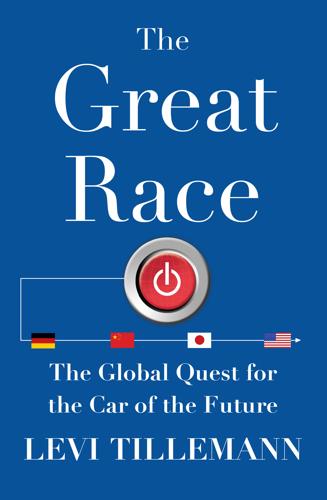
The Great Race: The Global Quest for the Car of the Future
by
Levi Tillemann
Published 20 Jan 2015
His father was a Lithuanian-born scrap metal dealer, and as a young man Ovshinsky himself had started his career as a lathe operator. Ovshinsky’s formal education went only as far as high school, but the public libraries were a fitful schoolroom for such a subversive genius. His self-directed study nurtured a deep streak of intellectual independence. Long before the oil shocks of the 1970s, Ovshinsky understood the environmental and geopolitical dangers of relying too much on oil to fuel an economy and set out to find alternatives. Together with his wife, Iris, he set up a “storefront lab” that eventually grew into the publicly traded company ECD Ovonics. At Ovonics, Ovshinsky invented a new family of semiconductors, hydrogen fuel cells, and thin-film solar cells.
…
And so, he dryly told Angelenos, “faced with a choice between my freedom and your mobility, my freedom wins.”14 The Ruckelshaus EPA responded by proposing that the federal government should curtail development and ration gasoline shipments to California by 25 percent in summer months, with most of the cuts targeted toward the Los Angeles basin.15 Obviously, this would not be good for California’s economy—or for the automakers, or oil companies. So many in the business-minded community quickly learned to despise the EPA. Automakers in particular felt as if they were under siege: they were being required to both reduce emissions and increase fuel economy—in response to the oil shocks—at the same time. The technological burden was staggering. Technology Forcing—“Impossible” Standards All of this was very much in line with the new thinking at CARB. Tom Quinn’s attitude did not endear him to the automakers—not one bit. And under Quinn’s leadership CARB forced manufacturers out of their comfort zones—mining them for data about what was possible and pushing them precariously close to the technology frontier.
…
Sometimes he would write press releases during the automakers’ testimony in order to beat industry execs to the media punch.18 Other times he would just leave a hearing for hours, return, call for a vote mid-testimony, and adjourn.19 He had little patience for Detroit’s carefully crafted lobbying campaigns and public relations stagecraft. Some would argue that Quinn went too far. The new CARB chairman carried out policy irrespective of economic conditions and seemed impervious to the difficulties faced by Detroit. Japanese imports were surging, and the first oil shock had tremendously weakened the appeal of America’s biggest, most profitable cars. And the industry’s problems did not stop there. Quality was starting to sag. By the early 1970s, the average American-made car went to market with more than two dozen defects.20 But despite these tough times, Quinn was intent on making California into America’s pressure cooker for new environmental technologies.
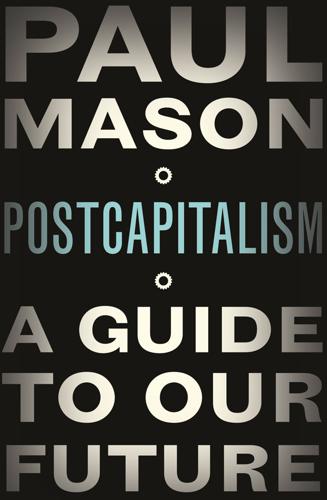
Postcapitalism: A Guide to Our Future
by
Paul Mason
Published 29 Jul 2015
The break occurs at the end of the First World War; the 1930s Depression, followed by the destruction of capital during the Second World War terminate the downswing. Late-1940s–2008: In the fourth long cycle transistors, synthetic materials, mass consumer goods, factory automation, nuclear power and automatic calculation create the paradigm – producing the longest economic boom in history. The peak could not be clearer: the oil shock of October 1973, after which a long period of instability takes place, but no major depression. In the late–1990s, overlapping with the end of the previous wave, the basic elements of the fifth long cycle appear. It is driven by network technology, mobile communications, a truly global marketplace and information goods.
…
Even Japan – which had averaged growth rates close to 10 per cent in the post-war period – went briefly negative.24 The crisis was unique because in the worst-hit countries falling growth coincided with high inflation. By 1975, inflation in Britain reached 20 per cent, and 11 per cent in the USA. The word ‘stagflation’ hit the headlines. Yet even at the time it was obvious that the oil shock was merely the trigger. The upswing had already been stuttering. In each developed country, growth in the late 1960s seemed beset by national or local problems: inflation, labour troubles, productivity concerns and flurries of financial scandal. But 1973 was the watershed, the point where the energy driving the fourth wave upwards caused it to peak and then invert.
…
With this change, each stricken country was temporarily free to solve the underlying problems of productivity and profitability in ways the old system had made impossible: with higher state spending and lower interest rates. The years 1971–3 were lived in a kind of nervous euphoria. The inevitable stock market crash hit Wall Street and London in January 1973, triggering the collapse of several investment banks. The oil shock of October 1973 was the final straw. CARRY ON KEYNES By 1973, every aspect of the unique regime that had sustained the long boom was broken. But the crisis looked accidental: low input prices destroyed by OPEC; global rules ripped up by Richard Nixon; profits eroded by that figure of loathing, the ‘greedy worker’.
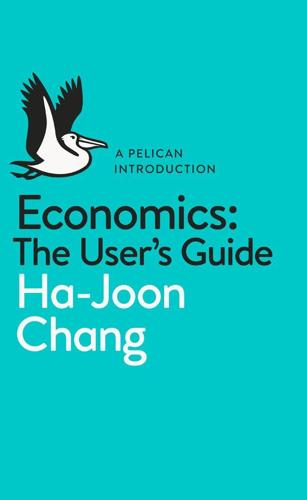
A Pelican Introduction Economics: A User's Guide
by
Ha-Joon Chang
Published 26 May 2014
This created instability in the world economy, with currency values fluctuating according to market sentiments and becoming increasingly subject to currency speculation (investors betting on currencies moving up or down in value). The end of the Golden Age was marked by the First Oil Shock in 1973, in which oil prices rose fourfold overnight, thanks to the price collusion of the cartel of the oil-producing countries, OPEC (Organization of Petroleum Exporting Countries). Inflation had been slowly increasing in many countries since the late 1960s but, following the Oil Shock, it shot up. More importantly, the next several years were characterized by stagflation. This newly coined term referred to the breakdown of the age-long economic regularity that prices fall during a recession (or stagnation) and rise during a boom.
…
The war resulted in the first reversal in the acceleration in economic growth since the early nineteenth century.19 1945–73: The Golden Age of Capitalism Capitalism performs well on all fronts: growth, employment and stability The period between 1945, the end of the Second World War, and 1973, the first Oil Shock, is often called the ‘Golden Age of capitalism’. The period really deserves the name, as it achieved the highest growth rate ever. Between 1950 and 1973, per capita income in Western Europe grew at an astonishing rate of 4.1 per cent per year. The US grew more slowly, but at an unprecedented rate of 2.5 per cent.
…
This newly coined term referred to the breakdown of the age-long economic regularity that prices fall during a recession (or stagnation) and rise during a boom. Now, the economy was stagnating (albeit not exactly in a prolonged recession, like during the Great Depression) but prices were rising fast, at 10, 15 or even 25 per cent per year.27 The Second Oil Shock in 1979 finished off the Golden Age by bringing about another bout of high inflation and helping neo-liberal governments come to power in the key capitalist countries, especially in Britain and the US. This period is often depicted as one of an unmitigated economic disaster by free-market economists, who are critical of the mixed economy model.
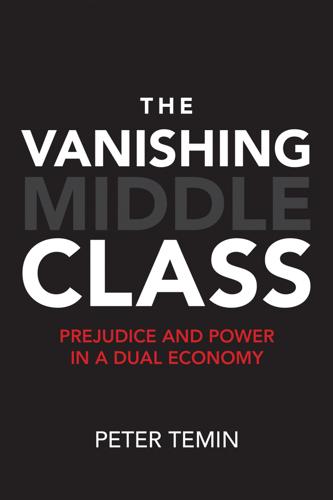
The Vanishing Middle Class: Prejudice and Power in a Dual Economy
by
Peter Temin
Published 17 Mar 2017
The Fed had been securing the exchange rate for the previous quarter century, and it had to learn how to fulfill its new role. This process was complicated greatly when the Organization of Petroleum Exporting Countries (OPEC) quadrupled the price of oil in 1973. The resulting “Oil Shock” sent many prices—including exchange rates—in motion.3 Anticipation of the Oil Shock led President Nixon to propose “Project Independence” in November 1971. Nixon’s emphasis was on domestic production and consumption, and his policy implied that the United States was to remain passive in the face of OPEC provocation. This idea was transformed over the next few years into a more active stance that would seek steady supplies of oil from the Middle East.
…
This idea was transformed over the next few years into a more active stance that would seek steady supplies of oil from the Middle East. Nixon also replaced the ailing draft for Army soldiers with the volunteer army at this time, a plan he also started before the Oil Shock. The draft had become difficult as the Vietnam War dragged on, and conservatives argued against the idea of forced service. This was an early step in the privatization of the military.4 The Oil Shock also raised the question of how the members of OPEC were going to hold their newly acquired wealth. The highly regulated financial system established at Bretton Woods in the 1940s could not easily absorb this large inflow of cash, and the cash found a temporary home in the arrangement for dollar deposits outside the United States.

Aerotropolis
by
John D. Kasarda
and
Greg Lindsay
Published 2 Jan 2009
What we couldn’t phase out was gasoline—which continues to fuel 95 percent of all vehicles—although consumers rushed to embrace fuel-efficient Japanese imports, just as they do now. As a consequence, transportation’s oil consumption grew by about 1.3 percent per year between the first oil shock of 1973 and the 2008 peak. But residential uses fell 2.1 percent, commercial uses 2.4 percent, and power generation 4.8 percent. Americans use half as much energy per capita as they did in 1973. While the decade’s oil shocks weren’t enough to wean us off fossil fuels—“the moral equivalent of war” in President Carter’s famous formulation—they did spur us to greater efficiency. Before the crisis in 1973, global oil consumption grew 8 percent a year.
…
The number of passengers in the United States this year is expected to hover around seven hundred million, 10 percent off its peak but still triple what it was in 1980. It’s grown five times faster than population since then. In thirty years, the number of miles flown by Americans dipped only once before our current crisis, in the wake of 9/11. Neither the early eighties oil shocks nor the first Gulf War slowed us down. Air travel follows the money. It’s a leading indicator of economic health, flying higher when times are good and falling faster when they turn bad. As it is, six hundred thousand Americans hopped a flight last week, more than the population of Milwaukee. Hubs are easily the world’s most central places, concentrating us like nowhere else.
…
This was hardly unexpected—Sheikh Mohammed’s father, Sheikh Rashid, knew it not long after oil was discovered in the 1960s. The knowledge defined Dubai, forcing its rulers to diversify and imagineer. While Abu Dhabi threw up topaz and tourmaline towers Dallas-style in the 1970s, Sheikh Rashid plowed his oil-shock profits into infrastructure. It was during his reign that Dubai built its ports, airport, drydocks, World Trade Center, and the first banks and hotels to cater to traders like Marwan Bibi. His greatest legacy was Jebel Ali, the largest man-made harbor ever created, carved from a stretch of empty beach.
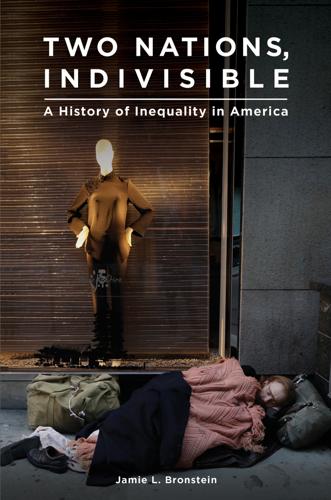
Two Nations, Indivisible: A History of Inequality in America: A History of Inequality in America
by
Jamie Bronstein
Published 29 Oct 2016
During the Nixon administration, the President’s Commission on Income Maintenance recommended a basic income guarantee for low-income Americans, the Family Assistance Plan. The plan was never enacted, although the Earned Income Tax Credit had its origin in this idea. When the Family Assistance Plan stalled and died, the political will to broaden the social safety net evaporated under economic pressure. Stagflation, the oil shocks of the 1970s, and deindustrialization brought malaise to the United States. These conditions enabled widespread acceptance of an alternative theory of prosperity, discussed in Chapter 7. Divorced from both equality of condition and equality of opportunity, Ronald Reagan’s tax cuts, military spending, safety-net slashing, and “trickle-down” economics promoted the idea that the freest markets were most efficient, and the most efficient markets produced the most prosperity.
…
The philosophers John Rawls’s A Theory of Justice (1971) and Robert Nozick’s Anarchy, State, and Utopia (1974) set out important interpretations of fair property-holding and distribution that have influenced divergent policies to this day. By the late 1970s, prosperity was lagging under the pressure of two oil shocks, unprecedented combined inflation and unemployment, and increasing American deindustrialization. The population shifted, following military bases and factories to southern states where unions were weaker or nonexistent and workers could be paid less. In the Rust Belt, the automobile factories that drove American prosperity furloughed workers.7 In the midst of this malaise, new voices began to blame the economic slowdown on Keynesian economics, taxation, and government economic regulation.
…
In the worst formulation, they described the poor as devious “welfare queens.”100 As the next chapter will show, Ronald Reagan, long an opponent of welfare programs, made those associations and claims central tenets of his administration. Under the pressure of neoliberalism, the Great Compression quickly began to unravel. CHAPTER 7 The Triumph of Neoliberalism: 1979–1999 Stagflation and the oil shocks of the 1970s had brought economic malaise to the United States, setting the stage for widespread acceptance of a new, “neoliberal” theory of prosperity, divorced from both equality of condition and equality of opportunity. Over the course of the next decade, Ronald Reagan’s severe tax cuts and George H.
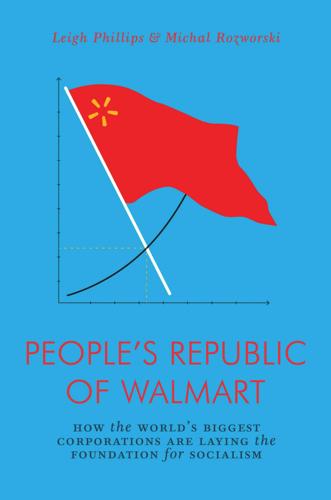
The People's Republic of Walmart: How the World's Biggest Corporations Are Laying the Foundation for Socialism
by
Leigh Phillips
and
Michal Rozworski
Published 5 Mar 2019
But Fed governors were explicit that they had deliberately applied the brakes to the economy and altered the costs of investment in order to change the climate in which capital bargained with workers. They planned, overriding what the (labor) market, left to its own devices, would otherwise have delivered. Similarly, during the first eight months of the 1973–75 oil-shock recession, interest rates continued to rise—nicely coinciding with UAW bargaining with the Big Three automakers. When the Fed finally lowered rates to stimulate investment and counteract the slump, Fed governors argued that, unlike expansionary fiscal policy carried out by Congress and the president, presumably at the behest of the democratic will, their independent actions would be much easier to undo when the economy “overheated” again and workers started to ask for more.
…
Rather than planning only how much healthcare there was, and where—the important questions that the 1960s planners had to tackle first—these reforms could also have laid the groundwork for planning that tackled how healthcare was produced and, most importantly, who participated in decision making. However, instead of ratcheting up democracy within the system, most of the 1970s reforms failed in the face of brewing economic crisis. The oil shock of the early 1970s saw both prices and unemployment spike at the same time—something that economists of all mainstream stripes had said was no longer supposed to happen. The regime of boom and bust was supposed to have been solved by Keynesianism, delivered by the postwar compromise between capital and labor.
…
Wasteful investment and unsustainable loans proliferated as underperforming enterprises attempted to improve their position in the market. To service these onerous debts, the reestablished managerial hierarchy, aided by a withered self-management apparatus, did what any normal capitalist manager does: squeeze wages and conditions. Unemployment made its return to the land. And all this before the global economic crises and oil shocks of the 1970s. Does this mean there is no room for market socialism or cooperatives in any conception of a just society? It depends on what time frame we consider. Let us abandon the view of market socialism and democratic planning as rivals. Instead, view cooperatives and market socialism (or elements of it) as bridging mechanisms toward decommodification and planning that build the confidence of ordinary people in their own capacity to govern a workplace without bosses—and ultimately to govern the entirety of the economy.

Oil: Money, Politics, and Power in the 21st Century
by
Tom Bower
Published 1 Jan 2009
However, he had set himself apart from other traders by ostensibly operating from Switzerland, in order to evade American taxes. That might have been ignored if he had not planned to profit by exploiting a crisis in Iran, where oil workers were striking to topple the Shah, disrupting supplies. Oil prices in Rotterdam rose by 150 percent, the harbinger of what would be called the second oil shock. Anticipating the shortage, Rich had again purchased oil for storage from corrupt Iranian officials. Among his customers was BP, the former owner of the Iranian oilfields, which was anxious to keep its refineries operating. BP’s reliance on Rich increased after the Shah was ousted from Tehran in January 1979 and replaced by the Islamic fundamentalist Ayatollah Khomeini.
…
Unlike other traders, Hall noticed that besides the increasing amounts of oil being imported by the USA and the simplicity of trading tankers of crude oil on the daily Rotterdam spot market, there was an opportunity to speculate about future prices by using schemes devised in the financial markets. The rapid changes in prices made those profits potentially lucrative. The second oil shock had hastened the development of speculation. The impetus for the change was BP’s discovery of oil in the North Sea. Before the discovery of the Forties field in 1970, few experts had believed that any riches would be found under the gray water. The surprise breakthrough fired a stampede, akin to a gold rush.
…
Size rather than the environment was again fashionable. Economy cars had been abandoned, and nearly a fifth of American motorists drove gas-guzzling SUVs, the biggest of which ran at four miles a gallon. Although oil imports were predicted by the US Government Accountability Office to rise to 60 percent by 2015, there was no fear of an oil shock. Smart technology that enabled drills to turn corners in rocks miles beneath the surface could be relied upon to produce more oil, and oil’s contribution to industrial production was diminishing. Raymond’s sense of certainty enhanced Exxon’s stature. He and Rex Tillerson were guided by their desire to satisfy their shareholders.
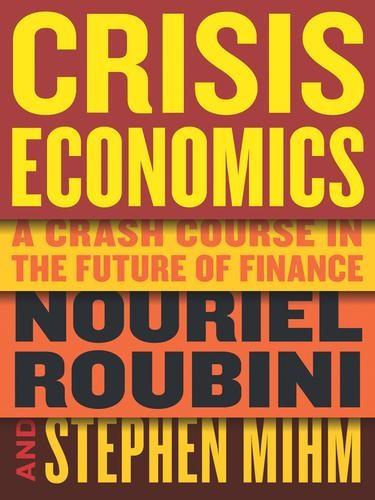
Crisis Economics: A Crash Course in the Future of Finance
by
Nouriel Roubini
and
Stephen Mihm
Published 10 May 2010
Cutting interest rates often had the added effect of driving down the value of the dollar, making exports more attractive, making imports more expensive, generating demand for domestic goods, and contributing to an eventual recovery. Fiscal stimulus was also used to restore growth. The first ten recessions in the postwar United States largely followed this script. Most lasted less than a year, save for a nasty recession in the wake of the oil shock of 1973, which was triggered by the Yom Kippur War; and after a second oil shock in 1979 caused by the Iranian Islamic Revolution, the Federal Reserve used high interest rates to slay inflation, resulting in a far more unpleasant recession. While brutal, that campaign proved successful and set the stage for the much-celebrated Great Moderation.
…
On September 7, Roubini, a professor of economics at New York University, addressed a skeptical audience at the International Monetary Fund in Washington, D.C. He forcefully sounded a warning that struck many in the audience as absurd. The nation’s economy, he predicted, would soon suffer a once-in-a-lifetime housing bust, a brutal oil shock, sharply declining consumer confidence, and inevitably a deep recession. Those disasters were bad enough, but Roubini offered up an even more terrifying scenario. As homeowners defaulted on their mortgages, the entire global financial system would shudder to a halt as trillions of dollars’ worth of mortgage-backed securities started to unravel.
…
This move unshackled monetary authorities that, freed of the constraints of a fixed-rate regime, could now print as much money as they wanted. The result was a rise in inflation and commodity prices, even before the 1973 Yom Kippur War led to an oil embargo and a quadrupling of oil prices. Stagflation, a deadly combination of high inflation and recession, followed the two oil shocks of 1973 and 1979 (the latter triggered by the Iranian Revolution) as well as the botched monetary policy response to these shocks. It took a new Federal Reserve chairman, Paul Volcker, to set things right. He sharply raised interest rates to stratospheric levels, triggering a severe double-dip recession in the early 1980s.
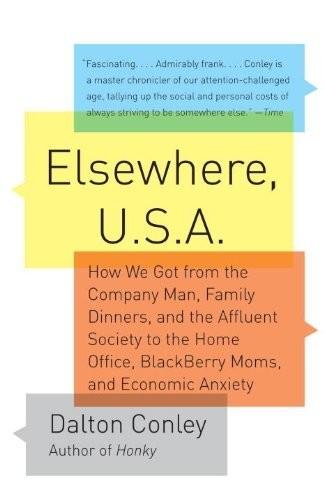
Elsewhere, U.S.A: How We Got From the Company Man, Family Dinners, and the Affluent Society to the Home Office, BlackBerry Moms,and Economic Anxiety
by
Dalton Conley
Published 27 Dec 2008
If it weren’t for death by a thousand imports, the Treaty of Detroit would have rotted from within, since—devoid of real competition—the system would have devolved into a Sovietlike goldbricking system of low-productivity work. Wages and prices would feed into the vicious circle of inflation, or rather stagflation (which, in fact, sparked by the oil shock of 1973, did befall us). Those generous provisions for health care and retirement have meant that American car companies (and other manufacturers) had little fat they could trim. Rather than give up defined benefit (i.e., guaranteed) pensions and health insurance for retirees, autoworkers clung to their hard-won gains—in part because union leaders are almost always closer to retirement than the rank-and-file workers they are meant to represent.
…
The auto industry, if anything, has been spared the worst of it since there is somehow symbolic importance to “buying American” (whatever that means) to many U.S. citizens, especially veterans and politicians. The point is: Don’t blame the Asians; our midcentury system of wage growth and relative equality was going to collapse one way or another. The oil shock of 1973—when the members of OPEC took the position that they would no longer ship oil to nations that supported Israel in the Yom Kippur War, curtailing production and thereby raising prices—makes as good a marker as any for the beginning of the end. Urban manufacturing declined just as our borders were opening up.
…
Stagnant wage growth has been a mantra of Democratic politicians and labor activists for the past two decades. Yes, it is true that if you track median wages and plot them against price rises based on the official inflation rate—the consumer price index (CPI)— then it does look like real wages have stagnated for the bottom half for most of the period since the oil shock of 1973.10 However, as my graduate school economics professor pithily stated: “Inflation is a great measure in the short run; but it’s a lousy measure over longer periods.” That’s the case mainly because of the way it’s calculated. Basically, the U.S. Bureau of Labor Statistics takes a common “basket of goods” and tracks the changes in prices of those goods from one time period to the next.
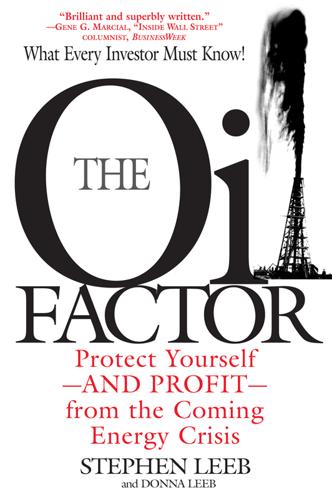
The Oil Factor: Protect Yourself-and Profit-from the Coming Energy Crisis
by
Stephen Leeb
and
Donna Leeb
Published 12 Feb 2004
And we tell investors exactly how they best can deal with this challenging new environment so as to come out winners. We hope you find it provocative, informative, and helpful. Introduction At various moments in the past thirty-plus years, oil has thrust itself front and center into our consciousness. The first oil shock came during the Arab oil embargo of 1973, when oil prices rose precipitously and filling up our tanks at the local gas station became a major ordeal. A few years later during the revolution in Iran, and then in 1991 prior to the first Gulf War, prices also soared. During these times, everyone fretted about oil.
…
Until oil prices rise sufficiently, we’re going to keep putting off facing reality. And that could be exceedingly dangerous. One reason for a sense of urgency about zeroing in on alternative energies as rapidly as possible, rather than dragging out the process by efforts at conservation, is that we can never know when we will experience a sudden oil shock that will abruptly choke off supplies. Unlike thirty years ago, when worldwide oil supplies were more abundant, we’re too close to the edge now to be sure we can survive such a blow. And with the world as fragile as it is, with most oil concentrated in politically hostile or unstable countries, it obviously would be naive to say that such a shock won’t happen.
…
Whatever your view of the primary motives behind our unprecedented initiation of the war in Iraq, this reality—the importance of securing world oil supplies—surely wasn’t entirely absent from the minds of our leaders. In later chapters we talk about how our vulnerability to oil shortages makes it essential that we continue to build up our military might. But trying to police the oil-producing world through our soldiers and weapons will never be a hundred percent foolproof—oil shocks can still occur—and efforts to do so obviously are fraught with a great many risks and problems. The only long-term answer is to develop acceptable and viable alternative forms of energy, and the sooner we do it, the better. So yes, it does seem disgraceful that the average mileage achieved by cars has been dropping significantly, one of the statistics frequently pointed out by pro-conservationists.
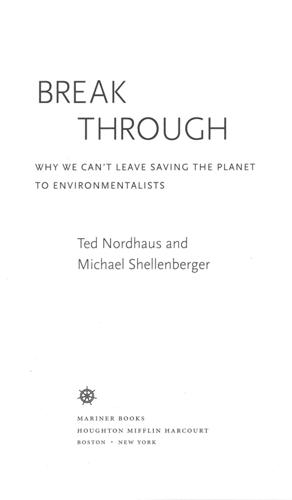
Break Through: Why We Can't Leave Saving the Planet to Environmentalists
by
Michael Shellenberger
and
Ted Nordhaus
Published 10 Mar 2009
In response to the widely publicized failures of colonization, Brazil’s military rulers shifted their emphasis to massive infrastructure development—roads, dams, and industrial agriculture—financed with loans from private lenders, the World Bank, and the Inter-American Development Bank. After the first OPEC oil shock, in 1973, the military took the nation’s debt to a new level when the dictatorship borrowed billions from foreign lenders at low but also variable interest rates in order to cover the abrupt increase in fuel costs. The generals’ borrowing accelerated after the second oil shock, in 1979, when oil accounted for 43 percent of Brazil’s imports.17 The moment of reckoning arrived in 1981, when the U.S. Federal Reserve raised the prime rate.
…
Despite the divisions of the Vietnam War, most Americans had within their lifetimes witnessed the striking economic and social transformations of the nation from Depression-era scarcity to postwar abundance. It is no accident that the great accomplishments of modern environmentalism, along with the great accomplishments of postwar liberalism, occurred at the moment of twentieth-century America’s greatest prosperity, nor is it a surprise that they occurred in the shadow of the oil shocks of the mid- and late 1970s that brought the egalitarian economic expansion of the postwar era to an end and the U.S. economy to its knees. Those economic shock waves, along with the global economic forces that transformed the American economy in the 1980s and 1990s and the rising conservative tide that dismantled much of the social safety net that the New Deal and the Great Society had built, brought about a new era of economic organization.
…
Over the past twenty years, as automobile technologies have improved exponentially, overall fuel-economy rates have gone down, not up. The Corporate Average Fuel Economy legislation, or CAFE, was crafted in 1975 more as a way to save the American auto industry, not the environment. With fuel prices rising dramatically after the oil shocks of the early 1970s, and U.S. automakers ill prepared to offer the fuel-efficient vehicles that the public was suddenly demanding, U.S. automakers, the UAW, and environmentalists alike agreed that a modest fuel-efficiency requirement made good sense and would help Detroit more effectively compete with foreign competitors, would reduce dependence on foreign oil, and would reduce air pollution.

Capitalism in America: A History
by
Adrian Wooldridge
and
Alan Greenspan
Published 15 Oct 2018
They could build sprawling houses or locate them in climate-challenged places because fuel was abundant. California was America’s prime example of what happens when you build a civilization on the basis of cheap fuel: people choose space over proximity and retailers quickly adjust to a less dense civilization by offering giant shopping malls and drive-throughs. Occasional oil shocks such as the one in the 1970s represented a fundamental threat to America’s way of life and promoted lots of talk about kicking the oil habit. As soon as the oil price declined, Americans returned to their earlier habits. The 1880s saw the introduction of two revolutionary new technologies, electric power and the internal combustion engine.
…
Nixon had no choice but to close the so-called gold window, stabilizing America’s gold holdings at about 275 million ounces, where they remained until 1979, but his decision nevertheless jolted the global economy. In the more than forty years since then the country’s gold holdings have barely budged and currently number 265.5 million ounces (see chart). U.S. OFFICIAL GOLD RESERVES 1957 – 1980 On top of the gold shock came an oil shock. America had dominated the world oil industry from the birth of the oil era in the 1870s. Every time it looked as if the country was running out of oil, new fields came on line: just as the Pennsylvania fields ran dry in the early 1900s, Americans discovered vast new supplies of oil in Texas and California.
…
The price of U.S. crude oil rose over ninefold between 1972 and 1981, sending shock waves through corporate America, starting with big energy consumers such as domestic transportation, oil refining, chemicals, steel, aluminum, and international shipping, but including the whole of the corporate world. Above all, the oil shock entrenched America’s biggest economic problem. Stagflation was a toxic combination of rising inflation and unemployment that Keynesian economists, citing the Phillips curve, which postulated a fixed trade-off between inflation and unemployment, said could never happen. In the fourteen-year stretch between 1969 and 1982, the annual rate of inflation only fell below 5 percent twice, and for four of those years it was in double digits, hitting 14.8 percent in March 1980.
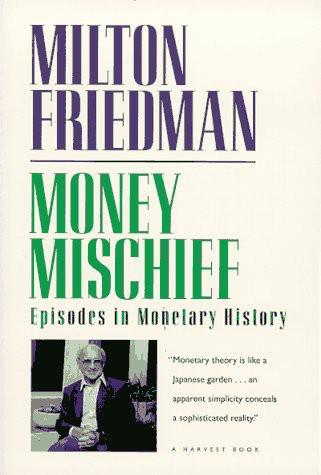
Money Mischief: Episodes in Monetary History
by
Milton Friedman
Published 1 Jan 1992
It did not produce any longer-lasting effect on the rate of inflation. In the five years after the 1973 oil shock, inflation in both Germany and Japan declined, in Germany from about 7 percent a year to less than 5 percent, in Japan from over 30 percent to less than 5 percent. In the United States, inflation peaked a year after the oil shock at about 12 percent, declined to 5 percent in 1976, and then rose to over 13 percent in 1979. How can these very different experiences be explained by an oil shock that was common to all countries? Germany and Japan are 100 percent dependent on imported oil, yet they did better at cutting inflation than did either the United States, which is only 50 percent dependent on imported oil, or the United Kingdom, which has become a major producer of oil.
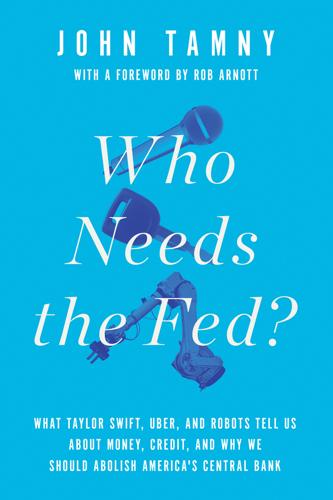
Who Needs the Fed?: What Taylor Swift, Uber, and Robots Tell Us About Money, Credit, and Why We Should Abolish America's Central Bank
by
John Tamny
Published 30 Apr 2016
For now, what the falling price of oil indicates is the irrelevance of the Organization of the Petroleum Exporting Countries (OPEC) to the price of oil. Lest we forget, OPEC formed in the 1960s but had no impact on the per barrel price. Furthermore, the oil “shocks” of the early and late 1970s similarly had nothing to do with OPEC. As Robert Bartley, the late editorial-page editor of the Wall Street Journal, explained in his spectacular 1992 book about the Reagan revival, The Seven Fat Years (in which he put “oil shocks” in mocking quotes): “The real shock was that the dollar was depreciating against oil, against gold, against foreign currencies and against nearly everything else.”13 Bartley pointed out, “In the confusion of the 1970s, no one noticed that OPEC officials told us plainly what was going to happen after the closing of the gold window.”
…
In truth, U.S. presidents, once again, get the dollar they want. Reagan and Bill Clinton were strong-dollar presidents as the low prices of gold and oil revealed in living color. George W. Bush got the weak dollar he wanted, as evidenced by the spike in the prices of gold and oil since 2001. We didn’t suffer “oil shocks” in the 2000s; we suffered the weak-dollar policies of President Bush, and during his first term, of President Barack Obama. In a replay of modern history, Bartley added, “When the price of oil shot up, the most fashionable sectors of American opinion persuaded themselves the world was running out of energy.”
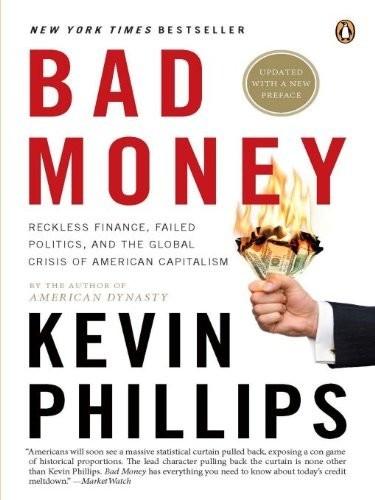
Bad Money: Reckless Finance, Failed Politics, and the Global Crisis of American Capitalism
by
Kevin Phillips
Published 31 Mar 2008
Indexes cobbled together by Dun’s Review around the ten leading conglomerates and parallel tensomes for technology and computers tumbled between 77 percent and 86 percent. 3 Those excesses, by and large, were purged. The seventies were a confused era, marked by two major oil-price shocks (1973-74 and 1979-80) that bred a pair of serious stagflationary recessions in more or less the oil-shock time frames. However, mortgage debt expanded like gangbusters as housing prices soared between 1976 and 1979, letting owners refinance and tap spendable funds. Alan Greenspan, who was chairman of President Gerald Ford’s Council of Economic Advisers, would keep those supportive precedents in mind almost thirty years later as Fed chairman.
…
Besides droughts that may be linked to climate change, experts cite new demand for foodstuffs from India, China, and the rest of Asia, as well as from the biofuels industry’s pursuit of corn for ethanol. One senior government minister in Australia raised the possibility of a global “food shock” to match the already obvious “oil shock.”14 The Russian government imposed retail price controls on some basic foodstuffs, Germany buzzed with newspaper headlines about milk and vegetable prices, and the director-general of the United Nations Food and Agricultural Organization noted in late 2007 that food prices in developing countries were up about 11 percent in the past year, spurring concern about food riots.15 In the United States, food represents 14 percent of the consumer price index, but the ratio is much higher in China (33 percent) and India (46 percent).
…
Petersburg Bourse Selected as Trading Floor for Oil Prices,” RIA Novosti, November 14, 2007. 66 “Mansoor Mohi-uddin, “View of the Day: US Dollar,” Financial Times, September 11, 2007. 67 Phillips, American Theocracy, p. 87. 68 Ibid. 69 Ibid., p. 95. 70 Ibid. 71 Ibid., p. 96. 72 Ibid., p. 95. 73 Matthew Simmons, Twilight in the Desert: The Coming Saudi Oil Shock and the World Economy (New York: Wiley, 2005). 74 Michael T. Klare, “Beyond the Age of Petroleum,” Nation, November 12, 2007. 6. THE POLITICS OF EVASION: DEBT, FINANCE, AND OIL 1 Mancur Olson, The Rise and Decline of Nations (New Haven, Conn.: Yale University Press, 1984). 2 Mother Jones, September-October 2002, p. 64. 3 Grover Norquist, “A Dynastic Disease in American Politics,” Financial Times, November 20, 2007. 4 Carl Bernstein, A Woman in Charge: The Life of Hillary Rodham Clinton (New York: Knopf, 2006); Jeff Gerth and Don Van Natta Jr., Her Way: The Hopes and Ambitions of Hillary Rodham Clinton (New York: Little Brown, 2006). 5 Cullen Murphy, Are We Rome?
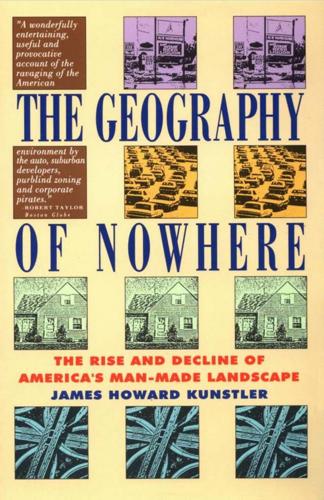
The Geography of Nowhere: The Rise and Decline of America's Man-Made Landscape
by
James Howard Kunstler
Published 31 May 1993
As expected, the new expressways promoted an ever-farther-flung subur ban expansion. A new merchandising gimmick called the shopping mall began to sprout up around the highway interchanges, offering a syn thetic privatized substitute for every Main Street in America. A golden age of ever-greater profit seemed to beckon . . . but then the first of the oil shocks struck: the so-called Arab Oil Embargo. Whether any actual oil shortage existed during those autumn weeks of 1973 is arguable, but the distribution and pricing apparatus certainly went amok at the threat of one. Since World War II, America's oil use had shot up so steeply that by the seventies many old American oil J O Y R I D E fields were pumped dry, and nearly half of our petroleum was coming from overseas.
…
Lines formed at pumps every where, people panicked, fistfights broke out, work schedules were disrupted, vacations were canceled, and nobody knew if the country would be able to carry on as before. A longer-term result was the rising cost of practically everything, otherwise known as inflation, since the . e of all commodi . _ods wer�_�Ilke�-,_ th��g� _manufact� ri!1..8 or distri utron, to the price�e oil shock also temporarily dis -;;ur;gea more mlgraffoi-it'o the new outer limits of the urban fringe. For instance, the trip from Mira Lorna to downtown Los Angeles might take only fifty minutes, but who was crazy enough to move that far when an Arab cartel could shut the oil spigot any time they pleased ?
…
This means that in the lifetimes of most Ameri cans living today, the essential fuel that has powered the suburban1 1 1 ... T HE GE O G R A P H Y O F N O W HE RE , consumer way of life will no longer be available. Ii will not be necessary to run out of petroleum in order to fatally disrupt a petroleum dependent economy. As the 1970s oil shocks demonstrated, all that it takes to mess things up is some instability of supply and price, and surely we will reach that stage before the wells run dry. Despite a lot of wishful thinking, and a near-religious belief in the "magic of technol ogy," there is no alternative in sight to the internal combustion engine that the masses of Illotorists cO!
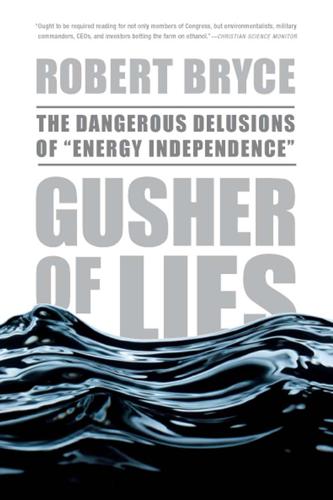
Gusher of Lies: The Dangerous Delusions of Energy Independence
by
Robert Bryce
Published 16 Mar 2011
Mills, writer of the Forbes column “Energy Intelligence,” and co-author of The Bottomless Well: The Twilight of Fuel, the Virtue of Waste, and Why We Will Never Run Out of Energy “In Gusher of Lies Robert Bryce does political leaders around the world an enormous favor by debunking in its entirety the myth that anymajor energy-consuming countrywith flat or declining energysupplies can ever achieve the utopia called ‘energy independence.’ He also lucidly spells outexactly whyAmerica is the least likely country even to come close.” —Matthew Simmons, chairman of the Houston-based investment banking firm Simmons & Company International, and author of Twilight in the Desert: The Coming Saudi Oil Shock and the World Economy “He blasts Republicans, Democrats, the presidential candidates, Al Gore, Robert Redford, environmentalists, and energy analysts for misleading the public about our energy needs. . . . Meticulously researched with copious facts—nearly all footnoted—this illuminating and sometimes witty work offers another view of the current state of energy.”
…
After more than 300 pages of a mostly clear-eyed survey of the global energy business, he concludes that every year that goes by is “another year in which our unstable energy economy moves so much closer to the point of no return.”56 While there is much to recommend in Roberts’s book, he fails to provide readers with an understanding of the rapid globalization of the energy business. Instead, he sticks with a U.S.-centric approach, and in doing so, he implies that America holds the keys to the global energy future. That’s no longer true. Another notable book that raised anxiety about future oil production was Twilight in the Desert: The Coming Saudi Oil Shock and the World Economy, written by Matthew Simmons, the founder and chairman of the Houston-based investment banking firm Simmons & Co. International. Published in 2005, the book gained particular attention because Simmons is a Republican and was an adviser to George W. Bush on energy issues. Simmons’s book claims that Saudi Arabia has been obscuring the problems in its oil fields and that the kingdom will not be able to significantly boost its oil output.
…
Roberts, Paul. The End of Oil: On the Edge of a Perilous New World. New York: Houghton Mifflin, 2004. Sifry, Micah L., and Christopher Cerf. The Iraq War Reader: History, Documents, Opinions. New York: Touchstone, 2003. Bibliography 375 Simmons, Matthew. Twilight in the Desert: The Coming Saudi Oil Shock and the World Economy. Hoboken, N.J.: John Wiley & Sons, 2005. Smil, Vaclav. Energy at the Crossroads: Global Perspectives and Uncertainties. Cambridge: MIT Press, 2003. Stagliano, Vito A. A Policy of Discontent: The Making of a National Energy Strategy. Tulsa, Okla.: PennWell, 2001. Woodward, Bob.
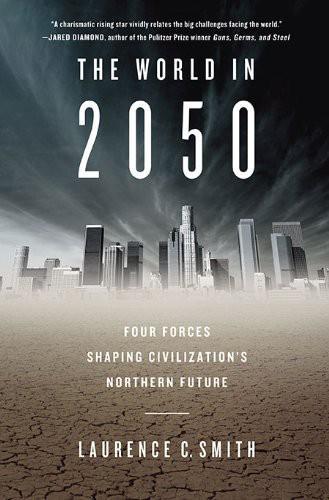
The World in 2050: Four Forces Shaping Civilization's Northern Future
by
Laurence C. Smith
Published 22 Sep 2010
Disturbing twenty-first-century scenarios of intense competition for oil—even to the point of economic collapse and violent warfare—are described in the books Out of Gas by David Goodstein, Resource Wars and Rising Powers, Shrinking Planet: The New Geopolitics of Energy by Michael Klare, and Twilight in the Desert: The Coming Saudi Oil Shock and the World Economy by Matt Simmons.111 These authors are neither hacks nor alarmists. Simmons is a lifelong Republican and oil industry insider, and is widely respected as one of the smartest data analysts in the business. Goodstein is a Caltech physicist, and Klare has long experience in military policy.
…
Andrews, “Mineral Resources, Economic Growth, and World Population,” Science 185 (1974): 13-10. 100 For more on this discussion of mineral exhaustion and the perils of a fixed-stock approach to resource assessment, see John E. Tilton, On Borrowed Time? Assessing the Threat of Mineral Depletion (Washington, D.C.: RFF Press, 2002), 160 pp. 101 Matthew R. Simmons, Twilight in the Desert: The Coming Saudi Oil Shock and the World Economy (Hoboken, N.J.: John Wiley & Sons, 2005), 428 pp. 102 A very detailed analysis comes from the National Institute for Materials Science in Tsukuba, Japan. The authors use the Goldman Sachs BRICs and G6 economic projections discussed in Chapter 2 to project future demand for twenty-two metals.
…
Norton & Company, 2005), 148 pp.; M. Klare, Resource Wars: The New Landscape of Global Conflict (New York: Holt Paperbacks, 2002), 304 pp.; and Rising Powers, Shrinking Planet: The New Geopolitics of Energy, reprint ed. (New York: Holt Paperbacks, 2009), 352 pp.; M. Simmons, Twilight in the Desert: The Coming Saudi Oil Shock and the World Economy (Somerset, N.J.: John Wiley & Sons, 2005), 428 pp. 112 On average, postpeak oil field decline rates are 3.4% for supergiant fields, 6.5% for giant fields, and 10.4% for large fields, World Energy Outlook 2008, OECD/IEA (2008), 578 pp. 113 A successful Al Qaeda attack on the Abqaia facilities would have shocked world oil markets, as it handles two-thirds of the Saudi Arabian oil supply.
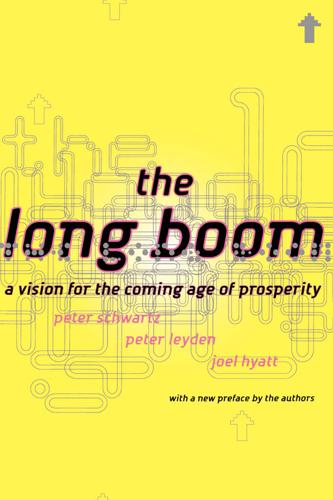
The Long Boom: A Vision for the Coming Age of Prosperity
by
Peter Schwartz
,
Peter Leyden
and
Joel Hyatt
Published 18 Oct 2000
The boom also saw the emergence of a generation—the Baby Boom generation—that reaped all the benefits of this prosperity. But just about the time that the first Baby Boomers finished their formal education and began to enter the economy, the boom began to falter. The oil price shock of 1973 started the stumble, pushing the economy into stagnation coupled with inflation, so-called stagflation. The second major oil shock, in 1979, which brought another quadrupling of prices, dashed any hope that the boom could pick up again. For the rest of the twentieth century, the post-World War II boom was the standard that we always wanted to attain. If only we could achieve the level of growth enjoyed in that era. If only prosperity could spread as quickly.
…
But that economic boom didn't stop in the United States, and it didn't stop in the 1950s. That same boom spread throughout the Free World in the 1960s. Europe got back on its feet after the war, and Japan also rebuilt. All these economies were booming throughout the 1960s—causing huge repercussions in their social and political arenas as well. This high growth continued until the oil shocks of 1973, when the quadrupling in price of oil, the lifeblood of the Industrial Age economy, helped choke off the growth and push the economies of the developed world into the stagflation of the 1970s. Still, the economic expansion had had a good twenty-five-year run. Those same two megatrends are driving through our Long Boom era today.
…
We need to begin to figure out better ways to broker difficult political deals in a global context, as we did in the treaty that stopped the production of ehlorofluorocarbons, which had been destroying the ozone layer. In Long Boom terms, the environmental crisis is a catalyst that will increase global interdependence over time. In another 30 years, we'll laugh about how fractured we feel now. The STORY of Oil The last great global economic boom, the post-World War II boom, ended in the oil shock of 1973. Oil, that lifeblood of the industrial economy, shot up in price by a factor of 4, going from Just $3 a barrel to $13 in the dollars of the day. That hike was bad enough, but then came the shock of 1979, which nearly quadrupled the price again, from $13 to $45. Almost all forecasts at that time told the world to brace for another big price hike in the late 1980s, to $100 a barrel.

There Is Nothing for You Here: Finding Opportunity in the Twenty-First Century
by
Fiona Hill
Published 4 Oct 2021
Structurally, the United Kingdom and the United States—like Russia and other advanced economies—cycled through a rapid buildup of extractive industry and mass manufacturing in the 1920s and 1930s and again at the end of the Second World War. Our nations began the descent into what became known as the postindustrial era in the 1960s, and especially after the 1970s, when they were hit by successive oil shocks. Major oil producers in the Middle East, members of the Organization of Petroleum Exporting Countries (OPEC), imposed an embargo on countries such as the UK and the U.S. for supporting Israel in its Yom Kippur War with Arab states. Both the United Kingdom and the United States had their own sources of oil and gas, but they remained dependent on Middle East imports.
…
The embargo forced a period of harsh adjustment to sudden energy scarcity and soaring prices, including gasoline rationing and utility cuts to curb demand. It also led to a substantial restructuring of the automotive industry to favor smaller, more fuel-efficient cars. The United Kingdom and its huge coal, steel, shipbuilding, and manufacturing industries were especially hard pressed by the oil shocks and related developments. The 1970s saw stagnant growth and soaring inflation. Alongside the oil embargo, the global economy began to change rapidly, with technological breakthroughs that enabled the automation of manufacturing and put more emphasis on the movement of capital and finance than on raw materials and goods.
…
Stuck in the USSR For me, born in 1965, and from my vantage point of experiencing life in the North East of England, then the Soviet Union, and then the United States, the big three military and industrial powers of World War II were facing similar postindustrial challenges, albeit on slightly different timescales. Historically, the USSR’s trajectory of industrial development was similar to those of the United Kingdom and the United States in the twentieth century, with periods of booms and busts before and after the Second World War. The USSR had been mostly on the sidelines during the oil shocks of the 1970s, as it developed its own oil and gas reserves for domestic consumption, but it could not escape the effects of the technological changes that pushed other economies toward modernization and away from heavy industry. The Soviet Union was the bastion of workers in coal mines and smokestack industries and massive factories.
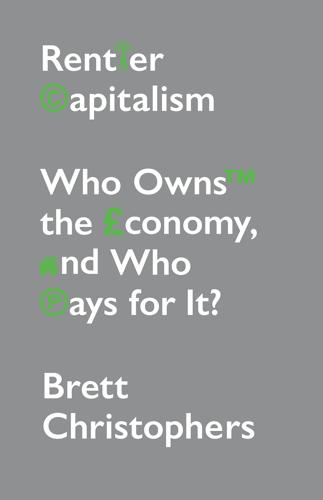
Rentier Capitalism: Who Owns the Economy, and Who Pays for It?
by
Brett Christophers
Published 17 Nov 2020
Mommer, ‘Fiscal Regimes and Oil Revenues in the UK, Alaska and Venezuela’, June 2001, p. 8 – pdf available at oxfordenergy.org. 41. Shaxson, Poisoned Wells, p. 2. 42. J. Boué, ‘The 1973 Oil Shock and the Institutional and Fiscal Framework for Petroleum Exploration and Production Activities in the UK North Sea’, in A. Beltran, É. Bussière and G. Garavini, eds, L’Europe et la question énergétique: Les années 1960/1980 (Brussels: P.I.E. Peter Lang, 2016), pp. 235–53, at p. 242. 43. Nakhle, ‘Petroleum Fiscal Regimes’, p. 96. 44. Boué, ‘1973 Oil Shock’, p. 244. 45. P. Wright and J. Boué, ‘The United Kingdom: Public Debate and Management of Petroleum Resources’, in I.
…
Meanwhile, periodically constituted ‘expert groups’ are also ‘made up entirely of oil companies and their associations and tax advisers’.50 The UK’s denuded fiscal regime for oil and gas can also be explained in terms of the historic geopolitical context. In the 1970s and 1980s, the government was in a singular hurry for the North Sea’s oil and gas to be extracted as quickly as possible, largely because of a desire to undercut Opec, whose influence over global energy supplies and prices had been substantially heightened by the 1973 oil shock.51 One way to expedite rapid extraction was through stimulatory tax policy – and, as Mommer would later write, there is ‘no doubt that the lower level of taxation had a positive impact on production’.52 Last but not least, the performative dimension of reserve estimation (see above) has also played a significant role.
…
Boué, ‘The United Kingdom: Public Debate and Management of Petroleum Resources’, in I. Overland, ed., Public Brain Power: Civil Society and Natural Resource Management (Basingstoke: Palgrave Macmillan, 2017), pp. 329–46, at p. 335. 46. Boué, ‘1973 Oil Shock’, pp. 244, 246. 47. Energy Charter Secretariat, ‘Taxation Along the Oil and Gas Supply Chain: International Pricing Mechanisms for Oil and Gas’, 2008, p. 67 – pdf available at energycharter.org. 48. Mommer, ‘Fiscal Regimes and Oil Revenues’, p. 26. 49. Wright and Boué, ‘United Kingdom’, p. 336. 50. G. Muttitt, A. Markova and M. Crighton, ‘Sea Change: Climate Emergency, Jobs and Managing the Phase-Out of UK Oil and Gas Extraction’, May 2019, p. 35 – pdf available at priceofoil.org. 51.
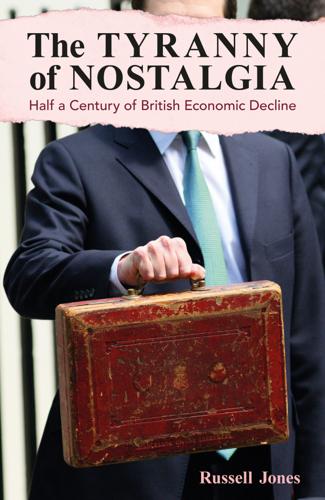
The Tyranny of Nostalgia: Half a Century of British Economic Decline
by
Russell Jones
Published 15 Jan 2023
Russell does more than give us an excellent economic history of Britain since the gloss peeled off the Keynesian welfare state in the 1970s: he shows us how each administration was effectively handed a set of problems to solve, how they each tried to solve them in the shadow of the prior administration’s failures, and how that process always produced the next set of problems. For example, notwithstanding the 1973–74 oil shocks, Heath’s gamble with the ‘Barber boom’ set up the industrial relations and inflation mess that Wilson and Callaghan had to deal with. The limits of their solutions in turn discredited organized labour and incomes policies, setting the stage for Thatcher’s experimentation with monetarism. The failure of that strand of numerology eventually morphed into the grab bag of policies that was the ‘medium-term financial strategy’ plus financial deregulation – a combination that effectively deindustrialized the UK while powering a series of asset price bubbles, especially in housing, that have both propelled it forward and crippled it ever since.
…
It remained close to balance as the recovery began, but the boom of the second half of the decade plunged the external balance back into the red. In 1989 the current account shortfall amounted to almost 5% of GDP, exceeding that which followed both the Maudling boom of the early 1960s and the Barber boom and first oil shock of the 1970s. Unemployment rose to levels that surprised the government, and which would have been unconscionable in the three previous decades. This was despite the basis of calculation being repeatedly adjusted to flatter the published figures. The jobless total would have risen close to 4 million if it had been calculated in the same way as it had been in previous decades: around 750,000 higher than the official number.
…
The primary explanation for the initial surge in unemployment appears to have been the tightness of monetary policy, and especially the high level of interest rates and, thereby, the exchange rate. Official interest rates were at 14% or higher for twenty-one consecutive months from June 1979, and respite did not appear quickly thereafter. It is hard to attach much blame to the second oil shock, as there was no dramatic deterioration in the UK’s terms of trade akin to that seen in 1973 and 1974. Sharply higher oil prices did, however, push up headline inflation at the beginning of the decade, as indeed did public sector wage settlements that the government felt compelled to honour, and a decision to sharply raise indirect taxes.
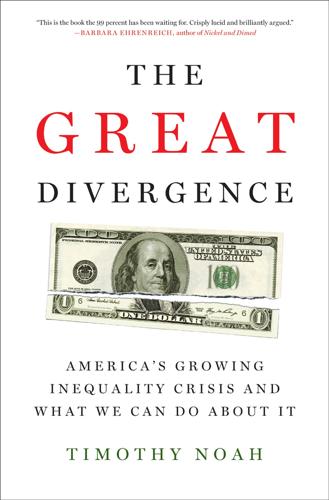
The Great Divergence: America's Growing Inequality Crisis and What We Can Do About It
by
Timothy Noah
Published 23 Apr 2012
Economic trends are hard to interpret in real time because doing so requires data, and the best and most complete data sets often aren’t available for five or ten years. By the time they are available, the world has moved on to fretting about newer trends. As a result, when the day arrives for us to understand better, say, the oil shocks of 1973, or the recession of 1982–83, we are preoccupied with trying to figure out the tech boom of the late 1990s or the housing bubble of the aughts. By “we,” I mean all of American society but especially my own fraternity of political and policy-wonk journalists. History isn’t news. But the Great Divergence has been going on for so long that it manages to be both.
…
The Trinity University economist Barry Hirsch calculated in a 2007 paper that if the only change between 1983 and 2002 had been the shift in where the jobs were, private-sector union density would have fallen by less than two percentage points. Instead, it fell by eight.12 Many of the calamitous economic conditions of the 1970s were not unique to the United States. The oil shocks affected all industrialized nations, similar productivity declines were observed elsewhere, and the very nature of global competition is that it’s, well, global. But in other industrialized nations, the effects were quite different. Union density actually increased in most industrialized countries during the 1970s even as it was decreasing in the United States.
…
The latter was caused partly by rising food consumption in more prosperous economies abroad and partly by a deliberate policy by the Nixon administration to reduce domestic agricultural production (and thereby increase food prices) to court the farm vote in 1972. 9. Frank Levy, interview with author, Apr. 22, 2011. 10. The disruptive oil shocks of the 1970s—in 1973 and 1974 alone oil prices quadrupled—likely played a significant role. 11. William J. Baumol and Alan S. Blinder, Macroeconomics: Principles and Policy (Mason, OH: South-Western College Publishing, 2010), 145; Paul Krugman and Robin Wells, Macroeconomics (New York: Worth, 2009), 233; Susan Fleck, John Glaser, and Shawn Sprague, “The Compensation-Productivity Gap: A Visual Essay,” Monthly Labor Review, Jan. 2011, 57–69. 12.

The Age of Stagnation: Why Perpetual Growth Is Unattainable and the Global Economy Is in Peril
by
Satyajit Das
Published 9 Feb 2016
Japan too had a radical group known as the Red Army. The 1969 film Easy Rider provided the coda for the period, symbolizing the confused dissent of a generation. Wyatt (played by Peter Fonda, Jane's brother) admits in the film's climax that they had failed, blown it. The seventies was the decade of oil shocks, which occurred in 1973 and 1979 and ended a period of low prices. In the US this was compounded by oil production peaking. In October 1973, Arab members of the Organization of the Petroleum Exporting Countries (OPEC) proclaimed an oil embargo, in response to US backing for Israel during the Yom Kippur War and in support of the Palestinians.
…
Commencing in the 1980s, there was unprecedented expansion in cross-border trade and flow of capital. The large US deficits resulting from the Vietnam War and Great Society programs had created significant overseas holdings of US dollars. The need to lend these out led to a nascent international money market centered in London—the euro market. The oil shocks had created petrodollars, US dollars paid to oil-exporting countries. Saudi Arabia, Kuwait, and others amassed large surpluses of petrodollars, which they could not immediately use because of their small populations and lack of industrialization. The surpluses were deposited in the euro market and lent out, mainly to less developed countries.
…
In the late 1960s, GM's profitability declined. With car ownership having reached very high levels, the market was saturated. In 1965, Ralph Nader's bestselling Unsafe at Any Speed drew unwelcome attention to the auto industry's safety issues, mechanical defects, and quality problems, placing additional pressure on earnings. Then came the oil shocks of the 1970s and an increased demand for compact, fuel-efficient vehicles, which US car makers had shunned in favor of ever larger, more powerful dream machines. Foreign carmakers captured market share. The quality and features of Japanese cars, once the object of jokes, improved. Sophisticated buyers came to prefer European luxury marquee brands, such as Mercedes-Benz, BMW, Porsche, and Ferrari.
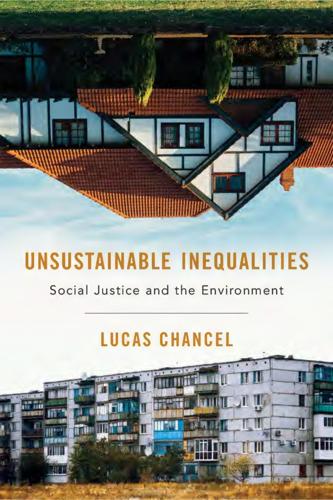
Unsustainable Inequalities: Social Justice and the Environment
by
Lucas Chancel
Published 15 Jan 2020
They are mainly a result, in other words, of political decisions that can be counteracted. THE ROLE OF ENERGY At this point anyone reading a book with a title such as mine may well feel justified in asking what role the present ecological crisis, and energy in particular, plays in the increase of inequalities since 1980—and all the more when one considers that the oil shocks of the 1970s were accompanied by a historic rebound of inequalities and accumulated wealth in the industrialized countries. Let us begin by noting that inequality levels throughout the world and within certain regions are closely linked to the distribution of natural resources (particularly oil) and to property rights to these resources.
…
The remaining half is trickier to analyze statistically. It may be due to social norms and a mental outlook peculiar to the generation born after the war; at all events, baby boomers exhibit less virtuous behaviors than their parents, who had endured wartime rationing, among other hardships, and their children, who were born after the oil shocks of the 1970s. In France, as in the United States, younger people today say that they care more about the fate of the environment than their parents do. And yet, as we have seen, the lower emissions levels observed for this generation in France are partly a consequence of economic constraints, not solely of a widespread fear of ecological crisis.
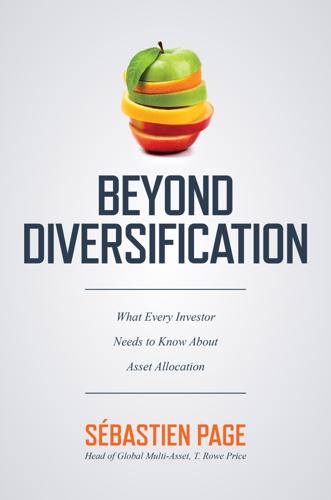
Beyond Diversification: What Every Investor Needs to Know About Asset Allocation
by
Sebastien Page
Published 4 Nov 2020
See Jack Treynor (1961), Bill Sharpe (1964), John Lintner (1965), and Jan Mossin (1966). 2. “Professor William Sharpe Shares Nobel Prize for Economics,” gsb.stanford .edu. 3. As I finalize this book at the end of March 2020, equity markets have suffered one of their worst and fastest sell-offs in history due to the coronavirus pandemic, combined with a major oil shock. The Federal Reserve has aggressively lowered rates, and the three-month US Treasury bill is at zero. These are unusual circumstances. In this context, expected returns across asset classes should be about 1–2% lower due to lower rates, compared with those of 2018. But on the other hand, valuations are more attractive than they were back in 2018, in a way that may offset lower rates. 4.
…
There are several analytical tools available to asset allocators to model fat tails, such as historical analysis, blended probability distributions, and scenario analysis. Nassim Taleb (2010) argues that we can’t predict higher moments. We don’t know when extreme losses will occur, but we should build resilience to them. Black swans, like the pandemic and oil shock of 2020, are rare, but they do exist. Taleb notes, “The Black Swan idea is not to predict—it is to describe this phenomenon, and how to build systems that can resist Black Swan events.”1 And “Black Swans being unpredictable, we need to adjust to their existence (rather than naïvely try to predict them).”2 There are many examples where we must build resilience to rare but consequential events that we can’t predict, in all areas of life.
…
Aggregate from January 2008 to February 2020, if we exclude Treasuries and securitized bonds, the weight of high-quality bonds (rated AAA or AA) has decreased from 21 to 2% as a share of corporates. Hence, the weight of the riskier bonds (rated A or BAA) has increased from 89 to 98% of corporates and from 15 to 23% of the entire index. Therefore, a risk-off scenario based on historical returns for the index would likely underestimate exposure to loss. As the coronavirus and oil shock events unfolded during the first half of 2020, this deterioration in credit became painfully evident. There are many other such examples across asset classes. US small caps have deteriorated in quality; value stocks have become more cyclical; etc. The bottom line is that a simple scenario analysis based on historical asset class returns can lead to an underestimation or overestimation of exposure to loss, because asset classes change over time.
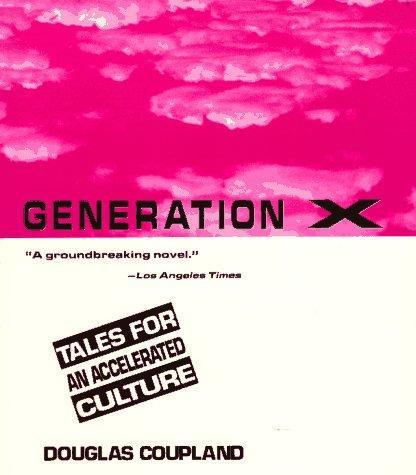
Generation X: Tales for an Accelerated Culture
by
Douglas Coupland
Published 15 Mar 1991
" • But again, the village is not entirely dead. A few people do live there, and these few troopers have a splendid view of the windmill ranch down below them that borders the highway—tens of thousands of turbo blades set on poles and aimed at Mount San Gorgonio, one of the windiest places in America. Conceived of as a tax dodge after the oil shock, these windmills are so large and powerful that any one of their blades could cut a man in two. Curiously, they turned out to be functional as well as a good tax dodge, and the volts they silently generate power detox center air conditioners and cellulite vacuums of the region's burgeoning cosmetic surgery industry.
…
Life is boring there, but are some thrills to be had: all the adults keep large quantities of cheaply sewn scarlet sex garments in their chests of drawers. These are panties and ticklers rocketed in from Korea— and I say rocketed in because Texlahoma is an asteroid orbiting the earth, where the year is permanently 1974, the year after the oil shock and the year starting from which real wages in the U.S. never grew ever again. The atmosphere contains oxygen, wheat chaff, and A.M. radio transmissions. It's a fun place to spend one day, and then you just want to get the hell out of there. Anyhow, now that you know the setting, let's jump into Claire's story.

More: The 10,000-Year Rise of the World Economy
by
Philip Coggan
Published 6 Feb 2020
Many people use the word neoliberal for this trend, but its definition is fairly vague, and it has become a catch-all term of abuse. 2. Jones, Multinationals and Global Capitalism, op. cit. 3. Max Roser, “Life expectancy”, Our World in Data, https://ourworldindata.org/life-expectancy 4. Laurel Graefe, “Oil shock of 1978–79”, https://www.federalreservehistory.org/essays/oil_shock_of_1978_79 5. Ibid. 6. Source: https://www.nber.org/cycles.html 7. J.-P. Fitoussi and E.S. Phelps, “Causes of the 1980s slump in Europe”, https://core.ac.uk/download/pdf/6252244.pdf 8. Olivier Blanchard and Lawrence Summers, “Hysteresis and the European unemployment problem”, https://www.nber.org/chapters/c4245.pdf 9.
…
This chapter will deal with developments in the rich world before picking up the story of the developing world in Chapter 16. Another oil crisis and recession These developments were not predictable in the immediate context of 1979. The immediate problem the world economy had to deal with was another oil shock. In the turmoil surrounding its revolution in early 1979, Iranian oil production fell by 4.8 million barrels a day, or 7% of global output. Many oil users reacted by building up their inventories, thus creating extra demand; and Opec added further pressure by announcing a price increase in December 1979.
…
Third, Britain joined the system in the hope that ERM membership would deliver the discipline needed to control inflation. The tighter monetary policy that followed German reunification exacerbated an early 1990s recession. The US had a mild downturn from July 1990 to March 1991 that was associated with higher rates and another oil shock after Iraq invaded Kuwait and was subsequently expelled by a Western-led coalition.39 British interest rates were in double digits for much of its ERM membership, inflicting considerable pain on the domestic economy. Speculators, of whom the most prominent was George Soros, a hedge-fund manager, bet on a falling pound and the Bank of England’s reserves started to dwindle.
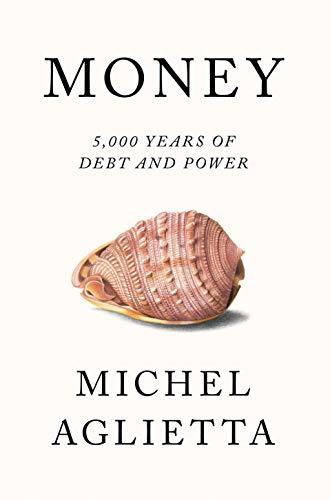
Money: 5,000 Years of Debt and Power
by
Michel Aglietta
Published 23 Oct 2018
It was for this reason that the turnaround of US monetary policy in October 1979, which would provoke a global recession and a catastrophic fall in raw materials prices, necessarily brought a devastating devaluation of the peso. The recession caused by the US monetary policy reversal brought an oil shock, which, combined with prohibitive international interest rates, drove fresh crises in all raw-materials producer countries. Mexico initiated the chain of crises in Latin America in August 1982. Brazil experienced sharp inflation across the 1980s, to which a series of monetary plans were unable to put a stop.
…
The true winners of the destruction of the Bretton Woods system were the international investment banks, who were able to arbitrate between currencies and throw themselves into credit distribution policies at the international level, with all the risks of financial crisis that this entailed. From the second oil shock in 1978 onwards, they swept across the whole world in an orgy of indebtedness that lasted thirty years, before once more opening up an era of financial crises. The second financial globalisation process that resulted was very different from the first such process, because while the first had been inscribed in the gold standard monetary order, the second was coupled with a return to the international monetary jungle.
…
Given the lack of any common rule, what can be said about exchange movements and the adjustment effects that they supposedly bring? AFTER THE JAMAICA ACCORDS: THE DECENTRALISED DOLLAR SEMI-STANDARD SYSTEM The second financial globalisation process began with two almost simultaneous events: the failure of the C20’s attempt to reform the international monetary system, and the first oil shock in 1973. This shock radically altered the extent and direction of international capital flows. There was now a polarisation between oil exporter and importer countries. The preservation of global growth demanded a powerful expansion of international credit. American investment banks and European universal banks sank into the breach opened up by governments’ incapacity to reorganise the financing of development and by the extremely small volume of IMF resources in relation to the financing that was required.
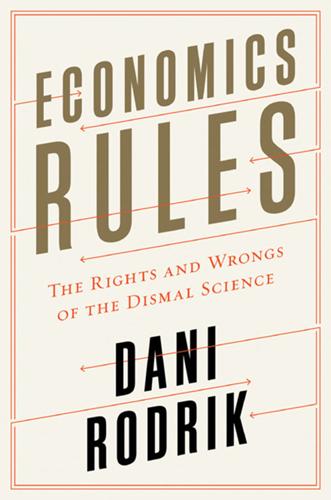
Economics Rules: The Rights and Wrongs of the Dismal Science
by
Dani Rodrik
Published 12 Oct 2015
In our oil example, this is a fairly innocuous mechanism that passes the verification test comfortably. The relationship between quantities supplied and prices makes sense intuitively, and there are plenty of real-world examples in which shocks to supply have had observable effects on prices in the hypothesized direction; consider the oil shock of 1973–74, for example. We do not need to have seen a demand curve or know what the technical definition of a market equilibrium is—both abstract concepts that do not have physical counterparts—to believe that the mechanism the model relies on is reasonable. But in other cases, the mechanism may result from more complicated behavior and may require greater justification.
…
This demand-side view of macroeconomics prevailed pretty much through the 1970s. It was elaborated in models of increasing variety and spawned large-scale computerized versions that could generate quantitative forecasts of major macroeconomic aggregates such as employment levels and capacity utilization rates. Then two things happened: the oil shock and Robert Lucas. The oil crisis of 1973, precipitated by the embargo applied by the Organization of the Petroleum Exporting Countries (OPEC), fomented a new set of economic circumstances that had not been on economists’ radar screen: recession and inflation at the same time, or “stagflation.” Demand-side models wouldn’t be much help in the face of what was patently a supply-side shock.

Player One
by
Douglas Coupland
Published 30 Jun 2011
Marion King Hubbert was a Shell Oil geologist who predicted in 1956 that US domestic oil production would peak around 1970 and that global production would peak around 2000.” “And . . . ?” Warren continued, “That production peak is called Hubbert’s Peak. And it looks like it’s finally happened.” As an aside, Karen said, “The 1970s oil shock set his calendar back by a decade. But he was right.” “How on earth do you people know this?” “It’s kind of weird,” Karen said. “We met in a — God, this is so embarrassing — a Peak Oil Apocalypse chat room.” “Man,” Warren said, “wouldn’t Hubbert freak to see oil over $250 a barrel.” Rick said, “You mean you two actually did meet in a Peak Oil Apocalypse chat room?”
…
“Okay,” Karen says, “while we try to figure out some other way of getting help, I’m having a drink. Who else wants one?” ___ The quartet sat on the floor behind the bar with their drinks, positioned halfway between the exits — the safest location, given all options. There was some discussion about the chaos that would surely ensue in the outside world, echoes of the 1973 oil shock but infinitely worse: the only gas people were going to get was whatever they still had in their tanks, maybe enough to get to work a few more times — except work was probably gone now too. Kill your neighbour for a tank? Why not? Will the military help out? Oh, please. Karen remembered a few months back seeing a truck that looked military, but she wasn’t sure if it was real or from a film shoot.

A Generation of Sociopaths: How the Baby Boomers Betrayed America
by
Bruce Cannon Gibney
Published 7 Mar 2017
The other major problem was unemployment, which was rising, albeit from the exceedingly low level of 3.9 percent in January 1970 to 5.1 percent just after the first oil shock, then rising substantially as recession set in. By 1979, it was back to 5.6 percent, before another oil shock wrought more havoc, but through the 1970s, conditions never quite achieved the same severity as what happened post-2008.17 It was a fairly good result considering the oil shocks, the large numbers of veterans returning to civilian employment after Vietnam, and the hordes of Boomers entering the workforce every year. But unemployment threatened the young Boomers most of all; the economy was simply not growing fast enough for them.
…
Transport depends heavily on gas taxes, and as with taxes of all kinds under Boomer tenure, these have been falling. The federal gas tax is 18.4 cents plus a (volume-weighted) average 26.59 cents at the state level, for a total of 44.99 cents per gallon as of 2015.15 Until the 1970s, this arrangement had a certain logic, as prices were stable and road use tightly correlated with gas consumption. However, the oil shocks of the 1970s encouraged citizens to shift to somewhat more efficient cars while spurring inflation that diminished the real value of gas taxes because the federal and most state gas taxes are not indexed to inflation (unlike benefits payments or tax brackets that benefit Boomers).16 Technology may only exacerbate the disconnect, because if electric cars are ever widely adopted, their use will only expand funding gaps; e-cars are literal free riders.
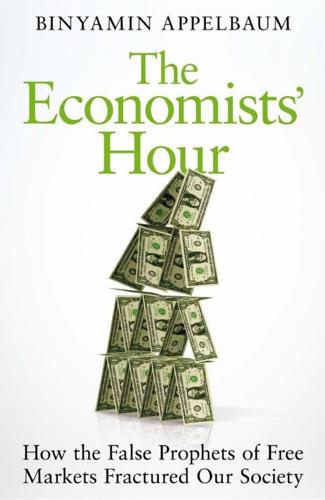
The Economists' Hour: How the False Prophets of Free Markets Fractured Our Society
by
Binyamin Appelbaum
Published 4 Sep 2019
Once she said it, it seemed so obvious and sensible,” said Fed governor Laurence H. Meyer.109 Greenspan did not concede but, recognizing the argument could not be won, he proposed the Fed should cut inflation to 2 percent, then decide what came next.110 Bad luck played an underappreciated role in the failures of Keynesianism in the 1970s. The Vietnam War, a pair of oil shocks, and a slump in productivity growth all contributed to the unraveling of confidence in “activist economics.” Conversely, in the 1990s, the winds seemed permanently at the back of trust-the-market economics. The “peace dividend” from the end of the Cold War made it easier to reduce federal spending; globalization weighed on wages and prices; new technologies drove a surge in productivity and prosperity.
…
Leonid Brezhnev, the leader of the Soviet Union, hailed “the possibility of a profound crisis of the capitalist system.”38 The rest of the world was less enthused. “A Declaration of War in Trade Policy” read the banner headline in one of Germany’s leading newspapers, Süddeutsche Zeitung.39 Oil-producing states, which had long insisted on payment in dollars, threatened to raise prices, the initial step toward the first “oil shock” two years later. Japanese prime minister Eisaku Satō, already rocked by Nixon’s decision to go to China, got a call from Secretary of State William P. Rogers just ten minutes before Nixon spoke. “Not again!” Satō said.40 Over the next few years, exchange rates jitterbugged and nations wasted vast amounts of money trying to make those rates stop moving.
…
“For the U.S. to tell the foreign exchange markets what the rate of the dollar, the yen, the mark, or any currency should be strikes me as the height of arrogance,” Sprinkel said.81 America’s faith in markets was a mixed blessing for many foreign nations, too. The rise of the dollar caused a third oil shock for the rest of the world, which had to buy dollars to buy oil. Pierre Mauroy, the French prime minister, complained bitterly that the United States was taking advantage of its “exorbitant privilege” as the issuer of the nearest thing to an international currency, reviving a phrase coined by one of his predecessors in the 1960s — though that dubious privilege was now being conferred by the market rather than the Bretton Woods system.82 Foreign companies that had borrowed in dollars also were punished.

Free to Choose: A Personal Statement
by
Milton Friedman
and
Rose D. Friedman
Published 2 Jan 1980
It did not produce any longer-lasting effect on the rate of inflation from that higher price level. In the five years after the 1973 oil shock, inflation in both Germany and Japan declined, in Germany from about 7 percent a year to less than 5 percent; in Japan from over 30 percent to less than 5 percent. In the United States inflation peaked a year after the oil shock at about 12 percent, declined to 5 percent in 1976, and then rose to over 13 percent in 1979. Can these very different experiences be explained by an oil shock that was common to all countries? Germany and Japan are 100 percent dependent on imported oil, yet they have done better at cutting inflation than the United States, which is only 50 percent dependent, or than the United Kingdom, which has become a major producer of oil.
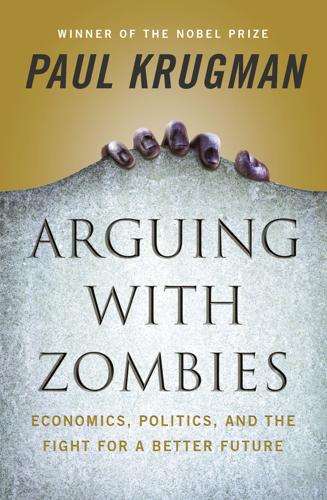
Arguing With Zombies: Economics, Politics, and the Fight for a Better Future
by
Paul Krugman
Published 28 Jan 2020
Rising welfare rolls may have been a big political problem, but a runaway welfare state more broadly just wasn’t an issue—hey, these days right-wingers complaining about a nation of takers tend to use the low-dependency seventies as a baseline. What we did have was a wage-price spiral: workers demanding large wage increases (those were the days when workers actually could make demands) because they expected lots of inflation, firms raising prices because of rising costs, all exacerbated by big oil shocks. It was mainly a case of self-fulfilling expectations, and the problem was to break the cycle. So why did we need a terrible recession? Not to pay for our past sins, but simply as a way to cool the action. Someone—I’m pretty sure it was Martin Baily—described the inflation problem as being like what happens when everyone at a football game stands up to see the action better, and the result is that everyone is uncomfortable but nobody actually gets a better view.
…
What do we see in the figure? First, the 1947–1973 numbers show what real, broad-based prosperity looks like. Over that period incomes of all groups rose at roughly the same rapid clip, more than 2.5 percent annually. Between 1973 and 1979, as the economy was battered by slow productivity growth and oil shocks, income growth became both much slower and more uneven. Finally, a new pattern emerged after 1979: generally slower income growth, but in particular a strong tilt in the growth pattern, with incomes rising much faster at the top end of the distribution than in the middle, and actually declining at the bottom.
…
L., 147 mercantilism, 250 Merkel, Angela, 98 microeconomics, 407, 408 middle class: cutting benefits for, 30, 196, 309 and financial managers, 92–94 and income distribution, 266, 273 and income mobility, 277, 278 raising taxes on, 199 Mildenberger, Matto, 305, 306 Minskyism, 409 Mississippi, income inequality in, 291–92 Mnuchin, Steven, 322 moderation, instability of, 407–10 financial instability, 409–10 intellectual instability, 407–8 political instability, 408–9 Modern Monetary Theory (MMT), 125, 152, 154, 203 monetarism, 133, 409 monetary economics, 176 monetary policy, 128–29, 140, 143, 144, 153 money: conventional (currency), 412–14 cryptocurrency, 411–14 dollar cash holdings, 413 dollar notes, 413–14 fiat currencies, 414 speculative, 413 as store of value, 112 “Money and Morals” (Krugman), 260, 285–87 money managers, 92–94 money supply, central banks’ control of, 110, 112, 124, 133 “Monopolistic Competition and Optimum Product Diversity” (Dixit and Stiglitz), 396–98 monopoly power, 228, 236 monopsony power, 316–17 Moore, John, 147 Moore, Michael, 44, 45 Moore, Roy, 309 Moretti, Enrico, The New Geography of Jobs, 292 mortgage rates, 87 mortgages, subprime, 90–91, 136 “Most Important Thing, The” (Krugman), 327–28 motives, talk about, 8 Moulton, Seth, 76 movement conservatism, 297–98, 302–4, 307 definition of, 302 keeping zombie ideas alive via, 8 and Republican Party, 297, 299–301, 302, 368 and Tea Party, 303 white resentment as basis of, 343 “Movement Conservativism” (Krugman), 297–98 Moynihan, Daniel Patrick, 5 Mueller, Robert, 307 Mueller investigation, 360 Mulford, David, 405 Mulligan, Casey, 144 Mulvaney, Mick, 207, 225 Murdoch, Rupert, 297, 375 Murphy, Kevin, 279 Murray, Charles, Coming Apart: The State of White America, 1960–2010, 285–86 Mussolini, Benito, 346 “Myths of Austerity” (Krugman), 158, 160–62, 165 NAFTA, 372 NAIRU (non-accelerating-inflation rate of unemployment), 114 NASA, 163 National Association of Realtors, 84 National Climate Assessment, 332, 336 National Commission on Fiscal Responsibility and Reform, 198–200 nationalism, 343 National Older Women’s League, 198 National Review, The, 301 national security: and elections, 306 and tariffs, 251, 253, 255 NATO, 244 neoclassical economics, 132, 133, 139–40, 147 neoliberal ideology, 315 Netherlands, economy of, 184 New Deal, 107, 293, 308 New Geography of Jobs, The (Moretti), 292 New Hampshire, economic freedom in, 317, 317 New Jersey, health care in, 76, 78 New Keynesian views, 129, 139–40, 143, 145, 147 New York: health care in, 74, 318 infant mortality in, 317, 317 Medicaid expanded in, 318 New York Times, The, 348, 349 Nicaragua, and Iran-Contra, 300 Nimbyism, 291 Nixon administration, and media, 300 Nordhaus, William, 396 Norman, Victor, 398 “normative” economics, 1 Northam, Ralph, 308, 309 North Carolina: health care in, 77 Republican Party in, 359 Norway, economy of, 323 Obama, Barack: conservatives vs., 150, 208, 302, 320, 362 on health care, 53–55, 66, 339, 361 and international trade, 252 and taxes, 216, 219, 229 Obama administration: on debt and unemployment, 208 “hijacked” commission of, 198–200 and revenue growth, 225 stimulus plan of, 104, 107–8, 113–14, 115–17, 118–20, 131, 193, 206, 362 Obamacare, see Affordable Care Act O’Brien, Michael, 126 Ocasio-Cortez, Alexandria (AOC), 234, 236, 237, 320–21 Occupy Wall Street, 285 O’Connor, Reed, 367, 369 oil shocks, 126 Oklahoma, tax cuts in, 293 Okun’s Law, 113 oligarchy, 283, 349, 350 Olson, Mancur, The Logic of Collective Action, 354–55 Operation Coffee Cup (1961), 322 optimum currency areas, 177 Palin, Sarah, 54 Panama Papers, 349 Pangloss, Doctor (fict.), 135, 140 “paperclip maximizers,” 357 “Paranoid Style in American Politics, The” (Hofstadter), 346 parasites, 354–57 Paulson, Henry, 91 PBS Newshour, 169–71 Pelosi, Nancy: achievements of, 361–63 and Affordable Care Act, 35–36, 55, 361, 367 and financial reform, 362 as House Speaker, 76, 344, 362, 363 on “monstrous endgame,” 367, 369 on Social Security, 15, 35, 306, 361 and stimulus plan, 362 and trade agreement, 372 on the wall as “manhood thing,” 370 Pence, Mike, 73 pensions: defined benefit, 14 defined contribution, 14–15 401(k)-type plans, 31–32 private, decline of, 31–32 Perlstein, Rick, 302, 354, 355 Perot, H.
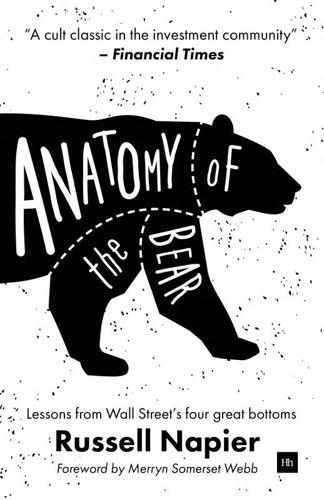
Anatomy of the Bear: Lessons From Wall Street's Four Great Bottoms
by
Russell Napier
Published 18 Jan 2016
There was some evidence the medicine was working and annual inflation was back below 3% by the middle of 1972. In 1973, Nixon dismantled price controls and inflation was quickening, and the equity market declining, when along came the “oil shock” as the Organisation of Petroleum Exporting Countries (OPEC) more than tripled the price of oil - from $3.12 a barrel in October 1973 to $11.63 in December. Annual inflation, running at 2.9% in August 1972, surged to 12.5% by December 1974. There were actually two oil shocks in the 1970s. The first began in October 1973, when Arab members of the OPEC announced they would no longer ship oil to countries supporting Israel in its war with Egypt.
…
The first began in October 1973, when Arab members of the OPEC announced they would no longer ship oil to countries supporting Israel in its war with Egypt. The oil price had tripled by Christmas 1973. The second oil crisis was caused by a decline in oil exports from Iran following the revolution of January 1979. By year-end, the oil price had risen 150%. Within 12 months of both oil shocks, G7 GDP contracted. From December 2002 to June 2005, the oil price has risen 160%. This would have been bad enough for investors, but the huge surprise was that the sharp recession, from November 1973 to March 1975, failed to bring inflation under control. In April 1973, the term “stagflation”, a combination of low growth and inflation, made its first appearance in the pages of the Wall Street Journal.

Poverty for Profit
by
Anne Kim
As a share of GDP, however, federal spending was less dramatic, swelling from 17.3 percent to 1960 to 21.6 percent in 1981. 40. Steven Rathgeb Smith and Michael Lipsky, Nonprofits for Hire: The Welfare State in the Age of Contracting (Cambridge, MA: Harvard University Press, 1993), 54. 41. B. Alex Beasley, “The Oil Shocks of the 1970s,” Yale University, 2023, https://energyhistory.yale.edu/the-oil-shocks-of-the-1970s/. Members of the oil-producing cartel OPEC cut production to protest U.S. policies in the Middle East, including America’s support of Israel during the Yom Kippur War. 42. Daniel L. Thornton, “The U.S. Deficit/Debt Problem: A Longer Run Perspective,” Federal Reserve Bank of St.
…
Between 1960 and 1981, when Reagan took office, federal spending ballooned from $92.2 billion to $678.2 billion (in nominal dollars), largely due to the expansion of Social Security and Medicare but also because of massive increases in social services spending that accompanied the War on Poverty.39 From 1965 to 1970 alone, federal spending on social services nearly tripled, from $812 million to $2.2 billion, according to Steven Rathgeb Smith and Michael Lipsky.40 (These sums seem trivial today but were shockingly large at the time.) In contrast to the post-war boom that fueled the optimism of the Great Society, the U.S. economy of the 1970s was faltering, further shaking public faith in the nation’s strength. The oil shock of 1973–74 triggered a global energy crisis as well as domestic “stagflation”—stagnant growth coupled with high inflation.41 The federal budget began running larger and larger deficits during the 1970s, breaking a historic cycle of wartime deficits and peacetime surpluses.42 It was also clear by then that the War on Poverty was falling short; from 1969 to 1970, the number of Americans in poverty grew by 1.2 million.
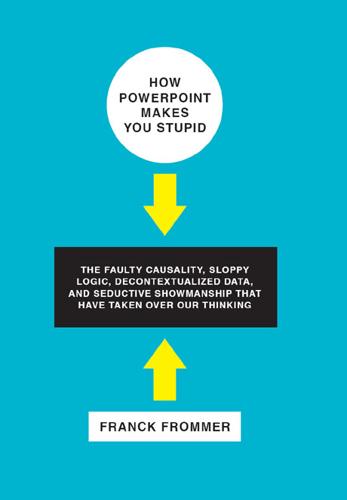
How PowerPoint Makes You Stupid
by
Franck Frommer
Published 6 Oct 2010
It is a regular and permanent occupation intended to spread their good methods, their perceptive analyses, their organizational methods, their strategic recommendations—in short, models of thinking concocted in managerial agencies primarily based in the United States. This democratization and proliferation of new models of thinking surfaced in the early 1980s after various economic disturbances, particularly the two oil shocks. Companies at the time were forced to substantially change their organizational and operational methods. They had to resolve to take the medication prescribed by the only “therapists” able to treat them—consultants, strategic advisers serving many companies in public relations and information systems.1 Thanks to the thousands of person-days sold to client companies and the millions of slides repeating essentially the same models and the same arguments, these experts in recommendations have been able to link rationality, authority, and entertainment, if not to help their clients, at least to enrich their employers.
…
His three most famous books, which he published himself for reasons of graphic precision, are The Visual Display of Quantitative Information (1983), Envisioning Information (1990), and Visual Explanation (1997), all published by Graphics Press, Cheshire, CT. 20. Tufte comments ironically on the barrels, gas pumps, and derricks widely used as illustrative devices in American magazines during the oil shocks of 1973 and 1979. 21. The literature in England and America on this subject has been plentiful in the last twenty years. See in particular three papers by Vivien Beattie and Michael J. Jones: “A Six-Country Comparison of the Use of Graphs in Annual Reports,” International Journal of Accounting 36, no. 2 (2001): 195–222; “A Comparative Study of the Use of Financial Graphs in the Corporate Annual Reports of Major U.S. and U.K.
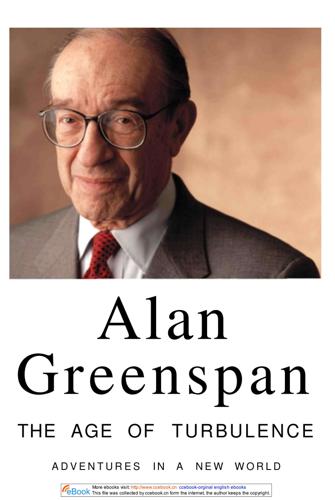
The Age of Turbulence: Adventures in a New World (Hardback) - Common
by
Alan Greenspan
Published 14 Jun 2007
It's typical that in times of great national urgency, every congressman feels he has to put out a bill; presidents feel the pressure to act too. Under those conditions you can get shortsighted, ineffective, often counterproductive policies, like the gasoline rationing that President Nixon imposed during the first OPEC oil shock in 1973. (That policy caused gas lines in some parts of the country that fall.) But with fourteen years under my belt as Fed chairman, I'd seen the economy pull through a lot of crises—including the largest one-day crash in the history of the stock market, which happened five weeks after I took the job.
…
As we talked through the possibilities, President Ford worried that America would find itself trapped in a vicious circle of falling demand, layoffs, and gloom. Since none of the forecasting models could deal with the circumstances we were facing, we were flying blind. All we could tell him was that this might be an inventory-based recession, aggravated by the oil shock and inflation—maybe a Category 2 or 3. Or it might be a Category 5. The president had to make a choice. With the discomfort index nearing 20 percent, there was tremendous political pressure from Congress to slash taxes or massively pump up government spending. That was the way to deal with a Category 5.
…
Coming off a decade of civil rights and anti-Vietnam War marches, anyone who could have foreseen 9 percent unemployment would have expected massive demonstrations and barricades in the streets, not just in the United States but also in Europe and Japan, where the economic problems were equally severe. Yet that didn't happen. Perhaps the world was simply exhausted by the oil shock and the decade that had led up to it. But the era of protest was over. America was going through this period with what seemed like a new sense of cohesion. President Ford held off the pressure, and his economic program eventually made it into law (Congress did raise the tax rebate by almost 50 percent, to about $125 per average household).
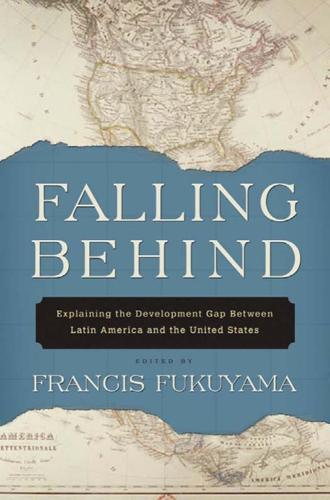
Falling Behind: Explaining the Development Gap Between Latin America and the United States
by
Francis Fukuyama
Published 1 Jan 2006
The gap widened again in the last three decades of the twentieth century with the spread of authoritarian regimes throughout the region. In addition, many of the large countries in Latin America catastrophically failed to adjust to the rapidly changing external environment, resulting from the two oil shocks of the 1970s. Burgeoning fiscal deficits, attempts to monetize deficits through growth in money supplies, hyperinflation, and overvalued exchange rates in Mexico, Brazil, Argentina, Peru, and other countries set the stage for the debt crisis of the 1980s and the subsequent drop in real growth rates throughout Latin America.
…
Indeed, Alice Amsden has pointed out that, by the 1970s, South Korea’s average rate of tariff protection was comparable to that of Argentina.7 Across-theboard openness to market forces and minimal state intervention were thus not the sine qua non of economic growth in either region. Economic performance began diverging dramatically between East Asia and Latin America primarily after the oil shocks of the 1970s; the difference in long-term performance (and thus the reason for Latin America’s failure to close the gap with the United States) was largely Conclusion 273 the result of Latin America’s failure to adjust to the changed conditions of the external environment. As current account deficits began piling up in all non–oil producing countries, many of those in East Asia tightened their belts, cut government spending, and kept fiscal deficits under control.
…
Latin America, as Dani Rodrik has pointed out, grew impressively under the sway of heterodox protectionist policies in the benign environment of the 1950s and 1960s, and its performance has been uneven during the era of liberal reform from the late 1980s onward.8 The real problems emerged as a result of the region’s failure to adjust to the oil shocks and to the sharply less benign international environment that emerged during the 1970s, something the East Asian fast developers managed much more successfully. This suggests a second critical factor that explains the development gap: institutions. 274 Conclusion Institutions Many of the authors in this volume, including Robinson, Roett and González, Przeworski and Curvale, and Fukuyama, identified weak or defective institutions as one of the most significant sources of the development gap.
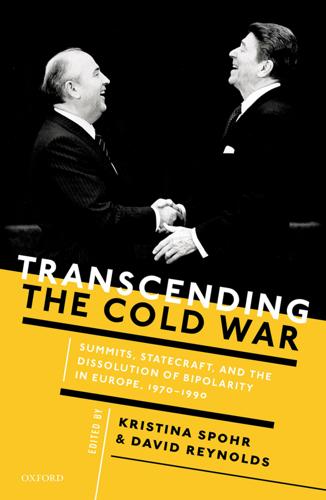
Transcending the Cold War: Summits, Statecraft, and the Dissolution of Bipolarity in Europe, 1970–1990
by
Kristina Spohr
and
David Reynolds
Published 24 Aug 2016
A second agreement on strategic arms limitation (the SALT II treaty) was delayed until 1979 and it failed to grapple with the issue of nuclear weapons stationed in Europe. All this generated uncertainty in Western Europe about the viability of détente at a time when the developed world was also wracked by the oil shock, economic recession, and rampant inflation. The summitry of 1978–9 (chapter 5) tried to address these problems, with the consolidation of the Group of 7 (G7) as an instrument of international economic governance and the Guadeloupe summit of January 1979—an attempt to re-establish the credibility of NATO’s defence posture.
…
More significant at Helsinki were the talks that Ford held with his British, French, and West German counterparts. Meeting at the British ambassador’s residence, the West’s leading statesmen reflected on the Final Act, which they judged a success. But then they debated their common predicament of ‘economic and social disorder and rising unemployment’ following the 1973–4 oil shocks.84 The ‘self-evident inability’ of governments ‘to do anything in the face of this crisis’, warned French president Valéry Giscard d’Estaing, was ‘a serious weakness for the West’, upon which the USSR would ‘play’. West German Chancellor Helmut Schmidt circulated a ‘private memorandum’ arguing for concerted international action to address ‘economic problems’ that were, he asserted, ‘a greater threat to the West than the Soviet Union’.85 Schmidt urged Ford: ‘Your strong leadership is needed’.
…
In the second half of the 1970s it was driven by the Western Europeans in reaction to the friction and drift at the superpower level. This aroused a profound sense of insecurity, especially in the minds of Valéry Giscard d’Estaing and Helmut Schmidt, the leaders of France and the Federal Republic, who directed the Western response. Part of their concern was economic—Western Europe was far more vulnerable to the oil shock than energy-rich America and also more seriously ravaged by stagflation—but they also feared that the lack of a new financial order to replace Bretton Woods would be exploited politically by Moscow. Acting on their shared concerns, Giscard and Schmidt convened the Rambouillet economic summit in November 1975, precursor of the annual meetings of key Western leaders that became known as the G7.

Blindside: How to Anticipate Forcing Events and Wild Cards in Global Politics
by
Francis Fukuyama
Published 27 Aug 2007
The fact that ten of the top fourteen oil-exporting countries are politically unstable, that the United States may be facing a long period of increased hurricane activity in the Gulf of Mexico, and that, following the Abqaiq attack, al-Qaeda promised that “we shall not cease our attacks until our territories are liberated,” implies that it is only a matter of time before the United States finds itself in the midst of a severe oil shock.3 Here is an eminently predictable catastrophe if ever there was one. The Energy Weapon Is Back Transportation underlies the modern U.S. economy. With 97 percent of U.S. transportation energy based on petroleum, oil is the lifeblood of America’s economy. Without oil, goods and raw materials cannot reach their destinations, service providers cannot arrive at their clients, and children cannot go to school.
…
An aggressive, inventive energy policy can gradually diminish the role of oil in world politics and reduce predictable friction between consumers and producers and among consumers themselves. Such a vision is both practical and economical—far cheaper than maintaining the current energy system. The only question is whether our leaders will lead or will instead be dragged to act by the most painful oil shock in American history. 2990-7 ch08 barrett 7/23/07 12:12 PM Page 82 8 Emerging Infectious Diseases: Are We Prepared? Scott Barrett N ews that a person has become infected with HIV is a personal tragedy but of no consequence to the world at large. News of the first person to be infected with HIV—now that, had it been revealed years ago at the start of the pandemic, would have been of monumental importance.
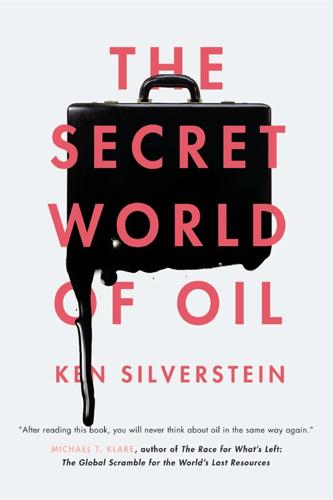
The Secret World of Oil
by
Ken Silverstein
Published 30 Apr 2014
he asked. ‘Two British police who arrested me when we were fighting for our independence. And you know what? I don’t bear a grudge. I’ll do business with the British as long as you give me the right price. So don’t give me your political propaganda, just give me a good contract.” After the first OPEC oil shock, in 1973, Calil became seriously involved in the petroleum business, first trading oil and then obtaining concessions and reselling them. Within five years, oil had become the largest sector of his business. Calil’s influence and wealth soared after the Nigerian general Ibrahim Babangida assumed power in a 1985 coup.
…
I took a fifty-minute train ride from Geneva to the town of Montreux, at the foot of the Alps, to meet with a retired commodities broker who got his start in the 1980s trading cement, rice, and spices before moving on to buying and selling oil and refined products. We had lunch across the street from the train station at the Grand Hotel. Since the oil shocks of the 1970s, the prevailing analysis has tended to describe oil prices in strict supply-and-demand terms, often placed in a geopolitical context. If it wasn’t conflict in the Middle East that was jacking up prices, it was devious oil cartels tinkering with the spigot, Hugo Chávez nationalizing refineries, rebels in the Niger Delta blowing up pipelines, or demand from the emerging middle class in India and China.
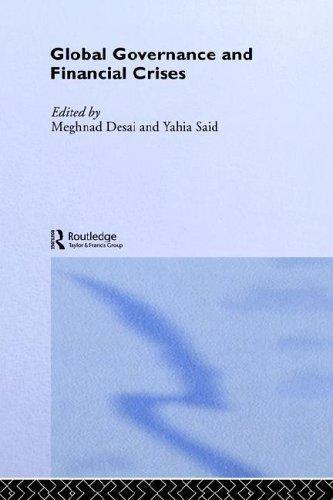
Global Governance and Financial Crises
by
Meghnad Desai
and
Yahia Said
Published 12 Nov 2003
It opposed developed and developing countries on the link between reserve creation and aid to development. Meanwhile market events had overpowered the ambition of reestablishing a rule-based system. As early as February 1973, the par-value exchange rate system had burst out and generalized floating had spread in a vacuum of consistent responses to mounting inflationary pressures. Finally, the first oil shock of October 1973 triggered much larger capital flows than experienced beforehand with the recycling by Euro-banks of the surpluses of oil producing countries. Faced with such adverse phenomena, the C20 changed course. Giving up its grand design, it focused on the task of arming the Fund with a legal framework to operate in an environment quite at odds with the Bretton Woods era.
…
This view expected capital markets to take care of themselves and to drive exchange rates to their equilibrium values reflecting the conditions prevailing in domestic economies. However, the interplay between foreign borrowing and exchange rates dynamics was the locus of new problems which arose in the wake of the second oil shock. International capital markets fed the world with a fast-increasing amount of reserves, but they proved unable to regulate the distribution of borrowed reserves among countries. Sovereign indebtedness was not properly assessed, entailing abrupt disruptions between excessive tolerance to borrowing and acute credit crunches.
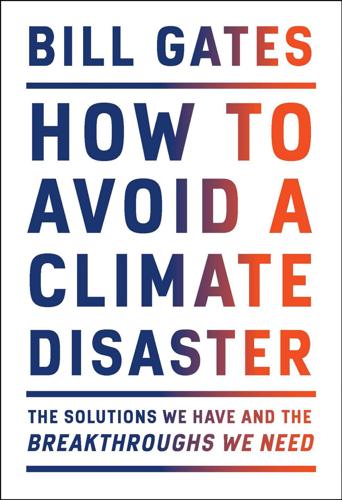
How to Avoid a Climate Disaster: The Solutions We Have and the Breakthroughs We Need
by
Bill Gates
Published 16 Feb 2021
In 1910, only 12 percent of Americans had electric power in their homes. By 1950, more than 90 percent did, thanks to efforts like federal funding for dams, the creation of federal agencies to regulate energy, and a massive government project to bring electricity to rural areas. Energy security. In response to the oil shocks of the 1970s, the United States set out to increase domestic production from various energy sources. The federal government began its first major research and development projects in 1974. The next year saw major legislation related to energy conservation, including fuel efficiency standards for cars.
…
China, which accounts for a large and growing share of the world’s wind-generated power, has said it will soon stop subsidizing onshore wind projects because the electricity they produce will be just as cheap as the power from conventional sources. To understand how we got to this point, look at Denmark. Amid the oil shocks of the 1970s, the Danish government enacted a number of policies with an eye toward promoting wind energy and importing less oil. Among other things, the government put a lot of money into renewable-energy R&D. They weren’t the only ones who did this (around this time, the United States started working on utility-scale wind turbines in Ohio), but the Danes did something unusual.
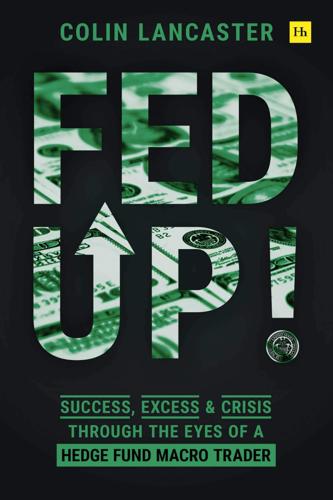
Fed Up!: Success, Excess and Crisis Through the Eyes of a Hedge Fund Macro Trader
by
Colin Lancaster
Published 3 May 2021
“I’ll start with Paul Volcker, who died yesterday and who is the first one I can remember from my childhood. He was chairman of the Fed under Jimmy Carter and Ronald Reagan from ‘79 to ‘87, back when you could work for both a Democratic and Republican boss. It was a messy time. America was dealing with oil shocks, the fallout from the Vietnam War, the end of the Bretton Woods system, and then massive tax cuts. Inflation spiked when Nixon decided to leave Bretton Woods, the gold standard. The US dollar’s status as the reserve currency of the world was in serious doubt. Investors were convinced that inflation would never come down and were dumping Treasuries at any price.
…
Liquidity is gone. You do your damnedest to fucking just stay alive, maintain fewer positions, figure out where the pain is. Trade small so you can widen stops. Don’t get cute. Don’t try to be a hero. It’s insane how events such as this seem to get multiplied. It’s not just one. It’s global pandemic and oil shock, both unexpected. Today, this combination is exposing our economy’s Achilles’ heel: too much fucking debt. That’s our soft underbelly, our weakest link. We’ve been running this scam for fifty fucking years. We built a world based on a debt bubble of epic proportions. It has tried to pop lots of times, but every time, we just shuffle the deck.
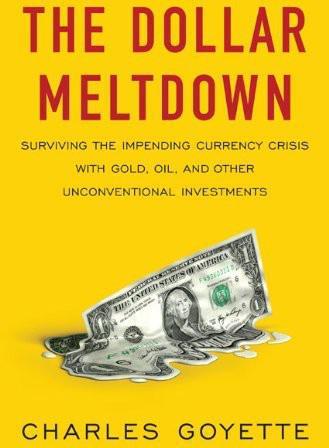
The Dollar Meltdown: Surviving the Coming Currency Crisis With Gold, Oil, and Other Unconventional Investments
by
Charles Goyette
Published 29 Oct 2009
Unemployment hit 9 percent, while the official inflation rate climbed to 12.2 percent in 1974 and 13.3 percent in 1979. It was a period of confused monetary policy. Businesses encountered Nixon’s disastrous wage and price controls, which fixed the prices at which they could sell, while they also had to contend with huge increases in borrowing costs. And then came the oil shocks. OPEC warned repeatedly that a change in the value of the dollar would result in higher nominal oil prices, so when Nixon suspended dollar convertibility to gold in 1971, oil prices were bound to climb. They quadrupled from $3 per barrel in 1972 to $12 in 1974. They spiked again beginning in the late 1970s until they hit $35 in 1981.
…
Even with gas lower than it had been since 2004, the sting of $4.00 gasoline is not likely to be forgotten by drivers for some time. The destruction of demand caused by high prices can persist even after prices have fallen back. As American consumers began moving massively to smaller cars after the oil shocks of the 1970s, average fuel consumption declined and continued to do so for years even after the price of gasoline had retreated sharply. By the end of 2008, in response to the recent price shocks, plants making SUVs were closing left and right. On December 23, General Motors closed an Ohio plant that had turned out 3.7 million large SUVs.
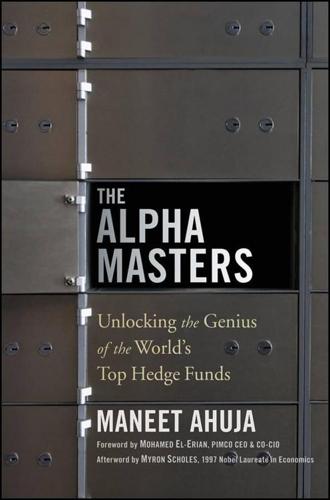
The Alpha Masters: Unlocking the Genius of the World's Top Hedge Funds
by
Maneet Ahuja
,
Myron Scholes
and
Mohamed El-Erian
Published 29 May 2012
I was happy sleeping on a cot in a studio apartment. All I cared about was having the freedom to do what I wanted to do.” As luck would have it, Dalio’s return to Harvard coincided with a huge surge of inflation. The breakdown of the monetary system in 1971 had caused a surge that pushed commodity prices higher and created the first oil shock in 1973. To combat inflation, the Federal Reserve tightened monetary policy, which brought on what until then was the worst bear market since the Great Depression. All of a sudden, there was a rush into previously unfashionable commodities futures trading, and brokerage houses clamored to build new trading departments.
…
Somewhat contradictory to its placid work environment, however, the Bridgewater team is awfully focused on crisis. Dalio creates universal investment and management principles by learning from history. He analyzes how different countries, cultures, and people around the world react to different incidents like debt or oil shocks, for example, and figures out the variables that affected the different outcomes. Stripping away all the variables let Bridgewater arrive at universal laws for doing business. “If you’re limiting yourself to what you experienced, you are going to be in trouble. . . . I studied the Great Depression.
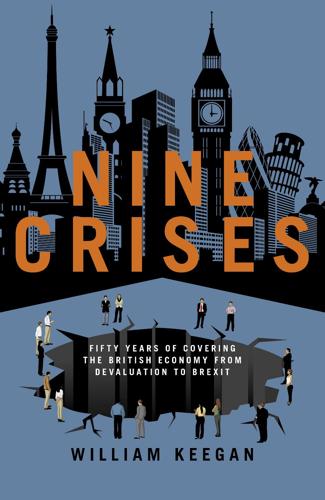
Nine Crises: Fifty Years of Covering the British Economy From Devaluation to Brexit
by
William Keegan
Published 24 Jan 2019
The unfortunate fact of the matter was that this doubling in the price of oil was obviously going to drive a coach and horses through the government’s economic strategy, even before the next batch of price increases. This exercise in procrastination did the government no good. It might have been wise to get their excuses in early about the way the oil shock was going to damage their economic strategy, but they chose not to own up immediately to the full impact. There can be something funny about even the most authoritative of newspapers – a curious lack of confidence and a temptation to believe that the truth lies elsewhere. When the FT’s editor, Fredy Fisher, noticed the difference between his own correspondent’s version and that of the others, he summoned Adrian and told him to print an apology the following day.
…
Dell added: ‘Barbara Castle’s legislation might well have proved equally unworkable.’ I wonder. Indeed, the background to the onset of the three-day week and the fall of the Heath government can be pinned down to three factors: first, the succession of events that led to the collapse of what was known as the Selsdon Man approach; secondly, the way in which the oil crisis – or ‘oil shock’, as the Japanese christened it – compounded the government’s economic problems; and thirdly (in my opinion), a missed opportunity during crucial talks at a meeting of ministers, employers and unions under the auspices of the National Economic Development Council on 9 January 1974. Selsdon Man was the phrase with which Harold Wilson had derided the policies that lay behind the Conservative manifesto in the 1970 general election – supposedly hammered out at a weekend meeting at the Selsdon Park Hotel, Croydon, Surrey.
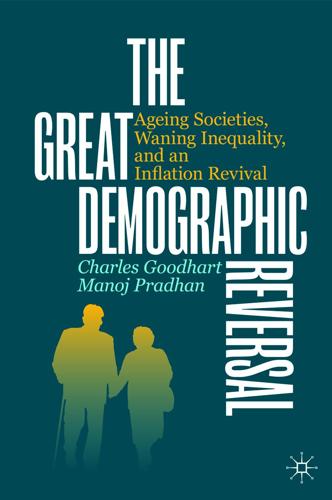
The Great Demographic Reversal: Ageing Societies, Waning Inequality, and an Inflation Revival
by
Charles Goodhart
and
Manoj Pradhan
Published 8 Aug 2020
Given significantly cheaper capital goods, the cost of accumulating a given stock of capital uses up a smaller amount of the economy’s stock of savings. To some extent, this can counter the savings deficit created by ageing demographics and somewhat temper the rise in both the interest rate and wages. Historical experience after the oil shock provides evidence of such substitution. Manufacturing in many economies that faced favourable/unfavourable shocks to the price of an input of production underwent a change in the capital/labour ratio in a significant way. Data from 1972–88 from manufacturing plants in the USA (Davis et al. 1996) show that the 1970s oil price shock led to the demise of energy-intensive manufacturing.
…
In order to identify the Phillips curve in such conditions of simultaneity, one would need to be able to assess and quantify occasions of supply shocks and/or monetary policy errors.5 That is not easy. What we do know, however, is that supply shocks were far more prevalent between 1970 and 1990, e.g. oil shocks in 1973/1974, 1979, 1986 and commodity price shocks and monetary policy errors more obvious, than in the subsequent years, especially during the Great Moderation, 1992–2005, when everything macroeconomic seemed to remain stable. Thus the fact that the slope of the calculated relationship between unemployment (or the output gap) and wage (price) inflation appeared to become more horizontal in these later decades may be just an artefact of better monetary policies and fewer supply shocks, rather than representing any change to the underlying structural relationship.
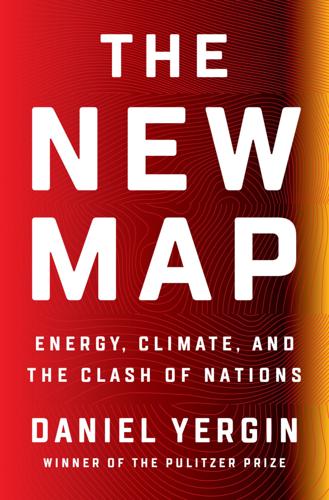
The New Map: Energy, Climate, and the Clash of Nations
by
Daniel Yergin
Published 14 Sep 2020
The Test of Prudence 25. Belt and Road Building MAPS OF THE MIDDLE EAST 26. Lines in the Sand 27. Iran’s Revolution 28. Wars in the Gulf 29. A Regional Cold War 30. The Struggle for Iraq 31. The Arc of Confrontation 32. The Rise of the “Eastern Med” 33. “The Answer” 34. Oil Shock 35. Run for the Future 36. The Plague ROADMAP 37. The Electric Charge 38. Enter the Robot 39. Hailing the Future 40. Auto-Tech CLIMATE MAP 41. Energy Transition 42. Green Deals 43. The Renewable Landscape 44. Breakthrough Technologies 45. What Does “Energy Transition” Mean in the Developing World?
…
There were still an estimated fifteen to twenty thousand ISIS fighters, plus another ten thousand held in makeshift prisons, plus the affiliates and followers around the world. Yet in one significant way ISIS’s impact had faded much earlier. In 2014, its lightning advance across Iraq had induced panic in the oil market and caused it to spike. But, the impact on oil prices had hardly lasted. Chapter 34 OIL SHOCK For three years, 2011 through 2013, the oil price had been surprisingly stable—a little over $100 a barrel. Though that was almost five times higher than it had been a decade earlier, the world had become accustomed to this new price. It was called the “new normal,” and on this basis countries could make their budgets and companies would finance their projects.
…
“In Audio Recording, ISIS Leader Abu Bakr Al-Baghdadi Says Operations Underway, Urges ‘Caliphate Soldiers’ to Free Captives,” MEMRI, September 16, 2019. 17. Department of Defense Briefing on Baghdadi raid, October 30, 2019, www.defense.gov/Newsroom/Transcripts/Transcript/Article/2004092/department-of-defense-press-briefing-by-assistant-to-the-secretary-of-defense-f/. Chapter 34: Oil Shock 1. Neil Hume and Anjli Raval, “Iraq Violence Lights Fuse to Oil Price Spike,” Financial Times, June 20, 2014. 2. Ali Al-Naimi, Out of the Desert: My Journey from Nomadic Bedouin to the Heart of Global Oil (New York: Portfolio/Penguin, 2016), pp. 286–88; Robert McNally, Crude Volatility: The History and the Future of Boom-Bust Oil Prices (New York: Columbia University Press, 2017), pp. 212–16; Raf Sanchez, “Barack Obama: Iran Could Be a ‘Successful Power,” Telegraph, December 29, 2014. 3.

Food and Fuel: Solutions for the Future
by
Andrew Heintzman
,
Evan Solomon
and
Eric Schlosser
Published 2 Feb 2009
Ordinary people are able to implement efficiency long before big, slow, centralized plants can be built, let alone paid for. Since Western economies ceased to think that oil was infinite and reliably available, more efficient use has been the biggest “source” of new energy — not oil, gas, coal, or nuclear power. After the 1979 oil shock, efficient use of energy enabled Americans to cut oil consumption by 15 percent in six years while the economy grew 16 percent. There are many ways to measure progress in saving energy but even by the broadest and crudest measure — lower primary energy consumption per dollar of real GDP — progress has been dramatic.
…
For the two preceding decades energy demand had indeed been growing rapidly, fueled by low oil prices and the post-war economic expansion. For many of the megaproject proponents, the link between growth in energy use and growth in the GDP seemed not only strong historically but inflexible and essential. Of course new supply projects would be needed! Then in 1973 came the first oil shock. With little warning the Arab oil producers embargoed the United States for some months, and the Organization of Petroleum Exporting Countries (OPEC) declared they would no longer negotiate but would instead adopt a take-it-or-leave-it approach to oil pricing. By the end of 1974 the price of a barrel of oil was eight times higher than it had been five years earlier.1 The resulting impacts shocked the Western world, both economically and politically.

Street Smart: The Rise of Cities and the Fall of Cars
by
Samuel I. Schwartz
Published 17 Aug 2015
The gas crises were the only times I had seen traffic volumes go down significantly in my long career until 2005 or so. It wasn’t the cost of gas that was keeping drivers out of their cars; it was the difficulty of getting gas. We made this observation after the supply crisis was over, when even though prices surged, VMT started rising again. The purpose for reminding ourselves about the oil shocks and gas lines is not to make a purely economic argument. The price of filling a tank is, of course, higher today than it was before OPEC started flexing its muscles (and before China and India started putting millions of new cars on the road, thus increasing demand for a shrinking resource like petroleum).
…
In 1920, the height of the popularity of the Model T, gas cost 20 cents a gallon, which is equivalent to $3.87 in 2015. Gas prices go up, and they go down. More important than the inflation-corrected price per gallon is how drivers thought about the cost of a fill-up. And repairs. And insurance. And traffic jams. From the second oil shock on, their daily commute and weekly fill-up gave them more and more reasons to be annoyed about tradeoffs demanded by the six- or eight-cylinder money pits taking up space in their suburban garages. By 2004, economists were calculating that what they called the commuting effect (an increase of about twenty minutes in commuting time daily) was about as costly, in emotional terms, as breaking up with a boyfriend or girlfriend.

When the Money Runs Out: The End of Western Affluence
by
Stephen D. King
Published 17 Jun 2013
Even during the deepest recessions, however, there was always the hope of subsequent recovery. Long-term economic growth was supposedly God-given. Recessions were merely annoying interruptions, blamed variously on policy-making incompetence, excessive union power, short-sighted financial institutions, lazy managers and nasty oil shocks. Our modern era of economic stagnation is a fundamentally different proposition. Many of the factors that led to such scintillating rates of economic expansion in the Western world in earlier decades are no longer working their magic: the forces of globalization are in retreat, the boomers are ageing, women are thankfully better represented in the workforce,3 wages are being squeezed as competition from the emerging superpowers hots up and, as those superpowers demand a bigger share of the world's scarce resources, Westerners are forced to pay more for food and energy.
…
A home bias within the eurozone would remove, at a stroke, the benefits of the single market and likely condemn the southern nations to decades of grinding economic adjustment. That, surely, would be politically unsustainable. In time, and making up for lost ground, maybe money will be recycled into risky ventures in hitherto untapped parts of the world economy. Following the first oil shock in 1973, the money earned by Arab nations eventually found its way via the US banking system to Latin America. Yet Latin America was unable to deal with the scale of capital inflows. Poorly invested, they eventually paved the way to the Latin American debt crisis between 1982 and 1984. Hunting for yield is all very well but, without a proper understanding of the associated risk, unsustainable financial bubbles too often become an unfortunate way of life.
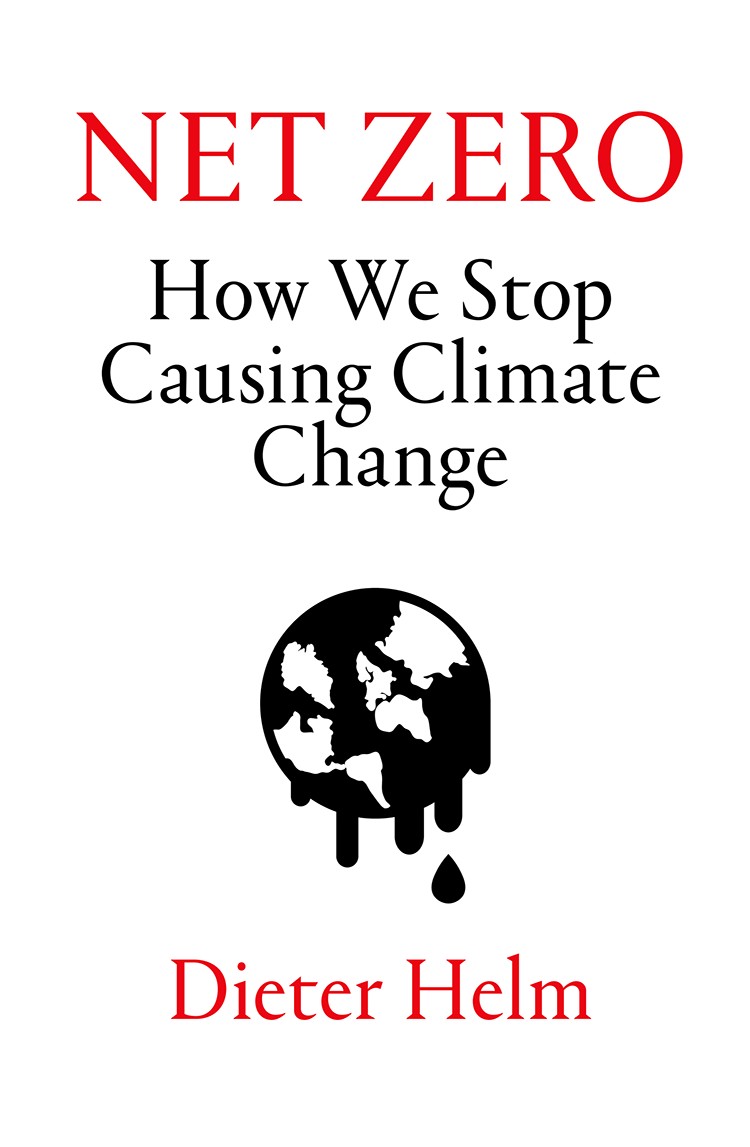
Net Zero: How We Stop Causing Climate Change
by
Dieter Helm
Published 2 Sep 2020
The sheer scale of Chinese economic growth is unprecedented: nothing on this scale – or that of the environmental shock it has created – has happened before over such a short period of time. Only the Covid-19 outbreak has been able to make a serious dent, causing the economy to contract after decades of growth. Think back to 1979. Most of the world’s attention was on the Iranian revolution and the oil shock it produced. Nobody gave much thought to the impoverished Chinese communist country oppressed since 1949 by Chairman Mao. The Great Leap Forward (1958–62) and the Cultural Revolution (1966–76) left around 70 million Chinese dead from famine and the intellectual class decimated. China was a poor country, insignificant except for its nuclear weapons and its challenge to Russia for communist leadership.
…
In a normal competitive market, the cheapest reserves would be produced first. In this market, the Saudis in particular choose not to do this to their full potential capacity. As the price is credibly kept well above $5 a barrel, other supplies come into the market which would not otherwise be produced. The North Sea oil and gas industry developed because of the oil shocks in the 1970s, with much higher costs than in the Middle East. So too did Alaska, the offshore Gulf of Mexico, and eventually even the tar sands of Alberta in Canada could turn a profit at the higher prices. These high-cost producers need the Saudis and others to manipulate the market to keep the price up.
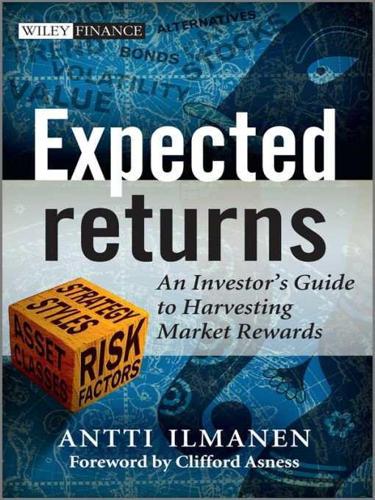
Expected Returns: An Investor's Guide to Harvesting Market Rewards
by
Antti Ilmanen
Published 4 Apr 2011
Inflation expectations were insufficiently adaptive: investors should have looked more at the most recent year’s inflation than the past decade’s inflation when setting expectations:• It seems harsh and hindsighted to call this irrational, given that the inflation process was changing dramatically. If we recognize that inflation expectations in the 1970s and 1980s evolved amidst almost unprecedented structural uncertainty (the end of Bretton Woods, oil shocks, and other wrenching changes), rational learning models may be relevant. In a regime shift context, people may have adjusted too slowly to the probability of being in a high-inflation or low-inflation regime. • A few decades earlier, price stability was the long-run norm (zero inflation expectations and little persistence in annual inflation rates); by the 1970s, the level of and uncertainty regarding inflation were rising and so was its persistence; the inflation rate (as opposed to the price level) became close to a random walk.
…
In the U.S., wars (Korea and Vietnam) again coincided with rising fiscal deficits and rising inflation; aggressive demand man-agement and insufficient understanding of expectations also contributed. After the Bretton Woods regime (a quasi gold standard) collapsed in 1971, the major economies were clearly in a fiat money regime and inflation expectations became further unanchored. The two 1970s’ oil shocks coincided with productivity decline, while the Fed’s overestimation of trend output and therefore slack in the economy resulted in overly loose monetary policy, contributing to the Great Inflation. Under Paul Volcker’s leadership, which began in 1979, the Fed finally ended and reversed the decades-long uptrend in inflation—at the cost of deep recessions in 1980–1982.
…
Capitalism, democracy, the rule of law, deregulation, and market-friendly economic policies gained ground across the globe over almost the entire period. No wonder market optimism was rife but, as we know, all did not end well. In contrast, the preceding period involved an increasing role for the state and doubts about capitalism, a shift to fiat currencies, two oil shocks, rising inflation and economic volatility, declining productivity, falling asset valuations, and relatively low realized asset returns. This period of mostly bad news did not last the full 20 years from 1968 to 1987, but essentially came to an end in the summer of 1982 when the massive 1980s’ bull market began.
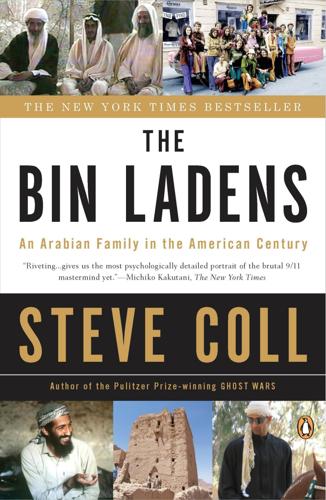
The Bin Ladens: An Arabian Family in the American Century
by
Steve Coll
Published 29 Mar 2009
Yet within two decades, by the time this generation of Bin Ladens became young adults, they found themselves bombarded by Western-influenced ideas about individual choice, by gleaming new shopping malls and international fashion brands, by Hollywood movies and alcohol and changing sexual mores—a dizzying world that was theirs for the taking, since they each received annual dividends that started in the hundreds of thousands of dollars. These Bin Ladens, like other privileged Saudis who came of age during the oil shock decade of the 1970s, became Arabian pioneers in the era of globalization. The Bin Ladens were the first private Saudis to own airplanes, and in business and family life alike, they devoured early on the technologies of global integration. It is hardly an accident that Osama’s first major tactical innovation as a terrorist involved his creative use of a satellite telephone.
…
Bakr spoke some French, but he conducted most of his business in English or in Arabic, and he kept private secretaries to assist him in each language; over the course of a typical day, he would slip frequently and easily between the two tongues. In this he resembled many younger, privileged Saudis who had adapted rapidly to global business idioms in the aftermath of the oil shock. In some respects, he was unprepared for the leadership role he now occupied. As an engineer and an operations man, as Salem’s loyal number two, he had learned to work hard and to concentrate on results, but he lacked a natural touch for the richly diverse human foibles and quandaries that his family members continually presented him.
…
First-and second-generation Lebanese and Armenian entrepreneurs maneuvered among them—builders, restaurateurs, retailers, developers, and hustlers sui generis. Some blocks on the west side of Los Angeles already resembled a stucco-and-Spanish-tile bazaar when the Saudis turned up in numbers, their pockets bulging after the second oil shock. Young merchant scions from Jeddah and Riyadh and Dhahran rolled through Beverly Hills in Porsches and Mercedes-Benzes, their sunglasses just a little too fashionable, their aftershave a little too pungent—as conspicuous a population of marks as ever swam in the seas of capitalism. Accountants looked at them and saw fees; lawyers saw billable hours; stockbrokers saw commissions; jewelers saw gold.

Roller-Coaster: Europe, 1950-2017
by
Ian Kershaw
Published 29 Aug 2018
A policy of stimulating growth through reductions in taxation had meanwhile been introduced. Although the rate of growth sharply (and temporarily) rose, the boom merely added fuel to the flames of inflation, which the government then vainly sought to control by imposing limits on wage rises. And all this was before the oil shock. The gathering crisis in industrial relations, as the economy reeled from the impact of soaring energy prices, came to a head in 1974 after the National Union of Mineworkers – the most powerful trade union in the country – had demanded a big pay rise, well in excess of the wage restriction recently introduced by the Conservative government.
…
The governments of Western Europe’s other two biggest industrial nations, West Germany and France, navigated the economic storm-waves with fewer traumas than did either Britain or Italy. They faced similar economic problems as energy prices soared. But they handled them better. They benefited from strong economies that could cushion the worst of the oil shock. Their governments were also under highly competent new management. Helmut Schmidt succeeded Willy Brandt as Chancellor of West Germany on 16 May 1974 following the revelation that one of Brandt’s closest aides, Günter Guillaume, had been spying for the East German intelligence services. Only three days later, Valéry Giscard d’Estaing, head of the centre-right Independent Republicans, narrowly defeated François Mitterrand in the French presidential election.
…
So the tripling of inflation rates to over 6 per cent per annum by the mid-1970s, if low by the standards of neighbouring countries, was a cause of anxiety. In West Germany, as elsewhere, there was no agreed recipe for dealing with ‘stagflation’. But if no new economic model was plainly in view, it was clear that the old Keynesian solutions were out of date. The second oil shock of 1979 was more damaging to the West German economy than the first, of 1973, had been. Economic growth slumped to only 1.9 per cent in 1980, minus 0.2 per cent in 1981 and minus 1.1 per cent in 1982. Unemployment reached post-war record levels – two million by 1983 (nearly a tenth of the workforce).
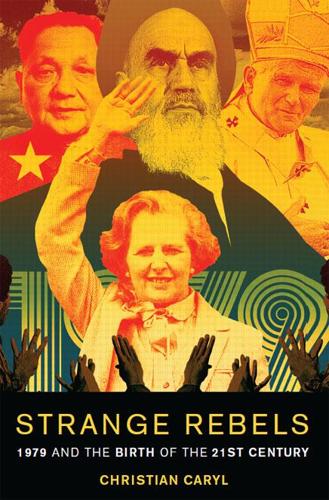
Strange Rebels: 1979 and the Birth of the 21st Century
by
Christian Caryl
Published 30 Oct 2012
Macroeconomic orthodoxy held that inflation tended to stimulate economic activity, so slow growth and high unemployment were assumed to be at odds with high price levels. Central banks in the United States, Europe, and Japan jointly cut interest rates, desperately hoping to stimulate a recovery. But nothing happened. Investment and employment failed to respond—yet inflation, already high before the “oil shock,” now began to climb. “Stagflation,” as this new phenomenon was called, defied all expert prognoses. The experts in Washington, and in the other capitals of the Western world, no longer appeared as the guarantors of prosperity. In some ways, the first energy crisis merely exacerbated shifts that were already under way.
…
The postwar consensus endured because it worked—at least for the first few decades. The British economy grew steadily through the 1950s and 1960s, widely spreading the benefits of expanding national wealth. But by the 1970s, the bloom was off. Rising global competition had revealed the structural rigidities of Britain’s social-democratic system. The oil shock hit at a moment when traditional British manufacturing industries were already affected by painful decline. Once-proud working-class cities had turned into landscapes of blight, factory ruins defaced with graffiti. In the 1970s, the British economy tottered from one crisis to another. In 1974, in the wake of the Arab oil embargo, Conservative prime minister Edward Heath was forced to introduce electricity rationing and a three-day workweek.
…
Something always seemed to get in the way: the resistance of the unions, the global economic climate, the accustomed way of doing things. The old ideas no longer worked—that much was clear. But where were the new ones? Britain was waiting for something to give. There were, of course, countries that benefited from the oil shock. First and foremost among them was the Imperial State of Iran, one of America’s key Cold War allies in the Middle East. Nevertheless, the shah of Iran, Mohammad Reza Pahlavi, welcomed the cash that poured into his coffers as a result of the OPEC embargo. He had ambitious plans for the remaking of Iranian society, and changes on the scale he envisioned certainly did not come cheap.

The Unwinding: An Inner History of the New America
by
George Packer
Published 4 Mar 2014
Although he had a younger brother, he was a lonely boy, almost without friends until he approached his teens, lonely and inward in the way of the extremely gifted. By the age of five he knew the names of all the countries and could draw the world map from memory. When he was six, his father got a job with a uranium mining company—it was just after the 1973 oil shock, when America seemed to be headed toward nuclear energy—and the Thiels spent two and a half years in South Africa and South-West Africa, under apartheid. Peter began to play chess with his parents and quickly mastered it. In Swakopmund, a little German town on the coast of South-West Africa, he spent hours making up adventures for himself in the dried-up riverbed facing the desert sand dunes behind their house, or reading atlases, nature books, and French comics in the local bookstore.
…
But Thiel’s pessimism also led him to form radical new ideas about the future. 2008 BAM SLAMS HILLARY IN HISTORIC VICTORY He’s First Black to Win Iowa Caucus as Voters Embrace Message of Change … REAL ESTATE APPRAISED: FROM MALAISE TO CRITICAL … GM POSTS RECORD US AUTOMOTIVE LOSS OF $38.7B FOR 2007 Offers Buyouts to 74,000 US Workers … OIL SHOCK: ANALYST PREDICTS $7 GAS, “MASS EXODUS” OF US CARS … DEPRESSION QUESTIONS RETURN IN NEW CENTURY … IN WEEK OF IRAQ WAR ANNIVERSARY, OBAMA’S RACE SPEECH DOMINATED MEDIA COVERAGE … Obama’s entire campaign is built on class warfare and human envy. The “change” he peddles is not new. We’ve seen it before.
…
If a sort of unwinding was happening in America, status markers became weirdly problematic—in a screwed-up society, they could not be the correct, real things. Almost nothing that had high status was a good thing to invest in. After the global financial crisis, Thiel developed a theory about the past and the future. It went back to 1973—“the last year of the fifties.” That was the year of the oil shock, the year when median wages in America began to stagnate. The seventies was the decade when things started going wrong. A lot of institutions stopped working. Science and technology stopped progressing, the growth model broke down, government no longer worked as well as in the past, middle-class life started to fray.
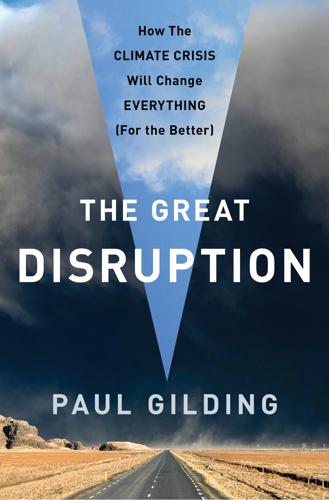
The Great Disruption: Why the Climate Crisis Will Bring on the End of Shopping and the Birth of a New World
by
Paul Gilding
Published 28 Mar 2011
Governments and the corporate sector were engaged deeply on these issues, and the public, driven by major climatic events and high-profile campaigners like Al Gore and Tim Flannery, had put the issue at the forefront of public and political debate. So many experts argued we’d turned the corner and would now start to see serious political action. Jorgen was skeptical of that view. He had seen the issue ebb and flow over many decades, from the 1970s oil shock through various peaks of attention in the 1980s and 1990s to the then emerging global financial crisis. He was convinced the world still wasn’t ready for the type of transformational action required to shift the global economy. He mounted a convincing argument, so our conversation moved to when we thought real action was likely to occur and what the science told us about the implications of acting at that stage.
…
While it will start with a focus on energy and water it will soon spread to all aspects of the high-carbon economy and then to sustainability more broadly. Some of you are thinking, “Haven’t we heard all this before, several times? Wasn’t the energy revolution going to start in the 1970s with the oil shock and the beginning of the solar revolution? Then oil prices went down and it all went away? Haven’t people been saying ever since that the boom is ‘just around the corner’?” Yes, all true, but this is fundamentally different for a simple reason. Each previous time, the transformation has been driven by economics; fossil-fuel prices went up so alternatives became competitive.
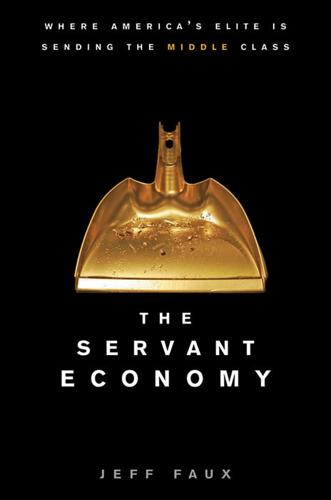
Servant Economy: Where America's Elite Is Sending the Middle Class
by
Jeff Faux
Published 16 May 2012
In a similar way, Carter began the process of deregulating the airline, banking, trucking, and telecommunications industries that Reagan later built on as he unraveled the economic base of the Roosevelt social contract. Carter provided a bridge from the age of Roosevelt to the age of Reagan. At the same time, Carter, more than any president since, seemed to understand the geopolitical lesson of the 1970s oil shocks: that the United States had become dangerously dependent on foreign supplies of oil. A year after he became president, Carter proposed a comprehensive multiyear plan for conservation and the development of new energy technologies. He spent most of his political capital trying to convince Congress and the people that (aside from the prevention of nuclear war) energy dependence was “the greatest challenge our country will face during our lifetimes,” as he told the nation in a televised speech on April 18, 1977.
…
That high federal deficits always lead to inflation is an economic urban myth. In the modern American experience, there has been virtually no peacetime example of budget deficits triggering inflation and higher interest rates. The last serious bout of U.S. inflation had occurred in the 1970s, and it was driven not by federal deficits but by three separate oil shocks generated by the global oil cartel. The previous episode of inflation resulted from the cost of the Vietnam War added to an economy already at full employment. The episode of inflation before that was fueled by the Korean War, and the one before that was caused by the pent-up demand for consumer goods and the loosening of price controls after World War II.
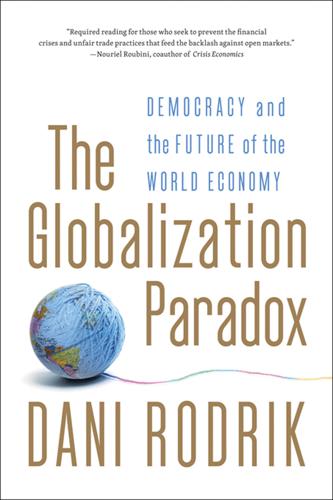
The Globalization Paradox: Democracy and the Future of the World Economy
by
Dani Rodrik
Published 23 Dec 2010
The Bretton Woods compromise was a roaring success: the industrial countries recovered and became prosperous while most developing nations experienced unprecedented levels of economic growth. The world economy flourished as never before. The Bretton Woods monetary regime eventually proved unsustainable as capital became internationally more mobile and as the oil shocks of the 1970s hit the advanced economies hard. This regime was superseded in the 1980s and 1990s by a more ambitious agenda of economic liberalization and deep integration—an effort to establish what we may call hyperglobalization. Trade agreements now extended beyond their traditional focus on import restrictions and impinged on domestic policies; controls on international capital markets were removed; and developing nations came under severe pressure to open their markets to foreign trade and investment.
…
Moreover, the belief system that supported capital controls began to dissolve over the 1970s and was replaced in subsequent decades by an alternative narrative emphasizing the inevitability of liberalization and the benefits of capital mobility. Just as in trade, an agenda of deep integration centered on free capital mobility would replace the Bretton Woods compromise. The 1960s were the heyday of Keynesian ideas on economic management. The oil shocks and the stagflation of the 1970s—which confronted advanced economies with unemployment and inflation together—pushed attention away from Keynes’s focus on demand management to the supply side of the economy. In the traditional Keynesian model, unemployment was the result of too little demand for domestic products; but the simultaneous increase in inflation belied that explanation.
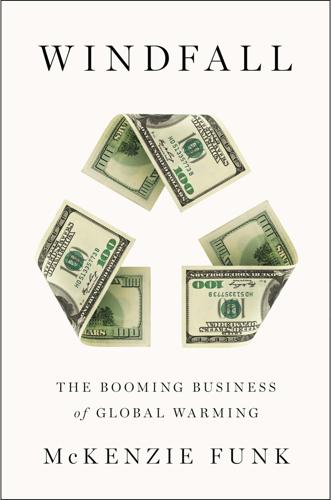
Windfall: The Booming Business of Global Warming
by
Mckenzie Funk
Published 22 Jan 2014
“I had the feeling of hunting in a pack of wolves,” Wack told an interviewer before his death in 1997, “being the eyes of the pack, and sending signals back to the rest. Now if you see something serious, and the pack doesn’t notice it, you’d better find out—are you in front?” In Wack’s time, the scenario-planning team foresaw the twin Arab oil shocks of the 1970s—inconceivable to executives because oil prices had been so stable for so long—and Shell thrived when its competitors did not. Historically the least profitable of the Seven Sisters oil companies, it would after a decade become the most profitable, momentarily surpassing even Exxon.
…
As conventional oil and gas sources run out, we need to look at unconventional resources and unconventional locations. And that’s exactly where the Arctic comes in.” Shell executives also studiously avoid any suggestion that the company’s Arctic ambitions are tied to melting sea ice. This is, in many ways, reasonable. As Blaauw has pointed out, the last time oil prices were this high, after the 1970s oil shocks, Shell began exploring the Arctic’s Chukchi and Beaufort seas, west and north of Alaska, only to give up a dozen prospects after oil prices bottomed out again. Its main Arctic drill ship, the twenty-eight-thousand-ton, 270-foot-diameter Kulluk, which it purchased in 2005 and began refurbishing at an eventual cost of more than $300 million, is more than thirty years old, having been built during this same period of high prices.
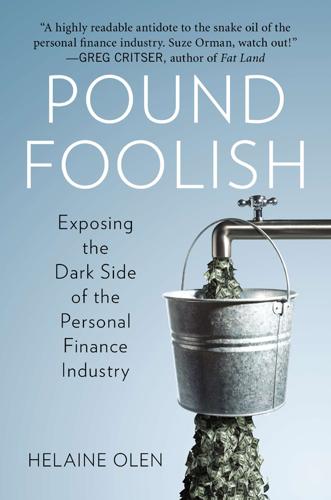
Pound Foolish: Exposing the Dark Side of the Personal Finance Industry
by
Helaine Olen
Published 27 Dec 2012
Julia Child, who arguably did for fine cooking what Porter did for financial advice, is still widely known, while Porter is so forgotten that a mention of her name to anyone under the age of fifty-five will elicit not an opinion about the columnist deemed one of the most important women of the 1970s by Ladies Home Journal, but rather the simple query: “Who?” There isn’t even a single nostalgia-trip clip of this once ubiquitous television presence on YouTube. Sylvia Porter’s descent into oblivion began at the height of her fame. The oil shocks, inflation, unemployment, and overall recessionary environment of the 1970s led to a growing demand for financial and investment information. Porter initially rode the wave, publishing her biggest bestseller Sylvia Porter’s Money Book in 1975. The book featured more than a thousand pages devoted to all things financial, from how to dress appropriately for the office without busting the budget to tips on how to cut your grocery and medical bills.
…
In the early 1970s, longtime foreign correspondent Irving R. Levine pioneered the business beat for NBC News, after network honchos dinged his request to cover the State Department. What seemed like an assignment destined to send Levine to career Siberia turned out to be anything but as the economy turned into the defining story of the decade. Through oil shocks, inflation, and job woes, Levine, wearing a trademark bow tie, explained it all in a calm, almost phlegmatic tone. Soon, PBS joined in, picking up Wall Street Week with Louis Rukeyser from a local Maryland affiliate. As for the now-ubiquitous CNBC, its origins are in second-tier Los Angeles UHF television station KWHY.
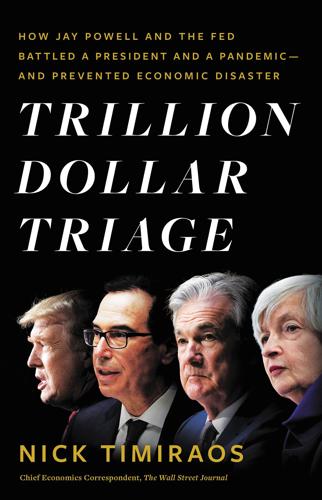
Trillion Dollar Triage: How Jay Powell and the Fed Battled a President and a Pandemic---And Prevented Economic Disaster
by
Nick Timiraos
Published 1 Mar 2022
Fed governor Dewey Daane later contrasted Burns unfavorably with his predecessor. Martin “was always seeking to strengthen the system to make it work. Burns was always trying to get invited to the White House.”61 Burns’s second term proved as challenging as his first. A bad harvest in 1972 and the oil shock of 1973 drove prices up rapidly, leading to a recession at the end of 1973. As would be expected in a contracting economy, unemployment shot up over the course of 1974. But so did inflation, reaching levels not seen since the immediate postwar era. Normally, central bankers look past one-time price increases from such transitory shocks.
…
Miller used an egg timer at committee meetings to keep his colleagues from droning on and posted a sign that said THANK YOU FOR NOT SMOKING. Both proved as ineffective as his monetary policy.63 Inflation was soaring, but rising unemployment made the Fed reluctant to raise rates. Miller’s job grew harder after the second oil shock of the decade, again driven by events in the Middle East. On July 19, 1979, after Carter outlined his measures for dealing with twin energy and economic crises, he sacked his Treasury secretary. Miller would take his place. He called Volcker, who was then president of the New York Fed, and asked him to fly down to see Carter.

Markets, State, and People: Economics for Public Policy
by
Diane Coyle
Published 14 Jan 2020
In many countries, a lot of investment in power stations and networks took place in the postwar decades. This was only partly reconstruction. Those decades of rapid economic growth in the late 1940s to late 1970s (so impressive in retrospect that they are referred to in French as les trente glorieuses) induced an even faster growth in demand for energy. Subsequently, the oil shocks of the 1970s, and the shift away from manufacturing to services, led to a big drop in the energy intensity of economic growth. The energy ratio (energy used per unit of GDP) in the OECD member countries had dropped to 57% of its 1970 level by 2001. For this reason, by the 1990s many countries appeared to have plenty of electricity generating capacity.
…
* Stephan Seiler, Anna Tuchman, and SongYao (2019), “The Impact of Soda Taxes: Pass-Through, Tax Avoidance, and Nutritional Effects” (January 9), https://ssrn.com/abstract=3302335 or http://dx.doi.org/10.2139/ssrn.3302335. Box 7.5. Counterproductive regulation In 1974 in response to the OPEC oil shock, the US government introduced a 55 mph speed limit to reduce the use of gasoline. This seemed perfectly rational. However, compared to the previous 70 mph speed limit, this added 16 minutes to a 70-mile trip. The average wage in 1974 was $4.30 an hour, so an extra 16 minutes’ travel time cost $1.15.

Extreme Money: Masters of the Universe and the Cult of Risk
by
Satyajit Das
Published 14 Oct 2011
“Assets not strategic to Standard Oil have been divested” spoke of redeploying the firm’s capital by divesting underperforming investments. “We have also become fast creative traders” declared the trend to trading in financial instruments for profit. The text ended: “in a world of oil sheikhs and oil shocks, the more liquid we are the more solid.” The advertisement spoke of a financial strategy. The oil company had become the oil bank.17 Marriages and Separations Corporations restructured constantly, acquiring and disposing of assets and companies, making comparison of performance over time impossible.
…
Initially, banks traded currencies and government bonds. Volatility of currencies increased following the collapse of the Bretton Woods agreement and the demise of the gold standard. Volatility of interest rates increased, following removal of controls on interest rates and a rise in inflation as a result of the oil shocks of 1974 and 1979. Derivatives—different forms of price insurance on currencies, interest rates, and equities—began trading in the 1970s. As volatility forced businesses and investors to hedge their financial risks, banks moved into the protection racket. Initially, they acted primarily as an intermediary, matching transactions between clients.
…
A Democrat who switched to the Republican Party, Reagan was elected governor of California to send welfare bums back to work and to clean up the University of California at Berkeley, a reference to antiwar and anti-establishment student protests. In the 1970s, growth slowed as a result of the twin oil shocks of 1974 and 1979, leading to higher oil prices. Inflation and interest rates were in double figures. Unemployment was high and there was increasing labor unrest. America’s public finances were in poor shape. The Bretton Woods system of fixed exchange rate collapsed. Since the end of the go-go years of the 1960s, the stock market had been moribund.
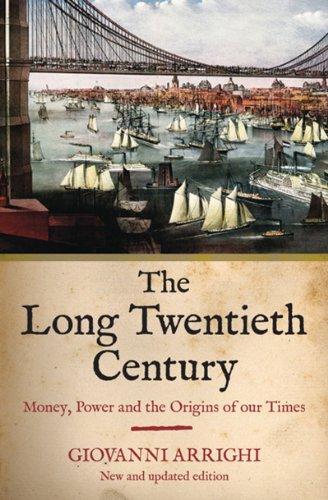
The Long Twentieth Century: Money, Power, and the Origins of Our Times
by
Giovanni Arrighi
Published 15 Mar 2010
But whereas before 1968 they rose more slowly than labor productivity (in Western Europe) or in step with it (in the United States), between THE LONG TWENTIETH CENTURY 315 1968 and 1973 they rose much faster, thereby provoking a major contraction in returns to capital invested in trade and production (Itoh 1990: 50-3; Armstrong, Glyn, and Harrison 1984: 269-76; Armstrong and Glyn 1986). The pay explosion was still in full swing when at the end of 1973 an equally powerful upward pressure on the purchase price of select primary products materialized in the first “oil shock.” Between 1970 and 1973 this upward pressure had already led to a doubling in the price of crude oil imported by OECD countries. But in 1974 alone that same price increased three-fold, deepening further the crisis of profitability (Itoh 1990: 53—4, 60-8, and table 3.3). After surveying the evidence, Makoto Itoh (1990: 116) concludes that “[o]veraccumulation of capital in relation to the inelastic supply of both the laboring population and primary products . . . was more fundamental in launching the current great depression than mismanagement of macroeconomic policies.”
…
Since only a fraction of this huge and growing mass of “oil rent” could be redeployed promptly in productive or useful undertakings by its recipients, a good part of the rent was “parked” or invested in the Eurocurrency market where it enjoyed comparatively high returns and freedom of action. This tendency began to develop in the early 1970s, when the price of crude oil doubled within a few years. But the first oil shock of late 1973, which quadrupled the price of crude oil in a few months, not only produced the $80 billion surpluses of “petrodollars” for the banks to recycle, thus swelling the importance of the financial markets and the institutions operating in them, but it also introduced a new, sometimes decisive and usually quite unpredictable factor affecting the balance of payments positions of both the consumer, and eventually the producing, countries.
…
Massive investments of money and prestige in building up Iran as the main lever of US power in the region went up in smoke when the friendly regime of the shah was displaced by the unfriendly regime of the ayatollahs. This new setback for US world power — which not accidentally brought in its train the crisis of confidence in the US dollar, the second oil shock, and the Soviet invasion of Afghanistan — finally convinced the US government that the time had come to abandon the New Deal tradition of confrontation with private high finance, and to seek instead by all available means the latter’s assistance in regaining the upper hand in the global power struggle.
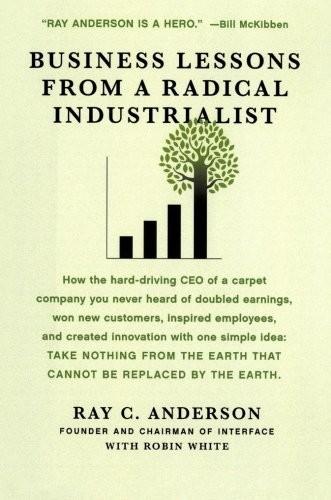
Business Lessons From a Radical Industrialist
by
Ray C. Anderson
Published 28 Mar 2011
There was plenty of oil in the ground relative to the global demand for it. It was the delivery of that oil to market that was being constrained artificially. The result? In 1972, crude oil traded at $3 a barrel. By the end of 1974, it quadrupled, to $12. This precipitated the recession in whose grips we found ourselves during Interface’s start-up. We called it an oil shock, and it was. But there were other shocks to follow. The one-two punch of the Iranian revolution and their war with Iraq pushed oil up from $14 a barrel in 1978 to $35 a barrel in 1981. Saudi Arabia’s oil minister, Ahmed Yamani, warned his fellow OPEC members that those sky-high prices could lead to a fall in demand.
…
They responded to spiking energy costs by installing better insulation in their homes, achieving greater efficiency in industrial processes, and buying automobiles that went a lot farther on a gallon of gasoline. Burning oil to generate electricity died a long overdue death. These factors along with a global recession caused crude oil prices to collapse below $10 a barrel in 1986. But today’s oil shock is very different. No one is throttling the pipelines or holding back the tankers. The wells are pumping for all they are worth, and then some. Why? Because most oil-exporting countries (and the companies that own, refine, and distribute petroleum products) are amassing profits at a rate more commonly found in the illegal drug trade.
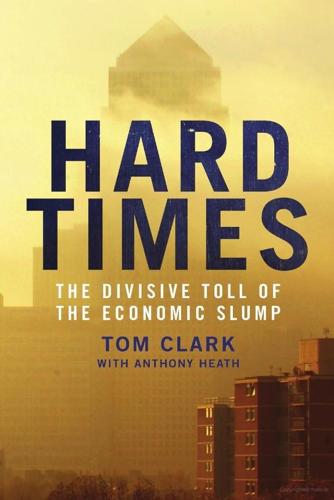
Hard Times: The Divisive Toll of the Economic Slump
by
Tom Clark
and
Anthony Heath
Published 23 Jun 2014
Again, this sustained decline would be even more marked if we looked at national income per head. For the US, the figure opposite tracks the recent slump against the two nastiest recessions since the Second World War.6 The American slide that began with the credit crunch in 2007 is confirmed as both deeper and more enduring than any since the 1930s. The oil shock of 1973 called time on America's motoring way of life, forcing the introduction of a national speed limit and requiring President Nixon to plead with filling stations not to sell fuel on Saturdays; but the crisis of 2008 knocked half as much again off GDP. The great Reagan industrial shake-out of the 1980s felt as though it dragged on for ever, but the graph shows that after the recent recession it took GDP a whole year longer to bounce back.
…
In the post-war years from 1948 through to 1973, the value of what the typical worker was producing (‘labour productivity’) and the average wage he or she took home, rose exactly in proportion, at 2.8% a year: workers were gaining in line with the fruits of their efforts. Since that year of the first oil shock, there has not been any dearth of ingenuity – labour productivity has continued to rise by a very similar 2.6% a year. The big difference concerns wages, which have subsequently climbed by only 0.6% annually at the median.17 That implies that the typical employee has now been missing out on something like three-quarters of the extra prosperity that America has been generating over 40 years.
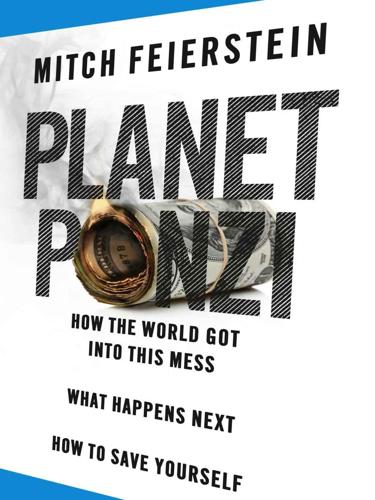
Planet Ponzi
by
Mitch Feierstein
Published 2 Feb 2012
What I would say, however, is just what I said in relation to the housing markets. Why should we expect equity prices to normalize when we are living in extraordinarily abnormal times? The period in recent economic history which bears the greatest resemblance to our own is the troubled decade of the 1970s. The 1970s saw oil shocks, inflation, weak growth, high unemployment, and the breakdown of global currency systems. Between the oil shock of 1973 and the start of recovery a decade later, Shiller’s CAPE ratio averaged just 10.2. If the S&P were to return to those bargain basement levels, it would need to fall by some 50% to around 600 or 700. If you think that a fall on that scale is impossible, you might want to take this book back to the place you bought it and ask for a refund.
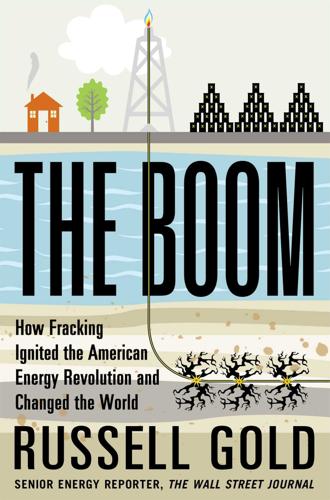
The Boom: How Fracking Ignited the American Energy Revolution and Changed the World
by
Russell Gold
Published 7 Apr 2014
Tankers full of crude arrived at the then-new Louisiana Offshore Oil Port, or LOOP, America’s single largest point of entry for crude. Deepwater tankers idled a few miles off the coast and unloaded the cargos into floating buoys connected to pipelines. Within a few years, more than five million barrels a day of OPEC crude was imported into the United States. In 1973 surging fuel costs led to the first “oil shock,” a period when geopolitical disputes cut off supplies and global economic growth was clipped by pricey oil. This pattern of a strong economy leading to high oil prices that, in turn, contributed to recessions repeated in 1979, 2001, and 2008. Expensive foreign oil has long been a brake on the economy.
…
I determined average wages by using state US Bureau of Labor Statistics data and was guided by Michael Ziesch, manager of the Labor Market Information Center of Job Service North Dakota. Details on the preliminary production of the Irene Kovaloff provided by Marathon Oil. Hamilton, James D. “Oil and the Macroeconomy Since World War II.” Journal of Political Economy 91, no. 2 (April 1983): 228–48. ———. “Causes and Consequences of the Oil Shock of 2007–08.” Brookings Papers on Economic Activity (Spring 2009): 215–59. Nordeng, Stephan. “A Brief History of Oil Production from the Bakken Formation in the Williston Basin.” Geo News (January 2010): 5. Rankin, R., M. Thibodeau, M. C. Vincent, and T. T. Palisch. “Improved Production and Profitability Achieved with Superior Completions in Horizontal Wells: A Bakken/Three Forks Case History.”
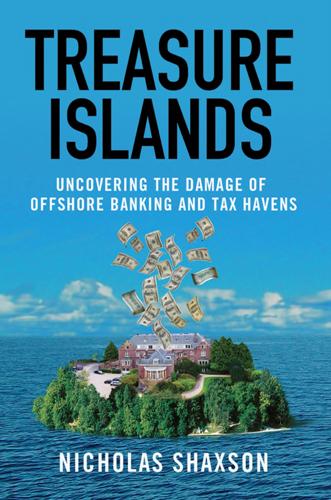
Treasure Islands: Uncovering the Damage of Offshore Banking and Tax Havens
by
Nicholas Shaxson
Published 11 Apr 2011
A major new study in 2009 by the economists Carmen Reinhardt and Kenneth Rogoff, looking back over eight hundred years of economic history, concluded that, as reviewer Martin Wolf put it, “Financial liberalisation and financial crises go together like a horse and carriage.”23 We cannot infer too much from these very different episodes. Other reasons exist for the high growth rates during the golden age, not least postwar rebuilding and productivity improvements during the war. The 1970s oil shocks go some way toward explaining the subsequent slide into crisis and stagnation. Still, less drastic but nevertheless powerful conclusions do emerge. The golden age shows that it is quite possible for countries, and the world economy, to grow quickly and steadily while under the influence of widespread and even bureaucratic curbs on the flow of capital, and high taxes.
…
“It was much more, ‘how much did we have to pay them to clear out of town and do something else with their lives.’”60 By then, the Euromarkets had grown to exceed the size of the entire world’s foreign exchange reserves.61 At the same time, a new source of dollars had begun to feed the markets, as the OPEC oil shocks hit in the 1970s, and oil-rich countries’ surpluses were re-lent through the Euromarkets to finance deficit-plagued oil consumer countries. This gigantic financial recycling via London and its satellites, to be lent out to Latin America and elsewhere, often amid great secrecy and corruption, laid the foundations for the subsequent debt crises of the 1980s.

The Making of Global Capitalism
by
Leo Panitch
and
Sam Gindin
Published 8 Oct 2012
What concerns us here, however, is the changing role of the American state in relation to the new domestic contradictions that emerged after the Volcker shock. By the time Volcker was replaced by Alan Greenspan, in 1987, “the Great Inflation was over” and “markets recognized it was over.”81 But just as the “demons of the 1970s—high inflation, oil shocks, bitter labor disputes, stagnation—seemed to be receding, banished by liberalized markets, monetarism, Reaganism, Thatcherism, and by the vogue for aggressive financial management,”82 a stock market crash confronted Greenspan with a stark new contradiction: the inherent volatility of the new age of finance.
…
At the end of the 1970s, when the US and most of Europe were facing double-digit inflation, Japan’s inflation rate was 3.6 percent.47 Its levels of unemployment remained low (just above 2 percent), and its per capita rate of growth—while a far cry from what it had been in the 1950s and 1960s—stayed above that of the other G7 economies. Japan was immediately able to compensate for the upward revaluation of its currency (and for the oil shock of 1973) by establishing a dramatic gap between productivity and wage increases (which had run in tandem from 1968 to 1973) that averaged over 3 percent a year from 1975 to 1985. This sustained manufacturing profit rates, after their fall in the early 1970s from the stratospheric levels of the previous two decades, at a higher level than those prevailing in the rest of the G7 until the mid 1980s.48 A key reason for this was that increased capital investment in the leading Japanese manufacturing sectors did not confront, as it had in the US, militant shop-floor resistance to the organizational changes necessary to yield high productivity increases.
…
The so-called Brazilian miracle remained in many ways “a clear descendent of the earlier era of import substitution” in which the home market still dominated, even as many of the old ISI price and tariff regulations were loosened and external bank financing allowed for large fiscal and trade deficits.91 For its part, the establishment of maquiladoras at the US–Mexican border proved at best a partial outlet for ISI’s contradictions.92 Such industrial development as occurred depended on a nine-fold rise in capital goods imports, which contributed heavily to a more than six-fold increase in public-sector foreign debt, mostly borrowed from US banks.93 The recycling of petrodollars through New York and London after the 1973 oil shock further fueled international bank lending to Latin American governments. This was only partly because large US banks were encouraged to do their “patriotic duty” (as one Ford administration economic advisor put it) by thus recycling dollars to Latin American dictatorships;94 the main reason was that the profits were so tempting, hitting a peak of 233 percent of their total capital and reserves in 1981.95 This left Latin America more subject than ever to crises generated in the North American imperial heartland, as was fully revealed when it became the unintended casualty of the Volcker shock.
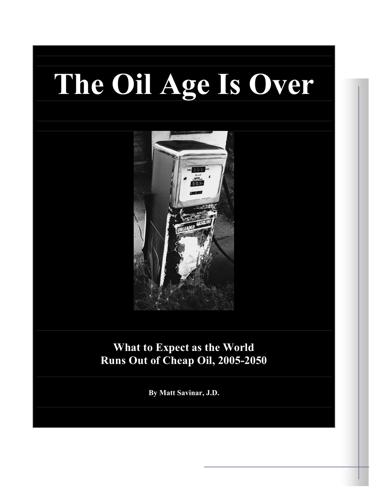
The Oil Age Is Over: What to Expect as the World Runs Out of Cheap Oil, 2005-2050
by
Matt Savinar
Published 2 Jan 2004
Nowadays, an oil discovery of 200 million barrels is considered huge, and will garner much attention in the press. The world uses 75 million barrels per day. So even a huge find is really only a 3- to 4-day supply. It will certainly make a lot of money for whoever found it, but it won't do much to soften the oil shocks. 20. Is it possible that things might get better before they get worse? Yes. Once an oil find is made, it takes about 5 years for production to come online. As stated in the previous question, the last remotely decent year for oil finds was 2000. This means the last decent year for new production to come online will be about 2005.
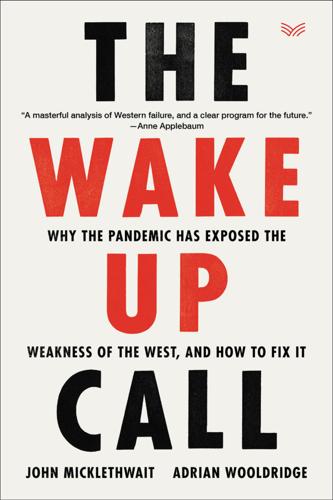
The Wake-Up Call: Why the Pandemic Has Exposed the Weakness of the West, and How to Fix It
by
John Micklethwait
and
Adrian Wooldridge
Published 1 Sep 2020
Trade unions turned striking into a regular ritual and, by the mid-1970s, the country seemed to be spiraling out of control. “Goodbye Britain, it was nice knowing you,” crowed the Wall Street Journal in 1976, as the Labor government went, begging bowl in hand, to the IMF.3 Britain was an extreme case, but no part of the West looked healthy. This was the era of oil shocks and dystopian films such as Death Wish (1974) and Taxi Driver (1976). For America, the Vietnam War ended in humiliation. Richard Nixon tried a variety of ways of kicking the economy back to life, including quitting the gold standard and freezing prices, but nothing worked. He worried in private that the United States had “become subject to the decadence which eventually destroys a civilization”—before becoming, through Watergate, a symbol of that decadence himself.4 In Europe, the Baader-Meinhof Group and the Red Brigade terrorists were on the rampage.
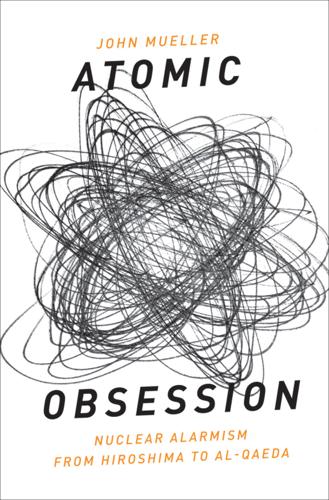
Atomic Obsession: Nuclear Alarmism From Hiroshima to Al-Qaeda
by
John Mueller
Published 1 Nov 2009
Accordingly, a balanced assessment of costs and benefits would have to be made if the technique ever proves to be feasible. But there is an excellent chance no one will ever make it: like the technology Schelling discusses, it will be dismissed out of hand. There is also something of a security aspect to this process. Ever since the oil shocks of the 1970s, it has become common in American politics to espy a danger to the country’s security in allowing it to be so dependent on a product that is so disproportionately supplied to the world by regimes in the Middle East that are sometimes contemptible, hostile, and/or unstable. Little or no progress has been made on this constantly repeated goal, but one obvious solution would be to rely much more on nuclear energy.
…
See also overstatement alarm, 162 all-out thermonuclear war, 8–9 atomic theater, 69–70 blast, 5 “certainty,” ix–x contamination, 6 deterring potential attack, 143 direct radiation and nuclear bomb, 4 disadvantages to acquiring, 103 economic and organizational cost, 110–112 ego trip, 143 electromagnetic pulse, 4 enhancing appeal, 143–149 existence of, and security, 251n.26 fallout, radiation and “dirty bombs,” 5–7 groundburst Hiroshima-size device, 10–11 Hiroshima and Nagasaki, 9–10 historical impact, 236–237 horizontal proliferation, 73 hostility, 25–26 indirect and longer-term effects, 8 influence on history, xii lacking technological imperative, 104–105 military attacks, 147 military value, 108–110 overstatement, 27–28 overstating importance of existence, 23 proliferation, 237 sanctions, 145–147 spread within and to states, xii–xiii status effects, 147–149 status symbol, 105–108 taboo, 61–63 thermal pulse of heat and light, 5 threats, 144–145 United States and USSR freezing programs, 79 vertical proliferation, 73, 76 weapons designers, 167 weapons of mass destruction (WMD), 11–13 WMD and battlefield messiness, 14–15 nuclear weapons laboratories, 266–267n.43 nuclear weapon state, definition, 148–149 nuclear winter, nuclear attack, 8 Obama, President B., potential atomic bomb, x–xi obsession, ix, xiii, 237, 237 Office of Technology Assessment, sarin, 12 oil shocks, American politics and security, 139–140 Oklahoma City, truck bomb, 19 Olympics, China’s quest to host, 108 Omar, Mullah, Taliban leader, 211 On the Beach, nuclear fears, 57 Oppenheimer, J. Robert atomic bomb, 162 exaggeration of bomb capacity, 17–18 politically productive terror, 26 priestly exaggerations, 243n.2 world government, 74 “oppositional nationalist,” Hymans, 261n.2 Oren, Michael, 262n.20, 263n.27, 264n.24 organizational costs, nuclear weapons, 110–112 overstatement consequences of, 27–28 existence of nuclear weapons, 23 explanations for, 25–27 physical effects, 17–19 social and political effects, 19–22 Pakistan apprehensions about chaos, 108 conversations with scientists in, 203–205 criticism of Musharraf’s regime, 260n.24 economics of nuclear weapons, 111 fissile material, 169 nuclear arsenal and United States, 145 opposition of Taliban regime after 9/11, 225 troubles with Taliban, 167 United States and, 164 Paris, image of destruction, 24 partial test ban treaty of 1963, arms race, 75–77 Pasdaran, sanctions, 146 Payne, Keith, threat to use nuclear weapons, 109 “peacetime standards,” radiation, 6 Pearl Harbor, 193, 247n.23, 269–270n.23 Perle, Richard, 261n.4 physical effects, overstating, 17–19 plutonium dangers and difficulties, 168 implosion trigger on hydrogen bomb, 250n.17 Mahmood in Pakistan, 205 sensitivity, 174 terrorists, 265n.20, 269n.16 Podheretz, Norman, 261n.4 points of no return, cascades of proliferation, 91 policing wars, 257n.5 political advantage, existential bombast, 232 politicization, terror, 26 Pollack, Kenneth, The Threatening Storm: The Case for Invading Iraq, 130 poor man’s nuclear weapon, “dirty bombs,” 13 Porter, Patrick, 224–225, 226 port security, Los Angeles/Long Beach, 141 postwar world, international relations, 52 Potsdam Declaration, 249n.4 Potter, William, points of no return, 20–21, 94–95 Powell, General Colin, nuclear options, 63 predictions, bombing, 195 probability, terrorists overcoming barriers, 187–189 proliferation cascadology, 89–95 China, 95–97 deterring war, 117–118 domination, 97–99 espy benefit, 257n.5 nuclear weapons, 237 pace, 103 reducing effective threat, 116–117 solving specific security problems, 118 value in, 115–118 proliferation fixation comparing costs, 141–142 foreign policy and economic costs, 137–141 human costs, 130–137 Iraq, 130–135 North Korea, 135–137 propaganda, stigmatizing Germans, 245n.26 propaganda video, Gadahn, 219 publications, 223, 244–245n.19 Putin, Vladimir, role in Russia, 137 Qaddafi, Colonel Muammar, Libya, 124–126, 154 race to demobilize, post-cold war, 84–85 radiation acceptable levels, 241–242n.10 background levels, 6–7 coping mechanisms of body, 7 Department of Homeland Security, 196–197 direct, and neutron bomb, 4 education about effects, 195–196 fear and anxiety, 196 “hormesis” hypothesis, 242n.12 nuclear explosions, 18 nuclear weapons, 5–7 Reagan, President Ronald building up U.S. military forces, 59–60 Intermediate-range Nuclear Forces (INF) agreement, 80 neutron bomb, 81 Soviet joining family of nations, 51 terrorists and Libya, 125 Reiss, Mitchell, 117, 147, 257n.18 Revolutionary Guards, sanctions, 146 rhetoric, xii, 231 rhetoric of alarm atomic bomb and World War II, 55–56 nuclear fear declining again, 60–61 nuclear fear during classic cold war, 56–57 nuclear fear reviving in early 1980s, 58–60 nuclear fear subsiding in 1960s and 1970s, 57–58 Rhodes, Richard, 80, 252n.37 Rice, Condoleezza, 131, 230 Richardson, Louise, loose-nuke stories, 208, 209, 213 Ridge, Tom, nuclear worry, 163 risk, acceptable, of catastrophic events, 197–198 rogue state, 86, 95–97, 237 Rosecrance, Richard, nuclear dispersion, 91, 251n.26 Rosenberg, Julius and Ethel, atomic traitors, 49 Rove, Karl, weapons of mass destruction, 131 Rush–Bagot Agreement, formal arms control, 83 Russia fissile material, 169–170 fixation of Putin, 137 gas fatalities, 244n.16 “naughty child” effect, 108 North Korea support, 135, 136 safety devices, nuclear weapons, 100 Sageman, Marc, 220–221, 229 SALT I (Strategic Arms Limitation Treaty) of 1972, 77–78 SALT II of 1979, arms race, 78–79 “Samson Option,” Israel, 110 sanctions appeal of nuclear weapons, 145–147 Iraq, 134, 145, 147 North Korea, 136 sanitation, nuclear attack, 8 sarin, 12, 228 scaremongers, weapons laboratories, 266–267n.43 scenario, atomic terrorist’s task in most likely, 185 Schell, Jonathan, “The Fate of the Earth,” 60, 61 Schelling, Thomas deterrence by Iran, 154–155 energy production, 139 nuclear weapons, 61–62 Scheuer, Michael, 202, 209, 214, 230, 272n.27 Schultz, George, terrorists and Libya, 125 secrets, 49–50, 237 security American politics, 139–140 balance with accident prevention, 85 existence of nuclear weapons, 251n.26 homeland, and weapons of mass destruction, 140 Israeli anxieties about, 150–151 port, 140–141 security problems, solving, 118 September 11, 2001, plot envisioning as type of Hiroshima, 200–202 9/11 Commission, 161 terrorism probability, 192–193 World Trade Center, 22 Silberman–Robb Commission, 111–112 Simon, Steven, 20, 21 Six-Day War, nuclear threat, 48 size, al-Qaeda’s capacity, 220–221 sky-is-still-falling profession, Arkin, 92 Slaughter, Anne-Marie, 258n.1 sleep disorders, atomic obsession, xi, xiii, 239 sleeper cells, al-Qaeda, 222, 275–276n.37 smuggling, atomic devices, 177 society, 20, 22 Solingen, Etel, 113, 119–120, 122, 124, 125, 254n.8 South Africa, 110, 121–122, 138, 171 South Korea, 124, 138 Soviet-Chinese confrontation, 48, 250n.14 Soviet power, external expansion, 246n.15 Soviet Union Afghanistan, 109 Afghanistan invasion, 78–79 assumptions for Western Europe invasion, 35–36 back down in Cuban missile crisis, 248n.32 “cautious opportunism,” 246n.15 Chernobyl nuclear reactor meltdown, 7 danger for United States, 52 deterrence of United States and, 65–66 end of cold war, 50–51 end of expansionary threat, 250n.21 expansionary ideology, 50–51 first Strategic Arms Limitation Treaty, 77–78 hot line between capitals with U.S., 76–77 ideology, 33–35 Japanese and, intervention, 45–46 lessons of Korean War, 38 postwar contentment, 33–35 potential invasion of Europe, 35–38 supplies by United States, 37 triple-warhead missiles, 59 world war deterrence, 32 stability, proliferation, 99 Stalin, Joseph, 36, 47, 49–50 “Star Wars,” United States and USSR, 79 status appeal of nuclear weapons, 147–149 value of nuclear weapons as, 105–108, 237 Stenersen, Anne, 207, 214 sting operation, nuclear, 194 stolen bombs, loose nukes, 165–168 Strategic Defense Initiative (SDI), 79–80, 253n.12 success, modest, of antiproliferation, 126–127 Sudan, death and destruction, 271n.10 suicide, Japanese civilians, 45 suicide pills, 85–86, 253n.26 suitcase bomb Fox Television’s 24 series, 167 possibility, 162 Soviet-made, 272n.35 stolen or illicit purchase, 165 Sunstein, Cass, case for fear, 197–198 “Superbomb,” nuclear weapon, 206 supermissile MX, Strategic Defense Initiative, 81 “supreme priority,” 129, 155–158 taboo, aftermath of Hiroshima and Nagasaki, 61–63 Taiwan, 118, 124, 138 Taiwan Straits crises, nuclear threat, 48 Takeyh, Ray, invasion of Iran, 156 Taliban hosts to al-Qaeda, 224 leader Omar in Afghanistan, 211 opposition by Pakistan after 9/11, 225 Pakistan’s trouble with, 167 retaking Afghanistan and seizing power, 265n.12 Taubman, William, world war and Soviets, 32 Tauscher, Rep.
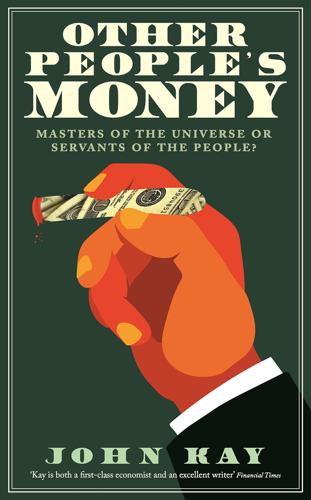
Other People's Money: Masters of the Universe or Servants of the People?
by
John Kay
Published 2 Sep 2015
The post-war institutions of global finance, such as the International Monetary Fund (IMF) and World Bank, were designed around this assumption. But as Germany and Japan recovered rapidly from wartime destruction, and the American economy weakened in the 1960s, US economic hegemony declined, and in 1971 the dollar was devalued. The oil shock of 1973–4 gave oil-producing countries, particularly Saudi Arabia and other states in the Persian Gulf, windfalls beyond their capacity to spend. ‘Petrodollars’ were recycled as loans to Europe and the USA. Meanwhile Japan, followed by other Asian countries such as South Korea, Taiwan and Hong Kong, first imitated and then improved modern production methods, and began to export manufactured goods to Europe and North America.
…
.: Hyperion 220 Loomis, Carol 108 lotteries 65, 66, 68, 72 Lucas, Robert 40 Lynch, Dennios 108 Lynch, Peter 108, 109 M M-Pesa 186 Maastricht Treaty (1993) 243, 250 McCardie, Sir Henry 83, 84, 282, 284 McGowan, Harry 45 Machiavelli, Niccolò 224 McKinley, William 44 McKinsey 115, 126 Macy’s department store 46 Madoff, Bernard 29, 118, 131, 132, 177, 232, 293 Madoff Securities 177 Magnus, King of Sweden 196 Manhattan Island, New York: and Native American sellers 59, 63 Manne, Henry 46 manufacturing companies, rise of 45 Marconi 48 marine insurance 62, 63 mark-to-market accounting 126, 128–9, 320n22 mark-to-model approach 128–9, 320n21 Market Abuse Directive (MAD) 226 market economy 4, 281, 302, 308 ‘market for corporate control, the’ 46 market risk 97, 98, 177, 192 market-makers 25, 28, 30, 31 market-making 49, 109, 118, 136 Markets in Financial Instruments Directive (MIFID) 226 Markkula, Mike 162, 166, 167 Markopolos, Harry 232 Markowitz, Harry 69 Markowitz model of portfolio allocation 68–9 Martin, Felix 323n5 martingale 130, 131, 136, 139, 190 Marx, Groucho 252 Marx, Karl 144, 145 Capital 143 Mary Poppins (film) 11, 12 MasterCard 186 Masters, Brooke 120 maturity transformation 88, 92 Maxwell, Robert 197, 201 Mayan civilisation 277 Meade, James 263 Means, Gardiner 51 Meeker, Mary 40, 167 Melamed, Leo 19 Mercedes 170 merchant banks 25, 30, 33 Meriwether, John 110, 134 Merkel, Angela 231 Merrill Lynch 135, 199, 293, 300 Merton, Robert 110 Metronet 159 Meyer, André 205 MGM 33 Microsoft 29, 167 middleman, role of the 80–87 agency and trading 82–3 analysts 86 bad intermediaries 81–2 from agency to trading 84–5 identifying goods and services required 80, 81 logistics 80, 81 services from financial intermediaries 80–81 supply chain 80, 81 transparency 84 ‘wisdom of crowds’ 86–7 Midland Bank 24 Milken, Michael 46, 292 ‘millennium bug’ 40 Miller, Bill 108, 109 Minuit, Peter 59, 63 Mises, Ludwig von 225 Mittelstand (medium-size business sector) 52, 168, 169, 170, 171, 172 mobile banking apps 181 mobile phone payment transfers 186–7 Modigliani-Miller theorem 318n9 monetarism 241 monetary economics 5 monetary policy 241, 243, 245, 246 money creation 88 money market fund 120–21 Moneyball phenomenon 165 monopolies 45 Monte Carlo casino 123 Monte dei Paschi Bank of Siena 24 Montgomery Securities 167 Moody’s rating agency 21, 248, 249, 313n6 moral hazard 74, 75, 76, 92, 95, 256, 258 Morgan, J.P. 44, 166, 291 Morgan Stanley 25, 40, 130, 135, 167, 268 Morgenthau, District Attorney Robert 232–3 mortality tables 256 mortgage banks 27 mortgage market fluctuation in mortgage costs 148 mechanised assessment 84–5 mortgage-backed securities 20, 21, 40, 85, 90, 100, 128, 130, 150, 151, 152, 168, 176–7, 284 synthetic 152 Mozilo, Angelo 150, 152, 154, 293 MSCI World Bank Index 135 muckraking 44, 54–5, 79 ‘mugus’ 118, 260 multinational companies, and diversification 96–7 Munger, Charlie 127 Munich, Germany 62 Munich Re 62 Musk, Elon 168 mutual funds 27, 108, 202, 206 mutual societies 30 mutualisation 79 mutuality 124, 213 ‘My Way’ (song) 72 N Napoleon Bonaparte 26 Napster 185 NASA 276 NASDAQ 29, 108, 161 National Economic Council (US) 5, 58 National Employment Savings Trust (NEST) 255 National Institutes of Health 167 National Insurance Fund (UK) 254 National Provincial Bank 24 National Science Foundation 167 National Westminster Bank 24, 34 Nationwide 151 Native Americans 59, 63 Nazis 219, 221 neo-liberal economic policies 39, 301 Netjets 107 Netscape 40 Neue Markt 170 New Deal 225 ‘new economy’ bubble (1999) 23, 34, 40, 42, 98, 132, 167, 199, 232, 280 new issue market 112–13 New Orleans, Louisiana: Hurricane Katrina disaster (2005) 79 New Testament 76 New York Stock Exchange 26–7, 28, 29, 31, 49, 292 New York Times 283 News of the World 292, 295 Newton, Isaac 35, 132, 313n18 Niederhoffer, Victor 109 NINJAs (no income, no job, no assets) 222 Nixon, Richard 36 ‘no arbitrage’ condition 69 non-price competition 112, 219 Norman, Montagu 253 Northern Rock 89, 90–91, 92, 150, 152 Norwegian sovereign wealth fund 161, 253 Nostradamus 274 O Obama, Barack 5, 58, 77, 194, 271, 301 ‘Obamacare’ 77 Occidental Petroleum 63 Occupy movement 52, 54, 312n2 ‘Occupy Wall Street’ slogan 305 off-balance-sheet financing 153, 158, 160, 210, 250 Office of Thrift Supervision 152–3 oil shock (1973–4) 14, 36–7, 89 Old Testament 75–6 oligarchy 269, 302–3, 305 oligopoly 118, 188 Olney, Richard 233, 237, 270 open market operations 244 options 19, 22 Organisation for Economic Co-operation and Development (OECD) 263 Osborne, George 328n19 ‘out of the money option’ 102, 103 Overend, Gurney & Co. 31 overseas assets and liabilities 179–80, 179 owner-managed businesses 30 ox parable xi-xii Oxford University 12 P Pacific Gas and Electric 246 Pan Am 238 Paris financial centre 26 Parliamentary Commission on Banking Standards 295 partnerships 30, 49, 50, 234 limited liability 313n14 Partnoy, Frank 268 passive funds 99, 212 passive management 207, 209, 212 Patek Philippe 195, 196 Paulson, Hank 300 Paulson, John 64, 109, 115, 152, 191, 284 ‘payment in kind’ securities 131 payment protection policies 198 payments system 6, 7, 25, 180, 181–8, 247, 259–60, 281, 297, 306 PayPal 167, 168, 187 Pecora, Ferdinand 25 Pecora hearings (1932–34) 218 peer-to-peer lending 81 pension funds 29, 98, 175, 177, 197, 199, 200, 201, 208, 213, 254, 282, 284 pension provision 78, 253–6 pension rights 53, 178 Perkins, Charles 233 perpetual inventory method 321n4 Perrow, Charles 278, 279 personal financial management 6, 7 personal liability 296 ‘petrodollars’ 14, 37 Pfizer 96 Pierpoint Morgan, J. 165 Piper Alpha oil rig disaster (1987) 63 Ponzi, Charles 131, 132 Ponzi schemes 131, 132, 136, 201 pooled investment funds 197 portfolio insurance 38 Potts, Robin, QC 61, 63, 72, 119, 193 PPI, mis-selling of 296 Prebble, Lucy: ENRON 126 price competition 112, 219 price discovery 226 price mechanism 92 Prince, Chuck 34 private equity 27, 98, 166, 210 managers 210, 289 private insurance 76, 77 private sector 78 privatisation 39, 78, 157, 158, 258, 307 probabilistic thinking 67, 71, 79 Procter & Gamble 69, 108 product innovation 13 property and infrastructure 154–60 protectionism 13 Prudential 200 public companies, conversion to 18, 31–2, 49 public debt 252 public sector 78 Q Quandt, Herbert 170 Quandt Foundation 170 quantitative easing 245, 251 quantitative style 110–11 quants 22, 107, 110 Quattrone, Frank 167, 292–3 queuing 92 Quinn, Sean 156 R railroad regulation 237 railway mania (1840s) 35 Raines, Franklin 152 Rajan, Raghuram 56, 58, 79, 102 Rakoff, Judge Jed 233, 294, 295 Ramsey, Frank 67, 68 Rand, Ayn 79, 240 ‘random walk’ 69 Ranieri, Lew 20, 22, 106–7, 134, 152 rating agencies 21, 41, 84–5, 97, 151, 152, 153, 159, 249–50 rationality 66–7, 68 RBS see Royal Bank of Scotland re-insurance 62–3 Reagan, Ronald 18, 23, 54, 59, 240 real economy 7, 18, 57, 143, 172, 190, 213, 226, 239, 271, 280, 288, 292, 298 redundancy 73, 279 Reed, John 33–4, 48, 49, 50, 51, 242, 293, 314n40 reform 270–96 other people’s money 282–5 personal responsibility 292–6 principles of 270–75 the reform of structure 285–92 robust systems and complex structures 276–81 regulation 215, 217–39 the Basel agreements 220–25 and competition 113 the origins of financial regulation 217–19 ‘principle-based’ 224 the regulation industry 229–33 ‘rule-based’ 224 securities regulation 225–9 what went wrong 233–9 ‘Regulation Q’ (US) 13, 14, 20, 28, 120, 121 regulatory agencies 229, 230, 231, 235, 238, 274, 295, 305 regulatory arbitrage 119–24, 164, 223, 250 regulatory capture 237, 248, 262 Reich, Robert 265, 266 Reinhart, C.M. 251 relationship breakdown 74, 79 Rembrandts, genuine/fake 103, 127 Renaissance Technologies 110, 111, 191 ‘repo 105’ arbitrage 122 repo agreement 121–2 repo market 121 Reserve Bank of India 58 Reserve Primary Fund 121 Resolution Trust Corporation 150 retirement pension 78 return on equity (RoE) 136–7, 191 Revelstoke, first Lord 31 risk 6, 7, 55, 56–79 adverse selection and moral hazard 72–9 analysis by ‘ketchup economists’ 64 chasing the dream 65–72 Geithner on 57–8 investment 256 Jackson Hole symposium 56–7 Kohn on 56 laying bets on the interpretation of incomplete information 61 and Lloyd’s 62–3 the LMX spiral 62–3, 64 longevity 256 market 97, 98 mitigation 297 randomness 76 socialisation of individual risks 61 specific 97–8 risk management 67–8, 72, 79, 137, 191, 229, 233, 234, 256 risk premium 208 risk thermostat 74–5 risk weighting 222, 224 risk-pooling 258 RJR Nabisco 46, 204 ‘robber barons’ 44, 45, 51–2 Robertson, Julian 98, 109, 132 Robertson Stephens 167 Rockefeller, John D. 44, 52, 196 Rocket Internet 170 Rogers, Richard 62 Rogoff, K.S. 251 rogue traders 130, 300 Rohatyn, Felix 205 Rolls-Royce 90 Roman empire 277, 278 Rome, Treaty of (1964) 170 Rooney, Wayne 268 Roosevelt, Franklin D. v, 25, 235 Roosevelt, Theodore 43–4, 235, 323n1 Rothschild family 217 Royal Bank of Scotland 11, 12, 14, 24, 26, 34, 78, 91, 103, 124, 129, 135, 138, 139, 211, 231, 293 Rubin, Robert 57 In an Uncertain World 67 Ruskin, John 60, 63 Unto this Last 56 Russia defaults on debts 39 oligarchies 303 Russian Revolution (1917) 3 S Saes 168 St Paul’s Churchyard, City of London 305 Salomon Bros. 20, 22, 27, 34, 110, 133–4 ‘Salomon North’ 110 Salz Review: An Independent Review of Barclays’ Business Practices 217 Samuelson, Paul 208 Samwer, Oliver 170 Sarkozy, Nicolas 248, 249 Savage, L.J. 67 Scholes, Myron 19, 69, 110 Schrödinger’s cat 129 Scottish Parliament 158 Scottish Widows 26, 27, 30 Scottish Widows Fund 26, 197, 201, 212, 256 search 195, 209, 213 defined 144 and the investment bank 197 Second World War 36, 221 secondary markets 85, 170, 210 Securities and Exchange Commission (SEC) 20, 64, 126, 152, 197, 225, 226, 228, 230, 232, 247, 292, 293, 294, 313n6 securities regulation 225–9 securitisation 20–21, 54, 100, 151, 153, 164, 169, 171, 222–3 securitisation boom (1980s) 200 securitised loans 98 See’s Candies 107 Segarra, Carmen 232 self-financing companies 45, 179, 195–6 sell-side analysts 199 Sequoia Capital 166 Shad, John S.R. 225, 228–9 shareholder value 4, 45, 46, 50, 211 Sharpe, William 69, 70 Shell 96 Sherman Act (1891) 44 Shiller, Robert 85 Siemens 196 Siemens, Werner von 196 Silicon Valley, California 166, 167, 168, 171, 172 Simon, Hermann 168 Simons, Jim 23, 27, 110, 111–12, 124 Sinatra, Frank 72 Sinclair, Upton 54, 79, 104, 132–3 The Jungle 44 Sing Sing maximum-security gaol, New York 292 Skilling, Jeff 126, 127, 128, 149, 197, 259 Slim, Carlos 52 Sloan, Alfred 45, 49 Sloan Foundation 49 small and medium-size enterprises (SMEs), financing 165–72, 291 Smith, Adam 31, 51, 60 The Wealth of Nations v, 56, 106 Smith, Greg 283 Smith Barney 34 social security 52, 79, 255 Social Security Trust Fund (US) 254, 255 socialism 4, 225, 301 Société Générale 130 ‘soft commission’ 29 ‘soft’ commodities 17 Soros, George 23, 27, 98, 109, 111–12, 124, 132 South Sea Bubble (18th century) 35, 132, 292 sovereign wealth funds 161, 253 Soviet empire 36 Soviet Union 225 collapse of 23 lack of confidence in supplies 89–90 Spain: property bubble 42 Sparks, D.L. 114, 283, 284 specific risk 97–8 speculation 93 Spitzer, Eliot 232, 292 spread 28, 94 Spread Networks 2 Square 187 Stamp Duty 274 Standard & Poor’s rating agency 21, 99, 248, 249, 313n6 Standard Life 26, 27, 30 standard of living 77 Standard Oil 44, 196, 323n1 Standard Oil of New Jersey (later Exxon) 323n1 Stanford University 167 Stanhope 158 State Street 200, 207 sterling devaluation (1967) 18 stewardship 144, 163, 195–203, 203, 208, 209, 210, 211, 213 Stewart, Jimmy 12 Stigler, George 237 stock exchanges 17 see also individual stock exchanges stock markets change in organisation of 28 as a means of taking money out of companies 162 rise of 38 stock-picking 108 stockbrokers 16, 25, 30, 197, 198 Stoll, Clifford 227–8 stone fei (in Micronesia) 323n5 Stone, Richard 263 Stora Enso 196 strict liability 295–6 Strine, Chancellor Leo 117 structured investment vehicles (SIVs) 158, 223 sub-prime lending 34–5, 75 sub-prime mortgages 63, 75, 109, 149, 150, 169, 244 Summers, Larry 22, 55, 73, 119, 154, 299 criticism of Rajan’s views 57 ‘ketchup economics’ 5, 57, 69 support for financialisation 57 on transformation of investment banking 15 Sunday Times 143 ‘Rich List’ 156 supermarkets: financial services 27 supply chain 80, 81, 83, 89, 92 Surowiecki, James: The Wisdom of Crowds xi swap markets 21 SWIFT clearing system 184 Swiss Re 62 syndication 62 Syriza 306 T Taibbi, Matt 55 tailgating 102, 103, 104, 128, 129, 130, 136, 138, 140, 152, 155, 190–91, 200 Tainter, Joseph 277 Taleb, Nassim Nicholas 125, 183 Fooled by Randomness 133 Tarbell, Ida 44, 54 TARGET2 system 184, 244 TARP programme 138 tax havens 123 Taylor, Martin 185 Taylor Bean and Whitaker 293 Tea Party 306 technological innovation 13, 185, 187 Tel Aviv, Israel 171 telecommunications network 181, 182 Tesla Motors 168 Tetra 168 TfL 159 Thai exchange rate, collapse of (1997) 39 Thain, John 300 Thatcher, Margaret 18, 23, 54, 59, 148, 151, 157 Thiel, Peter 167 Third World debt problem 37, 131 thrifts 25, 149, 150, 151, 154, 174, 290, 292 ticket touts 94–5 Tobin, James 273 Tobin tax 273–4 Tolstoy, Count Leo 97 Tonnies, Ferdinand 17 ‘too big to fail’ 75, 140, 276, 277 Tourre, Fabrice ‘Fabulous Fab’ 63–4, 115, 118, 232, 293, 294 trader model 82, 83 trader, rise of the 16–24 elements of the new trading culture 21–2 factors contributing to the change 17–18 foreign exchange 18–19 from personal relationships to anonymous markets 17 hedge fund managers 23 independent traders 22–3 information technology 19–20 regulation 20 securitisation 20–21 shift from agency to trading 16 trading as a principal source of revenue and remuneration 17 trader model 82, 83 ‘trading book’ 320n20 transparency 29, 84, 205, 210, 212, 226, 260 Travelers Group 33, 34, 48 ‘treasure islands’ 122–3 Treasuries 75 Treasury (UK) 135, 158 troubled assets relief program 135 Truman, Harry S. 230, 325n13 trust 83–4, 85, 182, 213, 218, 260–61 Tuckett, David 43, 71, 79 tulip mania (1630s) 35 Turner, Adair 303 TWA 238 Twain, Mark: Pudd’nhead Wilson’s Calendar 95–6 Twitter 185 U UBS 33, 134 UK Independence Party 306 unemployment 73, 74, 79 unit trusts 202 United States global dominance of the finance industry 218 house prices 41, 43, 149, 174 stock bubble (1929) 201 universal banks 26–7, 33 University of Chicago 19, 69 ‘unknown unknowns’ 67 UPS delivery system 279–80 US Defense Department 167 US Steel 44 US Supreme Court 228, 229, 304 US Treasury 36, 38, 135 utility networks 181–2 V value discovery 226–7 value horizon 109 Van Agtmael, Antoine 39 Vanderbilt, Cornelius 44 Vanguard 200, 207, 213 venture capital 166 firms 27, 168 venture capitalists 171, 172 Vickers Commission 194 Viniar, David 204–5, 233, 282, 283, 284 VISA 186 volatility 85, 93, 98, 103, 131, 255 Volcker, Paul 150, 181 Volcker Rule 194 voluntary agencies 258 W wagers and credit default swaps 119 defined 61 at Lloyd’s coffee house 71–2 lottery tickets 65 Wall Street, New York 1, 16, 312n2 careers in 15 rivalry with London 13 staffing of 217 Wall Street Crash (1929) 20, 25, 27, 36, 127, 201 Wall Street Journal 294 Wallenberg family 108 Walmart 81, 83 Warburg 134 Warren, Elizabeth 237 Washington consensus 39 Washington Mutual 135, 149 Wasserstein, Bruce 204, 205 Watergate affair 240 ‘We are the 99 per cent’ slogan 52, 305 ‘We are Wall Street’ 16, 55, 267–8, 271, 300, 301 Weber, Max 17 Weill, Sandy 33–4, 35, 48–51, 55, 91, 149, 293, 314n40 Weinstock, Arnold 48 Welch, Jack 45–6, 48, 50, 52, 126, 314n40 WestLB 169 Westminster Bank 24 Whitney, Richard 292 Wilson, Harold 18 windfall payments 14, 32, 127, 153, 290 winner’s curse 103, 104, 156, 318n11 Winslow Jones, Alfred 23 Winton Capital 111 Wolfe, Humbert 7 The Uncelestial City 1 Wolfe, Tom 268 The Bonfire of the Vanities 16, 22 women traders 22 Woodford, Neil 108 Woodward, Bob: Maestro 240 World Bank 14, 220 World.Com bonds 197 Wozniak, Steve 162 Wriston, Walter 37 Y Yellen, Janet 230–31 Yom Kippur War (1973) 36 YouTube 185 Z Zurich, Switzerland 62
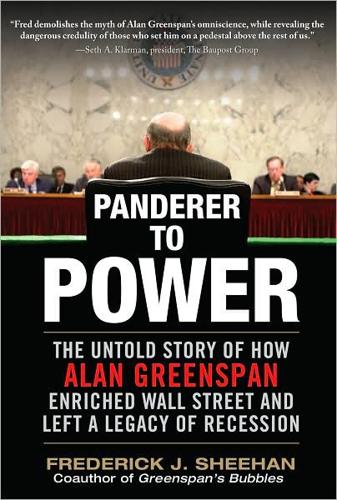
Panderer to Power
by
Frederick Sheehan
Published 21 Oct 2009
When a problem confronted the chairman, he walked away from it. The Federal Reserve, like a ship’s captain, is expected to act in extremis; once again, Greenspan deserted the bridge. Greenspan pinned the model problem on oil: “[W]e have never been able to use our model structures to forecast a recession out of an oil shock. We’ve had three oil shocks in recent decades that were followed by recessions.”31 Given this observation, why did he need a model at all to prepare for a recession? The definition of a recession is debated and redefined by committees. The simplest (though not official) measurement of recession is whether the GDP has contracted for two consecutive quarters.
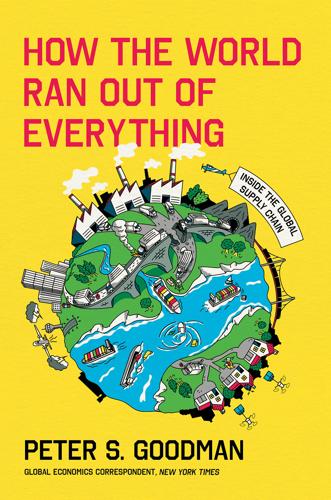
How the World Ran Out of Everything
by
Peter S. Goodman
Published 11 Jun 2024
In this fashion, Toyota ensured that it was always making the right volume of parts and finished vehicles—no more, no less. By the 1960s, kanban were in use throughout most of Toyota’s factories. The company soon spread the system to its outside suppliers, sending back empty boxes used to ship parts as an indication to make more. The oil shocks of the early 1970s sent gasoline prices soaring, propelling Toyota’s expansion. Lighter, fuel-efficient vehicles had always made sense in Japan—a major oil importer. Now, they were in demand from London to Los Angeles. By the early 1980s13, Japanese automakers had claimed nearly 30 percent of the market for cars worldwide, up from less than 4 percent two decades earlier.
…
After college at Fresno State, where he studied agricultural economics, Blocker went to work at Cargill, the agribusiness conglomerate. He started as a commodities trader, managing the firm’s positions across North America, and along the way he gained intimate familiarity with the various ways that a crop could be disrupted by unforeseen developments—a shortage of rainfall in the Valley, extreme cold in Canada, an oil shock anywhere. He started Valley Pride in 2013. The business included a small orchard and a packing plant, but the heart of it was an enormous sales and distribution operation. The company bought almonds from farmers throughout the Valley and exported them around the globe. The previous year, Valley Pride had sold 140 million pounds of almonds while logging revenues of $350 million.
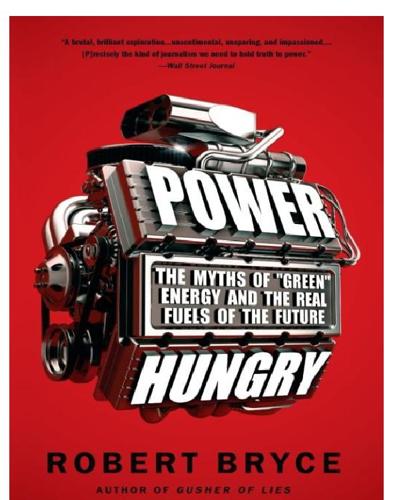
Power Hungry: The Myths of "Green" Energy and the Real Fuels of the Future
by
Robert Bryce
Published 26 Apr 2011
Valero had tried to sell the refineries but couldn’t find buyers.65 Though we cannot predict the future, we can look backward and see that the beginning of the latest economic recession—like many recessions before it—coincided with a major spike in oil prices. History shows that sharp increases in oil prices are often followed by recessions. Those oil price spikes also lead to sharp decreases in oil demand. For instance, in 1978, U.S. oil consumption peaked at 18.8 million barrels per day. But the high prices that came with the 1979 oil shock, the second big price spike in six years, sent U.S. consumption tumbling. In fact, it took two decades for U.S. oil demand to recover after the price shocks of the 1970s. It wasn’t until 1998, when U.S. consumption hit 18.9 million barrels per day, that the 1978 level of consumption was surpassed.66 And it took two decades for oil demand to recover, even though oil prices were remarkably low.
…
Austin: University of Texas Press, 1981. Roberts, Paul. The End of Oil: On the Edge of a Perilous New World. New York: Houghton Mifflin, 2004. Schumacher, E. F. Small Is Beautiful: Economics as if People Mattered. New York: Harper and Row, 1973. Simmons, Matthew. Twilight in the Desert: The Coming Saudi Oil Shock and the World Economy. Hoboken, NJ: John Wiley and Sons, 2005. Smil, Vaclav. Creating the Twentieth Century: Technical Innovations of 1867–1914 and Their Lasting Impact. New York: Oxford University Press, 2005. ———. Energies: An Illustrated Guide to the Biosphere and Civilization. Cambridge: MIT Press, 1999. ———.

Culture and Prosperity: The Truth About Markets - Why Some Nations Are Rich but Most Remain Poor
by
John Kay
Published 24 May 2004
The fact is there have been very few empirical testings of this kind ... while assertions of conviction are plentiful, factual findings are rare." 8 Indeed, it is difficult to think of any issue on which a position once held by a substantial, respected group of economists has been vacated as a result of empirical refutation. Perhaps the Phillips curve-an empirical correlation between unemployment and inflation that broke down after the oil shock of the 1970s-falls into this category. But then I turned again to Mankiw's elementary textbook, and discovered an entire chapter devoted to the Phillips curve: and that George Akerlof, receiving the Nobel Prize in 2001, described the Phillips curve as "probably the single most important macroeconomic relationship." 9 No modern chemistry textbook describes the phlogiston theory.
…
In those antitrust issues, economists would increasingly describe behavior in terms that were not recognized by those whose behavior was described. This golden age of the professional economist came to an abrupt end. Formal planning systems went into decline, and accelerating inflation from the 1960s, exacerbated by the 1973 oil shock, meant that confidence in macroeconomic policies declined. As economies went wrong, politicians would increasingly make jokes at the expense of economists. But economists, sensitive to market trends, reinvented themselves, as Culture and Prosperity { 335} cheerleaders for conservative, market-oriented policies, and a new simple theory-monetarism-supposedly took the place of the Keynesian economics which had supposedly been discredited.
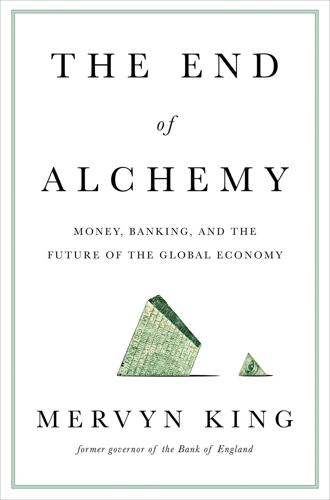
The End of Alchemy: Money, Banking and the Future of the Global Economy
by
Mervyn King
Published 3 Mar 2016
By the early 1970s, the major economies had moved to a system of ‘floating’ exchange rates, in which currency values are determined by private sector supply and demand in the markets for foreign exchange. Inevitably, the early days of floating exchange rates reduced the discipline on countries to pursue low inflation. When the two oil shocks of the 1970s – in 1973, when an embargo by Arab countries led to a quadrupling of prices, and 1979, when prices doubled after disruption to supply following the Iranian Revolution – hit the western world, the result was the Great Inflation, with annual inflation reaching 13 per cent in the United States and 27 per cent in the United Kingdom.7 Economic experiments From the late 1970s onwards, the western world then embarked on what we can now see were three bold experiments to manage money, exchange rates and the banking system better.
…
(1938), 44, 355 Harman, Jeremiah, 189 Harrods, 142–3 Harvard University, 12, 51, 58 Hastings, Max, 88–9 Hayek, Friedrich, 286 hedge funds, 93, 97, 98, 102, 114, 120–1 Hegel, Georg Wilhelm Friedrich, 334 Hicks, Sir John, ‘Mr Keynes and the Classics’ (1937), 298, 300, 302, 309 Hieronymos, Archbishop of Athens, 225–6 Hollande, President, 227 Hoover Moratorium (1931), 341 Hope, Bob, 101 house prices, 23, 31–2, 124–5, 150, 173, 320–1, 325, 362 housing markets, 23, 31–2, 35–6, 47, 103, 307, 323, 324 HSBC, 95 Huizenga, Bill, 168–9 Hume, David, 78–9, 163 Hungary, 69 Hunter, Sir William, 67–8 Huygens, Christiaan, 123 Hyun Song Shin, 31 IBM, 129 ICBC, 92 Iceland, 4, 33, 118, 243, 283 India, 38, 67–8 Industrial Revolution, 2–3, 4–5, 18–19, 260 inequality, 92, 147, 290, 369 inflation: in aftermath of First World War, 70, 86, 164, 326, 327; and Bretton Woods system, 21; calculation of, 67; causes of, 5, 20; conquering of, 5–6, 22, 25, 70, 71, 77, 78, 164, 209, 318, 357; and EMU, 221–2, 232, 237; Great Inflation (1970s), 5, 16, 21, 52, 68, 70, 165–6, 303–4, 306, 318; hyperinflation, 5, 20, 52, 68, 69–70, 86, 158–9, 190, 287; and interest rates, 185–6, 326; and Keynesian policies, 292; ‘New Keynesian’ models, 305–6; oil shocks of 1970s, 21, 306, 318; and pre-election stimulus, 164–5; ‘rigidities’ in price adjustment, 167, 171, 304; in Saddam’s Iraq, 238–9; in sixteenth century, 57; ‘stagflation’ (1970s), 5, 302–3, 318; wage and price controls (1970s), 307 inflation targeting policy, 164, 169–70, 172, 177–8, 186, 247, 315, 322, 329, 330; adoption of (early 1990s), 7, 77, 167; current targets, 70, 170; and econometric models, 305–6; goal of price stability, 22, 71, 167–8, 207–8; and radical uncertainty, 171; two elements of, 168 innovation, 4, 17, 291, 354–5, 356, 365–6 insurance, 32, 102, 112, 127, 140–1, 142, 183, 192, 204 interest rates: and asset prices, 23, 24, 29, 31–2, 33, 125, 257, 319, 335, 336, 337–8; and Bretton Woods system, 20–1; during crisis, 181, 305, 335; in currency unions, 212–13, 221–2, 232, 237, 335; determination of, 28–9, 173, 174, 207–8; falls due to external imbalances, 23, 24, 28, 29–30, 33–4, 46–7, 319–20, 325, 326, 349; ‘forward guidance’, 179, 185–6; and inflation, 185–6, 326; LIBOR (London Inter-Bank Offer Rate), 36, 150–1; the ‘lower bound’, 298–301; and market expectations, 28, 176–8, 304–5, 330–1, 332, 336; and money supply, 63, 180; ‘natural’ real rate, 44; need for return to normal, 353; negative, 29, 44, 185, 291, 299, 300–1, 335–6; real, 29; and ‘savings glut’, 28, 29, 46, 319, 325; and unemployment, 169, 298–300; very low levels post-crisis, 11, 40, 43, 44–5, 48, 183–5, 291, 312, 322–3, 335–6, 337 International Monetary Fund (IMF), 25, 190–1, 216, 229, 230, 339, 340, 352, 353; and Asian financial crisis (1990s), 349, 350–1; and Bretton Woods system, 21; membership of, 188, 212, 214–15; and sovereign debt restructuring, 346–7; and troika in European crisis, 229, 231, 350–1; US veto power, 349–50, 350, 353 investment, 29–30, 47, 101–3, 141, 309, 317–18; misdirected, 47, 49, 322, 327, 357, 362, 363; and radical uncertainty, 84, 150–5, 293–7, 310–17; rate of return on, 11, 29–30, 32–3, 356, 359, 365; risk premium, 32–3, 115, 183; ‘search for yield’, 32–3 investment banks, 23, 24, 36, 94, 98, 109, 256, 257, 260, 349 Iranian Revolution (1979), 21 Iraq, 218, 238–42, 248 Ireland, 4, 33, 47, 118, 217, 224, 243, 254 Islamic State (extremist group), 214 Issing, Otmar, 235, 344 Italy, 216, 219, 221, 224, 225, 227, 229, 234, 236, 322, 348, 364 Jackson, Andrew (economist), 262 Jackson, President Andrew, 60, 160–1 Japan, 43, 46, 62, 70, 77, 93, 113, 184, 215, 281, 348; Abe’s ‘three arrows’, 363; Bank of Japan, 163, 166, 170; lost decade (1990s), 159, 279, 363, 367 Jarvie, J.R., The Old Lady Unveiled (1934), 156–7 Jefferson, Thomas, 87 J.P.
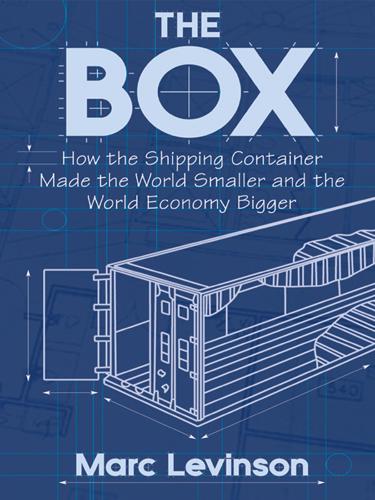
The Box: How the Shipping Container Made the World Smaller and the World Economy Bigger
by
Marc Levinson
Published 1 Jan 2006
In the decade after the container first came into international use, in 1966, the volume of international trade in manufactured goods grew more than twice as fast as the volume of global manufacturing production, and two and a half times as fast as global economic output. Something was accelerating the growth of trade even though the economic expansion that normally stimulates trade was weak. Something was driving a vast increase in international commerce in manufactured goods even though oil shocks were making the world economy sluggish. While attributing the vast changes in the world economy to a single cause would be foolhardy, we should not dismiss out of hand the possibility that the extremely sharp drop in freight costs played a major role in increasing the integration of the global economy.10 The subject of this book lies at the confluence of several major streams of research.
…
Many ship lines sacrificed the potential advantages of containerization by ordering vessels that carried containers along with other types of cargo or even passengers. Others guessed wrong about how big their ships or their containers should be. McLean himself went badly astray several times: he ordered fuel-guzzling SL-7s just ahead of the 1973 oil shock, built the sluggish but fuel-efficient Econships just as fuel prices plummeted, and sailed the Econships on a round-the-world route that left some legs heavily booked but others operating well below capacity. The “experts” who deemed container shipping uncompetitive on long routes, such as those across the Pacific, were proven to be wildly off course, and Asia’s containerports, filled with boxes destined for North America and Europe, soon became the largest in the world.

Traders, Guns & Money: Knowns and Unknowns in the Dazzling World of Derivatives
by
Satyajit Das
Published 15 Nov 2006
If you didn’t know then somewhere along the line you would pay school fees to learn about the other side of derivatives. Whole lotta swapping going on When I started in 1977, banking was changing. In 1973, Richard Nixon abolished the gold standard. The Bretton Woods Agreement on fixed exchange rates collapsed. Two oil shocks (1973 and 1978) contributed to high inflation. Under Paul Volcker, US interest rates surged. The prime rate peaked at an incomprehensible 21.50% pa. Interest rates, currencies and share prices began to fluctuate in a way that no one had ever experienced. DAS_C02.QXP 8/7/06 34 4:22 PM Page 34 Tr a d e r s , G u n s & M o n e y Banking systems were deregulated, exposing the incumbents to the strange phenomenon of competition.
…
Walter Wriston, the head of Citibank, was the intellectual giant amongst bankers of this era. He was famed for two pronouncements: ‘Risk is a four letter word’ and ‘Countries do not go bankrupt’. On the first, it was hard to dispute the great man but the second proved more controversial. Following the oil shocks of the 1970s, the oil exporting countries, especially in the Middle East, were awash in cash (petrodollars). The oil importing countries were running massive trade deficits. Wriston led the charge for international banks to lend petrodollars deposited with the banks to oil importers. The theory that countries didn’t go bankrupt proved to be not entirely well founded.

Finding Community: How to Join an Ecovillage or Intentional Community
by
Diana Leafe Christian
Published 14 Jun 2007
In retrospect, the 1970s Št that description well: a generation of young people, disillusioned and alienated by a pointless and costly war in Southeast Asia and surrounded by a culture of soulless consumerism, understandably struck out on their own for other destinations, founding thousands of communes and communities as they went — some of them still in existence, such as The Farm in Tennessee and Twin Oaks in Virginia. Any competent analyst of social trends would have to conclude that we are today entering a period in which the potential for economic and cultural decline far outstrips that of the 1970s. Then, the world staggered from the effects of temporary oil shocks; today we stand on the verge of the granddaddy of oil shocks — the all-time peak of global petroleum production. Then, the economy suffered from stagšation; today, the bursting of the mortgage, derivatives, and debt bubbles threatens to unleash a tide of foreclosures, bankruptcies, and currency devaluations not seen since the 1930s.

Water: A Biography
by
Giulio Boccaletti
Published 13 Sep 2021
Sadat offered Nile waters to settle northern Sinai—along the lines of the thirty-year-old Johnston proposal—in a shared plan with Israel to develop the Negev desert. But Sadat was assassinated in 1981, presumably for his attempts at seeking a collaborative peace, and the plan came to nothing. A second oil shock happened in 1979, when Iranian and Iraqi production collapsed in the wake of the Iranian revolution and the start of the Iraq-Iran conflict. The price of oil doubled again. In retaliation, the United States threatened a food embargo. This was just after the USSR had showed up on the markets after years of economic isolation, triggering a food crisis.
…
The eastern provinces of Saudi Arabia, which had originally inspired the water-led development of Ibn Saud, were majority Shi’a. When, at the end of 1979, the Iranian revolution gave the Shi’a an international voice, violent revolts exploded in Qatif, leading to violent repression by the Saudi government. Water-led development had become a security problem. The oil shocks of the 1970s did not just change the course of water for the Middle East. Everything changed. The high oil prices that had emerged from the Middle Eastern conflicts had a dual effect. Exporting countries saw their earnings rise, which then pushed them to seek investment opportunities. Importing countries had to finance a trade deficit because of the higher oil price, which meant they had to borrow, growing their national debts.

Born in Flames
by
Bench Ansfield
Published 15 Aug 2025
“Instead of profitable underwriting,” recounted two insurance vice presidents, firms were chasing “all the money we can get our hands on” to “invest it in this high return market.”44 The shift in the industry’s profit center reflected transformations in the broader economy. A decade characterized by oil shocks, recurrent recessions, the end of the gold standard, and major fluctuations in interest rates also saw insurance companies reimagine how they assigned and generated value. As an insurance scholar wrote in 1988, “Significant investment income is a recent phenomenon in the property and casualty insurance industry.
…
This brought huge increases in underwriting capacity and a corresponding upsurge in profits. “The 1970s were years of high returns at Lloyd’s,” notes its institutional biographer, citing the 20 percent annual profits raked in by its high-performing syndicates. This was in striking contrast to many other industries, which were pulled down by the decade’s oil shocks and stagflation. “For most of British business,” remarked Godfrey Hodgson in his history of Lloyd’s, “the 1970s were one long misery of raging inflation, endless strikes and labor disputes, falling shares of world markets, and vanishing profits. The insurance industry, in contrast, had ventured boldly into world markets, and had reaped a rich reward.”18 Of those who “ventured boldly into world markets,” Lloyd’s of London was at the forefront, channeling its peerless underwriting capacity back into the same urban neighborhoods of color it had fled during the 1960s uprisings.
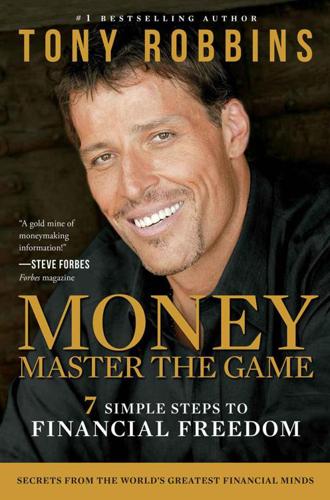
MONEY Master the Game: 7 Simple Steps to Financial Freedom
by
Tony Robbins
Published 18 Nov 2014
This market boom eventually became known as the “Nixon rally.” But it wasn’t all great news. By letting the value of the dollar be determined by “whatever we all think it’s worth,” an inflationary storm brewed on the horizon. Ray elaborates: “But then in 1973, it set up the ingredients for the first oil shock. We never had an oil shock before. We never had inflation to worry about before. And all of those things became, in a sense, surprises. And I developed a modus operandi to expect surprises.” It’s the surprises that we can’t afford, or stomach. It’s the next 2008. It’s the next shock wave sure to rumble through our markets.
…
It was a time of violent change in seasons and arguably the worst economic environment since the Great Depression. High unemployment was accompanied by massive inflation, causing interest rates to skyrocket into the high teens. Remember I shared with you that my first mortgage coming out of the inflation of the 1970s was a whopping 18% interest! There was also an “oil shock” in 1973, as an embargo caught the United States off guard, causing oil prices to rise from $2.10 a barrel to $10.40. No one was prepared for this. Just a few years later, the government imposed odd-even rationing, where people were forced not only to wait in line at the pump for hours but also were allowed to gas up only on odd or even days of the month!
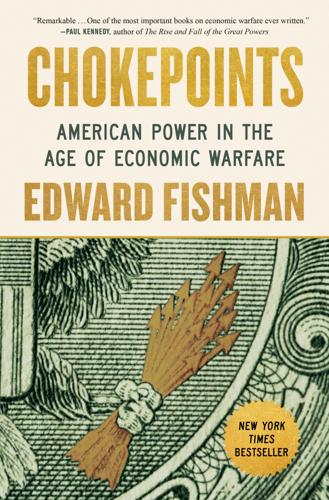
Chokepoints: American Power in the Age of Economic Warfare
by
Edward Fishman
Published 25 Feb 2025
GO TO NOTE REFERENCE IN TEXT dependent on oil imports: Daniel Yergin, The Prize: The Epic Quest for Oil, Money & Power (New York: Free Press, 2008), 570–71. GO TO NOTE REFERENCE IN TEXT imposed an oil embargo: Michael Corbett, “Oil Shock of 1973–74,” Federal Reserve History, Federal Reserve Bank of Boston, November 22, 2013, www.federalreservehistory.org/essays/oil-shock-of-1973-74. GO TO NOTE REFERENCE IN TEXT 10 percent of worldwide production: Yergin, The Prize, 596. GO TO NOTE REFERENCE IN TEXT “a vicious cycle”: “Excerpts from the Opening Address by Secretary Kissinger at the International Oil Meeting in Washington,” The New York Times, February 12, 1974, www.nytimes.com/1974/02/12/archives/excerpts-from-the-opening-address-by-secretary-kissinger-at-the.html.
…
Simon, Ex-Treasury Secretary and High-Profile Investor, Is Dead at 72,” The New York Times, June 5, 2000, www.nytimes.com/2000/06/05/us/william-e-simon-ex-treasury-secretary-and-high-profile-investor-is-dead-at-72.html. GO TO NOTE REFERENCE IN TEXT “the guy that caused the lines”: Stevenson, “William E. Simon.” GO TO NOTE REFERENCE IN TEXT surged by 40 percent: Yergin, The Prize, 598–99. GO TO NOTE REFERENCE IN TEXT oil prices did not fall: Corbett, “Oil Shock of 1973–74.” GO TO NOTE REFERENCE IN TEXT increase of more than 2,000 percent: Spiro, Hidden Hand, 1. GO TO NOTE REFERENCE IN TEXT boarded a plane: Andrea Wong, “The Untold Story Behind Saudi Arabia’s 41-Year U.S. Debt Secret,” Bloomberg, May 30, 2016, www.bloomberg.com/news/features/2016-05-30/the-untold-story-behind-saudi-arabia-s-41-year-u-s-debt-secret.
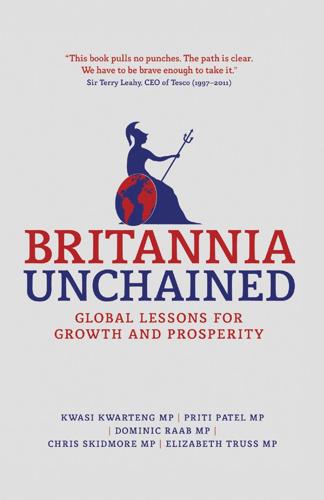
Britannia Unchained: Global Lessons for Growth and Prosperity
by
Kwasi Kwarteng
,
Priti Patel
,
Dominic Raab
,
Chris Skidmore
and
Elizabeth Truss
Published 12 Sep 2012
If you run a deficit, you will allow public spending to grow unsustainably with little checks to make sure that the public are getting good value for money. When the inevitable crash comes, a spendthrift Government will soon discover that it is a lot easier to hand out goodies than to take them back again. Economists used to believe that the high inflation of the 1970s was the result of the oil shocks, an outside emergency that no Government could ever have avoided. We now know that an equally significant cause were Governments themselves, desperately trying to boost economies by increasing deficits beyond what was sustainable. The 1950s and 1960s were a golden age for Western economies. Growth has never been as fast since.
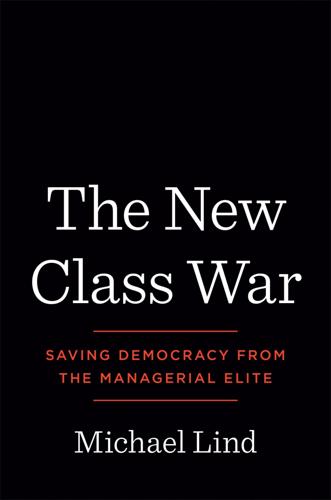
The New Class War: Saving Democracy From the Metropolitan Elite
by
Michael Lind
Published 20 Feb 2020
Similar deregulatory reforms and anti-union measures were adopted by many European governments, including those of center-left leaders like Tony Blair and Gerhard Schröder, following the example of free market conservatives like British prime minister Margaret Thatcher. Neoliberal economic reforms initially were justified as a response to the “stagflation” (combined stagnation and inflation) that afflicted Europe and North America in the 1970s. While the oil shocks of the 1970s contributed to the problem, in hindsight there were several structural causes: slower productivity growth as a result of the exhaustion of the technological possibilities of the earlier electromechanical revolution, before the benefits of the information technology (IT) revolution had become important; pressure on corporate profits from overproduction in manufacturing, caused by the postwar recovery of Germany and Japan and their export-oriented manufacturing strategies; and pressure on profits as well from trade unions enabled by tight, low-immigration labor markets to demand wage increases outstripping productivity growth, which fueled wage-push inflation.
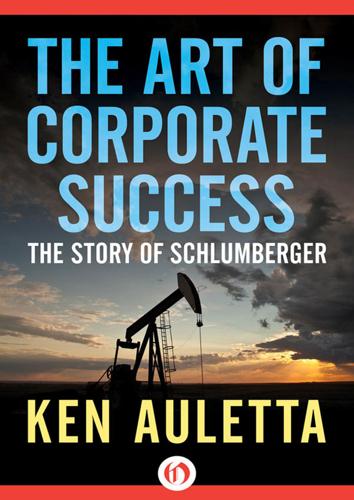
The Art of Corporate Success: The Story of Schlumberger
by
Ken Auletta
Published 28 Sep 2015
Since the cost of logging a well—the wireline process—is only 2 to 5 percent of the oil company’s cost, wrote John C. Wellemeyer, managing director of the investment-banking firm of Morgan Stanley, in 1973, “Schlumberger should be able to increase prices as much as required to maintain its margins.” Until the current oil shock, that is what it has done. “To measure a successful company, you need time—a long span of time,” Riboud says. By that measure, too, Schlumberger is a success. Figures on the company’s profits were first made public for a full year in 1958, and in all but two years of the quarter century since, its profits have climbed.
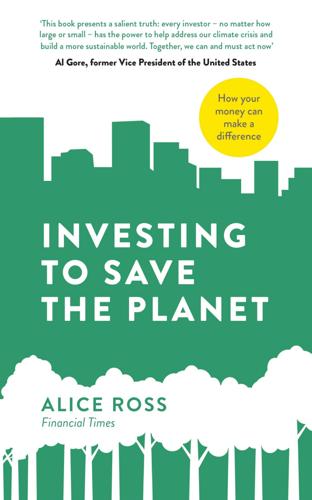
Investing to Save the Planet: How Your Money Can Make a Difference
by
Alice Ross
Published 19 Nov 2020
In the nineteenth century, the world shifted from biomass and wood to coal, while the twentieth century saw a shift to oil. Coal’s market share rose from 5 per cent to 60 per cent between 1830 and 1914, peaking in the year the First World War broke out. Oil’s market share rose from 1 per cent to 40 per cent between 1900 and 1973, peaking in the year of the first OPEC oil shock. Gas rose from 4 per cent in 1945 to 24 per cent today, according to a 2018 report from the Oxford Institute for Energy Studies. The report concluded that the global energy industry was verging on its next energy transition, with wind and solar likely to be the fuel of the twenty-first century.
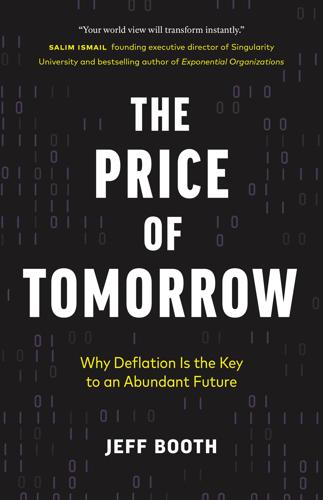
The Price of Tomorrow: Why Deflation Is the Key to an Abundant Future
by
Jeff Booth
Published 14 Jan 2020
In 2006, two years before the collapse of Lehman Brothers and the rescue of the financial system, Roubini “stood before an audience of economists at the International Monetary Fund and announced that a crisis was brewing.” In the coming months and years, he warned, the United States was likely to face a once-in-a-lifetime housing bust, an oil shock, sharply declining consumer confidence and, ultimately, a deep recession. He laid out a bleak sequence of events: homeowners defaulting on mortgages, trillions of dollars of mortgage-backed securities unraveling worldwide, and the global financial system shuddering to a halt. These developments, he went on, could cripple or destroy hedge funds, investment banks, and other major financial institutions like Fannie Mae and Freddie Mac.5 To be fair, Roubini had missed recession calls in the past.
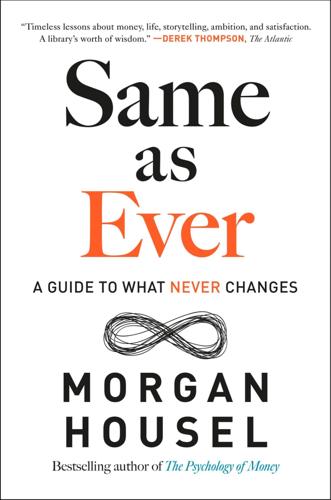
Same as Ever: A Guide to What Never Changes
by
Morgan Housel
Published 7 Nov 2023
Stuff like that rarely happens that fast without fear as a motivator. Same with commercial airplanes. Flying is as safe as it is because after every accident comes an intense learn-and-fix process that reduces the odds of similar future accidents. The same thing occurred in the 2000s, when an oil shock in 2008 that made prices surge incentivized oil companies to innovate on drilling techniques, which brought American oil production to record highs. Would the innovation boom have occurred without the previous crisis? Almost certainly not. Same during COVID-19, when a generational risk and panic set off an astounding development and production of new vaccines.
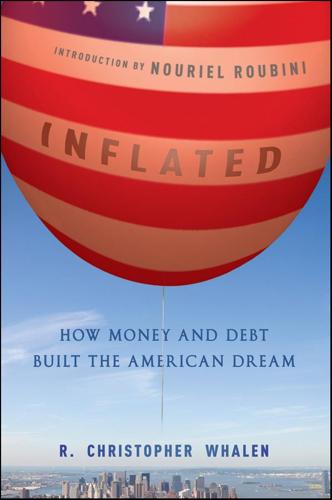
Inflated: How Money and Debt Built the American Dream
by
R. Christopher Whalen
Published 7 Dec 2010
The chart in Figure 8.1 illustrates the federal government’s spending in that period. Figure 8.1 Federal Outlays, Receipts, and Balance (1968–1976) (Millions of $) Source: Office of Management and Budget. Ford had the bad luck of serving in the worst economy since the Great Depression. The mid-1970s were difficult years in the United States, with the oil shock and double-digit unemployment breaking the renewed sense of confidence that had prevailed in the post-WWII era. The fact that the fiscal deficits were rising at a time of slack economic demand made the public uneasy. Despite the fact that members of both political parties tacitly accepted the need for deficits, the public at large was still largely unaware of the change in the basic assumptions of government which had occurred during the Cold War.
…
In heartland manufacturing states such as Indiana, Michigan, and Illinois joblessness reached into the teens. The U.S. economy was mired in recession for three years. This illustrated the level of adjustment that the two oil price increases of the decade, 1973 and 1979, required literally to squeeze the inflationary increases out of the system. The United States was unable to remove the impact of the oil shocks, but could merely slow the rate of increases in prices by brutally suppressing the economy. In a 1982 memo from Paul Krugman and Larry Summers, who were both then working in the Reagan White House, to William Poole and Martin Feldstein, the two economists predicted that inflation would again begin to accelerate because the reduction in inflation engineered by the Fed was only temporary.
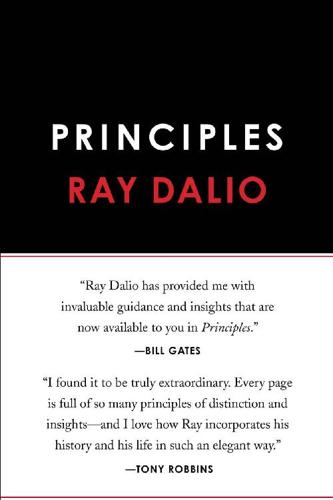
Principles: Life and Work
by
Ray Dalio
Published 18 Sep 2017
Up until then, as far as I know, no Harvard Business School student had ever worked in commodity futures anywhere. Most Wall Street firms didn’t even have commodity futures divisions, and Merrill Lynch’s was small, tucked away on a side street, and furnished with basic metal desks. A few months later, when I was back for my second year at HBS, the first oil shock began, with prices quadrupling in a matter of months. The U.S. economy slowed, commodity prices soared, and in 1973 the stock market took a dive. Once again, I was blindsided—but in retrospect I could see that the dominoes had fallen in a logical sequence. In this case, the debt-financed overspending of the 1960s had continued into the early 1970s.
…
It was a time of extreme turbulence for the global economy, for the markets, and for me personally. In 1978–80 (as in 1970–71 and in 1974–75) different markets began to move in unison because they were more influenced by swings in money and credit growth than by changes in their individual supply-demand balances. These big moves were exacerbated by the oil shock that followed the fall of the Shah of Iran. That oil market volatility led to the creation of the first oil futures contract, which gave me trading opportunities (by then, there were futures markets in interest rates and currencies as well, and I was making bets in all of them). Because all markets were being driven by these factors, I immersed myself in macroeconomics and historical data (especially interest rates and currency data) to improve my understanding of the machine at play.
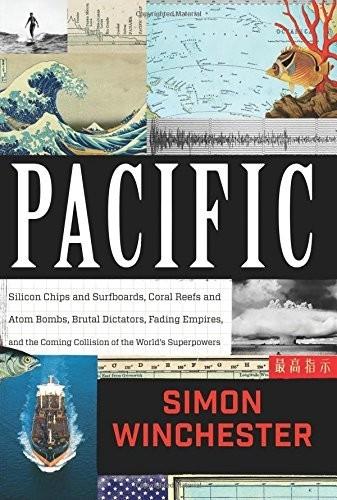
Pacific: Silicon Chips and Surfboards, Coral Reefs and Atom Bombs, Brutal Dictators, Fading Empires, and the Coming Collision of the World's Superpowers
by
Simon Winchester
Published 27 Oct 2015
And given that so many popular politicians unwittingly flirt with hubris, the disaster was not long in coming. It had much to do, as ultimately the whole scandal had, with money. It was one specific spending scheme that triggered his government’s spectacular fall. Late in 1974, in the aftermath of the worldwide oil shock and its associated economic turmoil, Whitlam launched an attempt to insulate Australia from any such energy-related problems in the future by boosting the country’s immense and untapped supplies of energy. Specifically, it needed to create a number of large new mines to extract coal and other of the many minerals with which Australia had been blessed, to build a giant new gas pipeline, and to electrify a long series of freight railways in the country’s southeast.
…
See Dutch colonies Neutral Nations Supervisory Commission, 184 Nevada, USS (battleship), 54, 57 Nevada National Guard, 25 Nevada nuclear tests, 53 New Britain, 333 New Caledonia, 216n Newfoundland cod fishery, 366 New Guinea, 43, 292, 314, 389n New Hebrides, 212, 214–15 New Horizon (ship), 365 New Ireland, 333 New Orleans, 237, 244 New South Wales, 284, 287 New South Wales State Conservatorium, 291 New Territories, China and, 222, 228 New Year’s Day, 1950, 30–32, 35–37 New York Times, 54n, 55–56, 108–9, 123, 358 New Zealand, 6, 21, 190, 219, 272, 314, 392n, 431 Nguyen dynasty, 206 NHK (Japanese broadcaster), 98 Niemeyer, Oscar, 105 Niihau Island, 375 Nine-Dash Line, 392–95, 394, 397 Nissan firm, 11 Nixon, Richard, 25, 416, 416 Nobel Prize, 34, 97 Norfolk Island, 220 North America, El Niño and, 264 North American Plate, 314, 316 North Borneo, 212–13 Northern Hemisphere stars, 436 North Island, New Zealand, 314 North Korea, 27, 116, 151–52, 422 Bridge of No Return, 183 calendar of, 181–82 Constitution of 2009, 182 division of, 153–56, 154 DMZ monitors and, 184–85 hostile incidents and, 176–78 juche and police state of, 178–82 mass games, 179, 182 nuclear weapons and, 33, 182 Pueblo and, 151–52, 157–76, 158, 187 Vietnam War and, 211 visit to, 180–81 North Korean Army, 162, 174, 182, 185 North Korean Navy, 159–69 North Korean Workers’ Party, 181 North Vietnam (Democratic Republic of Vietnam), 206, 208–9 Norton, Rosaleen, 290–91 Norway, 190 Novarupta stratovolcano eruptions, 379n nuclear and atomic weapons, 17–20, 26, 32–43, 46–78 Alvin finds lost, 307–8 atmospheric testing ban, 33 fission vs. fusion, 40–42 Bikini and, 26, 52–81, 61 carbon dating and, 32–37 Castle Bravo test, 37, 66–78, 68 Hiroshima and, 46, 73, 77, 234 hydrogen bomb developed, 26, 33, 37, 66–70, 77 Kiritimati and, 18 Marshall Islands and, 19, 48–81 Mururoa and, 218 Nagasaki and, 32, 46, 55, 77, 153, 234 North Korea and, 182 number of tests, by U.S., 53–54 radioactive contamination and, 20, 33–37 Soviets and, 32–33, 41 Truman and, 41–43, 66–67 Nude with Violin (Coward), 108 NYK container ships, 115 Oahu, 144, 427, 429 Oahu, 357n Oak Ridge, Tennessee, 47 Obama, Barack, 367–68, 420 Oceana, 21 Ocean Island, 212 Ocean Passages for the World, 3 octopus, deep-sea, 321 Oeno atoll, 216 Office of Naval Intelligence, 388 Office of Net Assessment, 416, 416, 419 oil shock of 1973, 270 oil spills, 362 Okeechobee hurricane of 1928, 243 Okinawa, 418 Typhoon Haiyan and, 240, 241 U.S. base at, 115, 392, 422 Okinawa, USS (assault ship), 211 olo (long surfboard), 128–29 Olympic Games, 25, 138–39 Omai of Ra’iatea, 5 o’o bird, 354–55 OPEC, 270 Operation Clickbeetle, 157 Operation Crossroads, 52–65, 61 Operation Damayan, 240 Operation Fiery Vigil, 383 Operation Frequent Wind, 209–10 Operation Linebacker, 209 Operation Paul Bunyan, 177 Operation Rolling Thunder, 209 Operation Sovereign Borders, 300 Opium Wars, 225, 228 Oppenheimer, J.
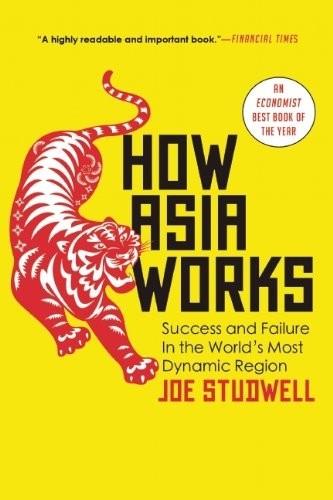
How Asia Works
by
Joe Studwell
Published 1 Jul 2013
The steamroller approach In the most investment-intensive era of industrial growth, from approximately 1965 to the early 1980s, there developed a pattern in which each time Korea hit a road block in the form of an external economic shock and/or a domestic financial crisis, government did whatever was financially necessary to maintain developmental momentum. In the early 1970s, in addition to the kerb market interest moratorium, General Park’s government forced state banks to swap loans for chaebol shares and abandoned the high domestic interest rate policy begun in 1965. It met each crisis with cheaper money. With the first global oil shock, and a deep world recession, from late 1973 until 1975, the government massively increased domestic credit, while foreign debt rose from 31 to 40 per cent of GNI. With the second international oil crisis of 1979, plus increased US interest rates that helped trigger a world recession from 1980, Korea cranked up foreign debt again; the level, which had been pulled back to 30 per cent of GNI before the crisis, was increased to 50 per cent.23 Korea grew through a cataclysm which, in 1982, brought similarly indebted Latin American countries, and then the Philippines, to their knees.
…
Chinese finance remains on a leash, even if that leash is inevitably, inexorably lengthening. Forward march China’s recent reaction to external crises is best viewed, then, not as a sudden loss of financial discipline but in the historical context of the Japanese, Korean and Taiwanese responses to the global currency and oil shocks of the 1970s. The Chinese government has intervened to maintain the momentum of the country’s developmental learning process. ‘School’ has not been suspended because of external economic shocks. Of course, this does not mean that China has no debt issues. If one adds together different central government debts, local government debts for which Beijing is ultimately responsible and other near-term contingent liabilities (although not long-run liabilities like China’s huge state pension fund gap), then public debt is perhaps 80 per cent of GDP.62 However, some of this debt is offset by readily saleable assets, almost none is owed to foreigners, and capital controls mean that banks do not need to worry about insolvency (that is, their potential losses on bad loans exceeding their capital) because they always have cash on hand.
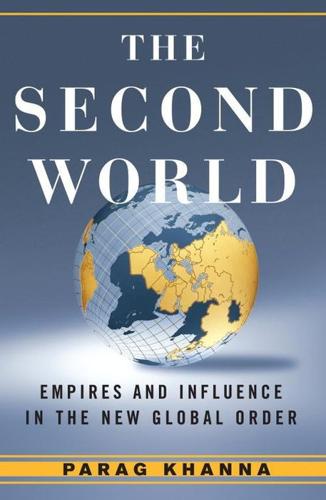
Second World: Empires and Influence in the New Global Order
by
Parag Khanna
Published 4 Mar 2008
Building a State, Building Peace: How to Make a Roadmap That Works for Palestinians and Israelis. Saban Center for Middle East Policy, Monograph no. 1. Washington, D.C.: Brookings Institution Press, 2003. Siddiqa, Ayesha, Military, Inc.: Inside Pakistan’s Military Economy. London: Pluto Press, 2007. Simmons, Matthew R. Twilight in the Desert: The Coming Saudi Oil Shock and the World Economy. Hoboken, N.J.: John Wiley and Sons, 2005. Simon, Sheldon W., ed. The Many Faces of Asian Security. Lanham, Md.: Rowman and Littlefield, 2001. Simons, Thomas W., Jr. Islam in a Globalizing World. Stanford, Calif.: Stanford University Press, 2003. Singer, Peter. One World: The Ethics of Globalization.
…
There is constant debate over the longevity of Saudi Arabia’s oil reserves based on whether or not it has reached its peak production point, the number of years of oil remaining in its fields based on global demand, and the volume of oil contained in new discoveries. See Matthew R. Simmons, Twilight in the Desert: The Coming Saudi Oil Shock and the World Economy (Hoboken, N.J.: John Wiley and Sons, 2005); and Peter Maass, “The Breaking Point,” New York Times Magazine, August 21, 2005. 16. Peter Bergen and Alec Reynolds, “Blowback Revisited,” Foreign Affairs, November–December 2005, 2–6. As the U.S. Defense Science Board notes, “Muslims do not hate our freedoms, but rather they hate our policies.” 17.
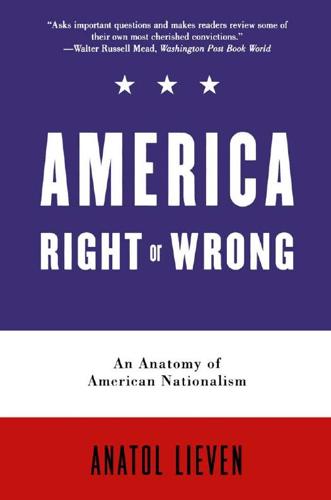
America Right or Wrong: An Anatomy of American Nationalism
by
Anatol Lieven
Published 3 May 2010
Across large areas of America, these religious beliefs in turn form a central part of the identity of the original White American colonist population, above all in the Greater South, or what former First Lady Lady Bird Johnson described simply as "us—the simple American stock."21 The religious beliefs of large sections of this core population are under constant, daily threat from modern secular culture, above all via the mass media. And perhaps of equal importance in the long term will be the relative decline in recent decades in the real incomes of the American middle classes, where these groups are situated socially. This decline and the wider economic changes which began with the oil shock of 1973 have had the side effect of helping force more and more women to go to work, thereby undermining traditional family structures even among those groups most devoted to them. The relationship between this traditional White Protestant world on one hand and the forces of American economic, demographic, social and cultural change on the other may be compared to the genesis of a hurricane.
…
To a traditional mind, the American culture which developed after the 1960s by contrast seemed like something out of Hieronymus Bosch, literally a pandemonium of scarcely credible monsters and abominations; and much of television constitutes nothing less than a daily assault on their world of faith and culture. Finally, beginning with the oil shock of 1973, the 1970s saw the end of the long postwar boom and the beginning of three decades of unprecedented longterm stagnation in real incomes for the American middle classes. The old White working class of the Midwest had gotten used to a world in which respectability and steady work guaranteed a steadily rising income and social status.
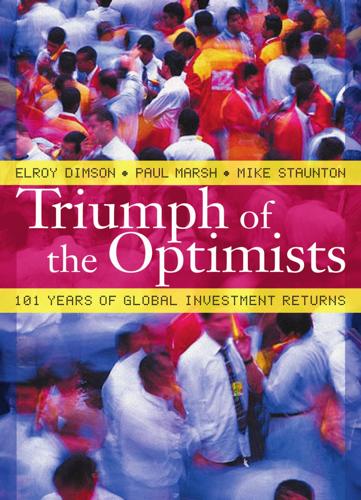
Triumph of the Optimists: 101 Years of Global Investment Returns
by
Elroy Dimson
,
Paul Marsh
and
Mike Staunton
Published 3 Feb 2002
These terminal wealth figures correspond to annualized real returns of 6.7 percent on equities, 1.6 percent on bonds, and 0.9 percent on bills. Figure 4-2 shows that US equities totally dominated bonds and bills. There were setbacks of course, most notably during the First World War; the Wall Street Crash of 1929 and its aftermath, including the Great Depression; and the OPEC oil shock of the 1970s. Each shock was severe at the time. At the depths of the Wall Street Crash, the Dow Jones Industrial Index had fallen by 89 percent. Many investors were ruined, especially those who had bought stocks with borrowed money. The crash lived on in the memories of investors—and indeed, those who subsequently chose to shun equities—for at least a generation.
…
Figure 8-6: Correlation coefficients between four core countries over seven successive sub-periods 0.7 0.6 0.5 0.4 Correlation coefficients US:UK US:Fra UK:Fra Average US:Ger UK:Ger Ger:Fra .40 .26 0.3 0.2 0.1 .09 .14 .15 .01 0.0 -0.1 -.07 -0.2 -0.3 -0.4 -0.5 1872–1889 1889–1914 Source: Goetzmann, Li, and Rouwenhorst, 2001 1915–1918 1919–1939 1940–1945 1946–1971 1972–2000 Chapter 8: International investment 117 Longin and Solnik (1995) provide further evidence of high correlations during periods of poor performance. They find that markets become more closely related during turmoil such as the 1974 oil shock, the October 1987 crash, the 1990 invasion of Kuwait and the ensuing Gulf War in 1991, or by extension, the aftershock from September 11, 2001. This raises the obvious question of whether international diversification works when it is most needed. Das and Uppal (2001) provide reassurance by showing that the impact of this is small for longterm investors, who should still hold highly international portfolios.

Radical Uncertainty: Decision-Making for an Unknowable Future
by
Mervyn King
and
John Kay
Published 5 Mar 2020
Arab states imposed an oil embargo on the United States and other western countries which were perceived as supporters of Israel. Oil prices rose sharply and continued to rise even after the embargo was relaxed the following year. Wack and his team were credited with having helped Shell anticipate the ‘oil shock’. Since then, scenario planning has been central to Shell’s strategic thinking, and other companies have undertaken similar exercises. Shell scenarios make extensive use of quantitative data and emphasis is placed on their internal consistency but they are, essentially, narratives. A useful narrative may be turgid prose rather than literary masterpiece – a washing machine instruction manual rather than Pride and Prejudice – but Wack’s unusual background helped gain attention for his thinking.
…
INDEX 10 (film, 1979), 97 737 Max aircraft, 228 9/11 terror attacks, 7 , 74–6 , 202 , 230 Abbottabad raid (2011), 9–10 , 20 , 26 , 44 , 71 , 102 , 118–19 , 120 , 174–5 ; reference narrative of, 122–3 , 277 , 298 ; role of luck in, 262–3 ; and unhelpful probabilities, 8–19 , 326 abductive reasoning, 138 , 147 , 211 , 388 , 398 ABN AMRO, 257 Abraham (biblical character), 206 Abrahams, Harold, 273 Abramovich, Roman, 265 accountancy, 409 aeronautics, 227–8 , 352–6 , 383 Agdestein, Simen, 273 AIDS, 57 , 230 , 375–6 Airbus A380, 40 , 274–6 , 408 Akerlof, George, 250–1 , 252 , 253 , 254 , 382 Alchian, Armen, 158 alien invasion narratives, 295–6 Allais, Maurice, 134–5 , 136 , 137 , 437 , 440–3 Allen, Bill, 227–8 Allen, Paul, 28 , 29 Altair desktop, 28 Amazon, 289 , 309 Anderson, Roy, 375 ant colonies, 173 anthropology, 160 , 189–91 , 193–4 , 215–16 antibiotics, 40 , 45 , 284 , 429 Antz (film, 1998), 274 apocalyptic narratives, 331–2 , 335 , 358–62 Appiah, Anthony, 117–18 Apple, 29–30 , 31 , 169 , 309 Applegarth, Adam, 311 arbitrage, 308 Archilochus (Greek poet), 222 Aristotle, 137 , 147 , 303 Arrow, Kenneth, 254 , 343–5 , 440 artificial intelligence (AI), xvi , 39 , 135 , 150 , 173–4 , 175–6 , 185–6 , 387 ; the ‘singularity’, 176–7 Ashtabula rail bridge disaster (1876), 33 Asimov, Isaac, 303 asteroid strikes, 32 , 71–2 , 238 , 402 astrology, 394 astronomical laws, 18–19 , 35 , 70 , 373–4 , 388 , 389 , 391–2 , 394 AT&T, 28 auction theory, 255–7 Austen, Jane, 217 , 224–5 , 383 autism, 394 , 411 aviation, commercial, 23–4 , 40 , 227–8 , 274–6 , 315 , 383 , 414 axiomatic rationality: Allais disputes theory, 134–5 , 136 , 137 ; Arrow– Debreu world, 343–5 ; assumption of transitivity, 437 ; and Becker, 114 , 381–2 ; and behavioural economics, 116 , 135–6 , 141–9 , 154–5 , 167–8 , 386–7 , 401 ; capital asset pricing model (CAPM), 307–8 , 309 , 320 , 332 ; completeness axiom, 437–8 ; consistency of choice axiom, 108–9 , 110–11 ; continuity axiom, 438–40 ; definition of rationality, 133–4 , 137 , 436 ; definition of risk, 305 , 307 , 334 , 420–1 ; efficient market hypothesis, 252 , 254 , 308–9 , 318 , 320 , 332 , 336–7 ; efficient portfolio model, 307–8 , 309 , 318 , 320 , 332–4 , 366 ; and evolutionary rationality, 16 , 152–3 , 154–5 , 157 , 158 , 166–7 , 171–2 , 386–7 , 407 ; and ‘expectations’ concept, 97–8 , 102–3 , 121–2 , 341–2 ; extended to decision-making under uncertainty, xv , 40–2 , 110–14 , 133–7 , 257–9 , 420–1 ; and Friedman, 73–4 , 111–12 , 113–14 , 125 , 257–9 , 307 , 399–400 , 420 , 437 ; hegemony of over radical uncertainty, 40–2 , 110–14 ; implausibility of assumptions, xiv–xv , 16 , 41–4 , 47 , 74–84 , 85–105 , 107–9 , 111 , 116–22 , 344–9 , 435–44 ; independence axiom, 440–4 ; as limited to small worlds, 170 , 309–10 , 320–1 , 342–9 , 382 , 400 , 421 ; and Lucas, 36 , 92 , 93 , 338–9 , 341 , 345 , 346 ; and Markowitz, 307 , 308 , 309–10 , 318 , 322 , 333 ; maximising behaviour, 310 ; ‘pignistic probability’, 78–84 , 438 ; and Popperian falsificationism, 259–60 ; Prescott’s comparison with engineering, 352–6 ; ‘rational expectations theory, 342–5 , 346–50 ; and Samuelson, xv , 42 , 110–11 , 436 ; and Savage, 111–14 , 125 , 257–9 , 309 , 345 , 400 , 435 , 437 , 442–3 ; shocks and shifts discourse, 42 , 346 , 347 , 348 , 406–7 ; Simon’s work on, 134 , 136 , 149–53 ; triumph of probabilistic reasoning, 15–16 , 20 , 72–84 , 110–14 ; Value at risk models (VaR), 366–8 , 405 , 424 ; von Neumann–Morgenstern axioms, 111 , 133 , 435–44 ; see also maximising behaviour Ballmer, Steve, 30 , 227 Bank of England, xiii , 45 , 103–5 , 286 , 311 Barclays Bank, 257 Barings Bank, 411 Basel regulations, 310 , 311 Bay of Pigs fiasco (1961), 278–9 Bayes, Reverend Thomas, 60–3 , 66–7 , 70 , 71 , 358 , 431 Beane, Billy, 273 Bear Stearns, 158–9 Becker, Gary, 114 , 381–2 Beckham, David, 267–8 , 269 , 270 , 272–3 , 414 behavioural economics, 116 , 145–8 , 154 , 386–7 ; and Allais paradox, 442 ; ‘availability heuristic’, 144–5 ; biases in human behaviour, 16 , 136 , 141–8 , 154 , 162 , 165 , 167–8 , 170–1 , 175–6 , 184 , 401 ; and evolutionary science, 154–5 , 165 ; Kahneman’s dual systems, 170–1 , 172 , 271 ; Kahneman–Tversky experiments, 141–7 , 152 , 215 ; ‘noise’ (randomness), 175–6 ; nudge theory, 148–9 Bentham, Jeremy, 110 Berkshire Hathaway, 153 , 319 , 324 , 325–6 Berlin, Isaiah, 222 Bernoulli, Daniel, 114–16 , 199 Bernoulli, Nicolaus, 199 , 442 Bertrand, Joseph, 70 Bezos, Jeff, 289 big data, 208 , 327 , 388–90 billiard players, 257–8 bin Laden, Osama, 7 , 8–10 , 21 , 44 , 71 , 118–19 , 120 , 122–3 , 262–3 , 326 Bismarck, Otto von, 161 Bitcoin, 96 , 316 Black Death, 32 , 39–40 BlackBerry, 30 , 31 blackjack, 38 Blackstone, Sir William, 213 BNP Paribas, 5 , 6 BOAC, 23–4 Boas, Franz, 193 Boeing, 24 , 227–8 Boer War, 168 Bolt, Usain, 273 bonobos, 161–2 , 178 Borges, Jorge Luis, 391 Borodino, battle of (1812), 3–4 , 433 Bortkiewicz, Ladislaus, 235–6 Bower, Tom, 169–70 Bowral cricket team, New South Wales, 264 Box, George, 393 Boycott, Geoffrey, 264–5 Bradman, Don, 237 , 264 Brahe, Tycho, 388–9 Brånemark, Per-Ingvar, 387 , 388 Branson, Richard, 169–70 Brearley, Michael, 140–1 , 264–5 Breslau (now Wrocław), 56 Brexit referendum (June 2016), 241–2 ; lies told during, 404 bridge collapses, 33 , 341 Brownian motion, 37 Brunelleschi, Filippo, 143 , 147 Buffett, Warren, 83 , 152 , 179 , 319–20 , 324 , 335 , 336–7 Burns, Robert, 253 Bush, George W., 295 , 407 , 412 business cycles, 347 business history (academic discipline), 286 business schools, 318 business strategy: approach in 1970s, 183 ; approach in 1980s, 181–2 ; aspirations confused with, 181–2 , 183–4 ; business plans, 223–4 , 228 ; collections of capabilities, 274–7 ; and the computer industry, 27–31 ; corporate takeovers, 256–7 ; Lampert at Sears, 287–9 , 292 ; Henry Mintzberg on, 296 , 410 ; motivational proselytisation, 182–3 , 184 ; quantification mistaken for understanding, 180–1 , 183 ; and reference narratives, 286–90 , 296–7 ; risk maps, 297 ; Rumelt’s MBA classes, 10 , 178–80 ; Shell’s scenario planning, 223 , 295 ; Sloan at General Motors, 286–7 ; strategy weekends, 180–3 , 194 , 296 , 407 ; three common errors, 183–4 ; vision or mission statements, 181–2 , 184 Buxton, Jedediah, 225 Calas, Jean, 199 California, 48–9 Cambridge Growth Project, 340 Canadian fishing industry, 368–9 , 370 , 423 , 424 cancer, screening for, 66–7 Candler, Graham, 352 , 353–6 , 399 Cardiff City Football Club, 265 Carlsen, Magnus, 175 , 273 Carnegie, Andrew, 427 Carnegie Mellon University, 135 Carré, Dr Matt, 267–8 Carroll, Lewis, Through the Looking-Glass , 93–4 , 218 , 344 , 346 ; ‘Jabberwocky’, 91–2 , 94 , 217 Carron works (near Falkirk), 253 Carter, Jimmy, 8 , 119 , 120 , 123 , 262–3 cartography, 391 Casio, 27 , 31 Castro, Fidel, 278–9 cave paintings, 216 central banks, 5 , 7 , 95 , 96 , 103–5 , 285–6 , 348–9 , 350 , 351 , 356–7 Central Pacific Railroad, 48 Centre for the Study of Existential Risk, 39 Chabris, Christopher, 140 Challenger disaster (1986), 373 , 374 Chamberlain, Neville, 24–5 Chandler, Alfred, Strategy and Structure , 286 Chariots of Fire (film, 1981), 273 Charles II, King, 383 Chelsea Football Club, 265 chess, 173 , 174 , 175 , 266 , 273 , 346 Chicago economists, 36 , 72–4 , 86 , 92 , 111–14 , 133–7 , 158 , 257–8 , 307 , 342–3 , 381–2 Chicago Mercantile Exchange, 423 chimpanzees, 161–2 , 178 , 274 China, 4–5 , 419–20 , 430 cholera, 283 Churchill, Winston: character of, 25–6 , 168 , 169 , 170 ; fondness for gambling, 81 , 168 ; as hedgehog not fox, 222 ; on Montgomery, 293 ; restores gold standard (1925), 25–6 , 269 ; The Second World War , 187 ; Second World War leadership, 24–5 , 26 , 119 , 167 , 168–9 , 170 , 184 , 187 , 266 , 269 Citibank, 255 Civil War, American, 188 , 266 , 290 Clapham, John, 253 Clark, Sally, 197–8 , 200 , 202 , 204 , 206 Clausewitz, Carl von, On War , 433 climate systems, 101–2 Club of Rome, 361 , 362 Coase, Ronald, 286 , 342 Cochran, Johnnie, 198 , 217 Cochrane, John, 93 coffee houses, 55–6 cognitive illusions, 141–2 Cohen, Jonathan, 206–7 Colbert, Jean-Baptiste, 411 Cold War, 293–4 , 306–7 Collier, Paul, 276–7 Columbia disaster (2003), 373 Columbia University, 117 , 118 , 120 Columbus, Christopher, 4 , 21 Colyvan, Mark, 225 Comet aircraft, 23–4 , 228 communication: communicative rationality, 172 , 267–77 , 279–82 , 412 , 414–16 ; and decision-making, 17 , 231 , 272–7 , 279–82 , 398–9 , 408 , 412 , 413–17 , 432 ; eusociality, 172–3 , 274 ; and good doctors, 185 , 398–9 ; human capacity for, 159 , 161 , 162 , 172–3 , 216 , 272–7 , 408 ; and ill-defined concepts, 98–9 ; and intelligibility, 98 ; language, 98 , 99–100 , 159 , 162 , 173 , 226 ; linguistic ambiguity, 98–100 ; and reasoning, 265–8 , 269–77 ; and the smartphone, 30 ; the ‘wisdom of crowds’, 47 , 413–14 Community Reinvestment Act (USA, 1977), 207 comparative advantage model, 249–50 , 251–2 , 253 computer technologies, 27–31 , 173–4 , 175–7 , 185–6 , 227 , 411 ; big data, 208 , 327 , 388–90 ; CAPTCHA text, 387 ; dotcom boom, 228 ; and economic models, 339–40 ; machine learning, 208 Condit, Phil, 228 Condorcet, Nicolas de, 199–200 consumer price index, 330 , 331 conviction narrative theory, 227–30 Corinthians (New Testament), 402 corporate takeovers, 256–7 corporations, large, 27–31 , 122 , 123 , 286–90 , 408–10 , 412 , 415 Cosmides, Leda, 165 Cretaceous–Paleogene extinction, 32 , 39 , 71–2 Crick, Francis, 156 cricket, 140–1 , 237 , 263–5 crime novels, classic, 218 crosswords, 218 crypto-currencies, 96 , 316 Csikszentmihalyi, Mihaly, 140 , 264 Cuba, 278–80 ; Cuban Missile Crisis, 279–81 , 299 , 412 Custer, George, 293 Cutty Sark (whisky producer), 325 Daily Express , 242–3 , 244 Damasio, Antonio, 171 Dardanelles expedition (1915), 25 Darwin, Charles, 156 , 157 Davenport, Thomas, 374 Dawkins, Richard, 156 de Havilland company, 23–4 Debreu, Gerard, 254 , 343–4 decision theory, xvi ; critiques of ‘American school’, 133–7 ; definition of rationality, 133–4 ; derived from deductive reasoning, 138 ; Ellsberg’s ‘ambiguity aversion’, 135 ; expected utility , 111–14 , 115–18 , 124–5 , 127 , 128 – 30 , 135 , 400 , 435–44 ; hegemony of optimisation, 40–2 , 110–14 ; as unable to solve mysteries, 34 , 44 , 47 ; and work of Savage, 442–3 decision-making under uncertainty: and adaptation, 102 , 401 ; Allais paradox, 133–7 , 437 , 440–3 ; axiomatic approach extended to, xv , 40–2 , 110–14 , 133–7 , 257–9 , 420–1 ; ‘bounded rationality concept, 149–53 ; as collaborative process, 17 , 155 , 162 , 176 , 411–15 , 431–2 ; and communication, 17 , 231 , 272–7 , 279–82 , 398–9 , 408 , 412 , 413–17 , 432 ; communicative rationality, 172 , 267–77 , 279–82 , 412 , 414–16 ; completeness axiom, 437–8 ; continuity axiom, 438–40 ; Cuban Missile Crisis, 279–81 , 299 , 412 ; ‘decision weights’ concept, 121 ; disasters attributed to chance, 266–7 ; doctors, 184–6 , 194 , 398–9 ; and emotions, 227–9 , 411 ; ‘evidence-based policy’, 404 , 405 ; excessive attention to prior probabilities, 184–5 , 210 ; expected utility , 111–14 , 115–18 , 124–5 , 127 , 128–30 , 135 , 400 , 435–44 ; first-rate decision-makers, 285 ; framing of problems, 261 , 362 , 398–400 ; good strategies for radical uncertainty, 423–5 ; and hindsight, 263 ; independence axiom, 440–4 ; judgement as unavoidable, 176 ; Klein’s ‘primed recognition decision-making’, 399 ; Gary Klein’s work on, 151–2 , 167 ; and luck, 263–6 ; practical decision-making, 22–6 , 46–7 , 48–9 , 81–2 , 151 , 171–2 , 176–7 , 255 , 332 , 383 , 395–6 , 398–9 ; and practical knowledge, 22–6 , 195 , 255 , 352 , 382–8 , 395–6 , 405 , 414–15 , 431 ; and prior opinions, 179–80 , 184–5 , 210 ; ‘prospect theory’, 121 ; public sector processes, 183 , 355 , 415 ; puzzle– mystery distinction, 20–4 , 32–4 , 48–9 , 64–8 , 100 , 155 , 173–7 , 218 , 249 , 398 , 400–1 ; qualities needed for success, 179–80 ; reasoning as not decision-making, 268–71 ; and ‘resulting’, 265–7 ; ‘risk as feelings’ perspective, 128–9 , 310 ; robustness and resilience, 123 , 294–8 , 332 , 335 , 374 , 423–5 ; and role of economists, 397–401 ; Rumelt’s ‘diagnosis’, 184–5 , 194–5 ; ‘satisficing’ (’good enough’ outcomes), 150 , 167 , 175 , 415 , 416 ; search for a workable solution, 151–2 , 167 ; by securities traders, 268–9 ; ‘shock’ and ‘shift’ labels, 42 , 346 , 347 , 348 , 406–7 ; simple heuristics, rules of thumb, 152 ; and statistical discrimination, 207–9 , 415 ; triumph of probabilistic reasoning, 20 , 40–2 , 72–84 , 110–14 ; von Neumann– Morgenstern axioms, 111 , 133 , 435–44 ; see also business strategy deductive reasoning, 137–8 , 147 , 235 , 388 , 389 , 398 Deep Blue, 175 DeepMind, 173–4 The Deer Hunter (film, 1978), 438 democracy, representative, 292 , 319 , 414 demographic issues, 253 , 358–61 , 362–3 ; EU migration models, 369–70 , 372 Denmark, 426 , 427 , 428 , 430 dentistry, 387–8 , 394 Derek, Bo, 97 dermatologists, 88–9 Digital Equipment Corporation (DEC), 27 , 31 dinosaurs, extinction of, 32 , 39 , 71–2 , 383 , 402 division of labour, 161 , 162 , 172–3 , 216 , 249 DNA, 156 , 198 , 201 , 204 ‘domino theory’, 281 Donoghue, Denis, 226 dotcom boom, 316 , 402 Doyle, Arthur Conan, 34 , 224–5 , 253 Drapers Company, 328 Drescher, Melvin, 248–9 Drucker, Peter, Concept of the Corporation (1946), 286 , 287 Duhem–Quine hypothesis, 259–60 Duke, Annie, 263 , 268 , 273 Dulles, John Foster, 293 Dutch tulip craze (1630s), 315 Dyson, Frank, 259 earthquakes, 237–8 , 239 Eco, Umberto, The Name of the Rose , 204 Econometrica , 134 econometrics, 134 , 340–1 , 346 , 356 economic models: of 1950s and 1960s, 339–40 ; Akerlof model, 250–1 , 252 , 253 , 254 ; ‘analogue economies’ of Lucas, 345 , 346 ; artificial/complex, xiv–xv , 21 , 92–3 , 94 ; ‘asymmetric information’ model, 250–1 , 254–5 ; capital asset pricing model (CAPM), 307–8 , 309 , 320 , 332 ; comparative advantage model, 249–50 , 251–2 , 253 ; cost-benefit analysis obsession, 404 ; diversification of risk, 304–5 , 307–9 , 317–18 , 334–7 ; econometric models, 340–1 , 346 , 356 ; economic rent model, 253–4 ; efficient market hypothesis, 252 , 254 , 308–9 , 318 , 320 , 332 , 336–7 ; efficient portfolio model, 307–8 , 309 , 318 , 320 , 332–4 , 366 ; failure over 2007–08 crisis, xv , 6–7 , 260 , 311–12 , 319 , 339 , 349–50 , 357 , 367–8 , 399 , 407 , 423–4 ; falsificationist argument, 259–60 ; forecasting models, 7 , 15–16 , 68 , 96 , 102–5 , 347–50 , 403–4 ; Goldman Sachs risk models, 6–7 , 9 , 68 , 202 , 246–7 ; ‘grand auction’ of Arrow and Debreu, 343–5 ; inadequacy of forecasting models, 347–50 , 353–4 , 403–4 ; invented numbers in, 312–13 , 320 , 363–4 , 365 , 371 , 373 , 404 , 405 , 423 ; Keynesian, 339–40 ; Lucas critique, 341 , 348 , 354 ; Malthus’ population growth model, 253 , 358–61 , 362–3 ; misuse/abuse of, 312–13 , 320 , 371–4 , 405 ; need for, 404–5 ; need for pluralism of, 276–7 ; pension models, 312–13 , 328–9 , 405 , 423 , 424 ; pre-crisis risk models, 6–7 , 9 , 68 , 202 , 246–7 , 260 , 311–12 , 319 , 320–1 , 339 ; purpose of, 346 ; quest for large-world model, 392 ; ‘rational expectations theory, 342–5 , 346–50 ; real business cycle theory, 348 , 352–4 ; role of incentives, 408–9 ; ‘shift’ label, 406–7 ; ‘shock’ label, 346–7 , 348 , 406–7 ; ‘training base’ (historical data series), 406 ; Value at risk models (VaR), 366–8 , 405 , 424 ; Viniar problem (problem of model failure), 6–7 , 58 , 68 , 109 , 150 , 176 , 202 , 241 , 242 , 246–7 , 331 , 366–8 ; ‘wind tunnel’ models, 309 , 339 , 392 ; winner’s curse model, 256–7 ; World Economic Outlook, 349 ; see also axiomatic rationality; maximising behaviour; optimising behaviour; small world models Economic Policy Symposium, Jackson Hole, 317–18 economics: adverse selection process, 250–1 , 327 ; aggregate output and GDP, 95 ; ambiguity of variables/concepts, 95–6 , 99–100 ; appeal of probability theory, 42–3 ; ‘bubbles’, 315–16 ; business cycles, 45–6 , 347 ; Chicago School, 36 , 72–4 , 86 , 92 , 111–14 , 133–7 , 158 , 257–8 , 307 , 342–3 , 381–2 ; data as essential, 388–90 ; division of labour, 161 , 162 , 172–3 , 216 , 249 ; and evolutionary mechanisms, 158–9 ; ‘expectations’ concept, 97–8 , 102–3 , 121–2 , 341–2 ; forecasts and future planning as necessary, 103 ; framing of problems, 261 , 362 , 398–400 ; ‘grand auction’ of Arrow and Debreu, 343–5 ; hegemony of optimisation, 40–2 , 110 – 14 ; Hicks–Samuelson axioms, 435–6 ; market fundamentalism, 220 ; market price equilibrium, 254 , 343–4 , 381–2 ; markets as necessarily incomplete, 344 , 345 , 349 ; Marshall’s definition of, 381 , 382 ; as ‘non-stationary’, 16 , 35–6 , 45–6 , 102 , 236 , 339–41 , 349 , 350 , 394–6 ; oil shock (1973), 223 ; Phillips curve, 340 ; and ‘physics envy’, 387 , 388 ; and power laws, 238–9 ; as practical knowledge, 381 , 382–3 , 385–8 , 398 , 399 , 405 ; public role of the social scientist, 397–401 ; reciprocity in a modern economy, 191–2 , 328–9 ; and reflexivity, 35–6 , 309 , 394 ; risk and volatility, 124–5 , 310 , 333 , 335–6 , 421–3 ; Romer’s ‘mathiness’, 93–4 , 95 ; shift or structural break, 236 ; Adam Smith’s ‘invisible hand’, 163 , 254 , 343 ; social context of, 17 ; sources of data, 389 , 390 ; surge in national income since 1800, 161 ; systems as non-linear, 102 ; teaching’s emphasis on quantitative methods, 389 ; validity of research findings, 245 ‘Economists Free Ride, Does Anyone Else?’

The Quiet Coup: Neoliberalism and the Looting of America
by
Mehrsa Baradaran
Published 7 May 2024
Citing his argument in Buckley that the distinction between corporations and people was “wholly foreign” to the First Amendment, Powell wrote that the speech at issue in the case “is at the heart of the First Amendment.”29 In other words, not only was a bank’s political donation to defeat a state tax protected by the First Amendment, it was the express purpose of the First Amendment. Three years later, in Central Hudson Gas and Electric Co. v. Public Service Commission of New York (1980), Powell had yet another chance to drag the Court further down the path of corporate free speech. The case concerned a state ban on ads promoting electricity use, which was imposed amid the oil shocks that had sent prices soaring and after President Jimmy Carter’s request that Americans reduce consumption. Central Hudson Gas challenged the ban as a violation of its right to free speech. The Court took the case, Burger assigned the opinion to Powell, and despite heavy criticism from his colleagues on the bench, moved the Court, the law, and the nation closer toward an interpretation of the First Amendment as a shield for corporations to protect against state laws.
…
Former Goldman Sachs partner Paulson and former Wall Street regulators Geithner and Bernanke repeated these claims, advising both Bush and Obama that making the banks take losses of any kind would be too risky and would cause market turmoil. There was some truth to this. FDR’s bank holiday caused significant turbulence and Richard Nixon’s dollar shocks and oil shocks did as well. The difference now was the power of the large institutions of the market compared to the power of the American president. As the journalist James Stewart recounts in “Eight Days,” his absorbing New Yorker account of the earliest days of the crisis, Geithner asked Treasury officials whether allowing AIG to fail was possible: “Can we let it go?”
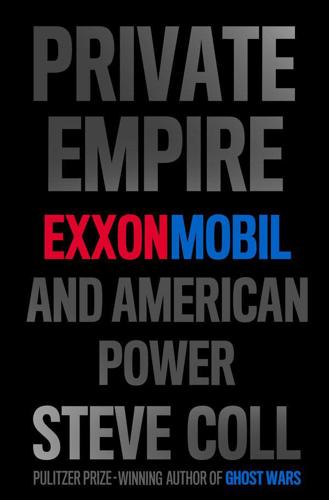
Private Empire: ExxonMobil and American Power
by
Steve Coll
Published 30 Apr 2012
As Tariq Shafiq had observed about the First World War, access by Western companies to Iraq’s oil did not need to be an explicit cause of the Bush administration’s invasion to become an outcome. Douglas Feith had been thinking about global oil security issues since the first term of the Reagan administration, when he worked on energy policy as a young staffer at the National Security Council. He considered himself something of a contrarian on the subject. After the oil shocks and embargoes of the 1970s, it was common in Washington to think of “energy security” as a problem in which newly powerful Arab exporters could wield the “oil weapon” over vulnerable Western importers. This was the political science model of oil security, as Feith put it. Oil supplies lay scattered around the globe, as on the board of a Risk game, and governments competed for advantage and control.
…
The chemical processes by which ethanol could be extracted from sugar and grain had been known to mankind for centuries—mainly because they produced an alcohol that made people drunk and happy, or at least temporarily distracted them from their miseries. Ethanol had also been burned as a fuel in the industrializing West since the early nineteenth century, but it was not as efficient as oil-derived fuels such as kerosene. It first emerged as a subject of possible federal regulation and mandates for use in the United States after the oil shocks of the 1970s. In that era’s search for freedom from Middle Eastern oil, ethanol distilled from corn surfaced as a possible solution. The fuel’s advocates—primarily in the agricultural Midwest—also promoted ethanol blends as a way to reduce air-polluting carbon monoxide emissions from burned gasoline.
…
Fairbanks, AK: Epicenter Press, 1997. Safina, Carl. A Sea in Flames: The Deepwater Horizon Oil Blowout. New York: Crown, 2011. Shaxon, Nicholas. Poisoned Wells: The Dirty Politics of African Oil. New York: Palgrave Macmillan, 2007. Simmons, Matthew R. Twilight in the Desert: The Coming Saudi Oil Shock and the World Economy. Hoboken, NJ: Wiley, 2005. Suskind, Ron. The Price of Loyalty. New York: Simon & Schuster, 2004. Tarbell, Ida M. The History of the Standard Oil Company. New York: McClure, Phillips, 1904. Taylor, Jean Gelman. Indonesia: Peoples and Histories. New Haven, CT: Yale University Press, 2004.
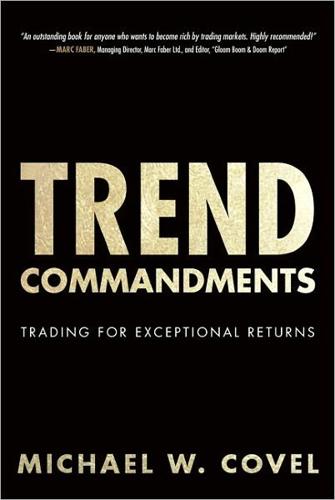
Trend Commandments: Trading for Exceptional Returns
by
Michael W. Covel
Published 14 Jun 2011
Do not strive for things occurring to occur as you wish, but wish the things occurring as they occur, and you will flow well.1 Ignition Trading for exceptional returns may not appear realistic in the schizophrenic cacophony: “What is the right approach for investors faced with an unusually uncertain economic outlook and volatile markets?” “Big concerns over job insecurity, consumer and corporate spending, and housing prices.” “Should you buy gold?” “Where are markets headed?” “Oil shock, dollar drop, Japanese earthquake, elections!” That’s white noise. Yes, sure, of course, you may have more options, but an explosion of naiveté has muddied the waters. Ignorance and confusion reign supreme. The idiot box is no longer just the bedroom flat screen. It is every PC, Mac, iPhone, and iPad.
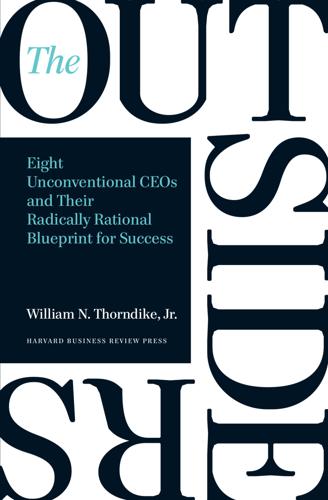
The Outsiders: Eight Unconventional CEOs and Their Radically Rational Blueprint for Success
by
William Thorndike
Published 14 Sep 2012
A Distant Mirror: 1974–1982 In assessing the current relevance of these outsider CEOs, it’s worth looking at how each navigated the post–World War II period that looks most like today’s extended economic malaise: the brutal 1974–1982 period. That period featured a toxic combination of an external oil shock, disastrous fiscal and monetary policy, and the worst domestic political scandal in the nation’s history. This cocktail of negative news produced an eight-year period that saw crippling inflation, two deep recessions (and bear markets), 18 percent interest rates, a threefold increase in oil prices, and the first resignation of a sitting US president in over one hundred years.
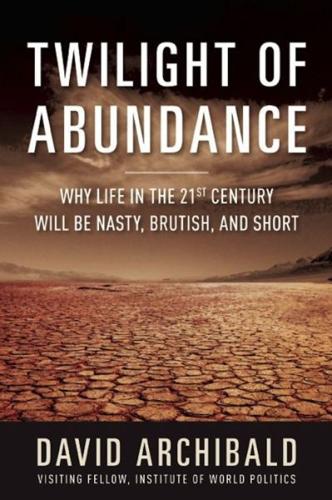
Twilight of Abundance: Why the 21st Century Will Be Nasty, Brutish, and Short
by
David Archibald
Published 24 Mar 2014
South Africa adopted CTL technology as a way of sidestepping the international oil embargo imposed on it because of apartheid. A similar technology has actually been operating in the United States since 1984. The Carter administration started building the Great Plains Synfuels Plant in Beulah, North Dakota, in response to the oil shock of 1980. Based, like so many Carter administration initiatives, on a flawed understanding of the world, it was begun with good intentions, but its results fell short of what they should have been. The Beulah plant could be making, and should be making, liquid fuels. Instead, it manufactures synthetic natural gas.
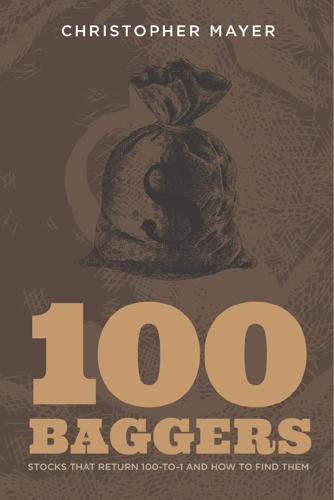
100 Baggers: Stocks That Return 100-To-1 and How to Find Them
by
Christopher W Mayer
Published 21 May 2018
In his 1994 shareholder letter, Buffett showed he had taken Graham’s lesson to heart: We will continue to ignore political and economic forecasts which are an expensive distraction for many investors and businessmen. Thirty years ago, no one could have foreseen the huge expansion of the Vietnam War, wage and price controls, two oil shocks, the resignation of a president, the dissolution of the Soviet Union, a one-day drop in the Dow of 508 points, or treasury bill yields fluctuating between 2.8% and 17.4%. . . . But, surprise—none of these blockbuster events made the slightest dent in Ben Graham’s investment principles. MISCELLANEOUS MENTATION ON 100-BAGGERS 1 45 I often hear sweeping pronouncements made about the stock market and where it’s going from pundits and investors everywhere, as I’m sure you do too.
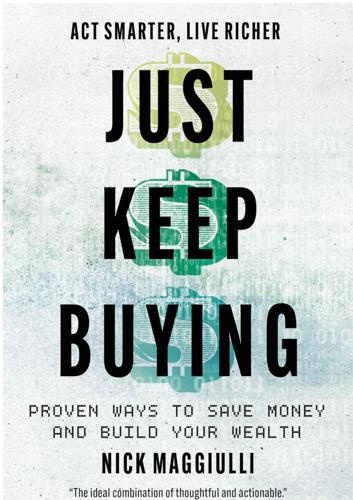
Just Keep Buying: Proven Ways to Save Money and Build Your Wealth
by
Nick Maggiulli
Published 15 May 2022
This is true despite the chaotic and sometimes destructive course of human history. As Warren Buffett so eloquently stated: “In the 20th century, the United States endured two world wars and other traumatic and expensive military conflicts; the Depression; a dozen or so recessions and financial panics; oil shocks; a flu epidemic; and the resignation of a disgraced president. Yet the Dow rose from 66 to 11,497.”⁸⁵ This logic doesn’t apply solely to U.S. markets either. As I illustrated at the beginning of chapter 11, equity markets across the world have exhibited a long-term positive trend. Given this empirical evidence, it suggests that you should invest your money as soon as possible.

The Rise and Fall of Nations: Forces of Change in the Post-Crisis World
by
Ruchir Sharma
Published 5 Jun 2016
The economic growth rate accelerated from less than 5 percent to double digits until the first oil price shock hit in 1974, and the military government—increasingly embattled by its violent crackdown on critics at home and abroad—tried to command a continued boom. It started borrowing heavily, piling up foreign debts it could no longer pay, when the second oil shock hit in 1979. The economy slid into recession and runaway inflation by the time the junta agreed to new elections in 1984. In some respects, the country never recovered from the meddling instincts of the later military government, and its per capita income relative to the United States is at the same level as it was in the 1970s.
…
Reid, Jim, Nick Burns, and Seb Barker, “Long-Term Asset Return Study: Bonds: The Final Bubble Frontier?” Deutsche Bank Markets Research Report, September 10, 2014. Schofield, Mark. “Challenging the Consensus on Inflation.” Citigroup Research, June 29, 2015. Scott, David. “Deflationary Boom—Some Random Thoughts and Questions.” Cha-am Advisors, March 2, 2015. Sharma, Ruchir. “The Oil Shock with No Pain.” Newsweek, October 31, 2005. ——. “Cracking Inflation Should Be India’s Priority.” Financial Times, December 8, 2013. Stephens, Bret. “Book Review: ‘The Myth of America’s Decline,’ by Josef Joffe.” Wall Street Journal, November 6, 2013. Ward, Justin. “Commodity Super Cycle Analysis.”
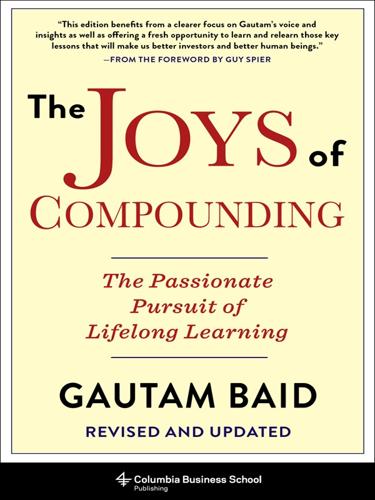
The Joys of Compounding: The Passionate Pursuit of Lifelong Learning, Revised and Updated
by
Gautam Baid
Published 1 Jun 2020
Investors should learn from Buffett’s thoughts on the critical importance of focusing on individual businesses and ignoring all of the noise around interest rate hikes, sharp spikes in inflation, stock market crashes, oil shocks, toppling of government regimes, recessions, depressions, and even full-blown wars. In his 1994 annual letter to shareholders, he wrote: We will continue to ignore political and economic forecasts, which are an expensive distraction for many investors and businessmen. Thirty years ago, no one could have foreseen the huge expansion of the Vietnam War, wage and price controls, two oil shocks, the resignation of a president, the dissolution of the Soviet Union, a one-day drop in the Dow of 508 points, or Treasury bill yields fluctuating between 2.8 percent and 17.4 percent.
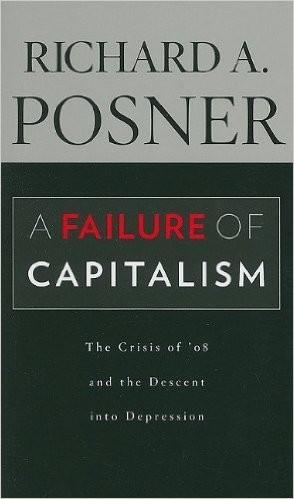
A Failure of Capitalism: The Crisis of '08 and the Descent Into Depression
by
Richard A. Posner
Published 30 Apr 2009
Doom" about a reputable academic economist, a professor at New York University named Nouriel Roubini, who for years had been predicting with uncanny accuracy what has now happened. The article reported that in September 2006—two years before the financial crisis but after the bursting of the housing bubble—Roubini had "announced that a crisis was brewing. In the coming months and years, he warned, the United States was likely to face a once-in-a-lifetime housing bust, an oil shock, sharply declining consumer confidence and, ultimately, a deep recession. He laid out a bleak sequence of events: homeowners defaulting on mortgages, trillions of dollars of mortgage-backed securities unraveling worldwide and the global financial system shuddering to a halt. These developments, he went on, could cripple or destroy hedge funds, investment banks and other major financial institutions like Fannie Mae and Freddie Mac."
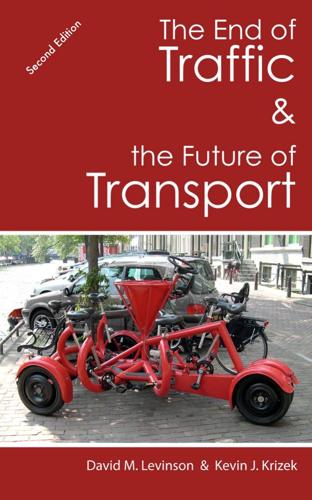
The End of Traffic and the Future of Transport: Second Edition
by
David Levinson
and
Kevin Krizek
Published 17 Aug 2015
Notably, conventional micro-transit typically focuses on work trips, while the newer MaaS systems are primarily for anything but commuting. Intercity trips have their own and separate dynamics.240 Vanpool. Micro-transit is a continuum from the automobile and MaaS. This is best illustrated at the most basic level, the vanpool, which gained popularity with the oil shocks of the 1970s. Ranging from a scaled-up carpool where riders chip in to pay the driver/owner who is also a commuter to systems that are organized collectively with professional drivers, vanpools have long served niche markets. They face the dilemma that passengers must forego any demand for schedule flexibility.
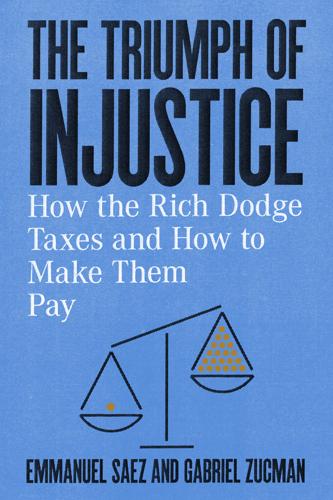
The Triumph of Injustice: How the Rich Dodge Taxes and How to Make Them Pay
by
Emmanuel Saez
and
Gabriel Zucman
Published 14 Oct 2019
In the 1950s and up to the late 1960s, with virtually no competition from Europe or Japan, US corporations were highly profitable. This started to change in 1969 and 1970, when the US economy entered a recession as the government increased taxes to close the budget deficits of the Vietnam War and the Federal Reserve tightened interest rates to fight inflation. The decline in profitability continued with the Oil Shock of 1973 which led to a severe recession and the large increase in interest rates during the 1970s. Because interest is tax deductible, high interest payments reduce the tax base and hence corporate tax revenue. These macroeconomic effects were followed, in the late 1970s and in the first half of the 1980s, by the birth of the corporate tax-dodging industry—at the same time the tax-sheltering industry swelled, and in the same ideological context.
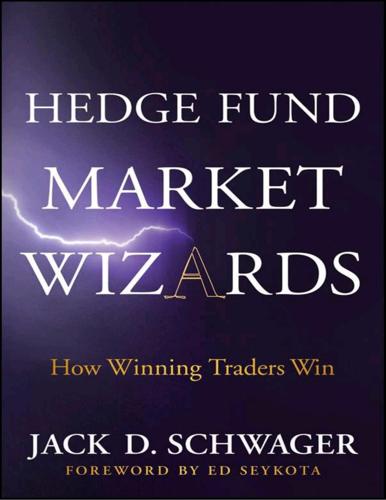
Hedge Fund Market Wizards
by
Jack D. Schwager
Published 24 Apr 2012
That same process continued and was improved with the help of many others over the years. Are the individual rules in the compendium of rules that make up the Bridgewater system sometimes revised or do they remain static through time? They are sometimes revised. For example, we used to look at how changes in the oil price affected countries. Between the first oil shock and the second oil shock in the 1970s, crude oil was discovered in the North Sea, and the U.K. went from being a net importer to a net exporter. That event prompted us to change how we configured the decision rule that related to oil prices so that when the mix of export and import items changed, the rule changed.
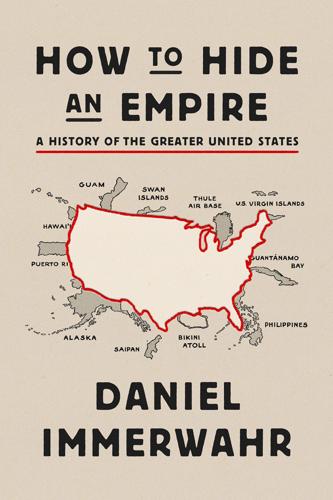
How to Hide an Empire: A History of the Greater United States
by
Daniel Immerwahr
Published 19 Feb 2019
Still, even when it comes to oil, flare-ups of naked imperialism have been rare and haven’t ultimately led to annexations. Kissinger’s idea of a U.S. overseas territory of Abu Dhabi was a daydream, not a plan (though it does appear that the Nixon administration was serious about seizing Middle Eastern oil fields if necessary). And, however painful the 1970s oil shock was for the U.S. economy, its danger was a matter of rising prices rather than of absolute, “we can’t fight a war” shortages. At no point in the twentieth century was there a serious possibility that oil would actually run out. Today, with new technologies enabling the exploitation of Canadian tar sands and the partial substitution of natural gas for oil, that danger seems as remote as ever
…
Sargent, A Superpower Transformed: The Remaking of American Foreign Relations in the 1970s (New York, 2015), 185. Nixon administration was serious: Lizette Alvarez, “Britain Says U.S. Planned to Seize Oil in ’73 Crisis,” NYT, January 2, 2004. matter of rising prices: A governmental investigation attributed the 1973–74 oil shock to panicked hoarding rather than inadequate supply. NSCC, Nation’s Resources, chap. 4. Also see Timothy Mitchell, Carbon Democracy: Political Power in the Age of Oil (London, 2011), chap. 7. The moon suits: NASA, “Space Suit Evolution: From Custom Tailored to Off-the-Rack,” 1994, history.nasa.gov/spacesuits.pdf.

Slouching Towards Utopia: An Economic History of the Twentieth Century
by
J. Bradford Delong
Published 6 Apr 2020
Workers had hesitated to demand wage increases in excess of productivity growth during booms when they had the market power to do so because they feared the consequences of being too expensive to their employers in the depressions to come. But what if there were no depressions to come? Then, after 1972, came the oil shocks. First, world oil prices tripled in response to the Yom Kippur War of 1973, and they tripled again in the wake of the Iranian Revolution of 1979, as the Organization of the Petroleum Exporting Countries (OPEC) realized how much market power it had. It is possible that the first tripling was a not regretted result of US foreign policy.
…
And with at least some closing of race, ethnic, and gender income gaps, white male earnings, especially for those of relatively low education, had to, on average, lag behind the lower-middle and working-class average of 0.5 to 1 percent per year. Inflation creating at least the appearance of great instability in incomes, oil shocks producing the first noticeable economic recessions since World War II, sociological turmoil and income stagnation—all of this makes some change likely. Still, the neoliberal turn, accomplished in little more than half a decade in the 1970s, was remarkably rapid. In the United States, the Vietnam War did not help.
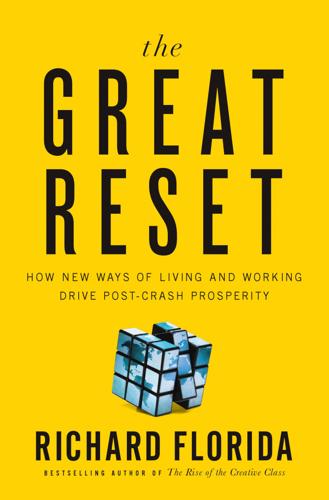
The Great Reset: How the Post-Crash Economy Will Change the Way We Live and Work
by
Richard Florida
Published 22 Apr 2010
.: Prince ton University Press, 2001); James Kunstler, The Long Emergency: Surviving the End of the Oil Age, Climate Change, and Other Converging Catastrophes (New York: Atlantic Monthly Press, 2005); Paul Roberts, The End of Oil: On the Edge of a Perilous New World (Boston: Houghton Mifflin, 2004); Michael Ruppert, Crossing the Rubicon: The Decline of the American Empire at the End of the Age of Oil (Gabriola Island, Canada: New Society Press, 2005); Matthew Simmons, Twilight in the Desert: The Coming Saudi Oil Shock and the World Economy (Hoboken, N.J.: Wiley & Sons, 2005); Christopher Steiner, $20 Per Gallon: How the Inevitable Rise in the Price of Gasoline Will Change Our Lives for the Better (New York: Grand Central Publishing, 2009); Jeff Rubin, Why Your World Is About to Get a Whole Lot Smaller: Oil and the End of Globalization (New York: Random House, 2009). 4.
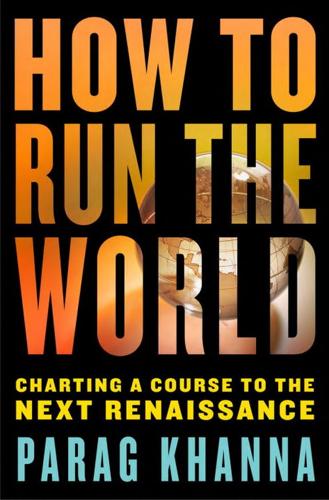
How to Run the World: Charting a Course to the Next Renaissance
by
Parag Khanna
Published 11 Jan 2011
As Robert Hormats, a veteran America Sherpa recently returned to the Obama administration, recalls, Sherpas think of themselves as “munchkins,” like the old but diminutive Wizard of Oz characters. So many young diplomats today want to become Sherpas—but first they have to do an apprenticeship as “yaks.” For Jay and his counterparts, being a Sherpa is the peak of professional achievement in diplomacy: “It’s a tough job, but huge fun!” Since the 1970s oil shocks, the Sherpa job has attracted some of the best troubleshooters from the world’s leading governments. For thirty-five years, their main job was to coordinate financial stability policies among the Group of Seven (G-7), which until recently was the exclusive club of the world’s leading industrial economies.* But in late 2008, their task was nothing less than saving the world from a looming depression.
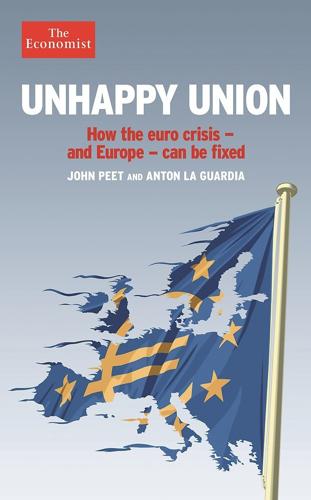
Unhappy Union: How the Euro Crisis - and Europe - Can Be Fixed
by
John Peet
,
Anton La Guardia
and
The Economist
Published 15 Feb 2014
Indeed, at a summit meeting of heads of government in Paris in December 1972, all nine national leaders, including the UK’s Edward Heath, signed up blithely not only to monetary union but also to political union by 1980. A last-minute attempt by the Danish prime minister to ask his colleagues exactly what was meant by political union was ignored by the French president, Georges Pompidou, who was in the chair.8 It was the final collapse of Bretton Woods, followed by the Arab-Israeli war and oil shock and then by the global recession of 1974–75, that upset most of these ambitious plans. Yet by then West Germany, always on the look-out for greater currency stability, had already set up a system linking most of Europe’s currencies to the Deutschmark, swiftly dubbed the “snake in the tunnel”. The idea was to set limits to bilateral currency fluctuations, enforced by central-bank intervention.
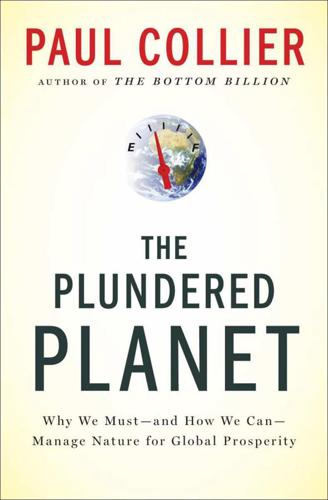
The Plundered Planet: Why We Must--And How We Can--Manage Nature for Global Prosperity
by
Paul Collier
Published 10 May 2010
The romantics prefer wind power, tidal power, and solar power, all of which are readily intelligible to ordinary citizens; nuclear power harnesses forces of nature only intelligible to a scientific elite. Unfortunately, however, wind, wave, and sun power are not yet scalable in the way that nuclear power is scalable. By far the most carbon-efficient advanced economy is France, which, following the oil shock of 1974, decided to achieve energy security by investing in nuclear power. France was able to do this because whereas elsewhere the political left was hostile to nuclear energy, in France it was nationalistic and so supported the idea of independence from imported oil. Wind, wave, and solar power may eventually become scalable (provided enough money is put into research), but for the moment pragmatists such as Stewart Brand, one of the pioneers of the environmental movement, have accepted that nuclear power is an essential part of the battle to contain global warming.
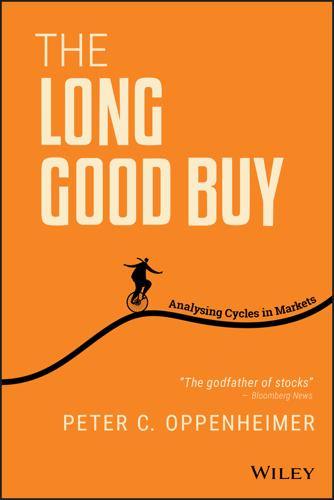
The Long Good Buy: Analysing Cycles in Markets
by
Peter Oppenheimer
Published 3 May 2020
Although the 1990s is often referred to as the period of the ‘Great Moderation’ because of its stable growth and low inflation, it came to an end largely as a result of the technology bubble in equity markets at the end of the century. But, since then, macro volatility has fallen again. Typical drivers of past recessions, such as industrial shocks, oil shocks and inflationary overheating, have become less of a threat since the financial crisis. Together with this, the current cycle looks likely to be even longer in the absence of significant rises in interest rates, financial bubbles or macro imbalances. Exhibit 9.13 Volatility of US GDP growth, inflation and unemployment rates has declined, especially since the 1980s (5-year rolling volatility) SOURCE: Goldman Sachs Global Investment Research.
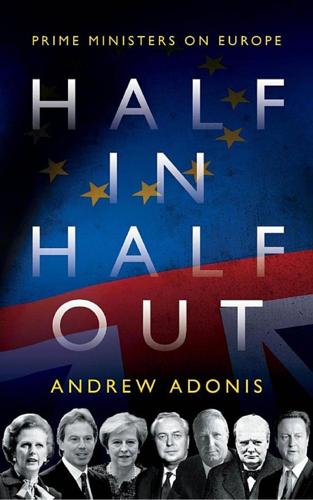
Half In, Half Out: Prime Ministers on Europe
by
Andrew Adonis
Published 20 Jun 2018
Ever the realist, Callaghan was now as anxious as Wilson for a resolution that kept Britain in Europe, paving the way for him to become Wilson’s successor with support of a unified Labour right wing. The ‘language of Chaucer’ became the language of barter, of which Callaghan was master. The new Chancellor of Germany, Helmut Schmidt, and President of France Giscard d’Estaing, both Anglophiles and English speakers, and desperate to avoid the collapse of the EEC in the midst of the ‘oil shock’ economic turbulence of the mid-1970s, obliged with the deals that Wilson and Callaghan sought on better access and lower consumer prices for Commonwealth meat, cheese and butter. This enabled them to proclaim a successful renegotiation. More importantly to Wilson the campaigner, it gave a strong line on cheaper food in the shops, which is why he put Commonwealth agricultural products, not arcane treaty changes or even the British contribution to the EU budget, at the centre of the renegotiation.

The Power Law: Venture Capital and the Making of the New Future
by
Sebastian Mallaby
Published 1 Feb 2022
Kleiner and Perkins set up shop in a new low-slung office park at 3000 Sand Hill Road, becoming the first partnership to occupy what was to be the epicenter of the venture industry.[53] Their timing was poor: they were launching their fund on the eve of the first oil shock, and their first few investments performed as poorly as the economy. They backed a plausible semiconductor startup, but it was run into the ground by inexperienced managers. They fell for an inauspiciously named contraption called the Snow-Job, which converted motorcycles into snowmobiles; Perkins fondly imagined Hells Angels and their biker girlfriends churning up snowfields. Unfortunately, the government responded to the oil shock by outlawing the sale of gasoline for sports vehicles, dooming the Snow-Job to bankruptcy.[54] By the end of 1974, Kleiner Perkins had shelled out $2.5 million for nine investments.

Challenger: A True Story of Heroism and Disaster on the Edge of Space
by
Adam Higginbotham
Published 14 May 2024
” * * * The delays and disappointments of Columbia’s stumbling path to orbit couldn’t have come at a worse moment for the shuttle, NASA, or the United States. The growing sense of crisis on President Carter’s watch had only escalated since the beginning of 1979, when the Islamic revolution in Iran had added a new oil shock and spiking gasoline prices to the already roiling inflation at home and political turmoil abroad. In March, the reactor meltdown in the nuclear plant at Three Mile Island in Pennsylvania added to Americans’ feeling that they were at the mercy of forces beyond their control, and their dwindling confidence in their nation’s ability to master technology with which it had once led the world.
…
W., 237, 260, 298, 305–6, 366, 370, 371 Butterworth, Bill, 209–11, 225–27 Butterworth, Jenny, 225 Cain, LeRoy, 448 CapCom (Capsule Communicator), 94, 116, 130, 138, 139, 151, 346, 352, 443 Cape Canaveral, 16, 53, 54, 155, 156, 189, 203, 211, 231–34, 243, 256, 257, 273, 284, 295, 299, 340, 347, 379, 390, 404, 426, 444 Astronaut Candidates at, 108 Challenger and, 143, 183–84, 227 STS-51-L mission, 238, 293, 294, 295, 304, 307, 308, 310, 323, 325, 330, 331, 340, 356, 360, 367 Columbia and, 113, 116, 118, 119, 127–30, 173 Launch Control Center at, 16, 129, 130, 183, 198, 200, 236, 289, 290, 292, 294 Challenger STS-51-L and, 299, 303, 304, 307, 308–10, 335, 337, 338, 341, 343, 344, 346–47, 350, 354, 356, 361, 363, 364 Nelson and, 276 solid rocket booster assembly at, 159, 162, 163, 166, 168–72 Vehicle Assembly Building at, 123, 159, 169, 170, 172, 247, 270, 286, 305, 306, 347, 399 weather at, 247, 303, 305, 307, 310–13 see also Kennedy Space Center Carbonated Beverage Dispenser Evaluation, 238 Carson, Johnny, 216–17, 243 Carter, Jimmy, 78, 94, 100–102, 119–21, 123, 124, 128 Iran hostage crisis and, 121, 128 Carter, Sonny, 340, 362, 427, 437, 439 CBS, 4, 28, 31–32, 317, 360 CBS Evening News, 13 Central Intelligence Agency (CIA), 44, 59 Cernan, Gene, 23, 27–28, 31–32, 66, 76, 229, 237 Cernan, Teresa Dawn, 28 Chaffee, Martha, 7, 8, 15–16, 22, 23 Chaffee, Roger, 7–8, 15–16 on Apollo 1 mission, 7–13, 15–21 death in, 7, 20–21, 22–27, 29, 30, 60, 94, 369, 377, 426 burial of, 23 Chaffee, Sheryl, 23 Chaffee, Stephen, 23 Chaikin, Andrew, 190 Challenger Center for Space Science Education, 443 Church of Latter Day Saints, 160, 247 CIA, 44, 59 Citizens in Space Task Force, 217–19 civil rights movement, 29, 30, 71, 74 Clear Lake, 63, 91, 94, 102, 111, 112, 115, 135, 145, 146, 148, 150, 215, 244, 274, 280, 370–71, 374, 379 Clear Lake High School, 145 Cleveland Call and Post, 74 clevis-and-tang joints, 163, 164, 166, 167, 170, 255, 381, 392 Clifford, Sophia, 230 Clinton, Bill, 456 CNN, 2, 343, 348, 352, 355, 360, 366, 385 Coast Guard, 400–402, 425 Cobb, Geraldyn “Jerrie,” 67–69, 71 Coca-Cola, 238 Cochran, Jacqueline, 67, 69 Cold War, 29, 32, 41, 43–44, 160, 231–32, 444 cold weather, 321 Challenger STS-51-L launch and, 337, 367, 368, 385, 386, 388, 389 booster rocket temperature, 337–38, 345 launchpad ice, 311, 325, 333–34, 337–41, 343, 345, 349 O-rings and, 253–57, 259, 262, 392, 393 Challenger STS-51-L disaster and, 349–51, 381, 384 Challenger STS-51-L launch concerns about, 297, 300–301, 303–7, 310–20, 321–32, 335–36, 430, 436 Discovery STS-51-C and, 247, 253–55, 303–4, 311, 313, 324, 329 Feynman’s ice water demonstration on, 393–94 Collins, Michael, 7, 22, 55, 90, 281–82 Collins, Pat, 281 Columbia Accident Investigation Board, 449 Concord High School, 223, 350 Concord Monitor, 221 Congress, 105, 115, 376, 380 Apollo program hearings of, 25–27 NASA budget cut by, 52, 53 Space Shuttle funding and, 57–58, 61 Congressional Committee on Science and Astronautics, 69 Constitution, US, 418 contingency abort, 155 Corlew, Johnny, 309, 310, 317, 339, 340 Corrigan, Ed and Grace, 222, 297, 299, 302, 342, 350, 354, 357, 358, 362, 375–76 Covey, Dick, 3, 103, 346 Crippen, Bob, 105, 116, 122, 123, 127, 129–39, 141, 151, 183, 236, 378, 399–402, 412, 420, 436, 444, 446 post-Challenger life of, 451 Crippen, Ginny, 225 Cronkite, Walter, 13, 219, 291 Culbertson, Frank, 286, 362 Cunningham, Stephen, 209–11 Daily Defender, 75 Dallas, 149 Dallas Morning News, 285 Dawber, Pam, 229 Defense Department, 44, 72 Discovery and, 244–45, 268 DeLorean, John, 282 Denver, John, 219 Devlin, Jim, 318–19 Devlin, John, 412–13, 418, 420 Dornberger, Walter, 40–42, 55 Dover Air Force Base, 428 Drake, Francis, 369–70 Dream Is Alive, The, 228 Dribin, Lee, 387 Dwight, Edward Joseph, 73–77 Dyna-Soar, 41–43, 60 Dyson, Freeman, 218 Easterbrook, Gregg, 122 Easter Island, 155 Ebeling, Bob, 272–73, 312–14, 347, 349, 350, 430, 432 post-Challenger life of, 451 Ebony, 83 Edwards Air Force Base, 47, 48, 50, 73, 74, 79, 80, 82, 184, 204, 376, 443 Columbia and, 138, 140, 142 Eglin Air Force Base, 401 Eisenhower, Dwight, 43 Elizabeth II, Queen, 23 Ellington Field, 93, 102, 145, 372, 375 Empire State Building, 374 Enterprise (originally Constitution), 62, 95–96 Equal Employment Opportunity Act, 65 Essence, 83 Ethiopia, 276–77 European Space Agency, 114, 232 F-1 engine, 159 Faget, Max, 11, 34–38, 42, 61, 156, 158 capsules designed by, 35–37, 43, 60 Columbia and, 130, 132, 134, 137, 138 family background and early life of, 35 Lee and, 56 in Space Shuttle design and development, 34, 37–38, 57, 60–62, 98, 130, 137, 447 Fairchild Industries, 158 Federal Aviation Administration (FAA), 248–49 Federal Bureau of Investigation (FBI), 282, 410, 434 Feynman, Richard, 391–92 cancer and death of, 391, 420, 449 engine presentation requested by, 421–22 on Rogers Commission, 382, 389, 391–94, 396, 408, 420–22, 433 Appendix F for, 433, 449–50 ice water demonstration in, 393–94 Fisher, Anna, 92, 93, 103, 117, 151, 213, 267 Fisher, Bill, 92 Fixed-Base Simulator, 109 Fixed Service Structure, 325 Fletcher, James, 32–33, 65, 95, 96, 431 Flight 981 crash, 249–50, 261 Flight Control Room, 1, 2, 137, 139, 140, 236, 345, 351, 371 Flight Dynamics Officer, 130–31, 139, 345–46, 351, 356 Flight Readiness Reviews, 175–79, 202–4, 207–8, 230, 251, 417 solid rocket boosters and, 178–79, 208, 254, 255, 257, 260 for Space Shuttle Challenger STS-51-L, 300–301, 303, 322–32, 393, 430 Florida Today, 212 Fonda, Jane, 231, 298 Ford, Gerald, 65, 78 Ford Foundation, 87 Fox, Michael J., 279 Frank, Richard, 101 Freedom of Information Act, 427 Freedom Star, 245, 319, 321 Frenchie’s, 280 Frosch, Robert, 100–101, 113, 115, 121, 123–24, 128, 218 Funk, Scott, 303 Fuqua, Don, 95, 298, 306 Gaddafi, Muammar, 374 Gagarin, Yuri, 9, 42–43, 71 Gallup poll, 55 Gardner, Dale, 151, 214, 215 Garn, Jake, 227, 298, 370 Garrison, Ed, 395 Gemini program, 8, 9, 11, 14, 15, 26, 33, 43, 46, 82, 104, 189, 281 unmanned tests in, 122 General Dynamics, 141, 282, 283 General Electric (GE), 14, 54, 168–69 Germany, 40–41, 158 Gibson, Robert “Hoot,” 148, 189, 190, 276, 284, 289 Gilruth, Robert, 37 Girl Scouts, 222, 224 Glenn, John, 9, 46, 70, 71, 76, 90, 147, 221, 243, 370 Graham, Bill, 283–84, 290, 291, 298, 301, 303, 304, 306, 360, 366–68, 370, 376, 380–82, 384–85, 387, 388, 391, 431 gravity, zero, 78, 110, 187, 275 Great Salt Lake, 160 Greene, Jay, 345–46, 351, 353, 355–56, 358 Gregory, Fred, 145, 152, 375, 415 Grissom, Betty, 436, 440 Grissom, Gus, 8 on Apollo 1 mission, 8–10, 12–21 death in, 20–21, 22–27, 29, 30, 60, 94, 369, 377, 426, 436 burial of, 23 Grissom, Mark, 10 Grumman Corporation, 52 Hall, Bruce, 317 Halley’s Comet, 277, 290, 293 Hardy, George, 159, 172, 173, 271, 315, 322, 323, 327, 330, 451 Harris, Hugh, 347, 349 Hart, Jane B., 68–69 Hartsfield, Henry “Hank,” 197–200, 416 Hauck, Rick, 108, 116, 148, 151, 212–15 Hawley, Steve, 148, 150 Heisig, Kurt, 185, 186, 191 Henize, Karl, 241–42 Hercules, Inc., 181 Hetzel Shoal, 411, 412, 415, 420 Hexagon, 59 “High Flight” (Magee), 281, 282, 366, 370 Hitler, Adolf, 40, 158 Hollings, Ernest, 434 Holz, Robert, 444 Homestead Air Force Base, 107 Houston, Cecil, 314–15, 321–22, 328, 331–32 Houston Chronicle, 112 Houston Post, 416 Howard, Jenny, 239–42, 261 Hubble Space Telescope, 290–91 Hughes Aircraft Company, 193–96, 209–11, 225–26, 275–76, 300, 337 Hughes Research Labs, 84, 88–89 Huntsville, AL, 53–54, 157, 159, 166, 171–73, 178, 179, 182, 208, 224, 272, 300, 378, 379, 381, 384, 387, 404, 417, 432 see also Marshall Space Flight Center Hurricane Alicia, 267 Husband, Rick, 446–48 Hutchinson, Neil, 130–32, 134 hydrogen, 96–98, 168, 333 hypersonic planes, 35, 42–46, 56, 81, 98 X-15, 45–46, 47–52, 101, 140 hypoxia, 236 Inconel X, 45 intercontinental ballistic missiles, 35–36, 41, 160 Titan, 41, 59, 161, 163, 164, 165, 204 International Space Station, 445, 449 Iran, 119, 121, 128 Jack and Jill of America, 146 Jarre, Jean-Michel, 278–79, 285, 452 Jarvis, Greg, 193–96, 209–11, 225–28, 275–77, 452 on Challenger mission, 277, 294, 295, 300, 302, 306, 316, 419 death in, 355, 368, 369, 373, 378, 384, 401, 437 experiments planned, 277, 285 on launch day, 337, 339, 340, 344 media junket for, 285 recovery of remains and burial, 419–20, 426–28, 435–36, 438 at Hughes, 193–96, 275–76, 300 Jarvis, Marcia, 194–96, 211, 225, 228, 294, 300, 302, 371, 420, 435, 441 post-Challenger life of, 452 Jet, 75, 83, 191 Jet Propulsion Laboratory (JPL), 392 Jetty Rats, 405, 414 John Paul II, Pope, 374 Johnson, Caldwell, 35 Johnson, Frank, 229–30 Johnson, Lyndon, 23, 24, 31, 52, 53, 68–69, 72, 141 Johnson Sea Link II, 403 Johnson Space Center (Manned Spacecraft Center), 53, 63, 101, 156, 211, 225, 226, 236, 242, 267, 268, 274, 278, 280, 284, 378 Apollo 1 fire and, 22 Columbia and, 115, 119, 128, 134, 135 Space Shuttle astronaut recruitment and, 78, 84, 91, 93, 103, 104, 111, 144–46, 148–50, 152, 154 Space Shuttle Challenger STS-51-L and, 301, 310, 331 memorial for astronauts lost in disaster, 376–77, 406 Space Shuttle development and, 34, 37, 56, 61 see also Mission Control Justice Department, 31 Kansas City Call, 73 Karman Line, 46, 132, 229 Keel, Alton, 398, 454 Kelly Air Force Base, 79 Kennedy, John F., 43, 160 assassination of, 76, 373 moon landing deadline of, 8, 9, 32, 52, 70 racial equality and, 71, 72, 74 Kennedy, Robert F., 29, 75 Kennedy Space Center, 174, 177, 209, 233, 254, 290, 394, 399, 416–17, 426 Challenger STS-51-L mission at, 295, 303, 304, 313, 321, 333, 335, 349, 361, 362, 370 Columbia missions at, 112, 113, 130, 291–93 construction of, 16–17 employee workloads at, 234 gift shop at, 299 solid rocket boosters and, 159 Kerwin, Joe, 426, 438–40 KH-11 Keyhole spy satellite, 136–37 Kilminster, Joe, 182, 320, 322, 324, 327–31, 395, 407, 432 King, Martin Luther, 29 Kingsbury, Jim, 317 Kitty Hawk, USS, 264 Kleinknecht, Kenny, 114–15, 119, 123 Knight, Pete, 48–50 Konrad, John, 209–11, 276 Kraft, Chris, 11, 64, 66, 83, 101, 115, 119, 130, 132, 137, 138, 151, 156, 212, 215, 226 Kranz, Gene, 64, 136–37 Krist, Ronald, 436, 441 Ku Klux Klan, 85, 147 Kutyna, Don, 382, 389, 394, 408, 409, 421, 433 Kuznetz, Larry, 112–15, 118, 123 Ladies’ Home Journal, 279 Lake City, SC, 84–85, 191–92 Langley Research Center, 35, 53, 154, 239 Launch Control Center, 16, 129, 130, 183, 198, 200, 236, 289, 290, 292, 294 Challenger STS-51-L and, 299, 303, 304, 307, 308–10, 335, 337, 338, 341, 343, 344, 346–47, 350, 354, 356, 361, 363, 364 Lawrence, Robert H., 77 Lee, Chester, 230 Lee, Dottie, 56, 60, 134–35, 137 LeMay, Curtis, 75 Liberty Star, 245, 318–19, 321 Life, 31, 46, 67, 291 Lincoln, Abraham, 376 Live Aid, 276 Lloyd’s of London, 214 Lockheed Corporation, 99–100, 114, 115, 233 Long, Linda, 304 Los Alamos National Laboratory, 54 Los Angeles Times, 79, 82 Love, Mike, 81 Lovelace, Randy, 66–68 Lovell, Jim, 266 Lovingood, Jud, 317, 322, 385–87 Lucas, Bill, 157–58, 176, 177, 179, 180, 291, 300, 317–18, 332, 335–36, 348, 386, 417–18, 432, 434 post-Challenger life of, 452–53 Lucid, Shannon, 93 Lucy, 411, 412, 424 Lund, Bob, 250–51, 261, 271–72, 313–15, 319, 320, 324, 326, 328–31, 394–96, 407, 408, 432, 451 Luz, 83 Magee, John Gillespie, Jr., 281–82, 366, 370 Magellan, Ferdinand, 38 Mailer, Norman, 218 Management Information Center (MIC), 246 Manned Maneuvering Unit, 110, 186, 188, 212, 213 Manned Orbiting Laboratory (MOL), 43–44, 48, 59, 77, 105, 114 Manned Spacecraft Center, see Johnson Space Center Maready, Bill, 307, 437 Maribelle’s, 111, 267 Mark, Hans, 206–7 Markey, Ed, 441–42 Mars, 29, 32, 54, 55, 157 Marshall Space Flight Center, 53, 62, 157, 202–3, 207, 240, 251, 260, 291, 417, 432 engine presentation for Feynman at, 421–22 Science and Engineering Directorate, 178-179 solid rocket booster project and O-ring concerns at, 143, 164, 166–68, 172, 173, 178–80, 182, 206, 253, 2525–56, 259, 262, 269, 271, 272, 311, 416, 423, 430 Space Shuttle Challenger STS-51-L and, 300, 301, 314–15, 317–18, 322–24, 327, 328, 330, 378, 384, 385, 387, 395, 403, 408 Space Shuttle design and, 158–59 Martin, Roy, 82, 93 Martin Marietta, 62, 117 Mason, Jerry, 319–20, 322, 327–30, 387, 390, 394–96, 398, 404, 406–8, 432 Mathematica Inc., 58 McAllister, Mike, 411–12 McAuliffe, Caroline, 223, 238, 274, 280, 282, 297, 308, 343 McAuliffe, Christa, 222–25, 280, 373 birth of, 222 on Challenger mission, 294, 295, 297, 302, 304–6, 316, 359, 449 death in, 355, 368, 369, 373–74, 378, 384, 401, 414 on launch day, 339, 340, 342–44, 348, 350 media and, 216–17, 236–38, 242–43, 274, 275, 279, 284–85, 294–96 personal items packed for, 282, 418 recovery of remains and burial, 419, 426–28, 435–36, 438 science demonstration plans, 275 Teacher in Space program, 219–22, 224–25, 228–30, 234–38, 268–69, 274–75, 279, 285, 291, 296, 298–99, 316, 344, 365, 434 training for, 274, 275, 279–80 early life of, 222 education of, 222–23 marriage of, 222, 223 parents of, 222, 297, 299, 302, 342, 350, 354, 357, 358, 362, 375–76 politics and, 279 Resnik and, 274–75, 339 Scobee and, 280 teaching career of, 217, 223–24, 237 Tonight Show appearance of, 216–17, 242–43, 279 McAuliffe, Scott, 223, 238, 280, 282, 297–98, 342 McAuliffe, Steven, 220–24, 228, 274, 280, 282, 297, 299, 302, 343, 371, 376, 418, 441 post-Challenger life of, 453 McCandless, Bruce, 187–90 McConnell, Malcolm, 232 McDonald, Allan, 179–83, 202–4, 207–9, 254, 255, 257, 259–62, 269–71, 273, 313–15, 322, 326–28, 330–31, 348, 349, 364, 378–79, 381, 383–84, 454 post-Challenger life of, 453–54 Rogers Commission testimony of, 387–90, 392, 395, 397–98, 404, 407, 430 Thiokol and, 432, 441–42 McDonald, Linda, 181 McDonnell Douglas DC-10, 248–49 Flight 981 crash and, 249–50, 261 McNair, Carl, 85–87, 192, 296, 342 McNair, Cheryl Moore, 87–89, 146, 296, 299, 306, 371, 375, 441 post-Challenger life of, 454 McNair, Eric, 342 McNair, Joy, 296, 343, 375, 376, 454 McNair, Mary, 296, 342 McNair, Reggie, 186, 296, 308, 343, 375, 454 McNair, Ron, 84–89, 111, 146, 151, 205, 209, 454 astronaut application of, 89 on Challenger STS-41-B mission, 185–88, 190–92, 276 on Challenger STS-51-L mission, 229, 268, 295, 296, 299, 306, 308, 418 death in, 355, 362, 368, 369, 373, 375, 378, 384, 401, 414 on launch day, 340, 344 media junket for, 285 recovery of remains and burial, 419, 426–28, 435–36, 438 saxophone playing plans, 278–79, 285, 286, 452 training for, 277, 279 in college, 86–87 early life of, 84–86 in high school, 85–86, 186, 191 hometown visited by, 191–92 at Hughes, 84, 88–89 as karate master, 86, 87, 186, 418 marriage of, 88 at MIT, 84, 87, 88, 191 as musician, 86, 185–87, 190–91, 278–79, 285, 286, 452 PhD research of, 88, 191 racism experienced by, 85, 87 McNamara, Robert, 43 medicine, 46 Meese, Ed, 450 Memorial Coliseum, 374 Mercury program, 9, 11, 12, 14, 15, 26, 33, 46, 67, 83, 114–15, 147, 154, 341 capsules in, 35–37, 46 Mercury Seven in, 65, 66, 102, 147, 266 unmanned tests in, 122 Merritt Island, 20, 23, 113, 184, 247, 293, 295–96, 302, 304, 306, 314, 315, 321, 340, 347, 370, 399, 429 Michener, James, 218, 267–68 Michoud Assembly Facility, 62 Mintier, Tom, 343, 352–53 missiles, 35–36, 41, 59, 62, 160, 403 Titan, 41, 59, 161, 163, 164, 165, 204 Mission Control, 53, 94, 112, 162–63, 187, 226, 239–42, 261, 350, 353, 358, 360, 419, 420 CapCom in, 94, 116, 130, 138, 139, 151, 346, 352, 443 Columbia and, 130–34, 136, 139 communications satellite and, 278 Discovery STS-51-C and, 244 Nesbitt as chief commentator for, 1–4 Mission Management Team, 303, 316, 341 Mission Specialists, 65, 66, 78–79, 89, 90, 92, 106, 229, 275, 277 Mission Watch, 298 MIT, 84, 87, 88, 191 Mobile Launcher Platform, 325, 337 Moeller, Walter H., 70 Mondale, Walter, 25 Montgomery, Mable, 191 Moody Air Force Base, 79 moon bases, 54–55, 57, 157 moon landing, 444 Apollo 11, 28–30, 38, 54, 55, 64, 112, 119, 121, 139, 156, 187, 194, 223, 243, 340 Kennedy’s deadline for, 8, 9, 32, 52, 70 risk assessment of, 168–69 Moore, Jesse, 269, 271, 276, 301, 303, 304, 341, 346, 348, 367–68, 377–78, 381, 385–87, 399, 409, 417, 431 Morgan, Barbara, 237, 274, 279, 280, 294, 298, 350, 354, 357, 449 Mork & Mindy, 229 Mormons, 160, 247 Morton Norwich Company, 161 Morton Thiokol, Inc., 161 see also Thiokol Chemical Corporation Moser, Tom, 115, 117, 119, 136, 211, 212, 214 Motion Base Simulator, 109 Mousetrap, 108 Mullane, Mike, 103, 200 Mulloy, Larry, 172, 206–9, 255, 256, 262, 269, 270, 291, 314, 317–18, 322–24, 326–28, 330–32, 335–36, 341, 348, 364, 430, 432, 434, 437 post-Challenger life of, 454–55 Rogers Commission testimony of, 387–89, 393, 394, 395, 397, 406, 407–9 Smith’s lawsuit against, 439–40 Murrow, Edward R., 71, 72, 75 Musgrave, Story, 241–42 NAACP (National Association for the Advancement of Colored People), 85, 174 NACA (National Advisory Committee for Aeronautics), 35, 37, 56 NASA (National Aeronautics and Space Administration), 119, 156–57, 290 bureaucracy in, 64, 154, 156, 167, 177, 325, 410, 446 centers of, 53 Challenger disaster investigation by, 368, 378–82 Challenger disaster statement of, 364–65, 367–68 creation of, 37, 43 criticism of, 25 funding for, 29, 32, 40, 52, 53, 156, 157, 159, 276 goals of, 43, 44, 52, 231 militarization of, 43–44, 231–32, 282–83 Rogers Commission and, 382, 383, 409, 410, 415–17, 429–31, 433, 434, 443–44 Smith’s lawsuit against, 439–40 in space race with Soviet Union, 8–9, 32, 42–43, 52, 83 National Academy of Sciences, 384 National Aeronautics and Space Act, 43 National Aeronautics and Space Council, 68, 72 National Enquirer, 376 National Geographic, 128, 218 National Institutes of Health, 89 National Oceanic and Atmospheric Administration (NOAA), 101, 232 National Reconnaissance Office (NRO), 59, 136 National Space Club, 242 National Transportation Safety Board, 401, 410, 424 Navy, US, 45, 100, 141, 400, 412, 425 Smith in, 263–67 Nazi Germany, 40–41, 158 NBC, 31–32, 360, 380 Nelson, Bill, 276–77, 284, 298, 374, 444 post-Challenger life of, 455 Nelson, George “Pinky,” 92, 130, 140, 316 Nesbitt, Steve, 1–4, 351, 354–58, 360, 371–72 post-Challenger life of, 455 Newsweek, 55, 141, 235, 279 New York Times, 51, 214, 377, 381, 385–87, 404 New York Times Magazine, 122, 279 New York Yacht Club, 219 Nichols, Nichelle, 84 9/11 attacks, 444 nitrogen, 12, 129 Nixon, Richard, 29, 31–33, 54, 55, 57–59, 62, 96, 104, 141, 298, 379, 382, 431 Noonan, Peggy, 366, 367 North American Aviation, 52 Apollo 1 and, 9–14, 17, 24, 26 X-15, 45–46, 47–52, 101, 140 North American Rockwell, 62, 440 see also Rockwell International North Carolina A&T State University, 86–87 nuclear weapons, 36, 41, 43, 160, 283 SALT and, 101–2 Nygren, Rick, 362 Oakbrook, TX, 102 Obama, Barack, 451 Office of Management and Budget, 58, 102 O’Hara, Eileen, 316 oil shocks and gasoline prices, 119, 120 Onizuka, Claude, 334–35 Onizuka, Darien, 245, 455 Onizuka, Ellison, 82–83, 145, 455–56 astronaut application of, 83, 92–93 on Challenger mission, 229, 268, 295, 296, 316, 418 death in, 355, 368, 369, 373, 378, 384, 401, 414, 439 on launch day, 334–35, 339, 344, 348 media junket for, 285 recovery of remains and burial, 419, 426–28, 435–36, 438 training for, 277 Columbia and, 116, 129–30 on Discovery STS-51-C mission, 244–45, 247, 253–55, 268, 303–4 early life of, 82–83 family background of, 82 Onizuka, Janelle, 245, 418, 455 Onizuka, Lorna, 82, 83, 92–93, 145, 244, 245, 343, 361, 371, 414, 441 post-Challenger life of, 455 Operation Paperclip, 40–41 Orbital Maneuvering System, 134, 137 Orbiter Processing Facility, 112, 114, 115, 118, 123, 233 Order of the Palmetto, 191 Oregon Trail, 376 O-rings, 164–73 “Apocalypse” letter about, 417–18, 457 cold temperatures and, 253–57, 259, 262, 392, 393 Challenger STS-51-L disaster and, 349–51, 381, 384 Challenger STS-51-L launch concerns about, 297, 300–301, 303–7, 310–20, 321–32, 335–36, 430, 436 Discovery STS-51-C and, 247, 253–55, 303–4, 311, 313, 324, 329 Feynman’s ice water demonstration on, 393–94 damage found in, 143, 166–68, 170, 171, 173, 204–9, 385–86, 416, 417, 430, 433 as acceptable risk, 208, 256, 270, 393 anomaly team investigation of, 259 Boisjoly’s concerns about, 251–62, 271–72, 311–13, 319, 323–29, 331, 408, 430 on Challenger STS-51-B, 258 on Columbia, 143, 170, 171, 173 escalation of, 323 Feynman’s study of, 392, 421 Hardy and, 271 McDonald and, 270 as self-limiting, 206, 208 manufacturing process for, 169–70 secondary, 164, 169, 172, 206–8, 252, 253, 258–60, 270, 323, 329, 350, 386 squeeze in, 164, 166, 255, 257, 323 tests of, 166–68, 171–72, 205–6, 256–57, 259 Orlando Sentinel, 305 O’Shaughnessy, Tam, 456 Outpost Tavern, 111, 267 Overmyer, Bob, 114 oxygen, 129, 168, 236, 292, 333, 338 in Apollo 1 cockpit, 12–14, 17, 19, 24 in shuttle engines, 96–98 Paige, Hilliard, 14 Paine, Thomas, 30–31, 54–55, 57, 169 Pan Am, 223 Parker Seal Company, 167, 179 Patrick Air Force Base, 302, 426 Paul VI, Pope, 23 payload specialists, 193, 209, 225–27, 276 People, 216, 279 Pepsi, 238 Personal Egress Air Packs, 438–39 Pe-Te’s Cajun BBQ House, 111 Petrone, Rocco, 340, 341 Pipeline computer program, 115, 118 Poindexter, John, 381 Point Roberts, 400 Port Canaveral, 400, 401, 403, 405, 414, 418, 420, 426 Preserver, 412–14, 418–20 Press, Frank, 101 Promontory plant, 160–62, 165, 167, 171, 180, 207, 246, 247, 250, 252, 256, 315, 319, 331, 359, 405, 432, 441 see also Wasatch plant proximity operations, 211–13 Purdue University, 239 Quiñones, John, 317 Ragland, Dayton “Rags,” 73 Rather, Dan, 4, 317, 339, 360 RCA, 90 Reader’s Digest, 42, 232 Reagan, Nancy, 142–43, 344, 376 Reagan, Ronald, 79, 128, 140–43, 204, 214, 218, 231, 247, 267–68, 279, 282, 283, 380, 410, 445 assassination attempt on, 4 Challenger disaster and, 359, 365–66, 368–70, 376, 377 Rogers Commission and, 380–83, 398, 429 State of the Union addresses of, 343–44, 365, 366, 369, 434 Teacher in Space program and, 220–21, 344, 369, 434 reconnaissance missions, 43–44, 101–2 Redstone Arsenal, 53, 157, 300 Reedy, George, 72 Regan, Donald, 380–81 Reinartz, Stan, 317–18, 322, 331–32, 335, 341, 397 Remote Manipulator System (robot arm), 110, 116, 149–51, 188, 277 Resnik, Charles, 89 Resnik, Judy, 89–90, 111, 147–52, 209, 236, 280, 286, 416 amateur astronauts as viewed by, 274–75 astronaut application and acceptance of, 89–93 astronaut training of, 102 on Challenger mission, 229, 268, 274, 295, 299–300, 316, 419 death in, 355, 368, 369, 373, 378, 384, 401, 414, 439, 441 on launch day, 339, 344, 350, 351 media junket for, 285–86 recovery of remains and burial, 419, 426–28, 435–36, 438 training for, 277 Columbia and, 116, 129 Culbertson and, 286, 362 on Discovery mission, 196–201, 207, 221 early life of, 89 education of, 89–90 “J.R.” nickname of, 149 McAuliffe and, 274–75, 339 robot arm operations of, 116, 149–51, 277 Resnik, Marvin, 299–300, 350, 371, 414, 435 post-Challenger life of, 456 Ride, Sally, 93, 107, 147, 148, 150, 151, 153, 174, 221, 231 media attention to, 153 post-Challenger life of, 456 robot arm operations of, 150, 151 on Rogers Commission, 382, 398, 408, 436 Right Stuff, The (Wolfe), 74 Riley, Dick, 191 robot arm, 110, 116, 149–51, 188, 277 Rocketdyne, 52, 62, 97, 98, 240 rocket engines, 38–39, 54, 96–98, 134, 157–58 F-1, 159 liquid-fueled, 61–62 solid, 61–62 see also Space Shuttle solid rocket boosters rocket planes, 81 X-15, 45–46, 47–52, 101, 140 rocket-powered escape systems, 60 Rocket Propulsion Test Complex, 98 rockets, 36, 53, 58, 232 Saturn, 9, 18, 39, 40, 58 V-2, 40, 41 Rockwell International, 62, 95, 108, 113, 114, 119, 129, 135, 217, 248–50, 310 Challenger launch and, 334, 337, 338, 340–42, 381, 406 Rodgers, Don, 456 Rogers, William, 382, 383, 385–90, 393–99, 404, 406, 407, 409–10, 429–31, 433–34, 436, 453 Rogers Commission, 384–90, 391–99, 404–10, 391–99, 404–10, 416–17, 420–22, 453, 454 Boisjoly’s testimony to, 395, 396, 398, 404, 408, 430 Thiokol and, 432, 441–42 creation of, 380–83 criminal prosecution and, 434 Feynman on, 382, 389, 391–94, 396, 408, 420–22, 433 Appendix F for, 433, 449–50 ice water demonstration in, 393–94 launch decision examined by, 385–89, 395–99, 404, 406–10, 420, 430 McDonald’s testimony to, 387–90, 392, 395, 397–98, 404, 407, 430 Thiokol and, 432, 441–42 Mulloy’s testimony to, 387–89, 393, 394, 395, 397, 406, 407–9 NASA and, 382, 383, 409, 410, 415–17, 429–31, 433, 434, 443–44 press and, 404, 406 Reagan and, 380–83, 398, 429 report of, 382, 429–37, 443 astronauts’ families and, 436–37 concluding statement of, 431, 433 recommendations in, 431 specialized teams on, 420–21 Thiokol and, 385, 387–90, 394–98, 404–9 Rogers Dry Lake, 81 Rotating Service Structure, 304, 305 Royal Navy, 143 Rumsfeld, Donald, 25 Russell, Brian, 319, 322–24, 359, 432 Russia, 445 Sacramento Bee, 51 Safire, William, 33 Sakata, Norman, 83, 335 Salinas, Sylvia, 149, 197, 286, 316 SALT (Strategic Arms Limitation Talks), 101–2 Salt Lake City, UT, 169 Salyut 5, 78 San Francisco Examiner, 120 Sänger, Eugen, 40, 41 satellites, 42, 161, 194–96, 209, 434 communications, 278, 290 European Space Agency, 232 lost, 187 recovery of, 211–15 Space Shuttle and, 186, 187, 211–15, 225, 226, 232, 276–78, 290, 445 Sputnik, 41 spy, 43–44, 59, 446 Tracking and Data Relay, 277–78 Saturn V, 159 Saturn rockets, 9, 18, 39, 40, 58 Schmitt, Harrison “Jack,” 28 Scientific American, 87 Scobee, Dick, 79–82, 103, 108, 145–46, 206, 209, 280–81 astronaut application and acceptance of, 82, 93 astronaut training of, 102 on Challenger STS-41-C mission, 183–84 on Challenger STS-51-L mission, 229, 268, 274, 280–81, 293, 295, 299, 306, 310, 316–17, 418 death in, 355, 362, 363, 368, 369, 373, 375, 378, 384, 401, 406, 414–15 in launch, 350–52 on launch day, 334, 336, 338–39, 344, 345, 348, 349 media junket for, 284, 286 recovery of remains and burial, 419, 426–28, 435–36, 438 training for, 277 Columbia and, 116, 129, 130 McAuliffe and, 280 Scobee, June, 79–81, 102, 103, 145–46, 280, 286, 294, 299, 302, 316, 361, 363, 371, 374–76, 406, 414–15, 435–37, 441, 443 post-Challenger life of, 456 Scobee, Kathie, 80, 102, 184, 280 Scobee, Rich, 80–81, 102, 145, 184, 299, 436 post-Challenger life of, 456 Scott, Walter, 85 Scott-Heron, Gil, 31 Second World War, 40, 67, 281, 295 Seddon, Rhea, 93, 147, 148 Columbia and, 116 training of, 105–7 Senate and House Committee on Space, 68 Sepia, 75 Shea, Joe, 10, 11, 13–14, 17, 23–24, 27 Shepard, Alan, 10, 46, 53, 68, 217, 222 Sherr, Lynn, 213 Shuttle Landing Facility, 295, 300 Shuttle Training Aircraft, 277, 306, 338 Sieck, Bob, 303, 355 Silbervogel, 40, 41 Skylab, 103, 119–20 slavery, 191 Slayton, Deke, 22, 65–66, 76, 229, 243 Smith, Alison, 263, 265–69, 308, 309, 335, 343, 350, 354, 356–57, 361–63, 370–72, 406, 435, 457 Smith, Erin, 266, 308, 350, 361, 372, 435 Smith, Jane Jarrell, 264, 265, 268, 302, 316, 343, 350, 356, 363, 371, 372, 375, 406, 414, 427, 435, 437, 439 lawsuits filed by, 439–41 post-Challenger life of, 457 Smith, Mike, 263–69, 427, 457 Abbey and, 267–68 on Challenger mission, 229, 268–69, 295, 297, 302, 305–7, 308, 315–16, 419 death in, 355, 361–63, 368, 369, 373, 375, 378, 384, 401, 414, 438–40 on launch day, 335, 339, 344, 348, 350, 352 media junket for, 286 recovery of remains and burial, 419, 426–28, 435–36, 438 training for, 277 early life of, 263–64 marriage of, 264 NASA joined by, 266 Navy career of, 263–67 Smith, Scott, 263, 264, 266, 267, 308, 343, 350, 356, 372, 435, 457 Soviet space program, 8–9, 32, 41–43, 52, 83, 290, 369 Buran, 102 female cosmonauts in, 66, 69, 70 Gagarin in, 9, 42–43, 71 Salyut 5, 78 Sputnik, 41 Vostok 1, 43 Vostok 6, 70 Soviet Union, 41, 42, 402, 444 Challenger disaster and, 374 Cold War with, 29, 32, 41, 43–44, 160, 231–32, 444 nuclear arms of, 101–2, 160 reconnaissance satellites and, 44, 59 Space Shuttle and, 60 Strategic Defense Initiative (Star Wars program) and, 232, 282 Space and Naval Medicine Congress, 67 Space Camp, 224 Space Communications Group, 193 Space Flight Participant Program, 217–20, 235, 243, 274–75, 291, 445 Teacher in Space, 219–22, 224–25, 228–30, 234–38, 260, 268–69, 274–75, 279, 285, 291, 296, 298–99, 316, 344, 365, 369, 434 space flight simulation facilities, 443 spaceplanes, 38, 40, 81, 98 Dyna-Soar, 41–43, 60 X-15, 45–46, 47–52, 101, 140 Space Shuttle “anomalies” in, 176, 177, 203, 208 cockpit of, 109 computers of, 131, 137–40, 155, 162–63, 241, 242, 292 cross-range ability of, 59–60 design and development of, 33, 37–38, 55–62, 81, 94, 96–100, 107 Faget’s work in, 34, 37–38, 57, 60–62, 98, 130, 137, 447 engines of, 96–98, 123, 134, 154–55, 240–42, 260–61, 364 Feynman and, 421–22 Enterprise (originally Constitution) test vehicle, 62, 95–96 heat-insulating tiles on, 98–100, 113–15, 117–19, 121–23, 129, 133–38, 141, 226, 227, 334, 411, 446 lack of crew escape system on, 154, 164 Main Propulsion System of, 239 mission simulators, 109–10, 117 post-flight examinations of, 233 safety concerns about, 154–55 solid rocket boosters of, see Space Shuttle solid rocket boosters spare parts for, 233 toilets on, 78, 275 Space Shuttle astronauts African American, 64–66, 71–77, 78, 79, 83–84, 92, 93, 144–46, 151–53, 174, 191 civilian, 216–19, 285, 365, 369, 370 Hughes Aircraft employees, 193–96, 209–11, 225–26, 275–76 journalists, 291, 445 politicians, 227, 275–77, 284 Space Flight Participant Program, 217–20, 235, 243, 274–75, 291, 445 Teacher in Space program, 219–22, 224–25, 228–30, 234–38, 260, 268–69, 274–75, 279, 285, 291, 296, 298–99, 316, 344, 365, 369, 434 first group of, 144–48, 236 as Astronaut Candidates, 102–11, 115–16, 150 competition and jealousy among, 152, 153 flight assignments of, 144, 148, 150–54 recruitment of, 62, 63–79, 82–84, 89–94, 154 Red and Blue teams of, 108, 116, 148 relationships among, 144–46, 148 “TFNGs” acronym for, 94 training of, 94, 102, 105–11, 115–16, 144 female, 64–71, 76, 78, 79, 83–84, 90, 92, 93, 107, 144, 150–53, 174, 200, 221, 231 Mission Specialists, 65, 66, 78–79, 89, 90, 92, 106, 229, 275, 277 payload specialists, 193, 209, 225–27, 276 Space Shuttle Atlantis, 232–33, 449 Space Shuttle Challenger, 143, 174, 210, 227, 232, 234, 256 burned rocket nozzles in, 175, 179, 182 on launchpad, diagram of, 458 space walks from, 174, 186, 188–90, 277 STS-7 mission, 151, 153 STS-8 mission, 144, 151, 153, 174–75 STS-41-B mission, 185–92, 276 STS-41-C mission, 183–84 STS-51-B mission, 258 Space Shuttle Challenger STS-51-F aborted launch of, 236, 238, 261, 269 beverage dispenser on, 238 launch of, 238–42, 261 Space Shuttle Challenger STS-51-L, 229, 284, 286, 293–301 astronauts on, see Jarvis, Greg; McAuliffe, Christa; McNair, Ron; Onizuka, Ellison; Resnik, Judy; Scobee, Dick; Smith, Mike at Kennedy Space Center, 295, 303, 304, 313, 321, 333, 335, 349, 361, 362 launch of, 1, 3 booster rocket temperature in, 337–38, 345 cold weather and O-ring concerns about, 297, 300–301, 303–7, 310–20, 321–32, 335–36, 430 cold weather during, 337, 367, 368, 385, 386, 388, 389 countdown to, 307, 308, 317, 334, 341–44, 346–49 date for, 293, 294, 296–97, 300, 301, 303–6 day of, 333–53 door latch problem and, 309–10, 316, 317 dress rehearsal for, 293 final decisions for, 329–32, 341–42, 346, 368, 399, 408, 409 launchpad ice and, 311, 325, 333–34, 337–41, 343, 345, 349 liftoff and ascent, 349–52, 354–55, 357, 360 prelaunch party, 302 readiness reviews for, 300–301, 303, 322–32, 393, 430 recovery ships and, 318–19, 321, 331–32, 341 rumors about White House pressure for, 434 signed recommendation for, 329–32, 336, 395 solid rocket boosters in, 337–38, 345, 348, 364, 429–30 spectators at, 296–98, 305–6, 308, 342 televising of, 347, 348, 351–53, 373 Thiokol debate on, 311–15, 317–20, 322–32, 335–36, 347, 348, 350, 386, 388, 389, 395–98, 404–9, 430, 432, 437 media and, 284–86, 295–96, 317, 342, 343, 348, 354 night viewing of, 302 solid rocket boosters on, 337–38, 345, 348, 364, 425 disaster investigation and, 378–81, 384, 422–23, 429–30 recovery of debris from, 402, 403 temperature readings of, 337–38, 345 Teacher in Space program for, 219–22, 224–25, 228–30, 234–38, 260, 268–69, 274–75, 279, 285, 291, 296, 298–99, 316, 344, 365, 434 Space Shuttle Challenger STS-51-L disaster, 3–4, 352–53, 354–72, 409, 444, 446, 449 families of astronauts lost in, 354, 356–57, 361–63, 365, 366, 370–72, 374–76, 378, 401, 405–6, 443 financial settlements for, 436, 437, 440–41 Rogers Commission report and, 436–37 wreckage recovery and, 414–15, 426–28 final moments in, 427, 438–40 investigation of, 365 boosters and O-rings pinpointed in, 378–81, 384 by NASA, 368, 378–82 by Rogers Commission, see Rogers Commission media coverage of, 354–55, 357, 359–61, 364–65, 367–68, 372, 374–77, 379–81, 383, 385–88, 402, 405 memorials for astronauts lost in, 376–77, 406, 443 as mystery, 377 NASA statement on, 364–65, 367–68 national bereavement and tributes following, 371–72, 373–74, 376–77 O-rings in, 349–51 Reagan’s statements on, 359, 365–66, 368–70, 376, 377 recovery of wreckage from, 378, 399–405, 423–25, 429 booster rocket, 422–23 burial of, 444 computers, 419 cost and scope of operations, 425 crew cabin, 411–15, 418–20, 437–39 Personal Egress Air Packs, 438–39 personal items, 418–19 tape recorders, 419, 437–38, 440 spectators and, 354–55, 357, 370 video footage of, 363–64, 378–79, 381, 382 Space Shuttle Columbia, 112–24, 173, 198, 232 computers of, 131, 137–40 construction of, 96, 108, 112–19, 121–24 ejection seats on, 154 engines of, 134 heat-insulating tiles on, 113–15, 117–19, 121–23, 129, 133–38, 141, 411, 446 heat shield damage on, 133–37 at Kennedy Space Center, 112, 113 lack of unmanned test flights for, 122, 124 launch of, 1, 104–5, 123–24, 127–33, 167 O-ring damage on, 143 reentry of, 136–40 rocket boosters of, 132–33, 143 satellite images of, 136–37 STS-1 mission, 128–43, 410, 446 STS-2 mission, 143, 170, 173 STS-5 mission, 173 STS-9 mission, 151 STS-61-C mission, 276–77, 289–94 STS-107 mission, 445–47 disaster, 447–48, 449 Space Shuttle Discovery, 226, 232–34, 246, 256, 268, 370, 443, 444 cold weather and, 247, 255 STS-41-D mission, 196–201, 202, 207, 221 STS-51-A mission, 211–15 STS-51-C mission, 244–45, 247, 253–55, 268, 303–4, 311, 313, 324, 329 Space Shuttle program, 119, 415, 431, 444, 449 “acceptable risk” assessments in, 175–78, 208, 256, 270, 393 Challenger disaster and, 369, 382, 384 contingency plan for handling news of accidents in, 364–65 cost effectiveness of, 58–59, 141, 232 costs of and funding for, 57–58, 61, 100–102, 113, 122, 142, 232 crossroads of, 232 delays in, 96, 113–15, 119, 121–23, 127–29, 201, 226–27, 232, 234, 417 first fatalities in, 129 flight designation system in, 183 Flight Readiness Reviews in, see Flight Readiness Reviews flight test program condensed in, 142 Hubble Space Telescope and, 290–91 launch schedules in, 153, 174, 201, 204, 226–27, 232–34, 253, 254, 256, 257, 259, 272, 290, 293, 328, 431 media and, 121–22, 128, 141, 214, 234, 236, 417 military payloads in, 244–45, 268, 290, 445 number of orbiters in, 62, 96, 102, 142, 154 operational flights begun in, 142, 153, 156, 172, 173, 204, 218 Remote Manipulator System in, 110, 116, 149–51 risk assessment of, 168, 169 Rogers Commission recommendations for, 431 satellite projects in, 186, 187, 211–15, 225, 226, 232, 276–78, 290, 445 Skylab and, 120 space walks in, 174, 186, 188–90, 214, 277 Space Shuttle solid rocket boosters, 61–62, 122, 132–33, 143, 155, 158–73, 175, 178, 182, 202–9, 230, 240, 260–61 assumptions and failures in program for, 396 Booster Systems Engineer and, 239–40 on Challenger STS-51-L, 337–38, 345, 348, 364, 425 disaster investigation and, 378–81, 384, 422–23, 429–30 recovery of debris from, 402, 403 temperature readings of, 337–38, 345 diagram of, 457 on Discovery STS-41-D, 199, 202, 207 estimates of failure in, 421, 422 Flight Readiness Reviews and, 178–79, 208, 254, 255, 257, 260 joints in, 163–73, 179, 205–7, 252–53, 255, 256, 258–62, 269, 270–72, 396 as Criticality 1 items, 207, 270 problems accepted as normal in, 208–9, 256 putty in, 164, 170, 172, 204, 205, 207, 252, 254, 257, 392, 204, 205, 207, 252, 254, 392 redesign of, 431 see also O-rings McDonald’s presentation on, 269–71 nozzles in, 175, 179, 182, 204, 258, 270 redesign of, 441–43 refurbishing of, 246 retrieval and postflight inspections of, 245–46, 252, 257–58 Challenger STS-51-L and, 318–19, 321, 331–32, 341 stacking process for, 170, 172, 204, 384 test firing of, 165–66 Thiokol’s contract for, 62, 328, 430, 441 competing bid possibility and, 181–82, 203, 204 see also Thiokol Chemical Corporation space stations, 54–55, 57, 231 International Space Station, 445, 449 Salyut 5, 78 Space Transportation System, 33, 55, 57, 62, 96, 341, 385, 449 see also Space Shuttle program space walks, 174, 186, 188–90, 214, 277 Springer, Bob, 266, 268 Sputnik, 41 spy satellites and missions, 43–44, 101–2, 136–37, 446 Stalin, Vasily, 41 Stallone, Sylvester, 279 Star Trek, 84, 95, 209 Star Wars program (Strategic Defense Initiative), 232, 282 State Department, 71 Stevenson, Charlie, 333–34, 337–38, 344, 345 Stewart, Bob, 187, 189–90 Stinger, 212–14 Strategic Defense Initiative (Star Wars program), 232, 282 Sullivan, Kathy, 93 Sununu, John, 298, 305 Super Bowl, 297, 306 Surely You’re Joking Mr.

Birth of the Euro
by
Otmar Issing
Published 20 Oct 2008
Compulsory interventions were correspondingly tied not to the ECU, that is, to a currency basket, but to the parity grid. It soon became apparent that the EMS was a system founded on the strongest currency; in short, it was a ‘DM bloc’. In the wake of the strong price pressures exerted by the second oil shock in 1979/80, the consequences of this currency system quickly came to light. The Deutsche Bundesbank fought against the inflation risks with a clear, stability-oriented monetary policy, thereby sparing Germany a repetition of the sequence of inflation and stagflation that had marked the period after the first oil price shock in the 1970s.
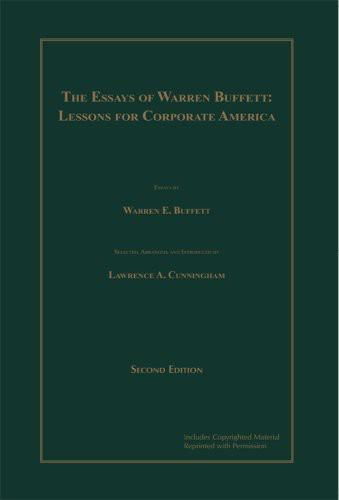
The Essays of Warren Buffett: Lessons for Corporate America
by
Warren E. Buffett
and
Lawrence A. Cunningham
Published 2 Jan 1997
Charlie and I agree and will try to wait for opportunities that are well within our own "happy zone." We will continue to ignore political and economic forecasts, which are an expensive distraction for many investors and businessmen. Thirty years ago, no one could have foreseen the huge expansion of the Vietnam War, wage and price controls, two oil shocks, the resignation of a president, the dissolution of the Soviet Union, a one-day drop in the Dow of 508 points, or treasury bill yields fluctuating between 2.8% and 17.4%. But, surprise-none of these blockbuster events made the slightest dent in Ben Graham's investment principles. Nor did they render unsound the negotiated purchases of fine businesses at sensible prices.
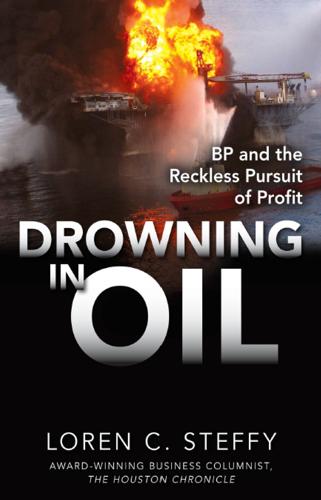
Drowning in Oil: BP & the Reckless Pursuit of Profit
by
Loren C. Steffy
Published 5 Nov 2010
College Station: Texas A&M University Press, 2007. The Report of the BP U.S. Refineries Independent Safety Review Panel, January 2007. Sampson, Anthony. The Seven Sisters: The Great Oil Companies and the World They Shaped. New York: Bantam Books, 1991. Simmons, Matthew R. Twilight in the Desert: The Coming Saudi Oil Shock and the World Economy. Hoboken, N.J.: John Wiley & Sons, 2005. Solomon, Charlene M., and Michael S. Schell. Managing across Cultures: The Seven Keys to Doing Business with a Global Mindset. New York: McGraw-Hill, 2009. Tarbell, Ida M. The History of the Standard Oil Company. Edited by David M. Chambers.

The Locavore's Dilemma
by
Pierre Desrochers
and
Hiroko Shimizu
Published 29 May 2012
There are management problems, transparency and corruption issues no matter who funds the start-up.”14 Similar problems have also been observed in the strategic grain reserves set up throughout Africa under the aegis of the Food and Agricultural Organization of the United Nations (FAO) after the first oil shock of the 1970s.15 As the geographer Evan Fraser and the journalist Andrew Rimas—two analysts not exactly friendly to market solutions—observed, the “seemingly limitless hoard” in silos proved “too tempting for local officials to ignore, and the program was plagued by politicking, mismanagement, and corruption.
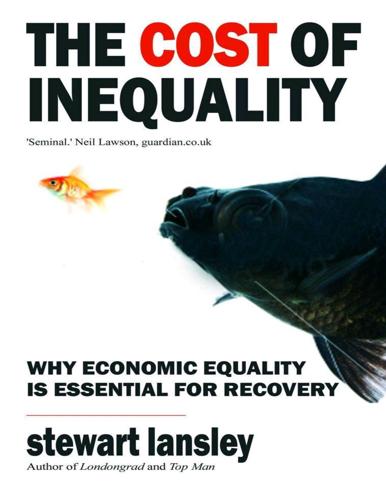
The Cost of Inequality: Why Economic Equality Is Essential for Recovery
by
Stewart Lansley
Published 19 Jan 2012
Yet the evidence is that market capitalism has been weaker on most key measures of economic performance than the period of managed capitalism. This is clear from dividing the post-war era into two distinct periods. The first—the 23 year period of ‘managed capitalism’—dates from 1950 to 1973, the year of the first OPEC oil shock and the one which perhaps best marks the end of the post-war boom. The second period—the 29 years of ‘market capitalism’—covers the period from 1980 to 2009, beginning with the first full year of the new economic experiment. Although this comparison misses 1974-1979, this period was a special case which saw the first serious recession of the post-war era, one ushered in by the OPEC shock.
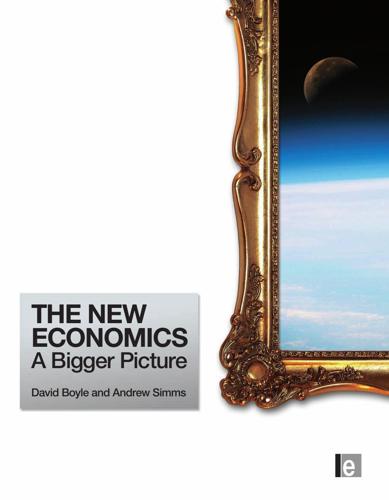
The New Economics: A Bigger Picture
by
David Boyle
and
Andrew Simms
Published 14 Jun 2009
The availability of basic food staples like wheat and other grains fell by half and, overall, the average Cuban’s calorie intake fell by over one third in around five years. But serious and long-term investment in science, engineering, health and education meant the country had a strong social fabric and the capacity to act. Successive reforms, dating back longer, reduced inequality and redistributed land. Before its local oil shock, Cuba had investigated forms of ecological farming far less dependent on fossil fuels, and had in place a system of regional research institutes, training centres and extension services to support farmers. At the heart of the transition was the success of small farms, and urban farms and gardens.

How to Speak Money: What the Money People Say--And What It Really Means
by
John Lanchester
Published 5 Oct 2014
Both of those things are conscious choices on the part of the society; we decreased levels of inequality and increased levels of opportunity before; we can do it again. As the political historian David Runciman recently wrote, The world that fell apart at the end of the 1970s had begun to unravel much earlier in the decade, in the succession of crises that included the demise of Bretton Woods, the Arab-Israeli war, the consequent oil shock and a world-wide recession. That confused and confusing period turned out to be the dawn of neoliberalism, though it wasn’t until much later that it became clear what had happened. Now that neoliberal order is stumbling through its own succession of crises. We are barely five years into the unravelling, if that is what is taking place. . . .
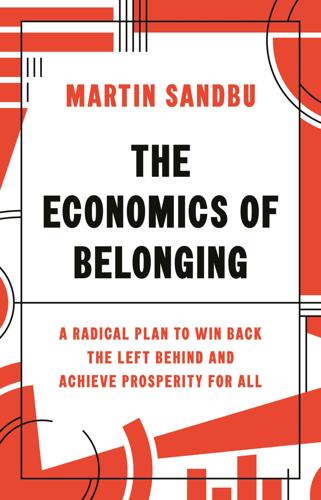
The Economics of Belonging: A Radical Plan to Win Back the Left Behind and Achieve Prosperity for All
by
Martin Sandbu
Published 15 Jun 2020
But this cannot explain the fact that virtually all of the West shifted politically at the same time. A bigger reason, even in the United States and the United Kingdom, is that electorates were ready for change, because it had become obvious that some modernisation of the postwar economic system was needed. In the 1970s, oil shocks and monetary chaos brought stagnation and inflation spikes to most Western countries, just as the number of factory jobs peaked. This created an appetite for reform in electorates that rewarded politicians willing to provide it. That, together with the fall of communism in 1989, which eliminated the only serious alternative to capitalism, also explains why the centre-left—or the third way, as the crop of young politicians coming to power in the 1990s liked to think of their revamped parties—embraced or at least did not reverse the liberalising reforms.

New Dark Age: Technology and the End of the Future
by
James Bridle
Published 18 Jun 2018
In one key respect, however, even a realistic accounting of data/oil is insufficient in its analogous power, for it might give us false hope of a peaceful transfer to an information-free economy. Oil is, despite everything, defined by its exhaustibility. We are already approaching peak oil, and while every oil shock prompts us to engage and exploit some new territory or some destructive technology – further endangering the planet and ourselves – the wells will eventually run dry. The same is not true of information, despite the desperate fracking that appears to be occurring when intelligence agencies record every email, every mouse click, and the movements of every cell phone.

The Digital Party: Political Organisation and Online Democracy
by
Paolo Gerbaudo
Published 19 Jul 2018
Members were vertically integrated starting from their place of abode, through the presence of local sections and cells, in turn coordinated in regional or provincial councils, and from there in national assemblies responsible for electing the party leadership. The analogy between the Fordist factory and the mass bureaucratic party goes a long way towards explaining why the crisis of the former has been accompanied by a decline of the latter. The crisis of accumulation of Fordist capitalism, signalled by the oil shocks and the stagflation crisis of the seventies, weakened both the organised working class and traditional sectors of the bourgeoisie, the mass parties’ traditional bases of support. This in turn was compounded by the rise of new protest movements, like student rebellions environmental and feminist movements, and urban activists that signalled the emergence of new demands and sensibilities recalcitrant to the forms of representation offered by the political party, amidst a rising sentiment of anti-authoritarianism and resistance to encadrement.

The Hidden Half: How the World Conceals Its Secrets
by
Michael Blastland
Published 3 Apr 2019
But in the 1970s, so it’s often argued, the policy came to sudden grief, stimulating a demand that the economy somehow failed to supply. Times and expectations had changed. Rampant inflation took hold (reaching 27% annually in the UK, even as unemployment rose). This stubborn, ugly combination was known as stagflation. That analysis is complicated by oil shocks at the time – sudden hikes in oil prices that also fed inflation. But whatever the relationship between inflation and unemployment – often regarded as a trade-off that stopped trading off at previous levels – the economy did not behave as expected. Whether this discredited Keynesianism is still argued, but existing policies plausibly exacerbated the problems.

Ten Lessons for a Post-Pandemic World
by
Fareed Zakaria
Published 5 Oct 2020
In an essay in Foreign Affairs in 1988, the Harvard scholar Samuel Huntington found so many instances of people talking about American decline that he coined a term for them—“declinists.” He argued that America was then witnessing its fifth wave of declinism. The first was triggered by the Soviet launch of Sputnik, the second in the late 1960s by the US quagmire in Vietnam, the third by the oil shock of 1973, the fourth by the hangover from Watergate and the stagflation of the late 1970s, and the fifth by the rise of Japan in the late 1980s (when he was writing). In the years since, America has been so dominant that it has taken a lot to shake its confidence. But the Iraq War, the 2008 financial crisis, and now Covid-19 have produced what is clearly a sixth wave of declinism.

Restarting the Future: How to Fix the Intangible Economy
by
Jonathan Haskel
and
Stian Westlake
Published 4 Apr 2022
Matters changed dramatically in the 1970s, when very high inflation combined with an economy that was operating far below capacity (that is, unemployment was very high). Economists at the time, accustomed to observing the economy only through the lens of shifting demand, took a while to understand that events like oil shocks had likely changed supply and prices. In the past decade, a new challenge has arisen: persistently low inflation. No matter the state of demand, inflation has been stubbornly low—most notably in Japan, where inflation has been very low for two decades. One way of interpreting this persistently low inflation is that the Phillips curve has become “flatter.”
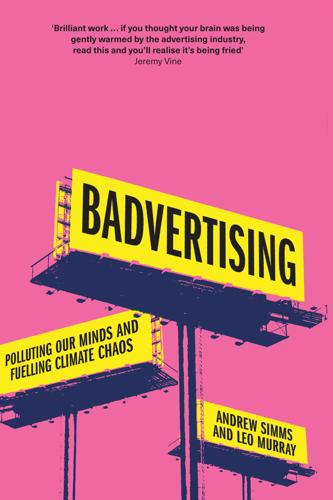
Badvertising
by
Andrew Simms
In effect, this locked foreign competitors out of the US off-road market for a generation, until the turn of this century. That meant that, for nearly four decades, the off-road vehicle market in the United States was exclusively American-made. Also important was a mistake made by the chairman of transport safety in the Carter administration ten years later. Fuel economy regulations introduced in response to oil shocks in the 1970s were applied to all passenger cars – but not, thanks to successful industry lobbying – to trucks. Further successful lobbying saw ‘trucks’ defined vaguely as ‘an automobile capable of off-highway operation’. This meant that there were for many decades no fuel economy rules when your ‘truck’ was over 8,500 pounds in weight – including passengers on all the seats and cargo.
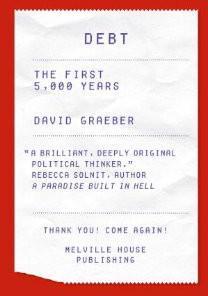
Debt: The First 5,000 Years
by
David Graeber
Published 1 Jan 2010
Quite possibly it wouldn’t even remain viable if all its workers were free wage laborers; certainly it will never be able to provide everyone in the world the sort of life lived by, say, a 1960s auto worker in Michigan or Turin with his own house, garage, and children in college—and this was true even before so many of those children began demanding less stultifying lives. The result might be termed a crisis of inclusion. By the late 1970s, the existing order was clearly in a state of collapse, plagued simultaneously by financial chaos, food riots, oil shock, widespread doomsday prophecies of the end of growth and ecological crisis—all of which, it turned out, proved to be ways of putting the populace on notice that all deals were off. The moment that we start framing the story this way, it’s easy to see that the next thirty years, the period from roughly 1978 to 2009, follows nearly the same pattern.
…
are there families who don’t “deserve” houses?) than it had been to allow all wage laborers to have unions, pensions, and health benefits. Capitalism doesn’t work that way. It is ultimately a system of power and exclusion, and when it reaches the breaking point, the symptoms recur, just as they had in the 1970s: food riots, oil shock, financial crisis, the sudden startled realization that the current course was ecological unsustainable, attendant apocalyptic scenarios of every sort. In the wake of the subprime collapse, the U.S. government was forced to decide who really gets to make money out of nothing: the financiers, or ordinary citizens.

The Rise of the Network Society
by
Manuel Castells
Published 31 Aug 1996
It would be tempting to relate directly the formation of this technological paradigm to the characteristics of its social context, particularly if we remember that in the mid-1970s the United States and the capitalist world were shaken by a major economic crisis, epitomized (but not caused) by the oil shock of 1973–4: a crisis that prompted the dramatic restructuring of the capitalist system on a global scale, actually inducing a new model of accumulation in historical discontinuity with post-Second World War capitalism, as I proposed in the Prologue of this book. Was the new technological paradigm a response by the capitalist system to overcome its internal contradictions?
…
Yet they receive, on average, about 60 percent of a regular worker’s salary, and about 15 percent of the annual bonus. More importantly, they have no job security, so they are hired and fired according to the company’s convenience. Part-timers and temporary workers provide the required labor flexibility. Their role has substantially increased since the 1970s, when the oil shock induced major economic restructuring in Japan. In the 1975–90 period, the number of part-time workers increased by 42.6 percent for male workers and by 253 percent for female workers. Indeed, women account for two-thirds of part-timers. Women are the skilled, adaptable workers who provide flexibility to Japanese labor management practices.
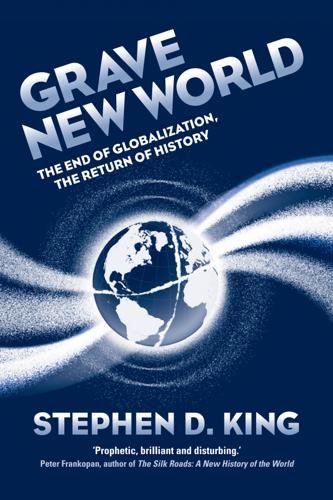
Grave New World: The End of Globalization, the Return of History
by
Stephen D. King
Published 22 May 2017
By 2007 (the year in which the financial cracks first began to appear), the figure had leapt to over 200 per cent, before falling back to a – still very high – 190 per cent by 2014.17 Moreover, ownership had become very diffuse: at the beginning of the twenty-first century, the US accounted for only a quarter of foreign assets, implying the absence of a single centre of finance equivalent to London before the First World War. This lack of financial ‘concentration’ reflected three key developments: the huge growth of the (offshore) eurodollar market in the 1960s and 1970s (a response to increased demand for US dollar holdings free from America’s regulatory clutches); the two big oil shocks of the 1970s that left countries in the Arab world with huge surplus savings in search of a home somewhere else in the world; and China’s persistent current account surpluses in the 1990s and beyond, which led to a huge increase in (mostly US dollar) Chinese foreign exchange reserves. When the world succumbed to the financial crisis, it was rather like watching the end of The Wizard of Oz in slow motion.
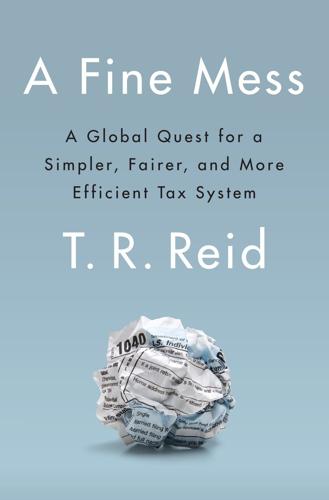
A Fine Mess
by
T. R. Reid
Published 13 Mar 2017
You get a certificate at the polling place that says you voted; you attach that to the tax return. If the tax agency doesn’t receive proof that you voted, you pay more tax. President Barack Obama proposed a similar penalty for American nonvoters; so far, this idea has gone nowhere. Taxes designed to curtail certain actions or purchases don’t always work. Following the oil shocks of the early 1970s, the U.S. Congress was eager to reduce Americans’ consumption of petroleum and thus reduce the nation’s dependence on foreign oil. One proposal called for a minimum level of fuel efficiency in all cars, so that it would be illegal to sell or buy a car that used too much gasoline per mile.
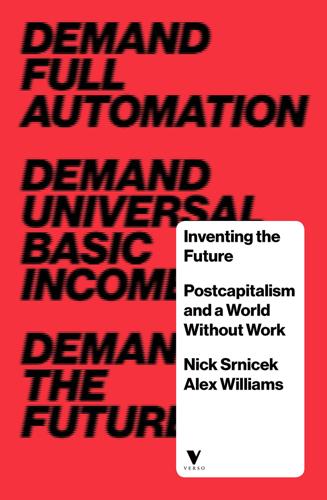
Inventing the Future: Postcapitalism and a World Without Work
by
Nick Srnicek
and
Alex Williams
Published 1 Oct 2015
But this would all change by the 1980s – a decade that would leave Keynesianism in disarray and enshrine neoliberalism as the preeminent model for economic modernisation. GRASPING THE WHEEL Having made national inroads, neoliberalism first gained serious international prominence in the 1970s, as a response to the combined pressures of high unemployment and high inflation – both of which had originated in oil shocks, general commodity price rises, wage increases and the expansion of credit. The dominant Keynesian approach to the economy had argued that governments should stimulate the economy by putting money into it when unemployment was rising, but, when inflation was rising, take money out of the economy, to slow down price rises.

No Ordinary Disruption: The Four Global Forces Breaking All the Trends
by
Richard Dobbs
and
James Manyika
Published 12 May 2015
Similarly, natural disasters or seemingly isolated geopolitical conflicts can disrupt supply chains or access to markets for players around the globe. Commodity prices are also showing an interesting new pattern. The correlation between commodity prices and the price of oil is now greater than at any time since the oil-shocked 1970s. In the 1980s and 1990s, prices of commodities such as corn, wheat, beef, and timber were largely uncorrelated with the price of oil (or even negatively correlated, in the case of timber); they now move in lockstep. This phenomenon can be explained by several factors: the growth in demand for resources from developing giants such as China; the fact that some resources (oil) are substantial input costs for other resources (grains); and the rise of technology that allows substitution between resources (like corn-based ethanol for oil).

The Second Machine Age: Work, Progress, and Prosperity in a Time of Brilliant Technologies
by
Erik Brynjolfsson
and
Andrew McAfee
Published 20 Jan 2014
Workers, 1963–2008 The effects of skill-biased technical change can be vividly seen in figure 9.2, which is based on data from a paper by MIT economists Daron Acemoglu and David Autor.18 The lines tell a story about the diverging paths of millions of workers over recent generations. Before 1973, American workers all enjoyed brisk wage growth. The rising tide of productivity increased everyone’s incomes, regardless of their educational levels. Then came the massive oil shock and recession of the 1970s, which reversed the gains for all groups. However, after that, we began to see a growing spread of incomes. By the early 1980s, those with college degrees started to see their wages growing again. Workers with graduate degrees did particularly well. Meanwhile, workers without college degrees were confronted with a much less attractive labor market.
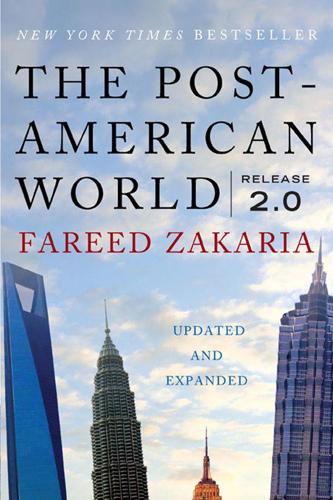
The Post-American World: Release 2.0
by
Fareed Zakaria
Published 1 Jan 2008
The fact that we have experienced decades of synchronous global growth is good news, but it has also raised a series of complex and potentially lethal dilemmas. Consider oil prices. It’s only a dim memory now, but in 2008 the cost of a barrel climbed upward at a dizzying rate. After years of hovering in the $25–$50 range, oil hit nearly $150 in mid-2008, and a Goldman Sachs analyst predicted it would reach $200 the following year. The oil shock of the naughts was different from previous ones. In the past, prices rose because oil producers—OPEC—artificially restricted supply and thus forced up the cost of gasoline. By contrast, prices rose in 2008 because of demand from China, India, and other emerging markets, as well as the continuing, massive demand in the developed world.
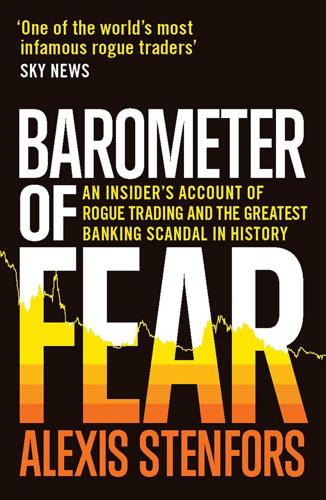
Barometer of Fear: An Insider's Account of Rogue Trading and the Greatest Banking Scandal in History
by
Alexis Stenfors
Published 14 May 2017
US dollars deposited at Eurobank became known as Eurodollars.7 Investors in the Middle East also began to place US dollars in Europe, quite possibly influenced by the resulting instability after the outbreak of the Suez War in 1956, when the US reacted by freezing some US assets held by foreigners. Later, with the oil shocks of 1973 and 1979, OPEC countries began accumulating large US dollar surpluses that they preferred to invest in European countries with large funding requirements. However, the key driver of the Eurodollar market was financial regulation – or, more specifically, the banks’ determination to avoid it.
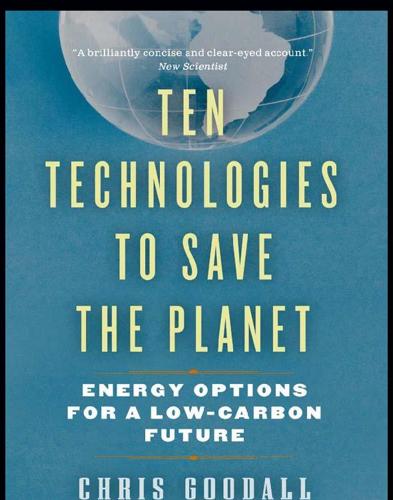
Ten Technologies to Save the Planet: Energy Options for a Low-Carbon Future
by
Chris Goodall
Published 1 Jan 2010
In many cases, as the cynics never cease to remind us, the earlier attempts to speed the development of new energy-generating techniques were complete failures. Costs remained high, the technology immature, and consumer interest limited, despite the investment of billions of dollars of public money. Generally declining fossil fuel prices in the three decades after the oil shock of the early 1970s caused governments to lose interest, and most research efforts faded away. One of the great ironies of the last few years is that some of the scientists involved in the 1970s alternative energy drive have been brought out of retirement to restart the same R &D programs that were abruptly shut down decades ago.
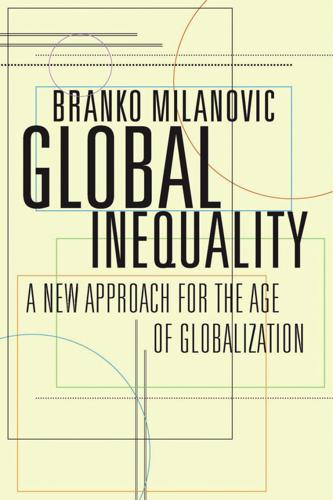
Global Inequality: A New Approach for the Age of Globalization
by
Branko Milanovic
Published 10 Apr 2016
The second technological revolution made irrelevant many of the behemoths that were thought to be indestructible: socialism collapsed, and the capitalism that triumphed was of a very different type than was envisaged in the late 1960s. No one predicted the rise of China. Indeed, China is remarkable by its absence in these books.2 The 1970s, following the oil shock and the quadrupling of real oil prices, generated an entire literature concerned with the depletion of national resources and limits to growth (The Limits to Growth, by Donella Meadows et al., was one of the most famous books of that time).3 A period of slower, almost zero, economic growth in the West suggested a much less optimistic view of the future.4 Endless growth driven by technology was no longer envisaged.
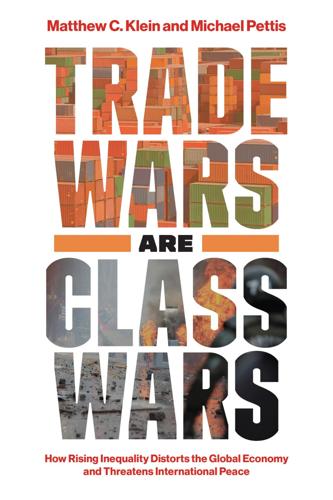
Trade Wars Are Class Wars: How Rising Inequality Distorts the Global Economy and Threatens International Peace
by
Matthew C. Klein
Published 18 May 2020
This was often unethical, and in some cases may have been illegal, but it was also the logical response to the enormous pressures on the U.S. financial system coming from outside. In any functioning market, high demand relative to supply leads to some combination of higher prices and additional production. Think of the oil shocks of the 1970s, which eventually led to deepwater exploration in the North Sea, the Gulf of Mexico, Alaska, and elsewhere, or how the rise of the technology industry in the San Francisco Bay Area since the 1990s has led to soaring housing prices. The main difference between financial assets and physical assets such as oil and housing is that it is much easier to create additional financial assets.

Green Swans: The Coming Boom in Regenerative Capitalism
by
John Elkington
Published 6 Apr 2020
At what point, I wondered, would I suffer from the same fate, finding myself trapped in a fading reality while new realities bubbled up all around—in younger minds than mine? If you knew where to look, even back then, the future was already doing precisely that. Bubbling up. That is what our ENDS team was investigating and reporting on. On the energy front, the world had already experienced two major oil shocks, spurring significant changes in the fuel mix. More importantly still, the idea that there might be planetary limits to economic growth was gaining currency, with work like that of the Club of Rome’s Limits to Growth team later evolving into the work of the Planetary Boundaries and Great Acceleration initiatives.
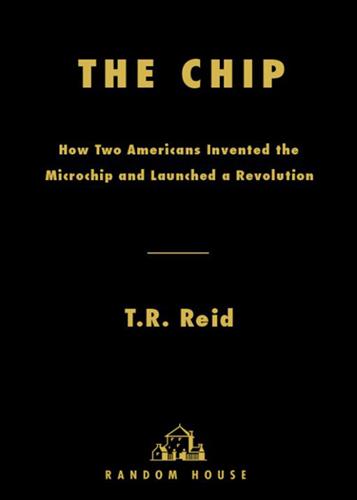
The Chip: How Two Americans Invented the Microchip and Launched a Revolution
by
T. R. Reid
Published 18 Dec 2007
“There are a large number of real needs which the inventor can address,” he said in his lecture on inventing. “The individual is free to choose a need that he thinks he may be able to satisfy . . . . The definition of the problem becomes a major part of the innovation” (Kilby’s emphasis). For several years, he worked on a problem of major importance: the nation’s energy supply. After the oil shocks of the 1970s, a consensus grew that there was a fundamental need for some other source of power—a source that was available to everyone on earth, a source that was unlimited, a source that didn’t require huge smokestacks emitting greenhouse gases. In fact, this power source already existed—the sun.

The Warhol Economy
by
Elizabeth Currid-Halkett
Published 15 Jan 2020
By the 1960s, New York designers such as Calvin Klein, Ralph Lauren, and Bill Blass were running their own operations and creating their own identities as designers heralding the beginnings of cultural commodification and celebrity in the fashion world.29 The 1970s Through the Early 1980s: Postmodernism, Punk, and the Downtown Scene Deindustrialization, the oil shocks of the 1970s, and New York’s economic recession left the city in deep social and economic decline, with massive unemployment, fiscal crisis, and depressed rents and real estate. The same period was marked by national social unrest. From Watergate to the Vietnam War to the aftermath of the civil rights movement, America as a whole was significantly dissonant in its identity and social values, and New York more acutely than most places.
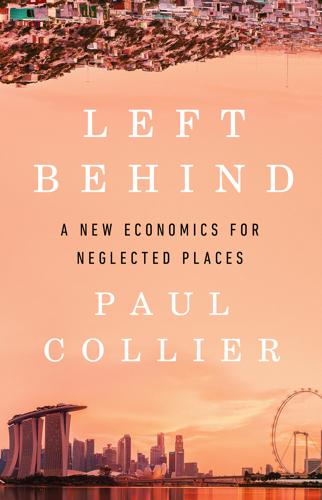
Left Behind
by
Paul Collier
Published 6 Aug 2024
One of its implications is that most of the solutions we find for such problems are unlikely to work for ever, and this was true of the triumphs Attlee and Truman achieved.v In the economic sphere the two leaders relied on the Keynesian idea that full employment could be maintained by complex forecasting models: government knew best. After thirty years of full employment, the oil-shocks of the 1970s triggered stagflation and Keynesian ideas were abandoned in favour of Milton Friedman’s counter-revolution, which replaced government-knows-best with the-market-knows-best. Market-worship died a similarly embarrassing death during the Global Financial Crisis of 2008/9, when frantic and intellectually bereft policymakers reached back to Keynesianism to avert global collapse.
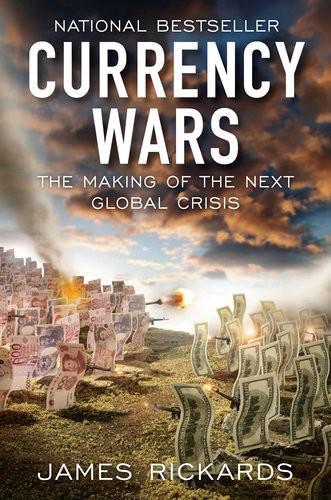
Currency Wars: The Making of the Next Gobal Crisis
by
James Rickards
Published 10 Nov 2011
Although Volcker’s efforts were heroic, he was not the sole cause of declining inflation and a stronger dollar. Equal credit was due to the low-tax and deregulatory policies of Ronald Reagan. The new president entered office in January 1981 at a time when American economic confidence had been shattered by the recessions, inflation and oil shocks of the Nixon-Carter years. Although the Fed was independent of the White House, Reagan and Volcker together constructed a strong dollar, implemented a low-tax policy that proved to be a tonic for the U.S. economy and launched the United States on one of its strongest periods of growth in history.
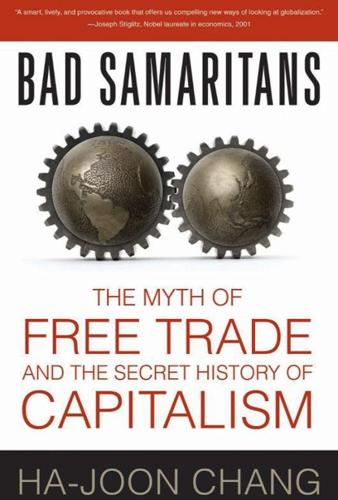
Bad Samaritans: The Myth of Free Trade and the Secret History of Capitalism
by
Ha-Joon Chang
Published 26 Dec 2007
Few people outside Korea were aware that the beautiful public parks surrounding the impressive Seoul Football Stadium they saw during the 2002 World Cup were built literally on top of the old rubbish dump on the island (which nowadays has an ultra-modern eco-friendly methane-burning power station, which taps into the organic material dumped there). In October 1979, when I was still a secondary school student, President Park was unexpectedly assassinated by the chief of his own Intelligence Service, amid mounting popular discontent with his dictatorship and the economic turmoil following the Second Oil Shock. A brief ‘Spring of Seoul’ followed, with hopes of democracy welling up. But it was brutally ended by the next military government of General Chun Doo-Hwan, which seized power after the two-week armed popular uprising that was crushed in the Kwangju Massacre of May 1980. Despite this grave political setback, by the early 1980s, Korea had become a solid middle-income country, on a par with Ecuador, Mauritius and Costa Rica.

Everything Is Obvious: *Once You Know the Answer
by
Duncan J. Watts
Published 28 Mar 2011
The basic idea of scenario planning is to create what strategy consultant Charles Perrottet calls “detailed, speculative, well thought out narratives of ‘future history.’ ” Critically, however, scenario planners attempt to sketch out a wide range of these hypothetical futures, where the main aim is not so much to decide which of these scenarios is most likely as to challenge possibly unstated assumptions that underpin existing strategies.18 In the early 1970s, for example, the economist and strategist Pierre Wack led a team at Royal Dutch/Shell that used scenario planning to test senior management’s assumptions about the future success of oil exploration efforts, the political stability of the Middle East, and the emergence of alternative energy technologies. Although the main scenarios were constructed in the relatively placid years of energy production before the oil shocks of the 1970s and the subsequent rise of OPEC—events that definitely fall into the black swan category—Wack later claimed that the main trends had indeed been captured in one of his scenarios, and that the company was as a result better prepared both to exploit emerging opportunities and to hedge against potential pitfalls.19 Once these scenarios have been sketched out, Raynor argues that planners should formulate not one strategy, but rather a portfolio of strategies, each of which is optimized for a given scenario.

Carjacked: The Culture of the Automobile and Its Effect on Our Lives
by
Catherine Lutz
and
Anne Lutz Fernandez
Published 5 Jan 2010
The rising tide of affluence in those years lifted most boats, and economic measures showed slow gains in levels of equality until the mid-1970s. For a variety of reasons—most of them having to do with public policy changes initiated during the Reagan years, related declines in the strength of unions, and the oil shocks of the early 1970s—this began to change. The idea of a government safety net for those excluded from a living wage was shredded by the notion that the market would more efficiently solve such problems. Wages and benefits for the working and middle class flattened or declined, corporate profits rose, and CEO salaries went through the roof: where the ratio of the highest- and lowest-paid workers in the United States was 50 to 1 in 1965, it was 800 to 1 by 2005.1 In the process, the fundamental social contract between government, business, and American workers was radically changed.
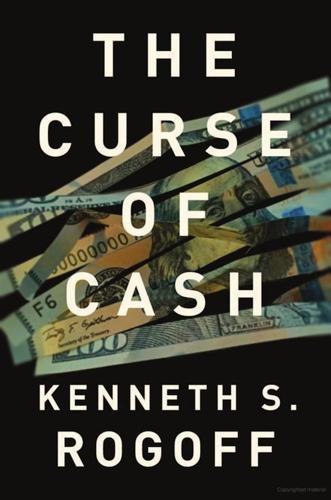
The Curse of Cash
by
Kenneth S Rogoff
Published 29 Aug 2016
“Interest Rates as Options.” Journal of Finance 50 (December): 1371–76. Blanchard, Olivier, Giovanni Dell’Ariccia, and Paolo Mauro. 2010. “Rethinking Macroeconomic Policy.” International Monetary Fund Position Note SPN/10/03. Washington, DC (February). Bodenstein, Martin, Luca Guerrieri, and Christopher J. Gust. 2013. “Oil Shocks and the Zero Bound on Nominal Interest Rates.” Journal of International Money and Finance 32(1): 941–967. Boeschoten, W. C., and G. E. Hebbink. 1996. “Electronic Money, Currency Demand and Seigniorage Loss in the G10 Countries.” De Nederlandsche Bank Staff Reports 1. Amsterdam. Bordo, Michael D. 2008.
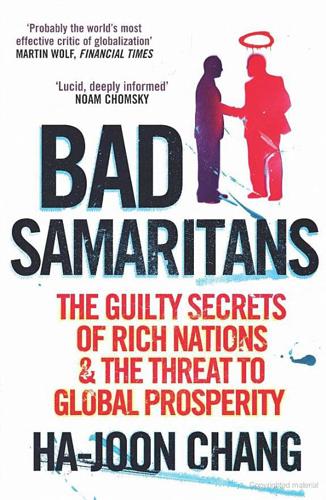
Bad Samaritans: The Guilty Secrets of Rich Nations and the Threat to Global Prosperity
by
Ha-Joon Chang
Published 4 Jul 2007
Few people outside Korea were aware that the beautiful public parks surrounding the impressive Seoul Football Stadium they saw during the 2002 World Cup were built literally on top of the old rubbish dump on the island (which nowadays has an ultra-modern eco-friendly methane-burning power station, which taps into the organic material dumped there). In October 1979, when I was still a secondary school student, President Park was unexpectedly assassinated by the chief of his own Intelligence Service, amid mounting popular discontent with his dictatorship and the economic turmoil following the Second Oil Shock. A brief ‘Spring of Seoul’ followed, with hopes of democracy welling up. But it was brutally ended by the next military government of General Chun Doo-Hwan, which seized power after the two-week armed popular uprising that was crushed in the Kwangju Massacre of May 1980. Despite this grave political setback, by the early 1980s, Korea had become a solid middle-income country, on a par with Ecuador, Mauritius and Costa Rica.
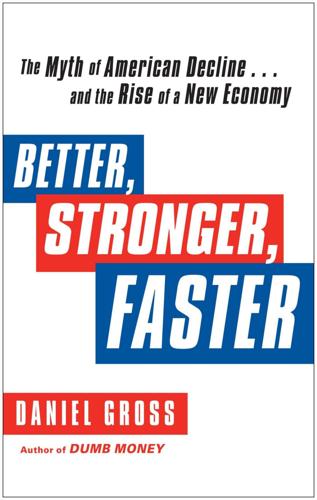
Better, Stronger, Faster: The Myth of American Decline . . . And the Rise of a New Economy
by
Daniel Gross
Published 7 May 2012
Played by Lee Majors, Steve Austin was an astronaut who crashed to earth and then became the Six Million Dollar Man. The series started as a television movie in 1973, a year the United States was undergoing a similar dark night of the soul, grappling with a succession of political and economic crises: Vietnam, Watergate, rising inflation, and an oil shock. But from its opening credits the Six Million Dollar Man exuded a typically American confidence: “We can rebuild him. We have the technology. We have the capability to make the world’s first bionic man. Steve Austin will be that man. Better than he was before. Better, stronger, faster.” And like Steve Austin, the U.S. economy can bounce back from its catastrophic wipeout.
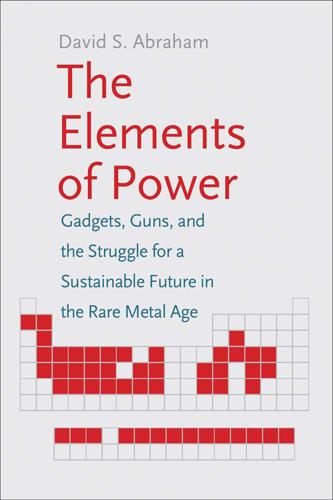
The Elements of Power: Gadgets, Guns, and the Struggle for a Sustainable Future in the Rare Metal Age
by
David S. Abraham
Published 27 Oct 2015
It developed a framework to ensure that U.S. military businesses had the resources to compete in an increasingly global marketplace, which constituted one of the largest reports in the nation’s history—if you stack the twelve volumes of the findings they extend over a foot from end to end. Internationally, U.S. diplomats served tours of duty in a newly created office of nonferrous materials policy.29 Interest in critical materials remained high in policy circles through the 1960s, and the oil shock of the 1970s sparked concern once again about critical resources. But fears and concerns over critical materials dampened with the recession of the early 1980s as it ushered in an era of relative price decline, and in the case of some commodities, like oil, far lower prices. Western governments started to feel that natural resource security, especially critical material supply, was yesterday’s issue.
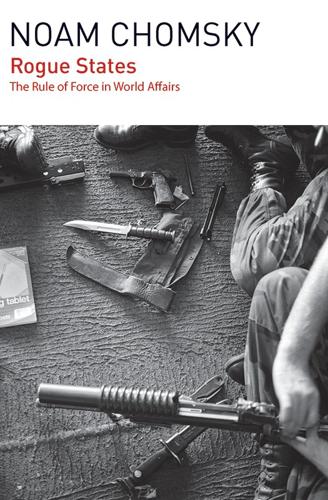
Rogue States
by
Noam Chomsky
Published 9 Jul 2015
But that day remains very distant.7 Bank lending more than doubled from 1971 to 1973, then “levelled off for the next two years, despite the enormous increase in oil bills” from late 1973, the OECD reported, adding that “the most decisive and dramatic increase in bank lending was associated with the major commodity price boom of 1972-73—before the oil shock.” One example was the tripling in price of US wheat exports.8 Lending later increased as banks sought to recycle petrodollars. The (temporary) rise in oil prices led to sober calls that Middle East oil “could be internationalized, not on behalf of a few oil companies, but for the benefit of the rest of mankind.”9 There were no similar proposals for internationalization of US agriculture, highly productive as a result of natural advantages and public-sector research and development for many years, not to speak of the measures that made the land available, hardly through the miracle of the market.
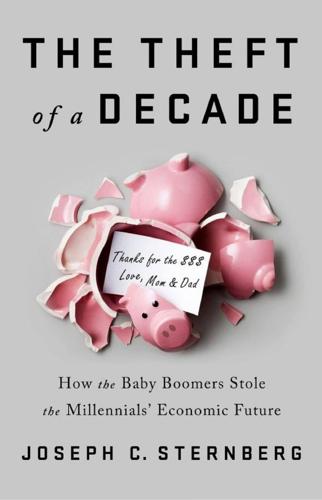
The Theft of a Decade: How the Baby Boomers Stole the Millennials' Economic Future
by
Joseph C. Sternberg
Published 13 May 2019
The percentage of economic output paid to workers as compensation during the 1950s and ’60s hovered above 64 percent; that proportion, called the labor share, has been declining for most of the time since then.1 So it’s easy to understand the Boomers’ surprise when the labor market fell apart right as they were entering their first jobs. At the time, it seemed as if the problem was primarily the downsizing revolution that had started in manufacturing in the 1970s amid recessions, oil shocks, rampant inflation, and the political upheaval of the Watergate era. Suddenly, “employment for life” just didn’t exist anymore. The US Bureau for Labor Statistics started measuring “worker displacement” in 1984 to count the number of workers who had been with a company for at least three years but then had lost their job for reasons beyond their control, such as downsizing, offshoring, or a corporate relocation to somewhere else in the United States.
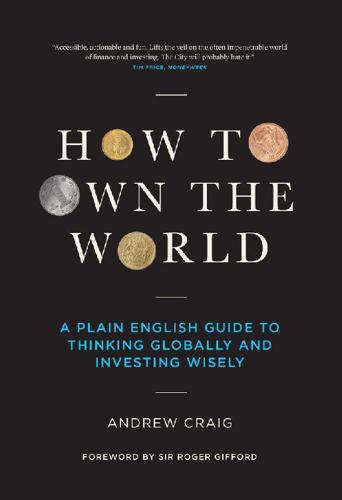
How to Own the World: A Plain English Guide to Thinking Globally and Investing Wisely
by
Andrew Craig
Published 6 Sep 2015
Stocks for the Long Run: The Definitive Guide to Financial Market Returns and Long-Term Investment Strategies. New York: McGraw-Hill, 2008. Slater, Jim. The Zulu Principle: Making Extraordinary Profits from Ordinary Shares. London: Orion, 1992. Simmons, Matthew R. Twilight in the Desert: The Coming Saudi Oil Shock and the World Economy. Hoboken: John Wiley & Sons, 2005. Smith, Adam: The Theory of Moral Sentiments. Cambridge: Cambridge University Press, 2002. ———. The Wealth of Nations. London: Penguin, 1999. Smith, David. The Age of Instability: The Global Financial Crisis and What Comes Next. London: Profile, 2010.
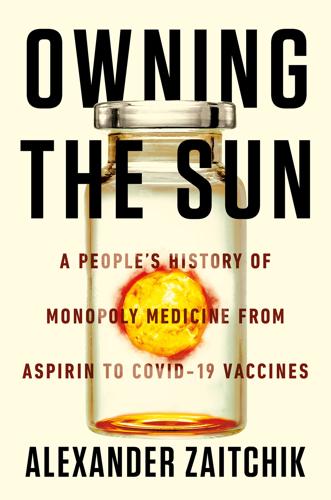
Owning the Sun
by
Alexander Zaitchik
Published 7 Jan 2022
The humiliating defeat sent the patent lobby back to the drawing board. Despite decades of ideological sawing by Robert Bork and other Chicago figures, the anti-monopoly and patent legacies of the New Deal were proving stubborn and difficult to fell. It seemed unlikely a reform bill would get past a phalanx of old-guard senators and Jimmy Carter. But the oil shocks and deepening anxiety about the economy continued to put longshot policies in play in unpredictable ways. The reformers doubled down on the line that an attachment to liberal dogma was holding back progress and creating a strategic “inventions gap.” They hoped the refrains—repeated in op-eds, think tank reports, and Senate hearings—would drown out the rebuttals and counter-evidence presented by FTC, Justice, HEW, and Defense Department officials.
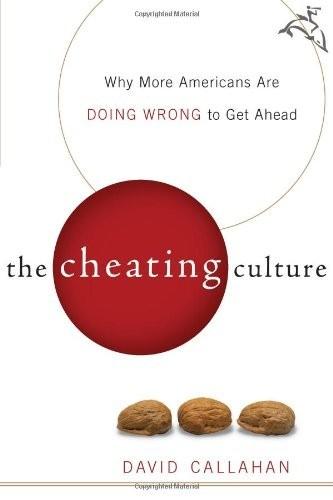
The Cheating Culture: Why More Americans Are Doing Wrong to Get Ahead
by
David Callahan
Published 1 Jan 2004
The individualism of the '60s turned toxic as it was stripped of its initial liberating purposes and as positive '60s values like social responsibility—which had counterbalanced the new individualism—lost traction in popular culture. Young people became more cynical and materialistic. The nation drifted without a strong sense national purpose—stuck, it seemed, in an intractable malaise. Meanwhile, the economic upheavals of the decade—inflation, currency instability, oil shocks, rising foreign competition—mobilized the business community to get leaner and meaner, and to begin a far-reaching assault on government regulation and labor unions. By the end of the '70s the stage was set for a new era of extreme capitalism. IN 1981, AFTER he was sworn in as President, Ronald Reagan pronounced: "Government is not the solution, government is the problem."
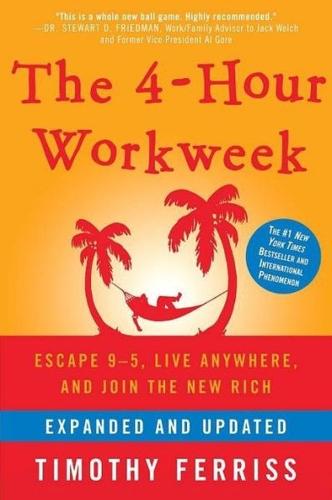
The 4-Hour Workweek: Escape 9-5, Live Anywhere, and Join the New Rich
by
Timothy Ferriss
Published 1 Jan 2007
A small cup of black Kenyan AA coffee with cinnamon on top, no milk or sweeteners. It’s usually better to keep old resolutions than to make new ones. To bring in a wonderful 2009, I’d like to quote an e-mail I received from a mentor of more than a decade: While many are wringing their hands, I recall the 1970s when we were suffering from an oil shock causing long lines at gas stations, rationing, and 55 MPH speed limits on federal highways, a recession, very little venture capital ($50 million per year into VC firms), and what President Jimmy Carter (wearing a sweater while addressing the nation on TV because he had turned down the heat in the White House) called a “malaise.”
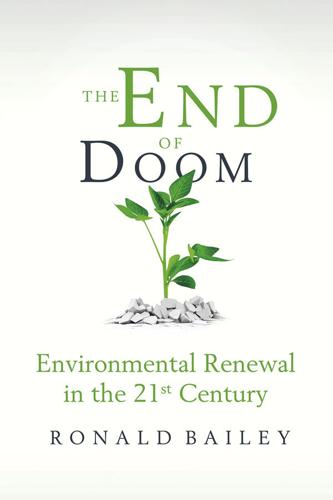
The End of Doom: Environmental Renewal in the Twenty-First Century
by
Ronald Bailey
Published 20 Jul 2015
Deffeyes, author of 2001’s Hubbert’s Peak: The Impending World Oil Shortage and 2005’s Beyond Oil: The View from Hubbert’s Peak, had already predicted that the peak of global oil production would occur on Thanksgiving 2005. Deffeyes was far from alone. Houston investment banker Matthew Simmons stated in his 2005 book Twilight in the Desert: The Coming Saudi Oil Shock and the World Economy that the Saudi Arabians were lying about the size of their petroleum reserves, claiming that they are really running on empty. In September 2005 Simmons announced that “we could be looking at $10-a-gallon gas this winter.” The price of gasoline in December 2005 was about $2.25 per gallon.
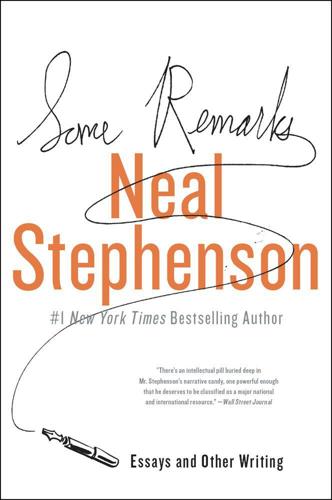
Some Remarks
by
Neal Stephenson
Published 6 Aug 2012
Scientists and engineers who came of age during the first half of the 20th century could look forward to building things that would solve age-old problems, transform the landscape, build the economy, and provide jobs for the burgeoning middle class that was the basis for our stable democracy. The Deepwater Horizon oil spill of 2010 crystallized my feeling that we have lost our ability to get important things done. The OPEC oil shock was in 1973—almost 40 years ago. It was obvious then that it was crazy for the United States to let itself be held economic hostage to the kinds of countries where oil was being produced. It led to Jimmy Carter’s proposal for the development of an enormous synthetic fuels industry on American soil.
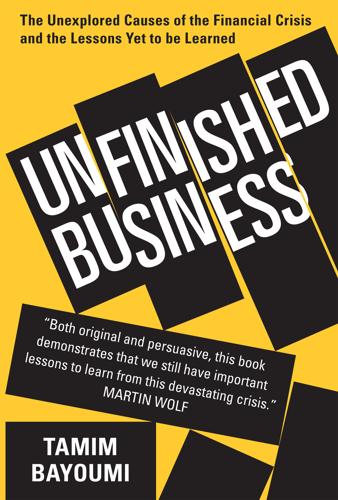
Unfinished Business
by
Tamim Bayoumi
Furthermore, because Mexico and Brazil were relatively closed to international trade, the cost of servicing this debt increased to an astonishing half of exports. In the early 1980s, Mexico and Brazil were hit by an economic triple-whammy comprising of lower commodity prices, higher US interest rates, and dollar appreciation. The second oil shock in 1979 led to a recession in the advanced countries that lowered the demand for, and the price of, commodities, thereby hurting export earnings. On top of this, the new Chairman of the Federal Reserve, Paul Volcker, hiked US interest rates aggressively in order to tame inflation. The six-month LIBOR rate tripled from 6 percent in 1976 to 18 percent by mid-1981 and remained in double digits through most of 1982.
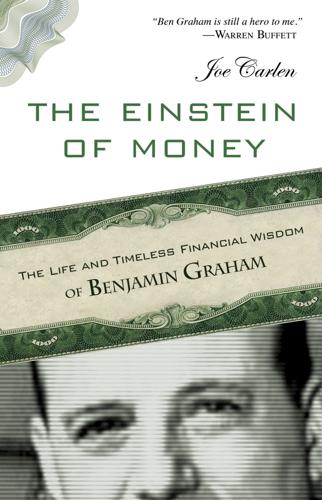
The Einstein of Money: The Life and Timeless Financial Wisdom of Benjamin Graham
by
Joe Carlen
Published 14 Apr 2012
In 1997, Warren Buffett made the following observation regarding the long-term soundness of Graham's principles: We will continue to ignore political and economic forecasts, which are an expensive distraction for many investors and businessmen. Thirty years ago, no one could have foreseen the huge expansion of the Vietnam War, wage and price controls, two oil shocks, etc…. But, surprise—none of these blockbuster events made the slightest dent in Ben Graham's investment principles…. Fear is the foe of the faddist but the friend of the fundamentalist [i.e., one who adheres to Graham's fundamental principles]. A different set of major shocks is sure to occur in the next thirty years.
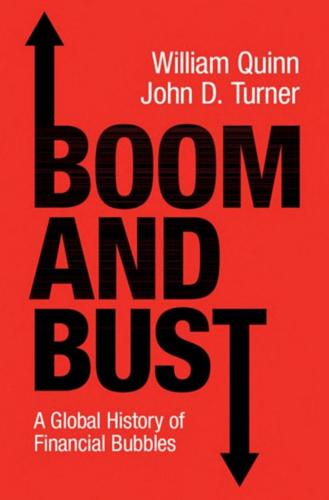
Boom and Bust: A Global History of Financial Bubbles
by
William Quinn
and
John D. Turner
Published 5 Aug 2020
The new economic strategy was to encourage banks to lend enormous amounts of money, particularly for the purchase of housing, so that the economy continued to grow despite an appreciation of the yen and a reduction in government spending. In some ways, the agreement simply gave Japan an excuse to accelerate reforms that had already begun, or to pursue reforms that the government wanted to implement anyway. Financial liberalisation was a continuation of policies that had been pursued since the early 1970s. The oil shock of 1973 had forced the Japanese government to run large deficits, leading the Bank of Japan to worry that it could no longer underwrite the full quantity of outstanding government bonds. The government’s response was to establish secondary government bond markets, thereby relinquishing control over interest rates for the first time in the post-war era.
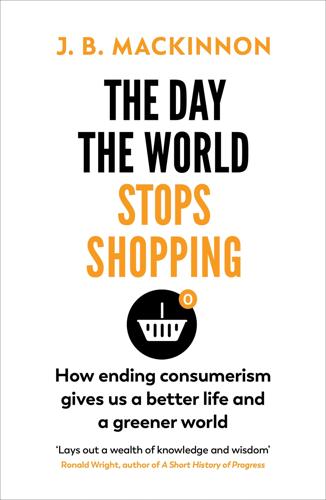
The Day the World Stops Shopping
by
J. B. MacKinnon
Published 14 May 2021
Reflecting on this unshakeable dedication to consumption, former energy secretary James Schlesinger said, “Remember, we are talking about the habits of the American people. Moralists may find these habits reprehensible, but the public finds them satisfying.” In 2009, American consumers—who had kept shopping through the Second World War and the Vietnam War, through the social upheaval of the 1960s, through oil shocks and the rise of environmentalism, and through eleven other recessions—finally put down their wallets. The Great Recession was the first time since the Great Depression, seventy-one years earlier, that the total amount Americans spent on consumption actually declined. The people of many other nations also bought less.
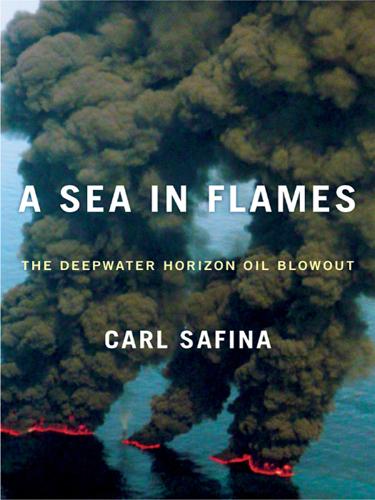
A Sea in Flames: The Deepwater Horizon Oil Blowout
by
Carl Safina
Published 18 Apr 2011
The real tragedy is that for thirty years we’ve known that for reasons of national security and patriotism alone, we need to phase out our dependence on oil, coal, and gas. Our foreign dependence, the jobs we’re missing out on, the pollution, the worker-killing explosions, the way we enrich dictators and terrorists—we’ve known all that since the politically induced oil shocks and gasoline lines of the 1970s. I remember those lines with some fondness, because I waited on them as a young high school buck and proud new owner of a used hippie van. But those lines were all we needed to learn that security for the United States, and the globe, requires a future largely free of fossil fuels.

What's Next?: Unconventional Wisdom on the Future of the World Economy
by
David Hale
and
Lyric Hughes Hale
Published 23 May 2011
However, the bottom line remains that in 2030 (notwithstanding the thinking triggered by the Deepwater Horizon oil spill), ours will still be a hydrocarbon-powered economy, and enough oil and gas resources will be available to meet the huge energy demand that cannot be met by alternative energy sources, however rapid their development. Lessons learned in 2009 and 2010 highlight the importance of better governance of energy as well as climate issues.43 Notes 1. Matthew R. Simmons, Twilight in the Desert: The Coming Saudi Oil Shock and the World Economy (Hoboken, NJ: Wiley, 2005). 2. Kenneth S. Deffeyes, Hubbert’s Peak: The Impending World Oil Shortage (Princeton, NJ: Princeton University Press, 2001). For an opposing view, see Robin M. Mills, The Myth of the Oil Crisis: Overcoming the Challenges of Depletion, Geopolitics, and Global Warming (Westport, CT: Praeger, 2008). 3.
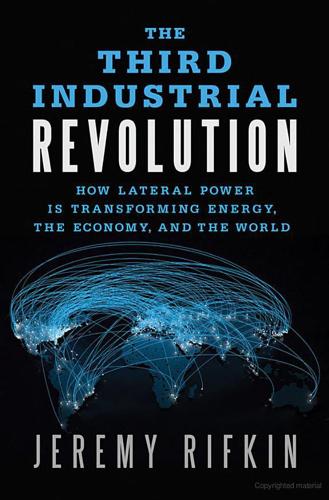
The Third Industrial Revolution: How Lateral Power Is Transforming Energy, the Economy, and the World
by
Jeremy Rifkin
Published 27 Sep 2011
The jolt to our national pride came without warning. Just two months earlier, the Organization of Petroleum Exporting Countries (OPEC) slapped an oil embargo against the United States in retaliation to Washington’s decision to resupply the Israeli government with military equipment during the Yom Kippur War. The “oil shock” reverberated quickly across the world. By December, the price of oil on the world market had shot up from $3 per barrel to $11.65.1 Panic ensued on Wall Street and on Main Street. The first and most obvious sign of the new reality was at neighborhood gas stations. Many Americans believed that the giant oil companies were taking advantage of the situation by arbitrarily spiking prices to secure windfall profits.
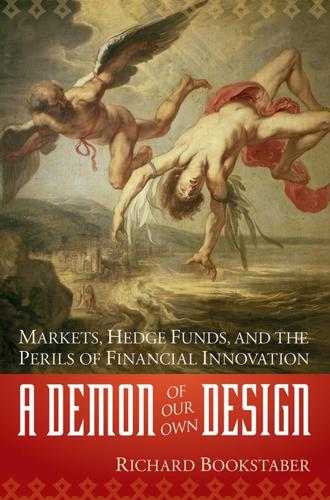
A Demon of Our Own Design: Markets, Hedge Funds, and the Perils of Financial Innovation
by
Richard Bookstaber
Published 5 Apr 2007
In the early twentieth century, there were no technology, telecommunications, media, or health care sectors. The industrial economy revolved around a few highly integrated, large-scale industries. A coal miners’ or steelworkers’ strike would cripple the country, shutting factory floors and shipping yards. Even as late as the 1970s, the industrialized nations were so energy dependent that an oil shock precipitated a global recession. Today, high gasoline prices cause lots of grumbling, but little real pain. Similarly, as progress and refinement reduce risk, so should they also level the playing field for market participants. There should be less of a gap between your investment returns and those of Wall Street pros.
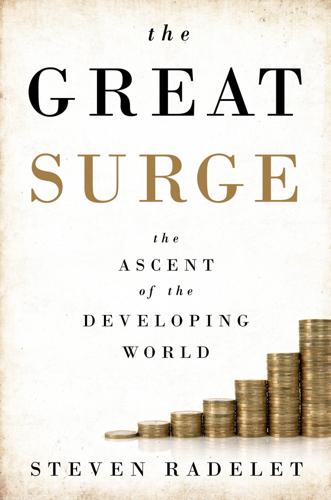
The Great Surge: The Ascent of the Developing World
by
Steven Radelet
Published 10 Nov 2015
In the immediate post–World War II era, several countries in East and Southeast Asia (alongside a few others like Botswana and Mauritius) began to make remarkable advances that continue today. China began its rapid resurgence in 1980, in many ways setting the stage for the broader transformation that followed in other countries. Some other developing countries started to move forward, only to see progress halt in the late 1970s and 1980s following the global oil shocks and subsequent debt crises. However, most developing countries made little headway—that is, until the early 1990s, when progress accelerated and dozens of developing countries around the world began to move forward. My central focus is on four critical dimensions of development progress: poverty, income, health and education, and democracy and governance (although I will touch on many others).
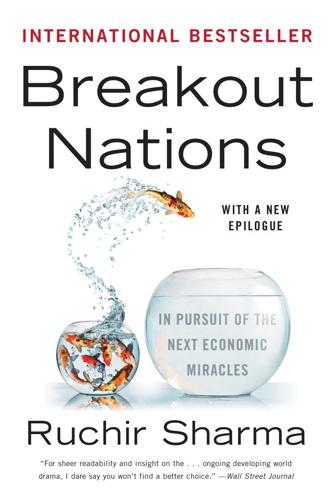
Breakout Nations: In Pursuit of the Next Economic Miracles
by
Ruchir Sharma
Published 8 Apr 2012
Since the crises of the 1980s Brazil’s government spending as a share of its economy has climbed steadily from nearly 20 percent—pretty typical for the emerging markets—to around 40 percent in 2010, among the highest in the developing world. This is not how Brazil used to be. In the 1950s and 1960s, the economy expanded at a double-digit growth rate, and professors of development economics from South Korea to Argentina held Brazil up as a paragon of economic virtue. But by the 1970s, as the oil shocks first started to drive up prices, Brazil lost its way and succumbed to the populist appeal of trying to lock in a comfortable lifestyle: the 1988 constitution guarantees free health care and university education, and today the minimum wage is so high that it applies to one in three workers. Economists don’t agree on when big government equals bad government, but they do agree that government spending should track changes in per capita income, and for Brazil currently that would correspond to around 25 percent of GDP, not 40 percent.

The Economics of Enough: How to Run the Economy as if the Future Matters
by
Diane Coyle
Published 21 Feb 2011
He argued that the luxuries of one generation became necessities for the next as if society were a column moving steadily forward with the rich tasting the fruits that would eventually be conveyed to the rest of humanity. He predicted a future of increasing personal competition in an ever more vicious rat race and that such a process would have a detrimental impact on the moral fabric of society. These authors were writing at a time when the social strains of the late 1960s and the oil shock of the early 1970s had clearly triggered a crisis of capitalism. The lesson is being painfully relearned by our generation. One example is an essay by Manhattan Institute scholar Jim Manzi, who writes of the “bifurcation of social norms in America,” the chasm between patterns of life and behavior of the well-off and the poor.
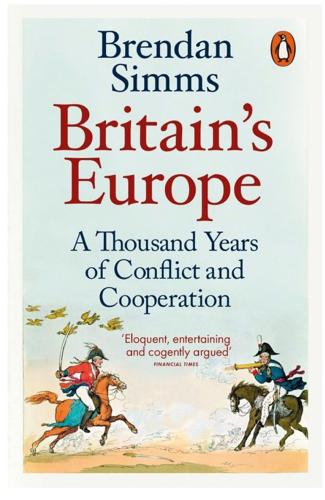
Britain's Europe: A Thousand Years of Conflict and Cooperation
by
Brendan Simms
Published 27 Apr 2016
The vote, as Roy Jenkins noted piquantly, had taken place on 6 June, the anniversary of D-Day, ‘when Britain had ended a previous period of exclusion from Europe’.68 The Common Market was generally good for British business, but it could not compensate for serious structural economic deficiencies which had accumulated since the end of the Second World War and were greatly aggravated by the oil shock: the surge in fuel prices caused by political instability in the Middle East. Throughout 1976, the country was convulsed by economic problems, which culminated in a sterling crisis and a bail-out by the International Monetary Fund (IMF). The implications for Britain’s strategic position were dire: there were plans to repair the public finances by reducing the troop presence in Germany and withdrawing from Cyprus altogether.69 As the United Kingdom retreated globally, Scottish nationalism reappeared in the form of the Scottish National Party.
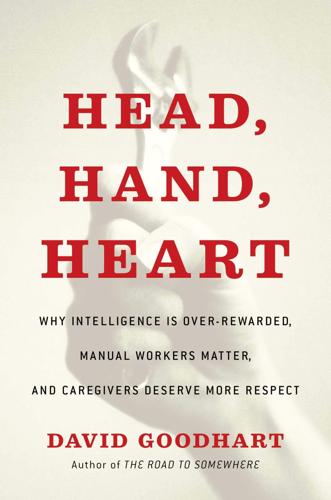
Head, Hand, Heart: Why Intelligence Is Over-Rewarded, Manual Workers Matter, and Caregivers Deserve More Respect
by
David Goodhart
Published 7 Sep 2020
In the United States, bus drivers have actually seen their average hourly pay fall by 20 percent in that period.11 In any case, fair or not fair, there is no escaping the broad trend on pay differentiation since the early 1980s. David Autor divides the recent history of pay in the United States into three phases: 1963 to 1972, when real wages rose robustly and evenly among all education groups; 1973 to 1979, when—following the first oil shock—real earnings stagnated for everyone; and finally the era of rising wage inequality from 1980 onward, when wages rose robustly among the most educated and fell in real terms among the least educated, most strikingly among men with less than a bachelor’s degree.12 Again, it is worth remembering how recently the less well educated dominated developed societies.
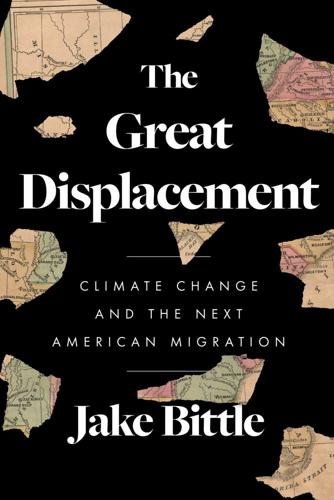
The Great Displacement: Climate Change and the Next American Migration
by
Jake Bittle
Published 21 Feb 2023
CHAPTER 5: FRANKENSTEIN CITY embargo on exports to the US: “The Yom Kippur War: 40 Years of Survival,” Richard Nixon Foundation, October 11, 2016. prices stateside to skyrocket: “Oil Embargo, 1973–1974,” US State Department Office of the Historian, accessed October 2021, https://history.state.gov/milestones/1969-1976/oil-embargo. supply gap created by the embargo: Michael Corbett, “Oil Shock of 1973–74,” Federal Reserve History, November 22, 2013. Christmas light displays: Andrew Malcolm, “Fuel Crisis Dims Holiday Lights,” New York Times, November 25, 1973. outpost into a boomtown: David Pitman, “OPEC Plus 40—How Houston Changed, Then and Now,” Houston Public Media, October 21, 2013.
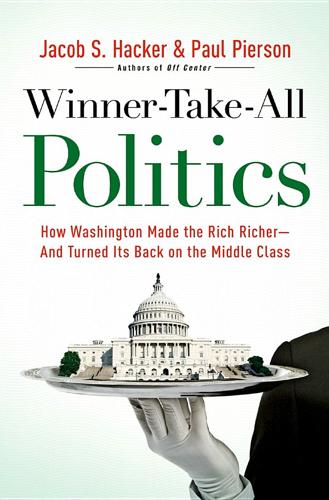
Winner-Take-All Politics: How Washington Made the Rich Richer-And Turned Its Back on the Middle Class
by
Paul Pierson
and
Jacob S. Hacker
Published 14 Sep 2010
Individual firms had little chance of fending off such broad initiatives on their own; to craft an appropriately broad political defense, they needed organization. Business was galvanized by more than perceived government overreach. It was also responding to the growing economic challenges it faced. Organization-building began even before the economy soured in the early 1970s, but the tumultuous economy of that decade—battered by two major oil shocks, which pushed up inflation and dragged down growth—created panic in corporate sectors as well as growing dissatisfaction among voters. The 1970s was not the economic wasteland that retrospective accounts often suggest. The economy actually grew more quickly overall (after adjusting for inflation) during the 1970s than during the 1980s.6 But against the backdrop of the roaring 1960s, the economic turbulence was a rude jolt that strengthened the case of business leaders that a new governing approach was needed.
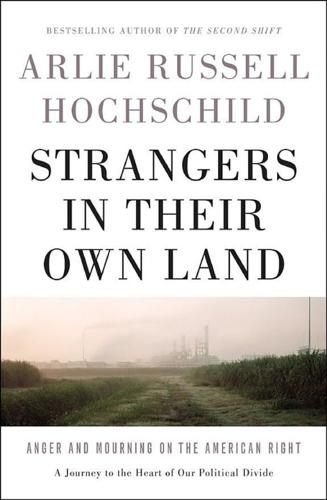
Strangers in Their Own Land: Anger and Mourning on the American Right
by
Arlie Russell Hochschild
Published 5 Sep 2016
Recently, economists at Princeton confirmed that the U.S. economy has grown faster under Democratic presidents, who have also produced more jobs, lowered the unemployment rate, generated higher corporate profits and investments, and seen higher stock market returns. They attribute this, however, to the timing of oil shocks and when major technologies debuted that had positive effects on the economy (e.g., the Internet under Clinton)—in other words, some of the correlation is due to factors outside a president’s control. Republican presidents have also added far more to federal debt levels than Democrats have, as a percent of GDP; since 1945, Reagan has added the most, with an almost 60 percent increase in federal debt to GDP.
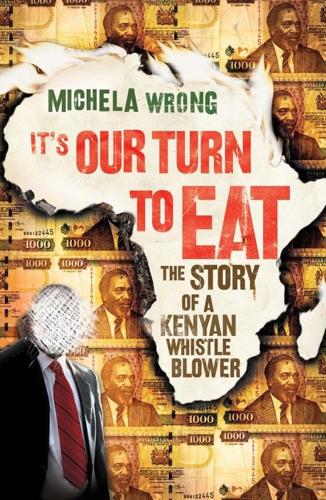
It's Our Turn to Eat
by
Michela Wrong
Published 9 Apr 2009
Kenya is one of a raft of African nations locked in a symbiotic – perhaps ‘mutually parasitic’ is a more accurate term – relationship with the developed world and the lending institutions set up at the Bretton Woods conference in the wake of the Second World War to combat global poverty. Post-independence, its agricultural sector received British support, but it was with the oil shocks of the 1970s and the collapse of commodity prices that Kenya's economy really began to depend heavily on loans, grants and investment from an industrialised world ready, as the Cold War locked Africa in its icy grip, to provide ‘no questions asked’ funding to any government rebuffing the Soviet Union and the Communist bloc.

The Looting Machine: Warlords, Oligarchs, Corporations, Smugglers, and the Theft of Africa's Wealth
by
Tom Burgis
Published 24 Mar 2015
Neither is he the sole corrupter of the Nigerian customs service – Shell has admitted paying bungs worth $2 million between 2004 and 2006 to Nigerian customs officials to smooth the importation of materials for Bonga, its giant offshore oilfield, part of a wider scheme in which the Swiss group Panalpina showered bribes on Nigerian officials, some on behalf of Shell, booking them as ‘evacuations’, ‘special handling’, and ‘prereleases’.23 But Mangal has scavenged the terrain laid waste by Dutch Disease, further weakening northern Nigeria’s chances of recovery. From the early 1970s to the mid-1980s, during the period when two oil shocks drove up the price of crude from $3 to $38 a barrel, Nigeria’s currency appreciated dramatically.24 The shift in the real naira exchange rate against the dollar sent a chill wind through the incipient industrial base. ‘This is what killed industries and agriculture, in conjunction with the power crisis,’ Nasir El-Rufai, the former minister, told me.
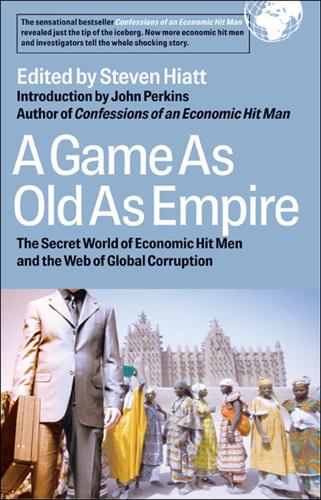
A Game as Old as Empire: The Secret World of Economic Hit Men and the Web of Global Corruption
by
Steven Hiatt; John Perkins
Published 1 Jan 2006
American Theocracy: The Peril and Politics of Radical Religion, Oil, and Borrowed Money in the 21st Century. New York: Viking, 2006. Rutledge, Ian. Addicted to Oil: America’s Relentless Drive for Energy Security. London: I. B. Tauris, 2005. Simmons, Matthew. Twilight in the Desert: The Coming Saudi Oil Shock and the World Economy. New York: John Wiley & Sons, 2005. Yergin, Daniel. The Prize: The Epic Quest for Oil, Money, and Power. New York: Free Press, 1993. General Union of Oil Employees: www.basraoilunion.org. Iraq Occuaption Focus, www.iraqoccupationfocus.org.uk/. Hub for news and analysis of the occupation of Iraq; publishes a free e-newsletter.
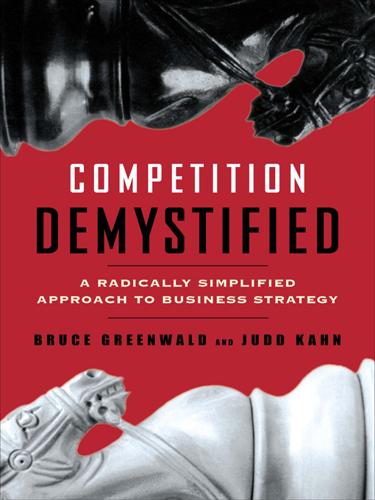
Competition Demystified
by
Bruce C. Greenwald
Published 31 Aug 2016
The adoption of jet aircraft, begun in the later 1950s and in full throttle over the next ten years, added enormous capacity to the trunk carriers. The planes held more passengers and traveled much faster. All the airlines were left with seats to spare, just as they had more debt to service to finance their new planes. The first oil shock of 1973–74 raised their operating expenses, as did inflation in the labor market. A weak economy dampened demands for seats. The situation was so dreary that the CAB sanctioned cooperation among the carriers to reduce capacity in major markets. Nothing helped. There were too many seats and not enough customers.
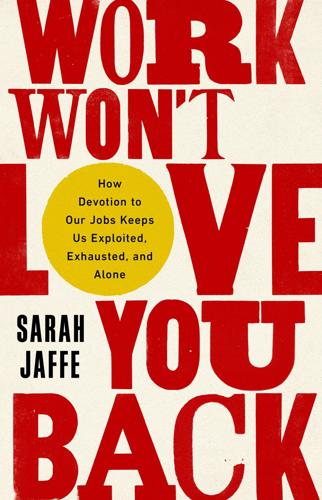
Work Won't Love You Back: How Devotion to Our Jobs Keeps Us Exploited, Exhausted, and Alone
by
Sarah Jaffe
Published 26 Jan 2021
Citizens became customers. Freedom was there, the neoliberals argued, you just had to purchase it. 14 Neoliberalism was born in Chile in 1973, when Augusto Pinochet overthrew the democratic socialist Salvador Allende and, with the advice of American economists, reorganized the economy by force. That year also brought oil shocks and a global downturn, a collapse in asset values, and the beginnings of a crisis for capitalism—unemployment and inflation were both rising, and social movements were demanding change. In that context, Pinochet cleared the way for neoliberalism with brutality and torture, despite the claims of “freedom.” 15 Despite the violence at its heart, neoliberalism would spread from Chile with the support of democratically elected governments.
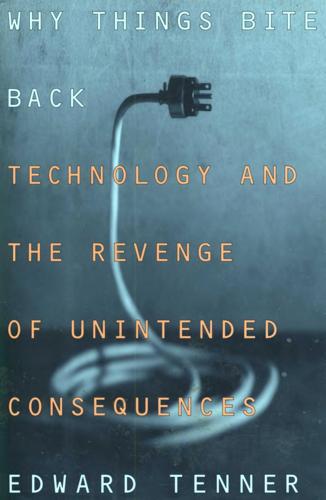
Why Things Bite Back: Technology and the Revenge of Unintended Consequences
by
Edward Tenner
Published 1 Sep 1997
No wonder that when better times returned after the Second World War, ambitious farmers were again breaking the soil, protesting the cost of maintaining terraces and shelterbelts, and fighting efforts to restrict their acreage. Drought returned in the mid1950s, bringing new dust storms, and the "filthy fifties" joined the "dirty thirties" in the region's vocabulary. And after another wave of expansion following the 1973 OPEC oil shock and the Soviet grain sale, there were still more dust storms in the mid- 97os, and a major drought in 1983.9 A combination of politics and technology turned an acute regional disaster into a chronic national problem. Crop insurance and credit have shifted much of the cost and risk of drought to the taxpayers and consumers.
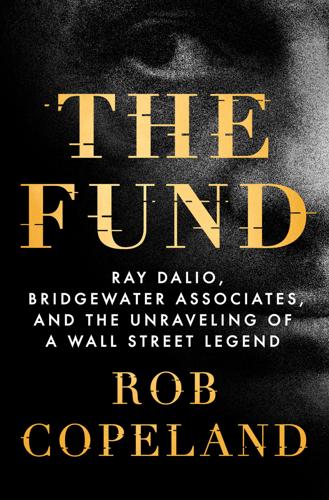
The Fund: Ray Dalio, Bridgewater Associates, and the Unraveling of a Wall Street Legend
by
Rob Copeland
Published 7 Nov 2023
Bunker Hunt: Dalio, Principles (2017). calling himself an economist: The Unemployment Crisis and Policies for Economic Recovery, Before the Joint Economic Committee, Congress of the United States, 97th Cong., 2nd sess., October 15, 20, and November 24, 1982, statement of Raymond T. Dalio. Markets were turbulent: Laurel Graefe, “Oil Shock of 1978–79,” Federal Reserve History, November 22, 2013. Dalio saw it differently: Jonathan Fuerbringer, “High Rates Called Drag on Recovery,” New York Times, March 1, 1982. “There is no hope”: Small Business Failures: Hearing Before the Subcommittee on Antitrust and Restraint of Trade Activities Affecting Small Business of the Committee on Small Business, U.S.
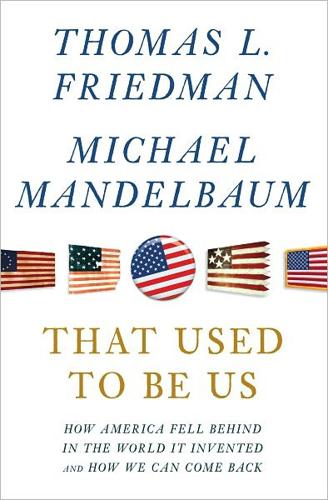
That Used to Be Us
by
Thomas L. Friedman
and
Michael Mandelbaum
Published 1 Sep 2011
“Imagine if, instead, the fuel economy level had grown just 2 percent per year after 1985,” said Harvey. “U.S. cars would have reached an average of forty-four miles per gallon this year, Detroit would be a technology leader, U.S. oil consumption would be three million barrels per day less.” We would have saved hundreds of millions of dollars, and the recent oil shocks would have been avoided or been far less severe. It is never too late to get this right, because the gains are so huge and the costs so low. In 2011, the Obama administration is expected to issue a proposal for new mileage standards to take us from 2017 to 2025. It is considering mandating annual improvements ranging from 3 percent to 6 percent.
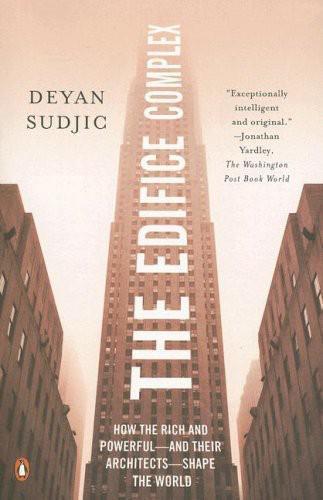
The Edifice Complex: How the Rich and Powerful--And Their Architects--Shape the World
by
Deyan Sudjic
Published 27 Nov 2006
Their work was entirely lacking in self-doubt; it seemed to represent the faithful and undiluted expression of an America born to rule. And when the Vietnam tragedy, and the burning of the ghettos of the 1960s, and the assassinations, destroyed the self-confidence and unassailability of that America, SOM’s confidence evaporated with it. Financially, SOM was battered and bruised by the post-Vietnam economic slump and the oil shock, but its real trauma was philosophical. It was no longer possible to build the way that Bunshaft had done. His generation had invested heavily in the aesthetic of swaggering restraint. It was more than a mannerism: he and his contemporaries had believed in it, regarded it as a moral imperative. When modernism began to be viewed not as a progressive force but as a deeply reactionary tendency, unpopular with both CEOs wanting to make a mark and radical opponents of urban redevelopment, they simply did not know how to respond.
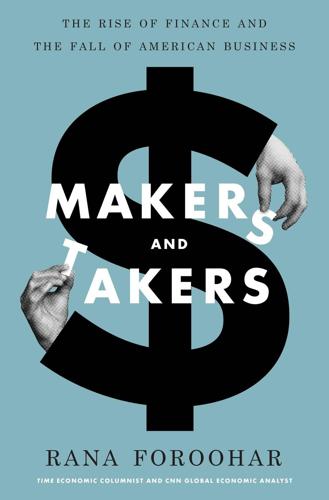
Makers and Takers: The Rise of Finance and the Fall of American Business
by
Rana Foroohar
Published 16 May 2016
And ironically, given the damage it would do to any number of firms, their idea was a response to a growing worry, sparked in the 1970s, that American business actually wasn’t really all that healthy at its core. Despite the confidence of the “organization man” and the large, global enterprises that he ran, a series of events—from oil shocks to higher inflation to swift advances into manufacturing being made by emerging economies like China and India—made people fear that the United States was losing ground. Postwar prosperity, which had always been taken as a given, was no longer guaranteed. The poverty rate was rising, inequality was on the upswing, and the hollowing out of American manufacturing had begun: that sector’s contribution to GDP dropped from 24 percent to around 17 percent in the mid-1970s.37 The term Rust Belt was invented to describe the collapse of once-great industrial cities like Buffalo, Pittsburgh, Cleveland, and Detroit.

The One Device: The Secret History of the iPhone
by
Brian Merchant
Published 19 Jun 2017
.… The Energizer, commercialized in 1980,” he notes, “was a remarkably close descendant of Planté’s invention. In more than a century, the science hadn’t changed.” Which is a little shocking, because the battery remains one of the largest silent forces that shape our experiences with technology. But the oil shocks of the 1970s—where oil embargoes sent prices skyrocketing and crippled economies—along with the advent of a new hydrogen battery for what Ford billed as the car of the future, gave the pursuit of a better battery a shot in the arm. Many consider it a travesty that the inventors of the lithium-ion battery haven’t yet won a Nobel Prize.
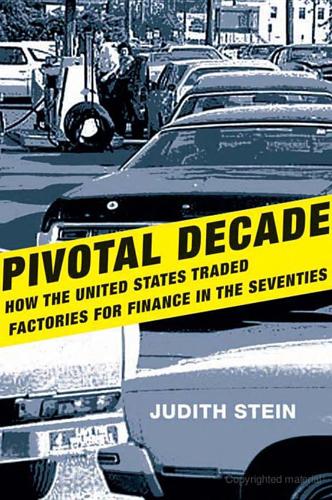
Pivotal Decade: How the United States Traded Factories for Finance in the Seventies
by
Judith Stein
Published 30 Apr 2010
Most Fed officials believed that monetarists were simplistic, calling them “the chiropractors of modern economics.”12 Fed governor Henry Wallich disparaged Friedman, who “implies that there are no fluctuations in the real economy that need affect monetary policy—no investment boom, no housing boom, no oil shocks. We should simply supply a steady growth of money.” Robert Mayo, president of the Fed bank in Chicago, remarked, “We have found no magic formula” to make “monetary policy as simple as some of our academic friends believe it can be made.”13 Volcker was not a monetarist, either. Thirteen years later, he said he acted only to give notice that the Fed meant business.14 It was the psychological, not technical, virtues that appealed to Volcker.
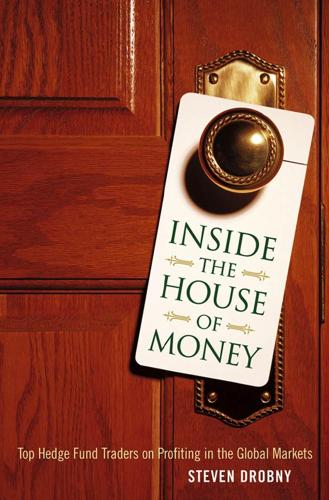
Inside the House of Money: Top Hedge Fund Traders on Profiting in a Global Market
by
Steven Drobny
Published 31 Mar 2006
I don’t want to underplay it because it has played an important role. It has brought inflation expectations right down to the target and that has had a lot of beneficial effects. In the old days, when oil prices went up, there was always a risk that you needed to tighten policy to ensure that inflation didn’t get out of hand. Now we’ve had two significant oil shocks since the Bank of England has been independent, and in neither case did they have to tighten policy, because wages and prices were well anchored by subdued inflation expectations.That’s a good outcome. There are other benefits from the reduction of inflation volatility, such as businesses being more willing to invest, and you don’t get unfair redistribution because of unexpected inflation.
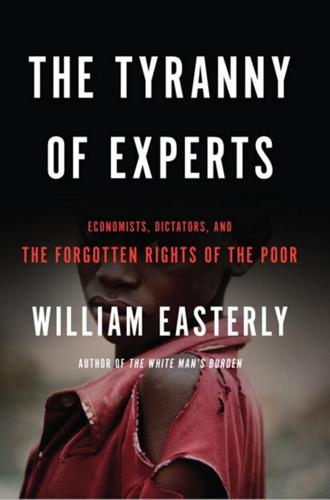
The Tyranny of Experts: Economists, Dictators, and the Forgotten Rights of the Poor
by
William Easterly
Published 4 Mar 2014
The traffic authorities in Los Angeles declared the Toyopet not roadworthy: the rearview mirrors were too small, the headlights too weak, and the turn signals did not signal.40 And the Toyopet cost 40 percent more than a VW Beetle. US sales of the Toyopet were not strong. A better-performing innovation was the Toyota Corolla in 1968, which by 1970 was already selling 200,000 units in the United States. The oil-price shocks in the 1970s shifted the global demand toward small cars. The Toyota Corolla was the perfect oil-shock car, with close to the highest fuel efficiency in the world. Toyota and other small-car Japanese automakers took off. By 1980, Japan was the world’s leading car exporter. The same names from automobile history are still around today among the top world automakers—Daimler, Mercedes, Benz, Peugeot, Renault, Ford, Porsche, Volkswagen, and Toyota—showing how long the private return from innovation for the monopolistic competitors really does last.
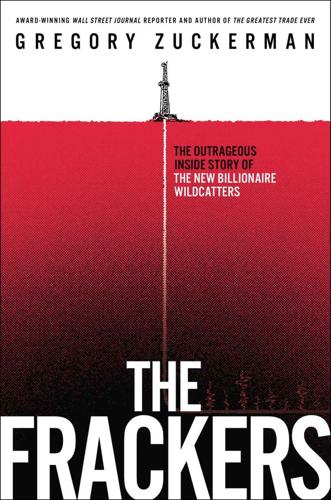
The Frackers: The Outrageous Inside Story of the New Billionaire Wildcatters
by
Gregory Zuckerman
Published 5 Nov 2013
Disregarding their advice, Hamm borrowed $90,000 to cover the expense of the well and hit a gusher producing two thousand barrels a day. The Bradleys, who received royalties from the well, took their cash and moved to Idaho to live with their grandchildren. Hamm purchased a company that drilled wells and operated rigs for other exploration companies. As oil prices soared on the heels of the oil shocks of 1973 and 1979, demand grew for his service and drilling companies.4 Hamm sometimes used his humble beginnings to outmaneuver rivals. In 1981, Bob Moore, a competitor in the trucking business, tried to entice Hamm to buy his operation. Moore traveled to Enid and spent over an hour discussing his business with him, according to Art Swanson, who worked for Moore at the time.
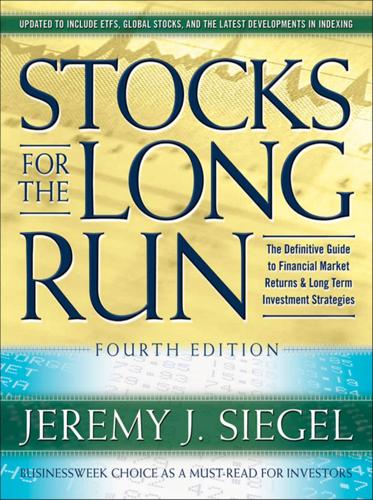
Stocks for the Long Run, 4th Edition: The Definitive Guide to Financial Market Returns & Long Term Investment Strategies
by
Jeremy J. Siegel
Published 18 Dec 2007
Suspensions of the gold standard and devaluations of currencies have witnessed some of the most dramatic stock market rallies in history. Investors agreed that gold was a monetary relic. POSTGOLD MONETARY POLICY With the dismantling of the gold standard, there was no longer any constraint on monetary expansion, either in the United States or in foreign countries. The first inflationary oil shock from 1973 to 1974 caught most of the industrialized countries off guard, and all suffered significantly higher inflation as governments vainly attempted to offset falling output by expanding the money supply. Because of the inflationary policies of the Federal Reserve, the U.S. Congress tried to control monetary expansion by passing a congressional resolution in 1975 that obliged the central bank to announce monetary growth targets.
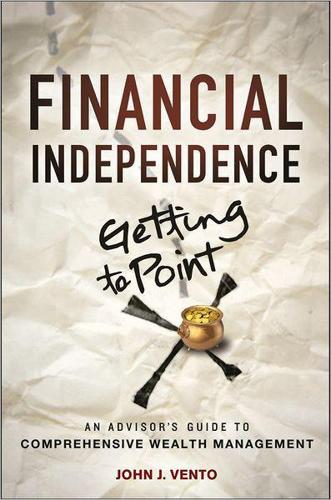
Financial Independence
by
John J. Vento
Published 31 Mar 2013
Just keep saving, and keep investing, with your long-term goal in mind. c08.indd 220 26/02/13 2:51 PM 9 C H A P T E R Managing Your Investments In the 20th century, the United States endured two world wars and other traumatic and expensive military conflicts; the Depression; a dozen or so recessions and financial panics; oil shocks; a flu epidemic; and the resignation of a disgraced president. Yet the Dow rose from 66 to 11,497. —Warren Buffett, most successful investor of the twentieth century T his chapter provides information and guidance for dealing with investment, beginning with basic definitions of various investment vehicles: stocks, bonds, mutual funds, and exchange-traded funds (ETFs).
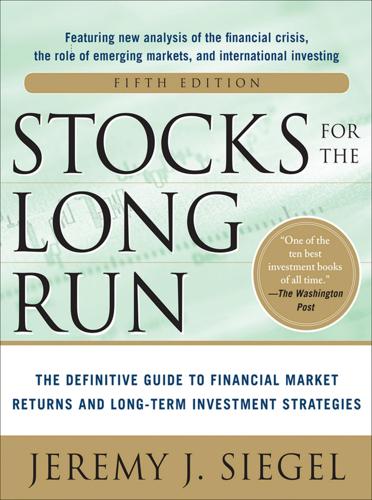
Stocks for the Long Run 5/E: the Definitive Guide to Financial Market Returns & Long-Term Investment Strategies
by
Jeremy Siegel
Published 7 Jan 2014
Suspensions of the gold standard and devaluations of currencies have witnessed some of the most dramatic stock market rallies in history. Investors agreed that gold was a monetary relic. POSTGOLD MONETARY POLICY With the dismantling of the gold standard, there was no longer any constraint on monetary expansion, either in the United States or in foreign countries. The first inflationary oil shock from 1973 to 1974 caught most of the industrialized countries off guard, and all suffered significantly higher inflation as governments vainly attempted to offset falling output by expanding the money supply. Because of the inflationary policies of the Federal Reserve, the U.S. Congress tried to control monetary expansion by passing a congressional resolution in 1975 that obliged the central bank to announce monetary growth targets.
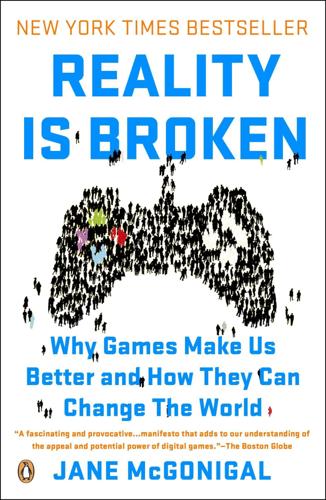
Reality Is Broken: Why Games Make Us Better and How They Can Change the World
by
Jane McGonigal
Published 20 Jan 2011
Create your own story of life during the oil crisis—and share it with us by e-mail or by phone call, by photos or by blog post, by videos or podcasts. Then join our citizen “nerve center” at worldwithoutoil.org to track events and share solutions. Every day, we’ll update you with news about the crisis, and highlight our favorite stories from across the country and around the world. No expert knows better than you do how an oil shock could impact your family, your job, your town, your life. So tell us what you know. Because the best way to change the future is to play with it first. Funded by the Corporation for Public Broadcasting and presented by the Independent Television Service (ITVS), World Without Oil was first conceived by Ken Eklund, an independent writer and interactive developer based in San Jose, California.
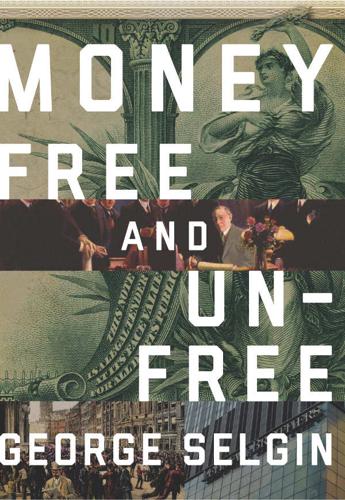
Money Free and Unfree
by
George A. Selgin
Published 14 Jun 2017
. ——— (1908) “The Aldrich-Vreeland Act.” Journal of Political Economy 16 (8): 489–513. Lautz, F. W. (1877) “How National Bank Notes Are Redeemed.” Galaxy 23 (5): 647–56. Lebergott, S. (1964) Manpower in Economic Growth: The American Record since 1800. New York: McGraw-Hill. Leduc, S., and Sill, K. (2007) “Monetary Policy, Oil Shocks, and TFP: Accounting for the Decline in U.S. Volatility.” Review of Economic Dynamics 10 (4): 595–614. Leijonhufvud, A. (1981) “The Costs and Consequences of Inflation.” In Information and Coordination, 227–69. New York: Oxford University Press. ——— (2009) “Out of the Corridor: Keynes and the Crisis.”
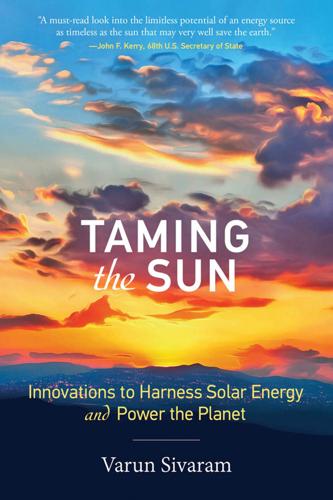
Taming the Sun: Innovations to Harness Solar Energy and Power the Planet
by
Varun Sivaram
Published 2 Mar 2018
It’s an engineering marvel. After three decades and $25 billion in construction costs, Rokkasho is finally set to open in 2018. Rokkasho is a symbol of a Japanese obsession: energy security. An island nation with negligible domestic energy resources, Japan has fretted about its energy security ever since the oil shocks of the 1970s. And for most of the last half-century, nuclear power has anchored its strategy to seize control of its energy supply. Yet even as Rokkasho prepares to start recycling nuclear fuel to end Japan’s dependence on imports, most of its nuclear reactors have been shuttered. As a result, a desperate Japan is now looking to urgently ramp up its supply of solar power to achieve energy self-sufficiency.

Straphanger
by
Taras Grescoe
Published 8 Sep 2011
For those who prefer their lives bubble-wrapped in gated communities, sports utility vehicles, and security-patrolled malls, public transport will probably always seem seedy, dangerous, and inconvenient. But around the world, there is a revolution going on in the way people travel. It is rewriting the DNA of formerly car-centered cities, making the streets better places to be, and restoring something cities sorely need: real public space. The Great Oil Shock The United States is the most extravagantly motorized nation in the history of the world.* At the end of the first decade of the twenty-first century, the country was home to 255 million registered vehicles, but only 196 million licensed drivers; in other words, cars and trucks now outnumber drivers by a factor of 5 to 4.
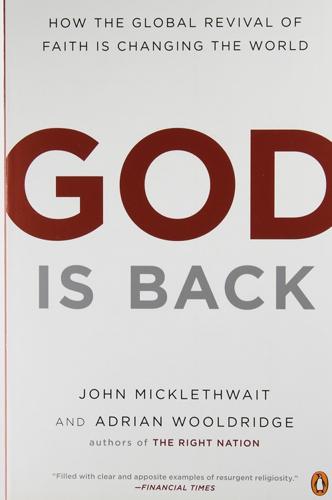
God Is Back: How the Global Revival of Faith Is Changing the World
by
John Micklethwait
and
Adrian Wooldridge
Published 31 Mar 2009
Believers see a populist revolt against the overreach of elitist secularism—be it America’s Supreme Court legalizing abortion or Indira Gandhi harrying Hindus. From a more secular viewpoint, John Lewis Gaddis, a Yale historian, points out that the religious revival in the 1970s coincided with the collapse of secular “isms.” By then the Soviet Union’s evils had made a mockery of Marxism, and capitalism had also hit some buffers (the oil shocks, hyperinflation). More generally, politicians’ ability to solve problems such as crime or unemployment was thrown into doubt: faith in government tumbled just about everywhere in the 1970s—and has stayed low since. And why has religion’s power continued to increase? Most obviously, there has been a series of reactions and counterreactions.
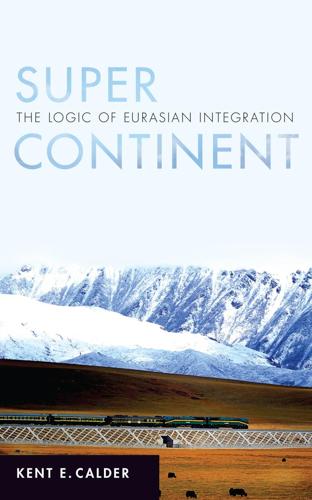
Super Continent: The Logic of Eurasian Integration
by
Kent E. Calder
Published 28 Apr 2019
In both the Japanese and continental Asian cases (especially South Korea, but China as well), revival was enhanced by the formidable strength of America’s post–World War II economy, and the related expansion of transpacific trade. Eurasian reconnection was not a factor in all this transpacific prosperity. Following the oil shocks of the 1970s, however, the Persian Gulf surged forward, sustained by its massive oil and gas reserves and growing demand Eurasian Reconnection and Renaissance 3 Unit: Percent 100 100 90 90 80 80 70 70 60 60 50 50 40 40 30 30 20 20 10 10 0 – 1 1000 China 1500 India 1600 1700 Other Eurasia 1820 1870 1913 United States 1950 1973 Other ROW 2001 Eurasia 2015 ROW figure 1.1 The fall (and rise) of Eurasia (1–2015 AD) s o u r c e s : For GDP figures between 1 and 2001 AD, see Angus Maddison, The World Economy: Historical Statistics (Paris: OECD, 2003), Table 8b.
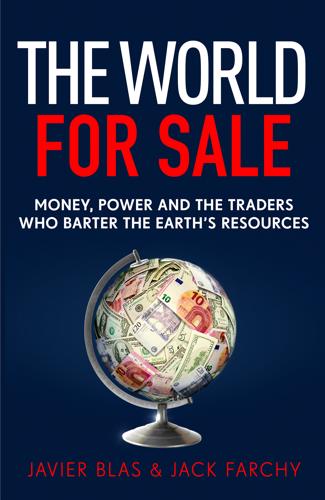
The World for Sale: Money, Power and the Traders Who Barter the Earth’s Resources
by
Javier Blas
and
Jack Farchy
Published 25 Feb 2021
Rich had arranged for a shipment of Venezuelan crude he was delivering to the east coast of the US to stop off in Kingston on the way. On Saturday evening, less than 24 hours before Jamaica was due to run out, it unloaded 300,000 barrels of oil. The trade was a demonstration of the massive power that Marc Rich now wielded thanks to his mastery of the oil market. The oil shocks of the 1970s had filled the coffers of the commodity traders, and they combined their new-found financial might with a chutzpah that few other investors could match. By the 1980s, staking their money where other companies wouldn’t dare was the commodity traders’ trademark. Jamaica was a prime example: the country was on the brink of bankruptcy, shunned by its lenders, and Rich had just delivered the government oil worth $10 million without even signing a contract.
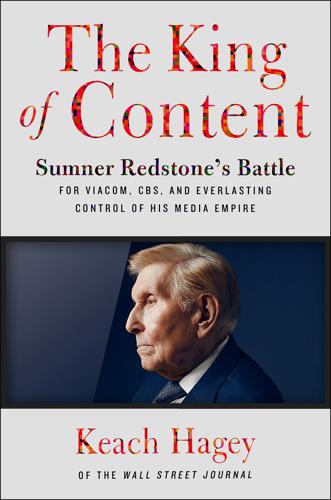
The King of Content: Sumner Redstone's Battle for Viacom, CBS, and Everlasting Control of His Media Empire
by
Keach Hagey
Published 25 Jun 2018
Chapter 8 Forged in Fire Early on the morning of March 28, 1979, the Three Mile Island nuclear reactor just south of Harrisburg, Pennsylvania, partially melted down, causing the worst nuclear disaster in American history and sewing panic in a nation already on edge from a decade of inflation and oil shocks. President Jimmy Carter would attempt to calm the country by touring the reactor, his feet swathed in yellow plastic booties, and a few months later diagnose its spiritual ills in a speech decrying America’s “crisis of confidence.” But, amid the timeless limestone grandeur of Boston’s old hotels, things proceeded very much the same way that they had for a generation.
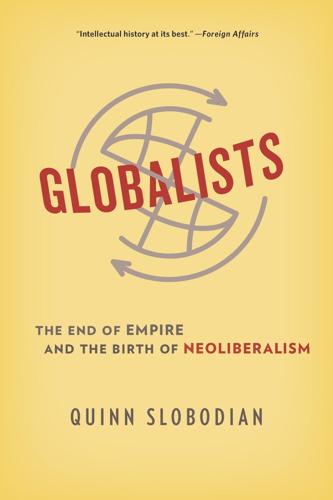
Globalists
by
Quinn Slobodian
Published 16 Mar 2018
In the wake of the mystification of the world economy, the Geneva School neoliberals’ most important field of influence was not in economics per se but in international law and international governance. The century’s third rupture came not so much with the Second World War or the Cold War—neither of which have much of a presence in the neoliberal century—but with the revolt of the Global South in the 1970s. The oil shock of 1973–1974 placed postcolonial actors at center stage. Robust demands for economic redistribution and stabilization were enshrined in the Declaration of a New International Economic Order championed by the world’s poorer nations and passed by the UN General Assembly in 1974. Confronting both the Global South and the boom in computer-aided models of global reform in the 1970s, the Geneva School developed their own vision of a world economy without numbers—a world of information and rules.
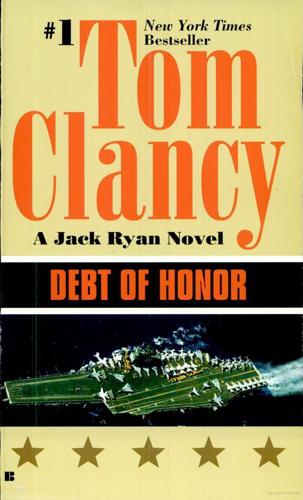
Debt of Honor
by
Tom Clancy
Published 2 Jan 1994
The "compact" cars that the American manufacturers had started making in the previous decade had almost immediately grown to midsize, were no more fuel-efficient than their larger cousins, and weren't all that well made in any case. Worst of all, the American manufacturers, to a man, had all recently invested money in large-car plants, a fact that had almost been the undoing of Chrysler. This oil shock had not lasted long, but long enough for America to rethink its buying habits, and the domestic companies had not possessed the capital or the engineering flexibility to change rapidly to what unaccustomedly nervous American citizens wanted. Those citizens had immediately increased purchases of Japanese automobiles, especially in the crucial, trend-setting West Coast markets, which had had the effect of funding research and development for the Japanese firms, which in turn had hired American styling engineers to make their products more attractive to their growing market and utilized its own engineers to improve such things as safety.
…
Those citizens had immediately increased purchases of Japanese automobiles, especially in the crucial, trend-setting West Coast markets, which had had the effect of funding research and development for the Japanese firms, which in turn had hired American styling engineers to make their products more attractive to their growing market and utilized its own engineers to improve such things as safety. Thus, by the second great oil shock of 1979, Toyota, Honda, Datsun (later Nissan), and Subaru were in the right place with the right product. Those were the salad days. The low yen and high dollar had meant that even relatively low prices guaranteed a handsome profit, that their local dealers could add a surcharge of a thousand dollars or more for allowing people to purchase these marvelous automobiles—and that had given them a large, eager sales force of American citizens.
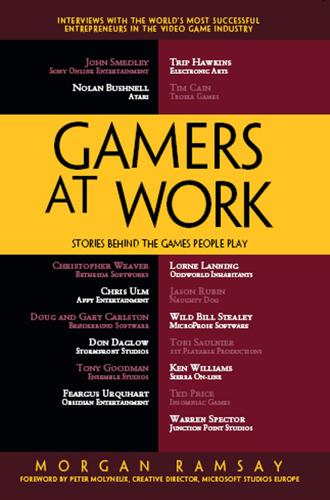
Gamers at Work: Stories Behind the Games People Play
by
Morgan Ramsay
and
Peter Molyneux
Published 28 Jul 2011
Neither set of programs used the full capabilities of even the early personal computers. I wrote some games to develop my programming skills and for fun. I sold those games through a Florida company called Adventure International, and it wasn’t long before the revenue matched my other sources of income. The oil shocks of the 70s had dried up the housing market, and I was bored with practicing law, so I was looking for an alternative. Gary: I had spent the previous three years trying to get a couple of other businesses started, one with a friend and one with my brother Doug. My brother had moved out to Oregon from Maine to share an apartment with me and had brought his TRS-80 computer with him.
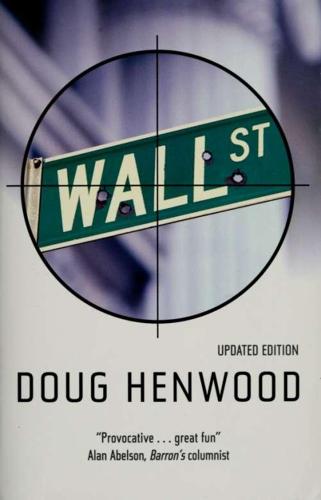
Wall Street: How It Works And for Whom
by
Doug Henwood
Published 30 Aug 1998
Gold first began trading freely in 1968, and it immediately broke away from the classic $35 an ounce price, set in 1934, when the Roosevelt administration banned private ownership of monetary gold. The price rose slowly, breaking gently above $40 as the decade turned. Once the U.S. abandoned convertibility, however, gold started a ripping bull market. Reaching a first peak just under $200 in oil-shocked 1974, the price settled back with the recession, and turned up with the world economy in 1976 in a spectacular rise that ended at $850 an ounce in January 1980. From there, when the Volcker clampdown took hold, gold sank almost unrelievedly to below $300 in 1985. After 1985, it spent ten years going nowhere — which should be no surprise over the long term, given the metal's reputation as 1400 1200 1000 800 600 400 200 0 real gold price, 1934^98(1998$) 1998: first quarter only 1934 1944 1954 1964 1974 1984 1994 INSTRUMENTS a sterile repository of value.
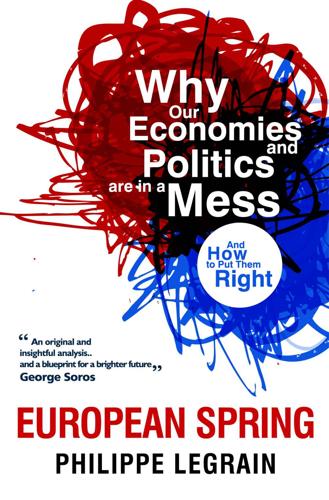
European Spring: Why Our Economies and Politics Are in a Mess - and How to Put Them Right
by
Philippe Legrain
Published 22 Apr 2014
This deceptively stable environment tricked policymakers into thinking they could plan economic development while fine-tuning demand to maintain full employment. But the system broke down in the early 1970s as the post-war economic boom ran out of steam, efforts to boost employment resulted in ever higher inflation, the Bretton Woods system of currencies pegged to the US dollar collapsed and the oil shocks of 1973–74 resulted in the previously unthinkable combination of stagnation and inflation: stagflation. In this new stop-go world, controlling inflation became the top priority of economic policy and monetary policy the preferred tool for economic management, with central banks causing short, sharp recessions by raising interest rates whenever inflation looked like getting out of hand.
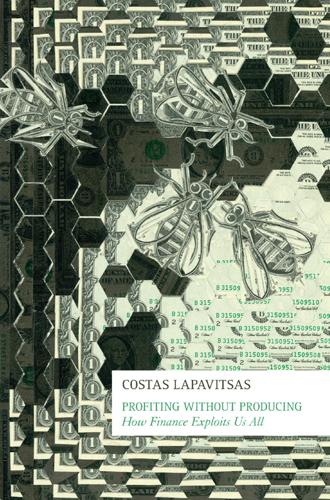
Profiting Without Producing: How Finance Exploits Us All
by
Costas Lapavitsas
Published 14 Aug 2013
Its demise was due in part to the accumulation of US dollars abroad which propelled the growth of ‘Euromarkets’. International dollar hoards increased as the US economy registered persistent trade deficits, leading to growing inability of US authorities to honour the pledge of converting the dollar into gold at a fixed price. The accumulation of dollars became even greater after the first oil shock of 1973, thus catapulting the Euromarkets toward further growth.9 The failure of Bretton Woods was a reflection of the changing balance in the world market as the relative weight of the US economy declined. For our purposes, however, what matters is that the collapse of Bretton Woods eventually led to lifting controls on the capital account.

Connectography: Mapping the Future of Global Civilization
by
Parag Khanna
Published 18 Apr 2016
RESOURCE GENES AND DATA CENTERS FOR FOOD The global mineral and food systems are in perpetual flux, with production expanding and contracting based on climate, technology, geopolitics, and other factors. For years, the extraction and processing of rare earth minerals was controlled by a small number of mostly state-owned companies in China—allowing them to rattle the entire electronics supply chain when China temporarily banned the export of rare earth minerals in 2011. But as with the oil shocks of the 1970s, geopolitical risk has spurred the United States, Canada, India, Kazakhstan, and Australia to invest in excavating new supplies.9 Just as distributed energy supplies and alternative and renewable energy technologies have ended OPEC’s grip on oil prices, it is better to have diverse mineral suppliers as well.
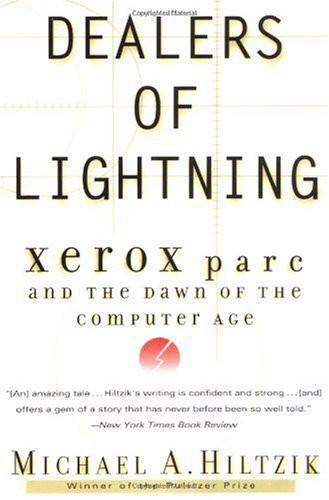
Dealers of Lightning
by
Michael A. Hiltzik
Published 27 Apr 2000
This was the so-called “Bose Conspiracy,” which was hatched at a poker game at Rick Jones’s house. Jones, Kay, Thacker, Dick Shoup, Chuck Geschke, and a couple of others had fallen into a discussion of the merits of stereo speakers. Kay was a particular fan of the state-of-the-art Bose 901s, which came with their own electronic equalizer and cost $1,100 the set (in the pre-oil shock dollars of the early 1970s). He was also the only one in the group who owned a pair, having acquired them on his PARC budget as part of a real-time music synthesizer his group was developing. “You know,” someone said as cards riffled in the background, “there’s no reason why we couldn’t make the electronics work just as well.
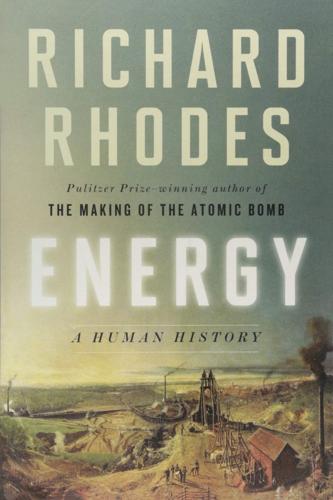
Energy: A Human History
by
Richard Rhodes
Published 28 May 2018
In his 2007 review, Luis de Sousa questioned Marchetti’s graphic predictions. De Sousa offered a revised version, reproduced on the next page, that reflects the changes that followed the 1973–74 Arab oil embargo. “In large measure,” de Sousa writes, “the real data moved away from the model of the 1970s. This was probably due to the oil shocks that upset the market, but the prolonged effects are not as easily explainable. What immediately emerges to view is that after the oil crisis was surpassed in the 1980s, the market seems to have frozen, with each energy source maintaining its market share.”21 De Sousa comments in turn on each of the graph’s energy components.
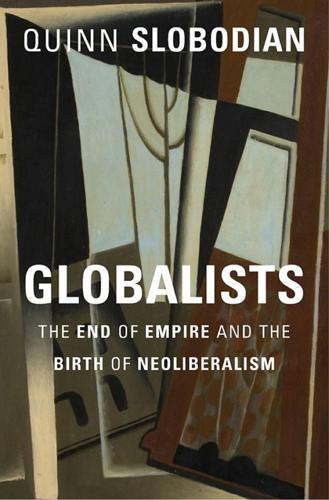
Globalists: The End of Empire and the Birth of Neoliberalism
by
Quinn Slobodian
Published 16 Mar 2018
In the wake of the mystification of the world economy, the Geneva School neoliberals’ most important field of influence was not in economics per se but in international law and international governance. The century’s third rupture came not so much with the Second World War or the Cold War—neither of which have much of a presence in the neoliberal c entury—but with the revolt of the Global South in the 1970s. The oil shock of 1973–1974 placed postcolonial actors at center stage. Robust demands for economic redistribution and stabilization were enshrined in the Declaration of a New International Economic Order championed by the world’s poorer nations and passed by the UN General Assembly in 1974. Confronting both the Global South and the boom in computer-a ided models of global reform in the 1970s, the Geneva School developed their own vision of a world economy without numbers—a world of information and rules.

The Rise and Fall of the Neoliberal Order: America and the World in the Free Market Era
by
Gary Gerstle
Published 14 Oct 2022
Richard Nixon and his successor Gerald Ford, both coming of age politically under the aegis of the New Deal order, faithfully deployed the various Keynesian instruments available in their toolkit.26 They lowered interest rates to make borrowing easier and cut taxes to put more money in the hands of consumers. Some stability returned in 1976 and 1977. Then came a second oil shock, triggered by a 1978–1979 Iranian revolution that deposed the shah, a close friend of the West, and brought to power the Middle East’s first radical Islamic regime. This regime followed Saudi Arabia’s 1973 lead in shutting off the flow of Iran’s petroleum to the United States, spiking oil prices once again, this time by 50 percent.27 Major American industries, dealing with softness in demand since 1973, now cratered.
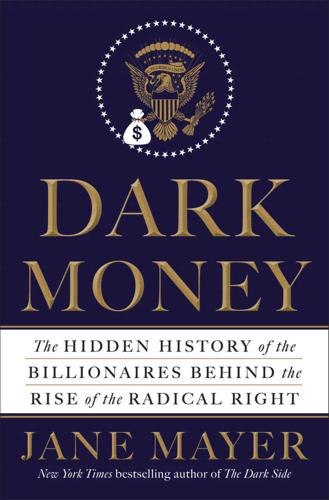
Dark Money: The Hidden History of the Billionaires Behind the Rise of the Radical Right
by
Jane Mayer
Published 19 Jan 2016
Jeffrey Clements, in Corporations Are Not People, suggests Powell’s defense of the tobacco companies was a harbinger of the corporate rights movement and a big part of what led him to push in his memo for conservatives to empower more pro-business courts. Exacerbating corporate America’s woes, the economy was buckling from “stagflation,” the unusual combination of high inflation and high unemployment. There were oil shocks and gas lines as well. And after generations of redistributive progressive income and inheritance taxes, the economic elite was losing its lead. Income in America during the mid-1970s was as equally distributed as at any time in the country’s history. “No thoughtful person can question that the American economic system is under broad attack,” Powell declared in his memo.

MacroWikinomics: Rebooting Business and the World
by
Don Tapscott
and
Anthony D. Williams
Published 28 Sep 2010
Over the same thirty-year period, Denmark changed from being an economy that was entirely dependent on energy imports to a net exporter of both electricity and energy technology.22 Had the United States maintained its energy consumption at 1980s levels, Americans would not need any of the fuel they currently use today to transport themselves around the country. Granted Denmark is a country of five million citizens and it’s geographically much smaller than the United States. But its achievements are nevertheless remarkable, especially in light of its starting point. The 1970s oil shock hit Denmark harder than many of its European neighbors. At the time, every last drop of oil was imported. When prices rose dramatically the entire economy was crushed. Anne Højer Simonsen of the Danish Ministry of Climate and Energy recalls the sacrifices. “When I was a child, each Sunday, you could not ride on the highways.
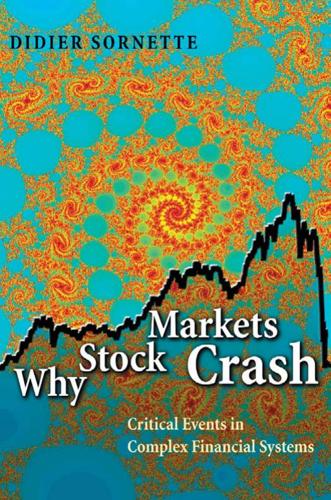
Why Stock Markets Crash: Critical Events in Complex Financial Systems
by
Didier Sornette
Published 18 Nov 2002
The straight lines are the best fits, which qualify as power law behavior, as explained in the text, and suggest an abrupt transition at 2050. 3. From 1933 to the present, there were some strong inflationary periods associated with World War II, the Cold War, the Korean war, the Vietnam war, as well as the oil shocks of the seventies. The factor 15 thus corresponds approximately to an average annual inflation rate of 4% since 1933. We present in Figure 10.5, the long-term time evolution of the debt of the U.S. federal government. There seems to be a relationship (a factor 2, approximately) between the growth of this debt and inflation rates.

Red Plenty
by
Francis Spufford
Published 1 Jan 2007
For help was arriving from an unexpected direction. In 1961, the first oilfield had been discovered in western Siberia, and by 1969 geologists – many working out of Akademgorodok – had identified almost sixty of them, brimming with saleable crude. They were just about all on-line and pumping in time for the 1973 oil shock, when the world price for petroleum rose by 400%. Suddenly, instead of being a giant autarchy, trying to bootstrap its way to prosperity, the Soviet Union was a producer for the world market, and it was awash with petrodollars. Suddenly, it was possible for the Soviet leadership to buy its way out of some of the deficiencies of the economy.
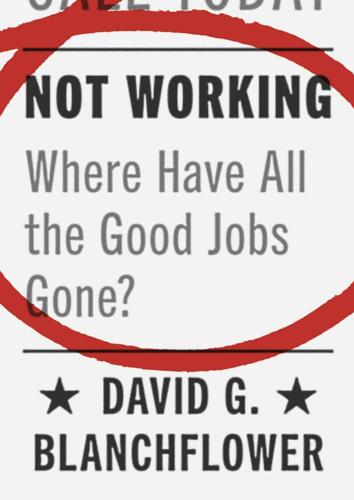
Not Working: Where Have All the Good Jobs Gone?
by
David G. Blanchflower
Published 12 Apr 2021
Those with protective labor market institutions like Germany and Austria did best. The ILO, for example, argued rightly even before the onset of recession as follows: “Labour market rigidities have not been an underlying cause of past labour market performance. Labour market performance has deteriorated since the first oil shock irrespective of differences in labour market regulation, suggesting that a more fundamental common factor (or factors) has been at work” (1995, 20). Contrary to what many have claimed, labor market institutions do not tend to cause unemployment. The major exception is changes in the replacement rate, which, in some specifications, do appear to be negatively correlated with changes in the unemployment rate.
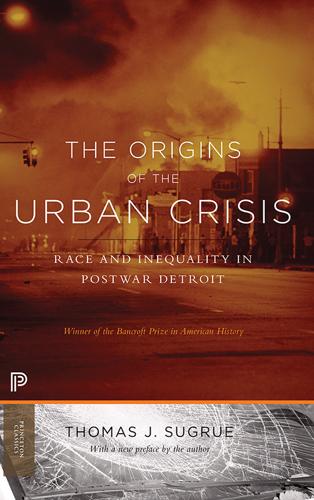
The Origins of the Urban Crisis
by
Sugrue, Thomas J.
Above all, I contended racial inequalities persist because of the mutually reinforcing processes of ideology and political economy, of identity and self-interest.9 Origins is also an account of postwar American political economy, of the ways that corporations, aided by state and federal policies, reorganized capital and workplaces. Above all, it argues that the process of capital mobility and urban devastation began amidst the post—World War II economic boom. When I wrote Origins, most popular and scholarly analyses of deindustrialization focused on the 1970s, in particular the oil shocks, the rise of international competition in industries which America had long dominated, and globalization, as corporations roamed the globe in search of cheap labor. A spate of recent historical scholarship on the industrial transformation of twentieth-century America (a subfield that has taken off in recent years) bears out my argument about the crucial role that capital flight and the introduction of labor-saving technologies played in the devastation of urban America well before the 1970s.

The Technology Trap: Capital, Labor, and Power in the Age of Automation
by
Carl Benedikt Frey
Published 17 Jun 2019
Yet if economic progress was just a race between technology and education, we would expect the wages of the skilled to pull away from those of the rest, but we would not expect the wages of the unskilled to fall. Inequality could grow, but everyone would still see their wages rise—though at different speeds. The great reversal depicted in figure 10 was first noted by Daron Acemoglu and David Autor.1 It shows that up until the 1970s, wages rose for people at all educational levels, but after the first oil shock in 1973, wages fell and then stagnated for all Americans for about a decade. The great reversal began in the 1980s, when the wages of those with no more than a high school diploma began to fall again and continued to do so for three consecutive decades. This decline, as figure 10 shows, has primarily occurred among unskilled men who would have taken on jobs in the factories before the dawn of automation. 9 THE DESCENT OF THE MIDDLE CLASS The computer era does not just mark a shift in labor markets.

The Library: A Fragile History
by
Arthur Der Weduwen
and
Andrew Pettegree
Published 14 Oct 2021
But again, as with radio, the book world would profit from the obvious crossover opportunities afforded by new editions of books dramatised on television, epitomised by the unlikely success of John Galsworthy’s Forsyte Saga (1906–21), a set of which would decorate the shelves of millions of homes after a twenty-six-part serialisation by the BBC in 1967. Documentaries and comedy series proved equally lucrative sources of spin-off titles, which boosted the revenues of the BBC and increasingly dominated the UK bestselling lists by the 1980s.22 It was not competing media then, but rather the economic tribulation of the 1960s and the oil shocks of the 1970s that squeezed public finances and caused the first sustained downturn in the fortunes of the public library. Opening hours were trimmed, buildings went unrepaired, book budgets declined. At first, public reaction to these economies was muted. Now that libraries were in serious competition with other public services for diminishing funds, many of those who would have been expected to support their case for public funds were no longer regular users.
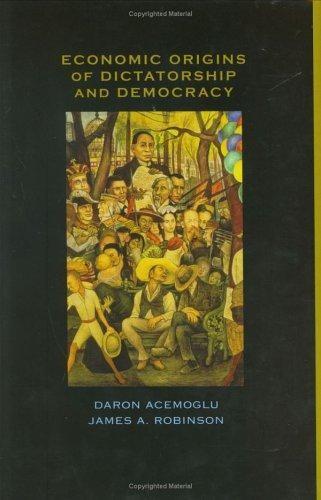
Economic Origins of Dictatorship and Democracy
by
Daron Acemoğlu
and
James A. Robinson
Published 28 Sep 2001
For instance, with respect to the First wave before the First World War, he emphasized modernization, urbanization, creation of a middle class, and decreasing inequality (p. 39). In the second wave his emphasis shifted to the impact of the Second World War and the collapse of empires (p. 40). With respect to the third wave, Huntington lists five factors as being important (pp. 45–6): (1) a crisis of authoritarian legitimacy created by economic recession induced by the oil shocks of the 1970s and the international debt crisis of the 1980s; (2) the income growth and increase in education experienced in the 1960s; (3) the change in the attitude of the Catholic church; (4) the changes in the attitudes of international institutions, the United States, and the Soviet Union; and (5) the “snowballing” or demonstration effects that led to contagion and the international dissemination of democracy.

The Berlin Wall: A World Divided, 1961-1989
by
Frederick Taylor
Published 26 May 2008
Cheap raw materials and oil from Russia made up for the truncated state’s lack of natural resources, and favourable price agreements compensated for the lack of real productivity increases in the GDR’s industry. In the mid-1970s, the Soviet Union raised its prices for vital supplies of fuel and raw materials. In 1979-80 came the second ‘oil shock’, and the Soviet 374 / THE BERLIN WALL Union reduced its oil deliveries to the GDR. The country slid into a situation of massive indebtedness to both the USSR and the West.15 The GDR was in a state of crisis that continued for the rest of its existence. For Honecker, it had become an article of faith that the people must be kept happy with consumer goods and social benefits, or the regime would risk another 1953.
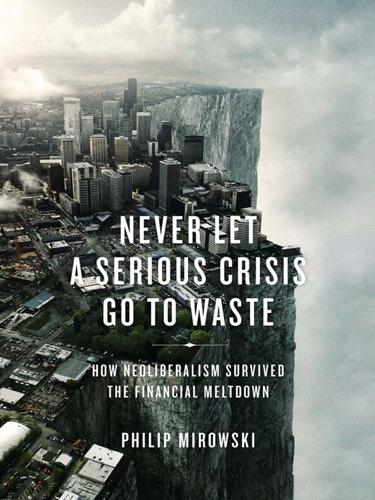
Never Let a Serious Crisis Go to Waste: How Neoliberalism Survived the Financial Meltdown
by
Philip Mirowski
Published 24 Jun 2013
“Equilibrium” points to the assumptions that supply and demand balance out rapidly and unfailingly, and that competition reigns in markets that are undisturbed by shortages, surpluses, or involuntary unemployment. “Dynamic” means that the model looks at the economy over time rather than at an isolated moment. “Stochastic” corresponds to a specific type of manageable randomness built into the model that allows for unexpected events, such as oil shocks or technological changes, but assumes that the model’s agents can assign a correct mathematical probability to such events, thereby making them insurable. Events to which one cannot assign a probability, and that are thus truly uncertain, are ruled out. The agents populating DSGE models, functioning as individuals or firms, are endowed with a kind of clairvoyance.

Aftershocks: Pandemic Politics and the End of the Old International Order
by
Colin Kahl
and
Thomas Wright
Published 23 Aug 2021
Trump tweeted, Now that our Country is “Transitioning back to Greatness,” I am considering rescheduling the G-7, on the same or similar date, in Washington, D.C., at the legendary Camp David. The other members are also beginning their COMEBACK. It would be a great sign to all—normalization!1 Created in 1975 as a response to the oil shock and economic recession, what would become the G7 originally included just four countries: France, the United Kingdom, Germany, and the United States. Japan, Canada, Italy, and the EU joined later, as did Russia for a time (although it was expelled after its annexation of Crimea in 2014). As a club of the world’s wealthiest democracies, it was a forum for leaders to deal with global crises as well as to make long-term improvements to the international order.
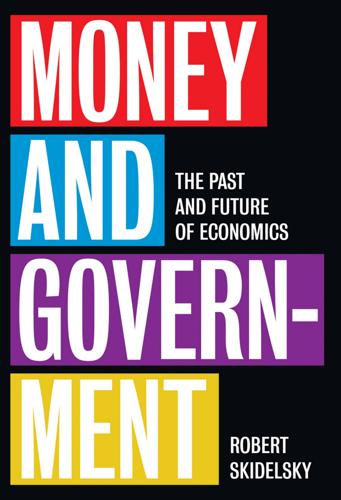
Money and Government: The Past and Future of Economics
by
Robert Skidelsky
Published 13 Nov 2018
The rise in the cost of major input prices, unaccompanied by falls in real wages, reduced profitability. In 1975, inflation peaked at 30 per cent in Japan and at 25 per cent in the UK. The combined current account of OECD countries moved from a small surplus in 1973 to a deficit of $33 billion in 1974. The oil shock had a contractionary effect on OECD economies in 1974–5, which this time governments made little attempt to offset. Between July 1974 and April 1975 industrial production fell by 10 per cent, with big falls in the prices of industrial materials, commodities and food. Unemployment rose from 8 million to 15 million – up to 5.5 per cent, though this understates the extent of the problem since much of the adjustment to lower labour demand took the form of under-employment, and the net return of migrant labour in Europe.
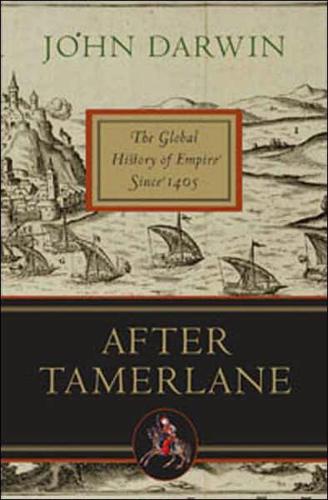
After Tamerlane: The Global History of Empire Since 1405
by
John Darwin
Published 5 Feb 2008
Between 1960 and 1975 its share of world exports never rose above 4 per cent.84 America’s share of the world’s manufactured exports was 13 per cent in 1976.85 The free-market economy of which it formed the pivot took the lion’s share of international commerce. The third was the persistent instability of the large ‘frontier’ zone where the two world powers strove to assert their claims. This turbulence sprang from the travails of state-building in ex-colonial lands, anti-colonial conflicts in parts of Africa, and economic upheaval in the 1970s (the ‘oil shock’ of 197 3 and the drastic rise in the price of fuel). It created a hunger for arms and aid by regimes and their rivals. It ensured a constant demand for superpower sponsors, and fed the domino mentality of superpower strategists. It created an ever-widening sphere in the Outer World where they waged war by proxy.
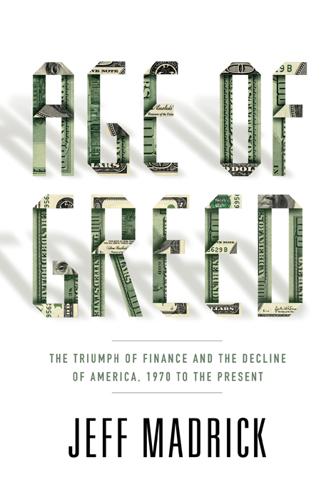
Age of Greed: The Triumph of Finance and the Decline of America, 1970 to the Present
by
Jeff Madrick
Published 11 Jun 2012
Crop failures raised food prices rapidly, adding the most to inflation; OPEC quadrupled oil prices, adding about half as much; and the end of the Nixon price freeze and the new voluntary Phase IV unleashed a wide range of price hikes. Alan Blinder computed that the explosion in prices in 1974 resulting from the relaxation of controls had about two thirds again the impact that the OPEC oil shock did. In the second half of 1973, consumer prices rose on average by an annual rate of 10 percent and, through most of 1974, they rose by an annual rate of 12 percent, almost half of which was due to these three unique factors. Interest rates also rose rapidly. Those who bought homes had to pay 9 to 10 percent in interest for conventional mortgages in 1973 and 1974, not the 7 percent paid two years earlier or the 4 or 5 percent that prevailed in the 1960s.

The Crisis of Crowding: Quant Copycats, Ugly Models, and the New Crash Normal
by
Ludwig B. Chincarini
Published 29 Jul 2012
As consumers stop consuming, producers must lower prices, which then leads to consumers expecting lower prices in the future and holding back consumption even longer, which leads to further price declines and the economy continues to stagnate. This is particularly dangerous for the economy, as consumption is one of the main driving forces for short-term economic growth. Inflation was subdued from 1933 to 1970. Then of course, came the well-known oil shocks of the 1970s. The OPEC cartel coordinated to raise oil prices causing a large increase in the prices of all goods, as suppliers passed these price increases on to consumers. Inflation averaged 7.49% per year during the 1970s. This high inflation can be seen in all forms of the inflation measures discussed earlier.
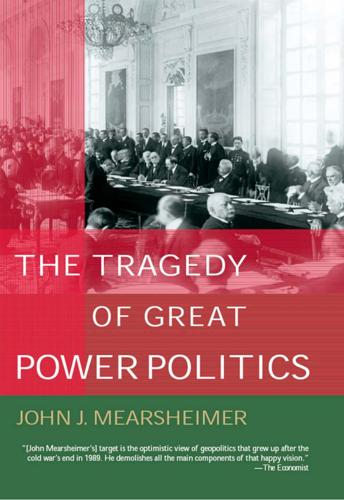
The Tragedy of Great Power Politics
by
John J. Mearsheimer
Published 1 Jan 2001
Morgenthau, Vietnam and the United States (Washington, DC: Public Affairs, 1965); and “Bernard Johnson’s Interview with Hans J. Morgenthau,” in Kenneth Thompson and Robert J. Myers, eds., Truth and Tragedy: A Tribute to Hans J. Morgenthau (New Brunswick, NJ: Transaction Books, 1984), pp. 382–84.] Furthermore, the collapse of the Bretton Woods system in 1971, the oil shock of 1973, and the growing power of multinational corporations (MNCs) led many to think that economic issues had become more important than security issues, and that realism, especially Morgenthau’s brand, had little to say about questions of international political economy. Some even argued in the early 1970s that MNCs and other transnational forces were threatening the integrity of the state itself.
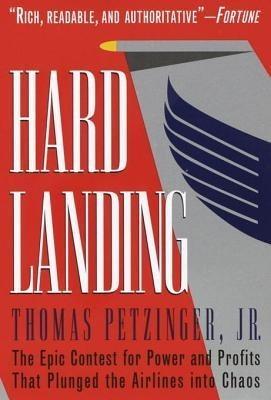
Hard Landing
by
Thomas Petzinger
and
Thomas Petzinger Jr.
Published 1 Jan 1995
And Burr knew that once Lorenzo had bought another airline, it would be his job, Don Burr’s job, to put the pieces together. Burr began to fantasize anew about quitting. He recognized that it wasn’t a great time to walk out. In the year following adoption of the Deregulation Act the airline industry had been almost stagnant. A suffocating recession was under way, triggered by the second great oil shock, due to the revolution in Iran. The Federal Reserve had pushed interest rates into the stratosphere as an antidote for rampant inflation. But if anybody could land on his feet, Don Burr thought, it was Don Burr. He had earned a reputation in the airline industry, thanks to the transformation of Texas International into a vibrant, profitable airline.

Winds of Change
by
Peter Hennessy
Published 27 Aug 2019
The framers of the thinking that produced the National Economic Development Council would have every sympathy with those who crafted the 2017 version of industrial strategy. Yet those first postwar decades do – and did – have a touch of gold around them, even though UK growth rates lagged behind those of West Germany and France. French economists called them ‘the thirty glorious years’ (ending with the oil shocks in the early to mid 1970s). More recent American economic historians have characterized the first two-and-a-half decades as ‘the Great Leap Forward’:11 the Princeton economist Robert Gordon argues that the great technical breakthroughs of the second industrial revolution of the late nineteenth century did not reach their maximum effect in terms of ‘total factor productivity’ until the years after 1945, boosted by wartime innovation and stimulated still further by the rise of a mass-consumption society whose ingredients were electricity, cars, telephones, running water and sewerage, improved infrastructure generally plus the spread of mass higher education.12 Gordon was writing about the United States (where, of course, overall consumption and living standards were much higher), but his analysis fits early postwar Britain apart from mass higher education, which the UK reached only in the late 1980s and early 1990s.
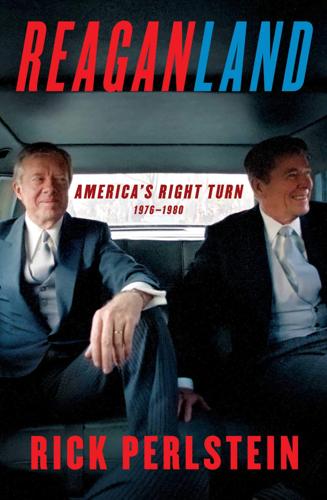
Reaganland: America's Right Turn 1976-1980
by
Rick Perlstein
Published 17 Aug 2020
The Women’s Room spent forty-four weeks on the New York Times bestseller list. * * * THE BACKGROUND TO THIS IDEOLOGICAL clash was a society whose presumptions about gender and the family were turning upside down—objectively so. It wasn’t just the cultural convulsions of the 1960s. It was economic. Between the end of World War II and the oil shocks of 1973, the real income of ordinary American working families approximately doubled—then, it flatlined or even declined. The change came so suddenly, and felt so foreign to Americans’ received way of knowing the world, that it could hardly be perceived whole. It registered, instead, as millions of uncoordinated individual family decisions, in response to millions of individual family struggles keeping up with mortgage payments, car payments, tuition, grocery bills, and the rising price of everything: so Mom began working outside the home.
…
In part because, on some days, it did feel like America’s GDP might someday sink to less than Iceland’s codfish catch. In 1950, America’s share of the world economy was 40 percent. Now it was 11 percent. America’s first trade deficit, in 1971, was $1.3 billion; now it approached $27 billion. The seventeen-month recession following the Arab oil shock in the fall of 1973, the longest and deepest since the 1930s, was a wakeup call. So was rising inflation, which now approached 7 percent annually; in the 1960s, it had often dipped below 1 percent. Corporate profits declined by a third since their postwar peak. In 1966, a dollar of capital invested earned an average 9 percent return.
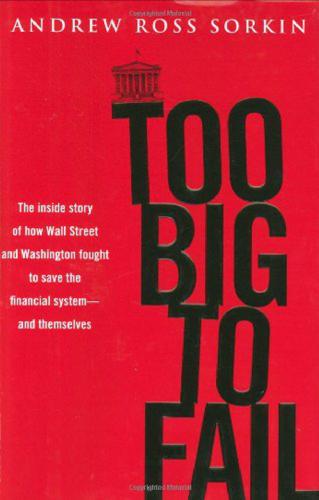
Too big to fail: the inside story of how Wall Street and Washington fought to save the financial system from crisis--and themselves
by
Andrew Ross Sorkin
Published 15 Oct 2009
When he told his fiancée, Laura, who was also a corporate lawyer, with the New York firm of Phillips, Nizer, Benjamin, Krim & Ballon, that he was taking a job as a salesman of gold coins and bars, she cried. Several months later, Blankfein became a Goldman employee when the firm acquired J. Aron in late October 1981. After the oil shocks and inflation spikes of the 1970s, Goldman was determined to expand into commodities trading. J. Aron gave the firm a powerful gold and metals trading business and an international presence, with a significant London operation. But while Goldman was disciplined and subdued, J. Aron was wild and loud.

The Israel Lobby and U.S. Foreign Policy
by
John J. Mearsheimer
and
Stephen M. Walt
Published 3 Sep 2007
The total cost inflicted by the “oil weapon” was almost certainly larger, as it had long-term effects on inflation, real income, and productivity growth, as well as indirect effects on investment, currency price volatility, and other factors, but there is considerable disagreement among economists regarding the magnitude of these effects. On petroleum imports, see Dominick Salvatore, “Petroleum Prices and Economic Performance in the G-7 Countries,” in Siamack Shojai and Bernard S. Katz, eds., The Oil Market in the 1980s: A Decade of Decline (New York: Praeger, 1992), 94; and Mancur Olson, “The Productivity Slowdown, the Oil Shocks and the Real Cycle,” Journal of Economic Perspectives 2, no. 4 (Fall 1988): 43–69. The cost to OECD countries was to push their net oil import bill from $35 billion in 1973 to more than $100 billion in 1974. See Robert J. Lieber, The Oil Decade: Conflict and Cooperation in the West (New York: Praeger, 1983), 21.

The Golden Passport: Harvard Business School, the Limits of Capitalism, and the Moral Failure of the MBA Elite
by
Duff McDonald
Published 24 Apr 2017
The problem was, by the mid-1970s, public opinion of the clarity of that vision was dropping fast. In a 1966 Harris poll, 55 percent of Americans voiced “a great deal of confidence” in the leaders of large companies. By 1975, only 15 percent did. “After two decades without serious recession, the oil shocks of the 1970s and an accompanying economic malaise put paid to the notion of managerialism triumphant,”8 writes Walter Kiechel. What makes it all the more amazing is that having bought into the notion that MBAs were the answer, American corporations kept on hiring them once it was clear that they weren’t.
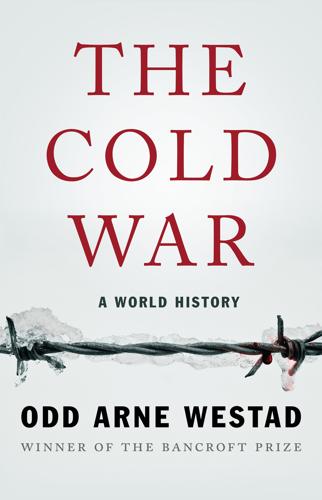
The Cold War: A World History
by
Odd Arne Westad
Published 4 Sep 2017
But in describing President Carter’s view at the time it may hold more than a grain of truth. And still Carter’s emphasis on the Cold War did him so little good in US political terms. In the presidential election he got clobbered by Ronald Reagan, who claimed that inflation, the rise of Soviet power, and the oil shocks all were due to the president’s incompetence. But worse, Reagan insisted, Carter did not really believe in America. They say that the United States has had its day in the sun, that our nation has passed its zenith. They expect you to tell your children that the American people no longer have the will to cope with their problems, that the future will be one of sacrifice and few opportunities.… The time is now, my fellow Americans, to recapture our destiny, to take it into our own hands.… Can we doubt that only a Divine Providence placed this land, this island of freedom, here as a refuge for all those people in the world who yearn to breathe free?
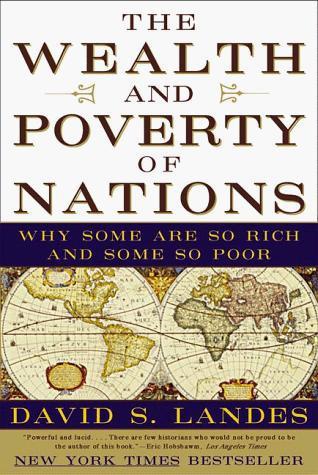
The Wealth and Poverty of Nations: Why Some Are So Rich and Some So Poor
by
David S. Landes
Published 14 Sep 1999
Even allowing for error, we clearly are not in the presence of decline; rather, of apparent convergence. * From 1960 to 1973, U.S. total factor productivity (that is, gains in productivity after increases in capital and labor have been deducted) grew by 1.5 percent per year, against 6.3 percent for Japan. The oil shock of 1973 hit Japan hard, reducing TFP growth to 1.5 percent 1973-79, 2 percent 1979-88. But U.S. TFP actually turned negative 1973-79, rising to less than 0.5 percent in 1979-88—Hart, “Comparative Analysis,” chapter 14. † Nothing is riskier than building prognoses on the last year’s (or last quarter’s) performance.

Hirohito and the Making of Modern Japan
by
Herbert P. Bix
Published 1 Jan 2000
IV Drawing a lesson from Kishi’s downfall, his successor, Prime Minister Ikeda Hayato, abandoned constitutional revision and hoisted the slogan “Tolerance and Patience.” Ikeda is mainly remembered for his plan to “double” the nation’s income within a decade by increasing its GNP by 9 percent annually. During his years in power—June 1960 to November 1964—Japan entered a period of extraordinary economic growth that continued until the first “oil shock” in 1973. Though it slowed at that time, the rate of growth still remained well above that of all Western nations. The decline in the Japanese farm population also accelerated, going from almost a third of the total employed in 1960 to under a fifth in 1970 and less than a tenth in 1980. When Hirohito turned sixty-seven in 1968, Japan had achieved the second largest GNP in the capitalist world; by the time he reached eighty in 1981, few of the agricultural communities that years earlier had been important mainstays of the monarchy still even existed.31 In 1963 Ikeda succeeded in making surrender day, August 15, the anniversary for memorializing the nation’s war dead in a purely secular, non-Shinto ceremony of condolence.
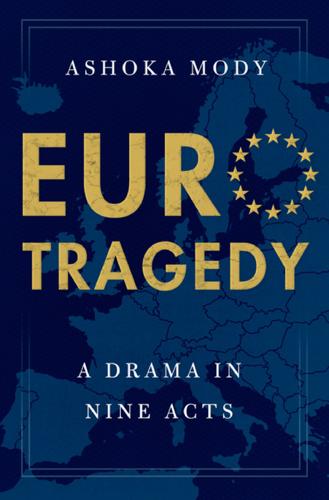
EuroTragedy: A Drama in Nine Acts
by
Ashoka Mody
Published 7 May 2018
Currency devaluation does temporarily boost exports, but it also makes imports more expensive. Therefore, countries that devalue repeatedly become “poorer,” because they need to export more to buy the same goods and services from abroad. Also, by raising the prices of imports, devaluation stokes domestic inflation. With inflation stubbornly high, especially after the first oil shock in 1973, currency devaluation was not welcome, even from a domestic perspective. Thus, as the Fed official and monetary historian Robert Solomon has written, competitive devaluation ceased to be “a live issue.”195 Advanced economies outside Europe gradually “learned to float” without disrupting the global trading system.196 Much later, a new—and longer-lasting—economic argument emerged in the European discourse to justify a monetary union.
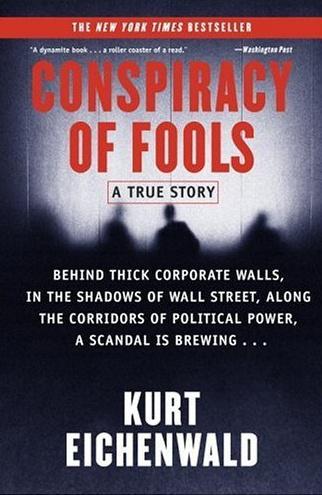
Conspiracy of Fools: A True Story
by
Kurt Eichenwald
Published 14 Mar 2005
Bowen walked away convinced he might be able to steal his former colleague for Transco. Two weeks later, Bowen called, asking Lay to join Transco as his number two and heir apparent. Lay agreed and, days before his departure, filed for divorce. It seemed a glorious time to live in Houston. The oil shocks of the 1970s had pushed energy prices through the roof, levitating the town in a bubble of economic growth. Throughout the industry it became a matter of faith that oil prices, which had already tripled, would do it again, surpassing one hundred dollars a barrel. But just after the thirty-nine-year-old Lay arrived, the good times stopped rolling.

The Rise and Fall of American Growth: The U.S. Standard of Living Since the Civil War (The Princeton Economic History of the Western World)
by
Robert J. Gordon
Published 12 Jan 2016
See Watkins (1900). 42. Markoff (2013). 43. When I arrived home in Berkeley from college or graduate school near Boston, I often traveled by the SFO helicopter line, which flew frequent schedules from the SFO airport to the Berkeley marina. This company abruptly shut down in 1974 as a result of the first oil shock. 44. Roubini (2014, p. 3). 45. Brynjolfsson and McAfee (2014, p. 44). 46. See chapter 7 and Cutler and Miller (2005). 47. Vijg (2011, chapter 4). 48. These comments on mid-1990s automobile factory technology come from my membership in the NBER “pin factory group,” which organized plant tours for NBER-affiliated research staff at that time. 49.
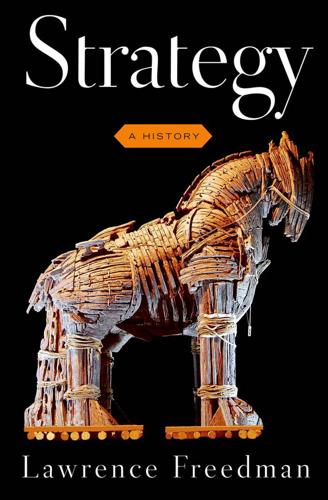
Strategy: A History
by
Lawrence Freedman
Published 31 Oct 2013
Survival and success required not only attention to customers and products but a readiness to be ruthless, to hack away at the least efficient parts of the business, to push away and overwhelm competitors, and to lobby hard for changes in government policy—especially deregulation—that would open up new markets. Attitudes toward finance had been transformed. The oil shocks and inflation of the 1970s extended a period of modest returns on equities, combined with a traditional reluctance to carry excessive debt. By the end of that decade, new and imaginative ways of raising capital were found. Companies could grow ambitiously and quickly by issuing bonds. Those investors prepared to take a greater risk could anticipate higher yields.
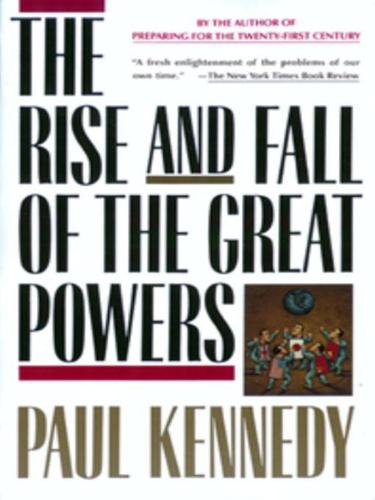
The Rise and Fall of the Great Powers: Economic Change and Military Conflict From 1500 to 2000
by
Paul Kennedy
Published 15 Jan 1989
The Bretton Woods system, very much a creation of the days when the United States was financially supreme, collapsed when its leading pillar could bear the strains no more.253 The detailed story of the ups and downs of the dollar in the 1970s, when it was floating freely, are not for telling here; nor is the zigzag course of successive administrations’ efforts to check inflation and to stimulate growth, always without causing too much pain politically. The higher-than-average inflation in the United States generally caused the dollar to weaken vis-à-vis the German and Japanese currencies in the 1970s; oil shocks, which hurt countries more dependent upon OPEC supplies (e.g., Japan, France), political turbulence in various parts of the world, and high American interest rates tended to push the dollar upward, as was the case by the early 1980s. Yet although these oscillations were important, and tended to add to global economic insecurities, they may be less significant for our purposes than the unrelenting longer-term trends, which were the decreasing productivity growth, which in the private sector fell from 2.4 percent (1965–1972), to 1.6 percent (1972–1977), to 0.2 percent (1977–1982);254 the increasing federal deficits, which could be seen as giving a Keynesian-type “boost” to the economy, but at the cost of sucking in so much cash from abroad (attracted by the higher American interest rates) that it sent the dollar’s price to artificially high levels and turned the country from a net lender to a net borrower; and the increasing difficulty American manufacturers found in competing with imported automobiles, electrical goods, kitchenware, and other manufactures.
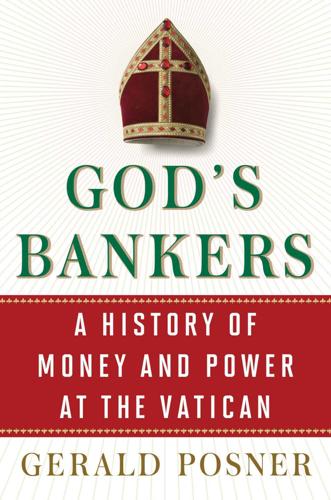
God's Bankers: A History of Money and Power at the Vatican
by
Gerald Posner
Published 3 Feb 2015
When Nixon refused the Saudi King’s request not to resupply Israel with American fighter jets in the middle of the conflict, Arab states announced their first-ever oil boycott of the United States, Japan, and most of Western Europe including Italy.12 Oil prices doubled within a week, on their way to what would become a tenfold increase over several years.13 The oil shortage caused serious problems for all the countries on the boycott list. Italy had to cut private gasoline sales by 10 percent in November causing long lines at gas stations. It also began to ration oil deliveries.14 And the oil shock destabilized the already weak Italian economy. Fears of a deep recession combined with high inflation pummeled Italy’s stock indices.15 Due to the oil shortage, the Italians endured their worst winter since World War II. The New York Times noted, “In Italy they are talking about the end of ‘la dolce vita.’ ”16 Just before Christmas, a bloody attack on Rome’s airport by the Palestinian Liberation Organization seemed a grim year-end note to the sour state of affairs.
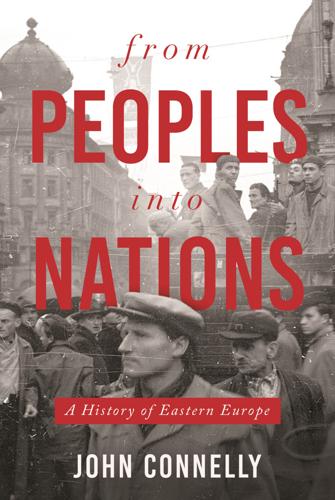
From Peoples into Nations
by
John Connelly
Published 11 Nov 2019
In December 1970, Edward Gierek had come to power after the disgraceful departure of Władysław Gomułka, whose final order was to shoot striking workers on the Baltic Coast—at Gdynia, Gdańsk, and Szczecin.12 Gierek, a former coal miner with a populist streak, appealed to strikers to return to work. He assured them that the state would work in their common interest, and Western lenders stepped in to help him. If the oil shock of the early 1970s was a challenge to industrialized economies, it was a boon to banks flooded with money invested by wealthy oil-producing states, so-called “petrodollars.” Gierek’s Poland funded ambitious but ultimately uncompetitive ventures, especially in steel, ship, and automotive industries.
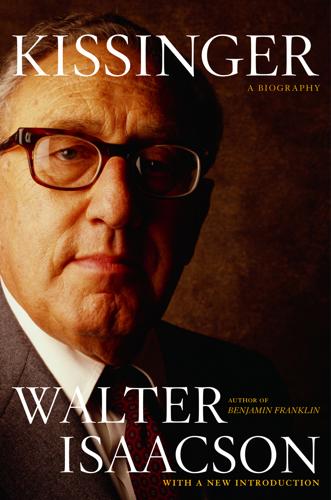
Kissinger: A Biography
by
Walter Isaacson
Published 26 Sep 2005
Despite his ambivalences, deep inside Kissinger had an emotional commitment to the survival of Israel that led him to be one of its staunchest defenders when its safety was truly at stake—as well as one of its most emotional critics when he felt it was embarked on a suicidal course. “How can I, as a Jew who lost thirteen relatives in the holocaust, do anything that would betray Israel?” he would tell Jewish leaders.12 OIL SHOCKS AND THE SHAH In the midst of the October 1973 Yom Kippur War, the Arabs had followed through on years of warnings and unsheathed their oil weapon. The Organization of Petroleum Exporting Countries (OPEC), with its Arab members in the lead, raised the price of oil from $3.01 per barrel to $5.12 and cut back on production by 5 percent.